SCOTTISH WORKS OF ART & WHISKY
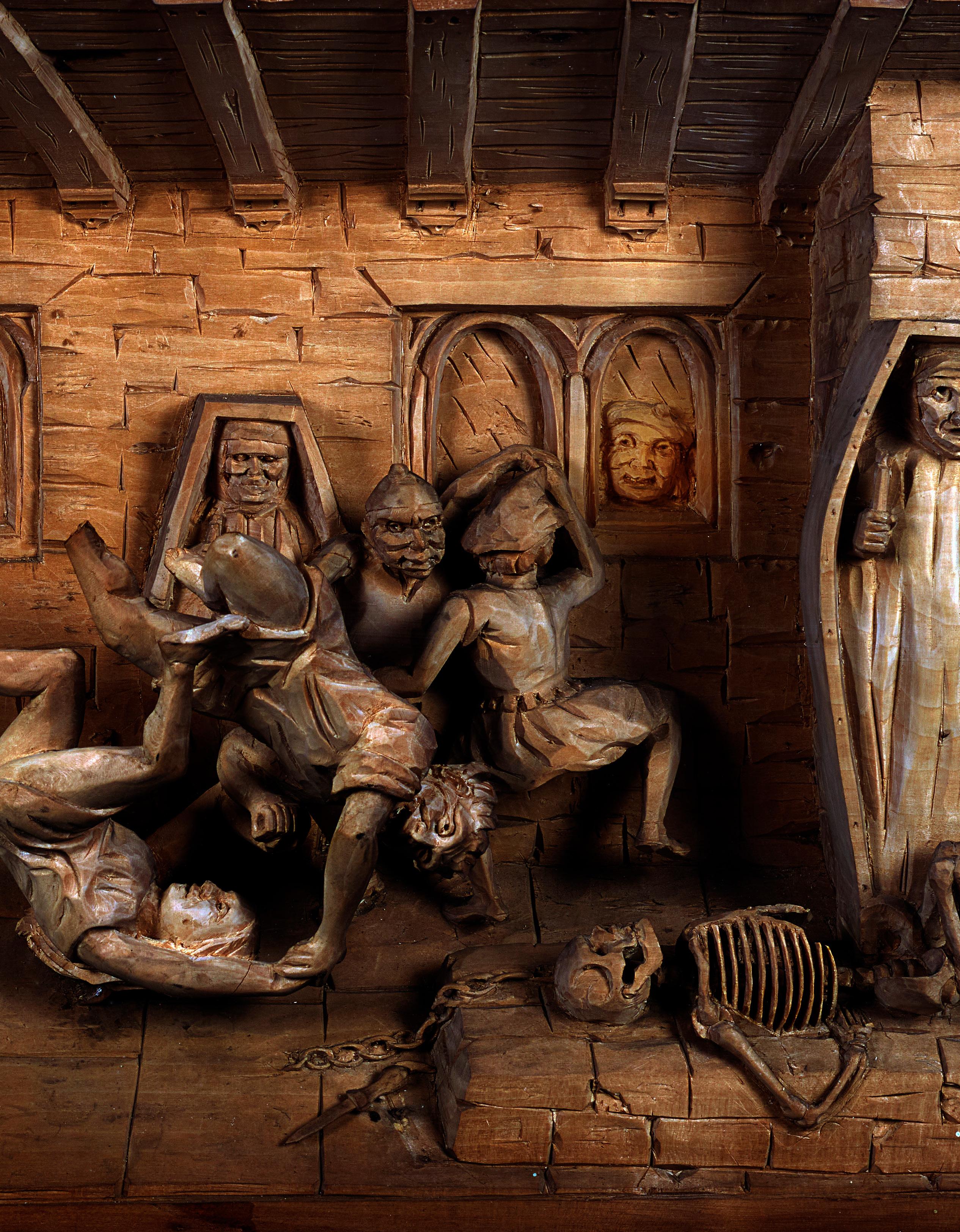
EDINBURGH
16TH AUGUST 2023
& LIVE ONLINE

Front Cover Lot 37 [detail]
SCOTTISH WORKS OF ART & WHISKY
VIEWING Sunday WEDNESDAY 16 AUGUST 2023 AT 10AM
Sale Lyon & Turnbull 33 Broughton Place EDINBURGH EH1 3RR CONTACT EDINBURGH +44 (0) 131 557 8844 LONDON +44 (0) 207 930 9115 info@lyonandturnbull.com
Number LT748
Inside Front Cover Lot 254 [detail] 13th August 12 noon - 4pm Monday 14th August 10am-5pm Tuesday 15th August 10am-5pm Day of sale from 9am
BUYER'S GUIDE
This sale is subject to our Standard Conditions of Sale (available at the back of every catalogue and on our website).
If you have not bought at auction before we will be delighted to help you.
BUYER’S PREMIUM
The buyer shall pay the hammer price together with a premium, at the following rate, thereon:
26% up to £20,000
25% from £20,001 to £500,000 20% thereafter.
VAT will be charged on the premium at the rate imposed by law (see our Conditions of Sale at the back of this catalogue).
ADDITIONAL VAT
VAT at the standard rate payable on the hammer price
‡ Reduced rate of 5% import VAT payable on the hammer price
Ω Standard rate of import VAT on the hammer price
Lots affixed with ‡ or [Ω] symbols may be subject to further regulations upon export /import, please see Conditions of Sale for Buyers Section D.2.
No VAT is payable on the hammer price or premium for books bought at auction.
DROIT DE SUITE
§ indicates works which may be subject to the Droit de Suite or Artist’s Resale Right, a royalty payment for all qualifying works of art. Under new legislation which came into effect on 1st January 2012, this applies to living artists and artists who have died in the last 70 years. This royalty will be charged to the buyer on the hammer price and in addition to the buyer’s premium. It will not apply to works where the hammer price is less than €1,000 (euros). The charge for works of art sold at and above €1,000 (euros) and below €50,000 (euros) is 4%. For items selling above €50,000 (euros), charges are calculated on a sliding scale. More information on Droit de Suite is available at www.dacs.org.uk
REGISTRATION
All potential buyers must register prior to placing a bid. Registration information may be submitted in person at our registration desk, by email, or on our website. Please note that first-time bidders, and those returning after an extended period, will be asked to supply the following documents in order to facilitate registration:
1 – Government issued photo ID (Passport/Driving licence)
2 – Proof of address (utility bill/bank statement).
We may, at our option, also ask you to provide a bank reference and/ or deposit. (Particularly for bidding on lots marked by the high value lot symbol )
By registering for the sale, the buyer acknowledges that he or she has read, understood and accepted our Conditions of Sale (available at the back of every catalogue and on our website).
BIDDING & PAYMENT
For information on bidding options see our Guide to Bidding & Payment at the back of the catalogue.
REMOVAL OF PURCHASES
Responsibility for packing, shipping and insurance shall be exclusively that of the purchaser. See Collections & Storage section for more info specific to this particular auction.
CATALOGUE DESCRIPTIONS
All item descriptions, dimensions and estimates are provided for guidance only. It is the buyer’s responsibility to inspect all lots prior to bidding to ensure that the condition is to their satisfaction. Our specialists will be happy to prepare condition reports and additional images. These are for guidance only and all lots are sold ‘as found’, as per our Conditions of Sale.
IMPORT/EXPORT
Prospective buyers are advised that several countries prohibit the importation of property containing materials from endangered species, including but not limited to; rhino horn, ivory, coral and tortoiseshell. Accordingly, prospective buyers should familiarise themselves with all relevant customs regulations prior to bidding if they intend to import lots to another country. It is the buyer’s sole responsibility to obtain any relevant export or import licence. The denial of any licence or any delay in obtaining licences shall neither justify the recession of any sale nor any delay in making full payment for the lot.
ENDANGERED SPECIES
Please be aware that lots marked with the symbol Y contain material which may be subject to CITES regulations when exporting outside Great Britain. For more information visit http://www. defra.gov.uk/ahvla-en/imports-exports/ cites
COLLECTION OF PURCHASED LOTS
All collections will be by appointment only (this applies to both carriers and personal collections). To make an appointment call 0131 557 8844 or email info@lyonandturnbull.com.
Please ensure payment has been made prior to collection. This can be done by bank transfer, and debit/credit card online (powered by Opayo) - details will be shown on your invoice.
Please note we are unable to take payments over the phone.
22.3
2
MEET THE SPECIALISTS
At Lyon & Turnbull we want to make buying at auction as easy and enjoyable as possible. Our specialist team are on hand to assist you, whether you are looking for something in particular for your home or collection, require more detailed information about the history or condition of a lot, or just want to find out more about the auction process.

JOHN MACKIE

Head of Decorative Arts
john.mackie@lyonandturnbull.com
KIER MULHOLLAND
Specialist: Jewellery & Silver kier.mulholland@lyonandturnbull.com
THEO BURRELL
Specialist: Decorative Arts theo.burrell@lyonandturnbull.com


COLIN T. FRASER
Consultant: Silver, Jacobite
Memorabilia, Arms & Whisky colin.fraser@lyonandturnbull.com
KATHERINE WRIGHT


Specialist: Ceramics & Glass
Fine Furniture & Works of Art katherine.wright@lyonandturnbull.com
HARRY FLETCHER
Specialist: Fine Furniture, Works of Art & Clocks
harry.fletcher@lyonandturnbull.com
3
ORDER OF SALE

Furniture & Works of Art
Furniture formerly from Kellie Castle
Furniture & Works of Art Part II
Wemyss Ware
Collectable Silver & Jewellery
A Private Collection of Seals: Highlights from the Matrix Collection Part II

Collectable Silver & Jewellery Part II
Provincial Silver
Hallmarked Silver
Property of a Gentleman – Previously from the Collection of Sir Colin MacRae (1869-1952) of Feorlinn & Lady Margaret Crichton Stuart (1875-1964)
Jacobite Works of Art
The Captain Alastair Wardrop Euing Crawford (1896-1924) Collection
Arms, Armour & Highland Dress
Whisky
16TH AUGUST 2023 AT 10AM Lot No. 1-21 22-28 29-47 48-91 92-107 108-113 114-125 126-224 225-309 310-334 335-366 367-372 373-390 391-408
WEDNESDAY,
FURNITURE & WORKS OF ART
A MATCHED PAIR OF HUNTLY BEGGAR’S BADGES
each of oval outline, embossed ‘PARISH OF HUNTLY’, numbered 51 and 60, each with suspension loop (2)
3.6cm long
£300-500
TWO LEAD TRADESMAN PLAQUES FROM YORK MINISTER
EARLY 19TH CENTURY
each a sand-cast lead sheet with relief inscription
‘Jn. Gibson, Plumber, Leith, 1831’; one cropped to the edges, the other with borders of rough lead (2) the larger 50cm wide, 40cm high


Provenance: These plaques were recently sold by York Minster in a clearance when acquired by the present vendor.

£400-600
Note: On February 1st, 1829 Jonathan Martin hid behind a monument in the Minster, only emerging into the empty cathedral at night. He piled cushions and prayer books together in the Choir, set fire to them, and left. The blaze was spotted in the early hours and the fire engines were summoned. They had a limited effect against an inferno which melted the lead from the roof and cracked the limestone pillars. Only late that afternoon did the fire begin to die out. By then about 230 feet of the choir roof had come crashing down, and the medieval choir stalls, the organ and the pulpit were destroyed.
Martin, a former sailor from Northumberland, was a non-conformist who believed all prayer should come from the heart rather than recited from the formal liturgy. He published pamphlets condemning the clergy as ‘vipers of Hell’. The restoration work was carried out by Sir Robert Smirke and paid for by public subscription. John Gibson of Leith was employed as one of the many tradespeople to restore York Minster following the fire, replacing the necessary lead panels in the restored roof.
AN EXTENSIVE COLLECTION OF SCOTTISH COMMUNION TOKENS
18TH CENTURY AND LATER
contained within a coin cabinet and accompanying index catalogue


£1,200-1,500

3
2
1
5 Other fees apply in addition to the hammer price: see the ‘Buyer’s Guide’ section on page 2
5 AN ORKNEY CHAIR
LATE 20TH CENTURY
stained walnut, with woven straw back and drop-in cord seat 63cm wide, 152cm high, 62cm deep

£500-700
GROUP OF SCOTTISH PEWTER
LATE 17TH / 18TH CENTURY
including a pair of Tappit Hens, three pewter measures and a porringer/bowl; together with a copy of the reference book ‘Old Pewter’ by Malcolm Bell, published by George Newnes Limited, London (7) the tappit hens 28cm high
£250-350

4
6 Other fees apply in addition to the hammer price: see the ‘Buyer’s Guide’ section on page 2
TWO SCOTTISH EAST COAST POTTERY FIGURAL SPILL VASES PORTOBELLO, MID-19TH CENTURY

one modelled as a shepherd seated with a dog upon his lap, the other as a shepherdess seated with a sheep upon her lap, each sitting before a tree issuing three branches, the naturalistic base with a green rim (2) approximately 18cm high

£200-300
8
A CAITHNESS CHAIR

20TH CENTURY
chip-carved oak, 42cm wide, 82cm high, 44cm deep; together with TWO ORKNEY STOOLS, oak with cord seats, one 35cm wide, 44.5cm high, 28cm deep; the other 33cm wide, 34cm high, 28cm deep (3) the largest 82cm high

£200-300
6
A SCOTTISH EAST COAST POTTERY NEWHAVEN FISHWIFE FIGURE
EARLY 19TH CENTURY
modelled carrying a basket of fish upon her shoulders
20.5cm high
£300-500
7
7
19TH CENTURY
carved in typical style in high relief, each side panel with a carving of a dog and the front with a running fox, the hinged lid with a Highland couple, the mother holding a child wrapped in a shawl, probably relates to the Robert Burns work ‘Twa Dug’s’
16cm wide, 6cm high, 8cm deep
£250-350 12
SCOTTISH ROOTWOOD AND PENWORK
SNUFF MULL
19TH CENTURY
the base of naturalistic form, the sides profusely painted with thistles, each hinged cover painted with a scene from Burns, one inscribed ‘Weel done, Cutty - sark!’, from Tam O’Shanter; the other inscribed ‘It is the moon, I ken her horn’, from Willie Brew’d a Peck O’Maut; inscribed to the centre with a further verse, ‘Gie him strong drink, until he wink, That’s sinking in despair; Till he forgets his loves or debts, An minds his griefs nae mair’, from Scotch Drink 24cm long, 10cm high, 18cm wide
£600-800
SCOTTISH BURR ROOTWOOD SNUFF BOX
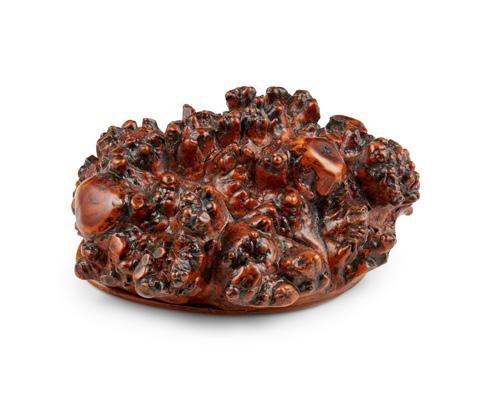

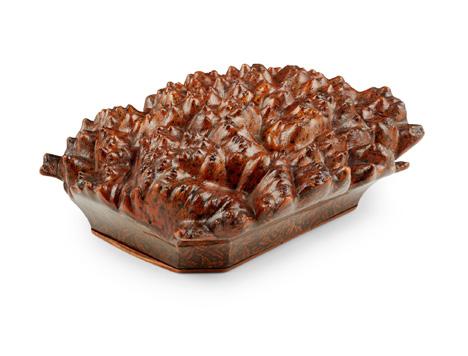
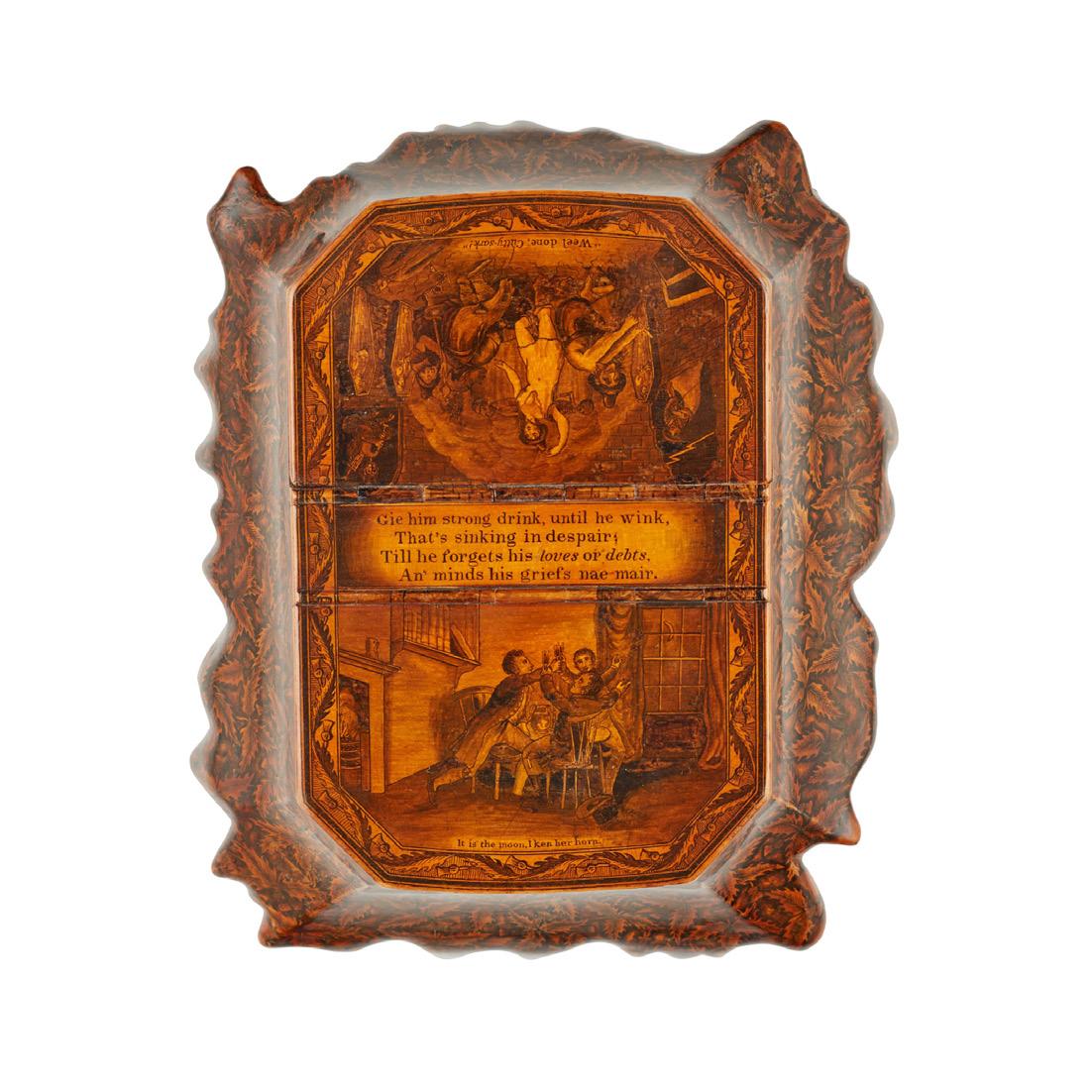
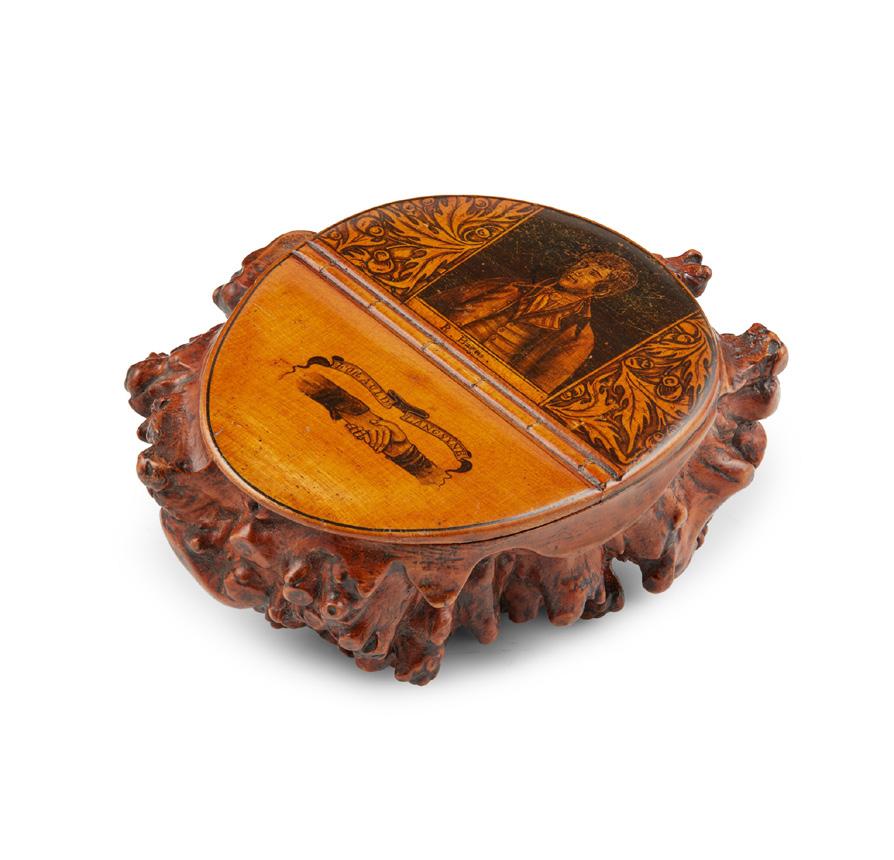
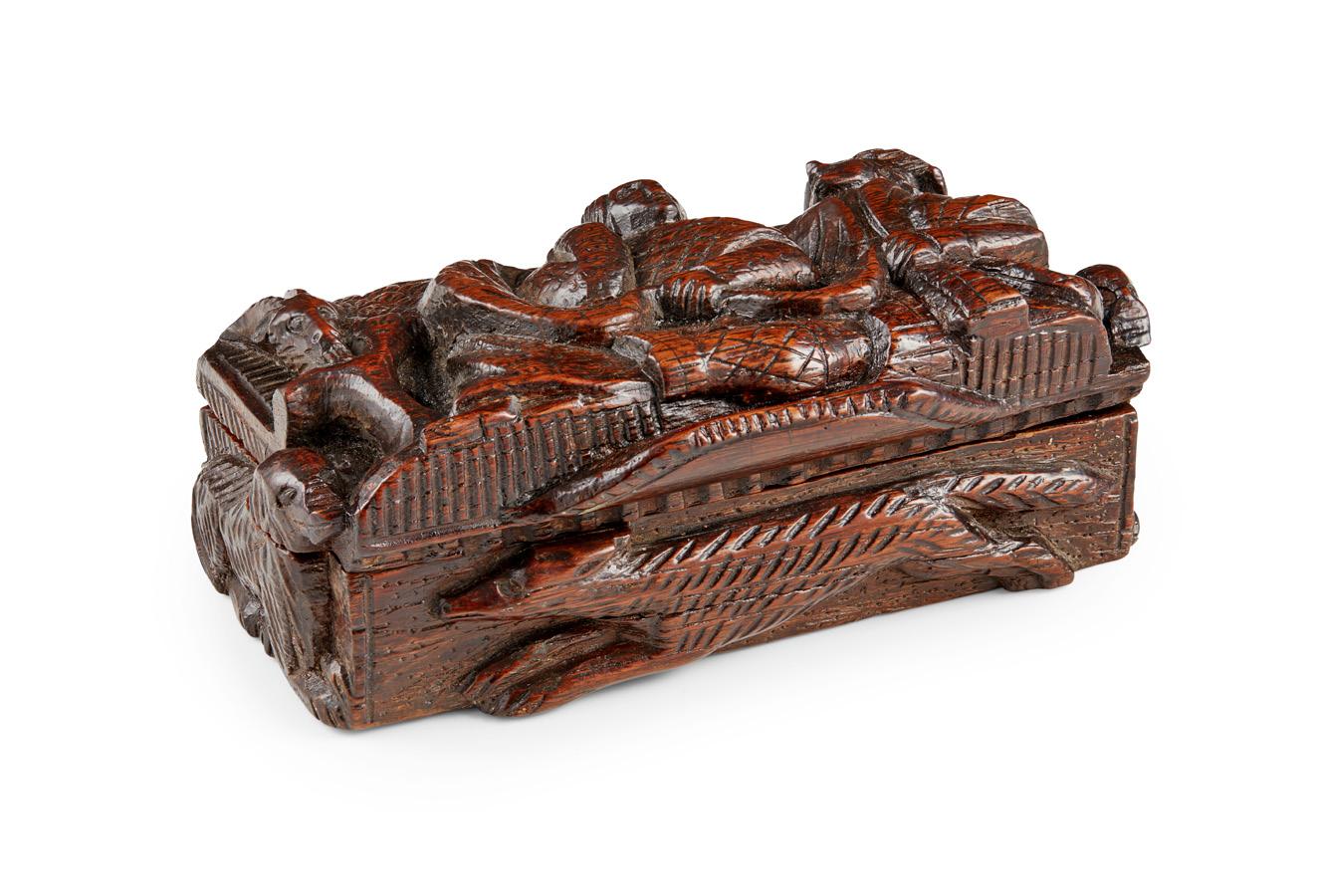
19TH CENTURY
the top painted with a portrait of Burns, flanked by two panels painted with leaf and berry designs, the hinged cover painted with two enclosed hands below a banner inscribed ‘For Auld Lang Syne’
10cm long, 8cm wide, 5cm high
£300-500
SCOTTISH BURR ROOTWOOD AND PENWORK SNUFF MULL
19TH CENTURY
the base of naturalistic form, the top and the hinged cover polychrome painted with two scenes from Sir Walter Scott’s ‘Rob Roy’, the larger scene depicting Bailie Nicol Jarvie in confrontation, within a tavern interior 20cm long, 10cm high, 21cm wide
£600-800

9
10
SCOTTISH VICTORIAN CARVED WOODEN ‘BLIND MAN’ SNUFF BOX
11
8
13
A CHANDELIER
CIRCA 1900
deer antler and wrought steel 59cm diameter, 66cm high

£400-600
14
TEAK FRAMED ORKNEY CHAIR
LATE 20TH CENTURY
with woven straw cowled hood and curved back, above open arms and seagrass drop-in seat, raised above single drawer on square supports, the drawer and base panels with crosshatched stringing


64cm wide, 144cm high, 50cm deep
£400-600
15
TEAK FRAMED ORKNEY CHAIR
LATE 20TH CENTURY
with woven straw cowled hood and curved back, above open arms and seagrass drop-in seat, raised above single drawer on square supports, the drawer and base panels with cross-hatched stringing
64cm wide, 144cm high, 50cm deep
£600-800
9 Other fees apply in addition to the hammer price: see the ‘Buyer’s Guide’ section on page 2
16
A SCOTTISH PENWORK SNUFF BOX
LATE 19TH CENTURY
of rectangular form, painted with an interior domestic scene showing a young boy having a cut on his finger attended to, indistinct maker’s mark to the interior
8.5cm wide
£150-200
17
TARTANWARE SNUFF BOX

19TH CENTURY
of rectangular form, the hinged cover painted with a scene inscribed ‘The Poacher’s Snares; the body decorated with Prince Albert Tartan, the interior stamped with the retailer’s mark, Russell, Glasgow
9.5cm wide
£300-500
18
VICTORIAN MAUCHLINE TARTANWARE CARD CASE
19TH CENTURY
the front with a hand-painted scene of Balmoral castle with a couple on horseback on the front lawn with a dog, the lid with a white metal plaque engraved ‘M A Vansittart’
11cm long, 7cm wide
£200-300
19
A TARTAN WARE MIRROR AND BOOK
LATE 19TH CENTURY
the mirror of rectangular form, in Prince Charlie tartan, 20.5cm high, 15.5cm wide; the book entitled ‘ Souvenir of Scotland’, featuring a view of Edinburgh on the front cover and the McLean tartan, published by T. Nelson & Sons, London, Edinburgh and New York, 1892 20cm high


£200-300

10
20
A COLLECTION OF MAUCHLINE WARE LATE 19TH CENTURY
including a desk stand and pen, a bible, two spectacle cases, a pin cushion in the form of a pail, a miniature teapot, a beaker, a crucifix and a letter opener etc (14) desk stand 29cm wide

The vendor is donating all proceeds from this sale to The Brain Tumour Charity.
£200-300
21
A COLLECTION OF MAUCHLINE WARE LATE 19TH CENTURY

comprising two ‘Inimitable straps’ by W & A Smith, 35cm and 24cm long, a small quaich, a clothes brush, a hair brush, a ball and cup games, three letter openers, a postal rules etc (13) the largest 35cm long
The vendor is donating all proceeds from this sale to The Brain Tumour Charity.
£200-300
11 Other fees apply in addition to the hammer price: see the ‘Buyer’s Guide’ section on page 2
FURNITURE FORMERLY FROM KELLIE CASTLE
Kellie Castle was begun in 1360 then expanded by the Oliphant family in the late 16th century, followed by the Earls of Kellie in the early 17th century, the title created by King James VI in 1619. The castle is a fine example of Scots Baronial domestic architecture, with an imposing mix of gables, corbelled towers, and chimneys. In 1878 it was rented from the Earl of Mar and Kellie by James Lorimer, father to Sir Robert Lorimer, the renowned Scottish architect and furniture designer. The Lorimer family set about restoring the castle for use as a holiday retreat, but it soon became the family home. Robert Lorimer was instrumental in much of the restoration work, restoring magnificent plaster ceilings, painted panelling and furniture. In 1936 Sir Robert’s son, the sculptor Hew Lorimer and his wife Mary, renewed the tenancy. Hew and Mary Lorimer purchased the castle in 1948 and it remained in his ownership until 1970 when he sold the castle, together with gardens, to the National Trust for Scotland. During the time the castle was occupied and restored by the Lorimer family it’s historic setting heavily influenced not only their styles but also those of many artists that visited them. These included the circles of the three generations of the Lorimer family, notably Phoebe Anna Traquair who completed the painted panel above the fireplace in the drawing room in 1897 and latterly artist Hannah Cassels im Thurn, the eldest daughter of Hannah and James Lorimer. After being purchased by the National Trust of Scotland the main castle contents were given into the care of the Trust by the Secretary of State for Scotland and, in 1998 the Trust purchased the Lorimer family artifacts from Hew’s estate.
22
A CHILD’S ORKNEY CHAIR
20TH CENTURY
oak with woven straw back and drop-in cord seat
41cm wide, 56cm high, 32cm deep £300-500
23
A CHILD’S ORKNEY CHAIR
20TH CENTURY
oak with woven straw back and drop-in cord seat

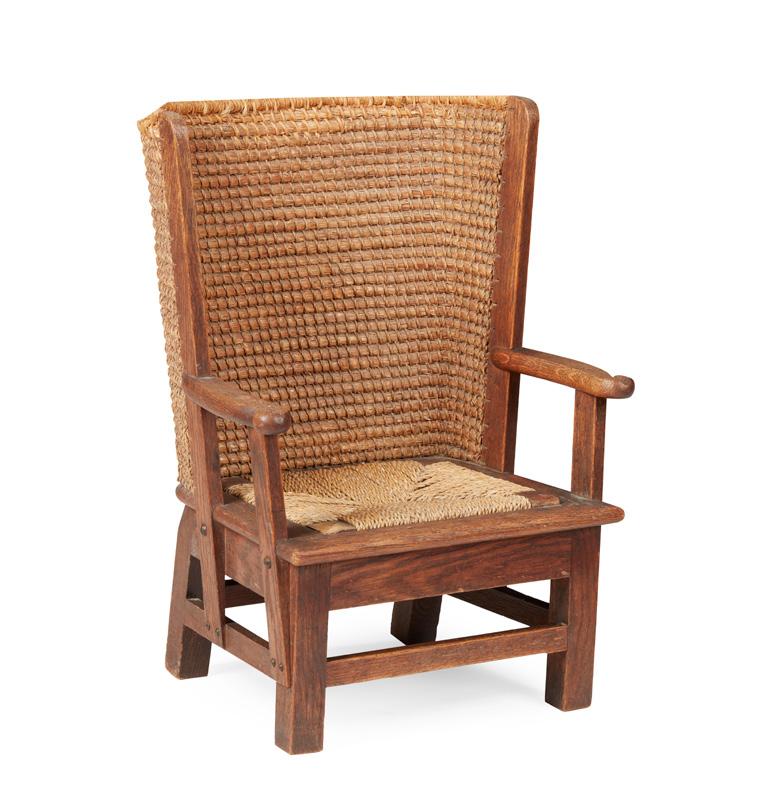
43cm wide, 62cm high, 38cm deep
£300-500
24
A GEORGE III WINE TABLE CIRCA 1790
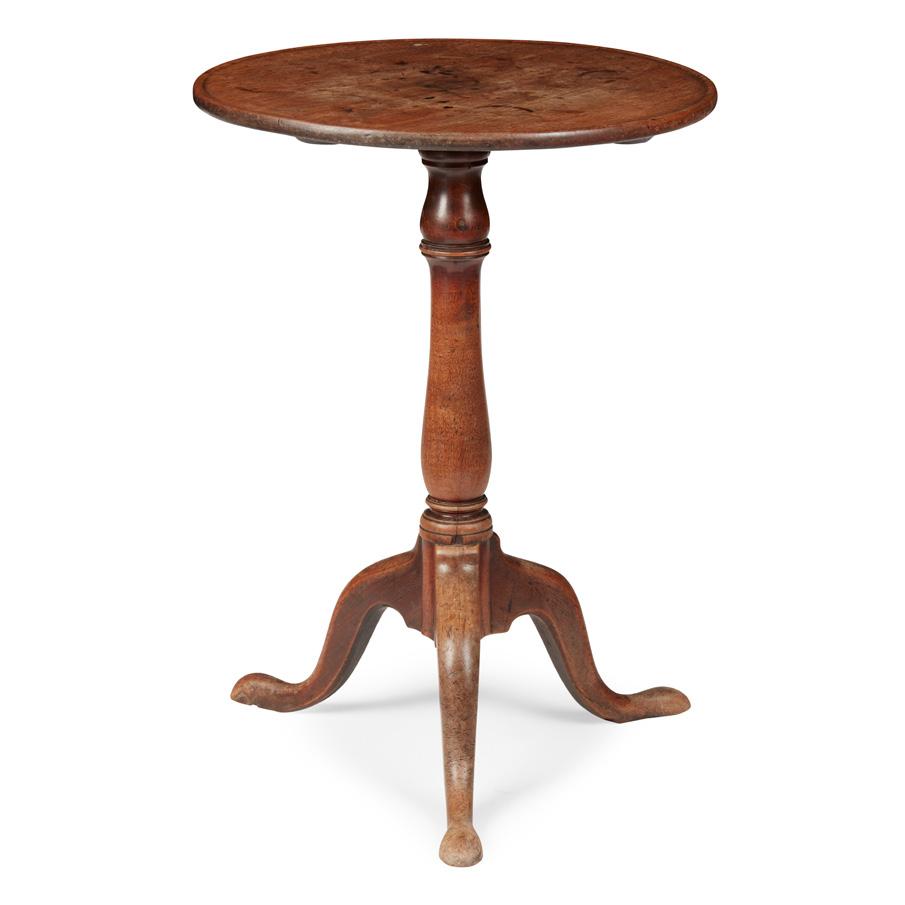
mahogany
53.5cm diameter, 73cm high £300-500
25
A GEORGE II DRESSER BASE CIRCA 1730

oak
192cm wide, 74cm high, 49.5cm deep £800-1,200
12
27
VICTORIAN SCRAP SCREEN
CIRCA 1900
oak frame, double-sided papercoated fabric and applied scraps, one side with a border of the MPs of the day, the other with a border of stamps
Each fold 173.5cm x 58.5cm £300-500
END OF COLLECTION
28
A GEORGE II SIDE TABLE
CIRCA 1730 oak
84cm wide, 72cm high, 52cm deep £400-600
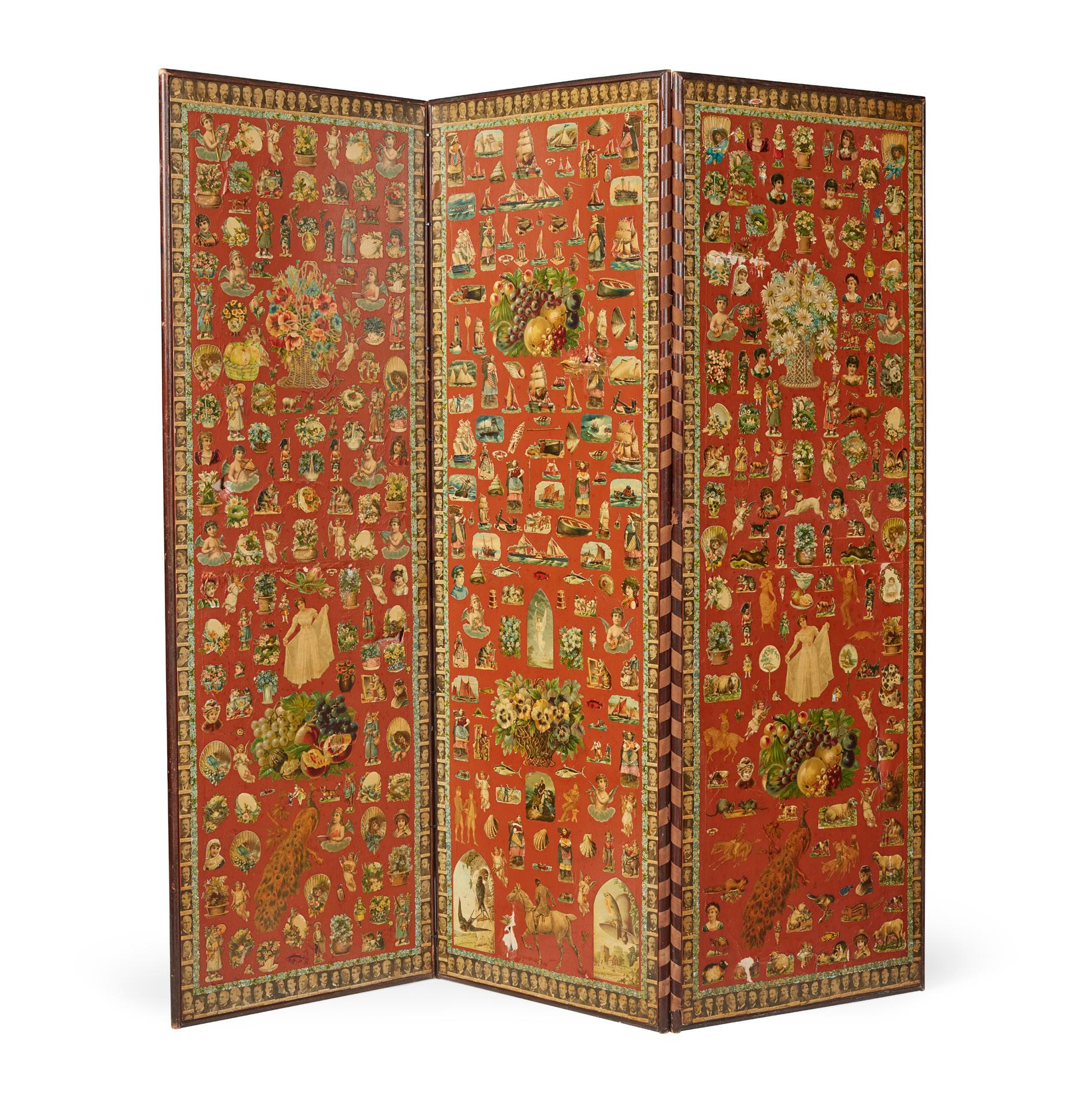
26
A GEORGE III SNAP-TOP OCCASIONAL TABLE

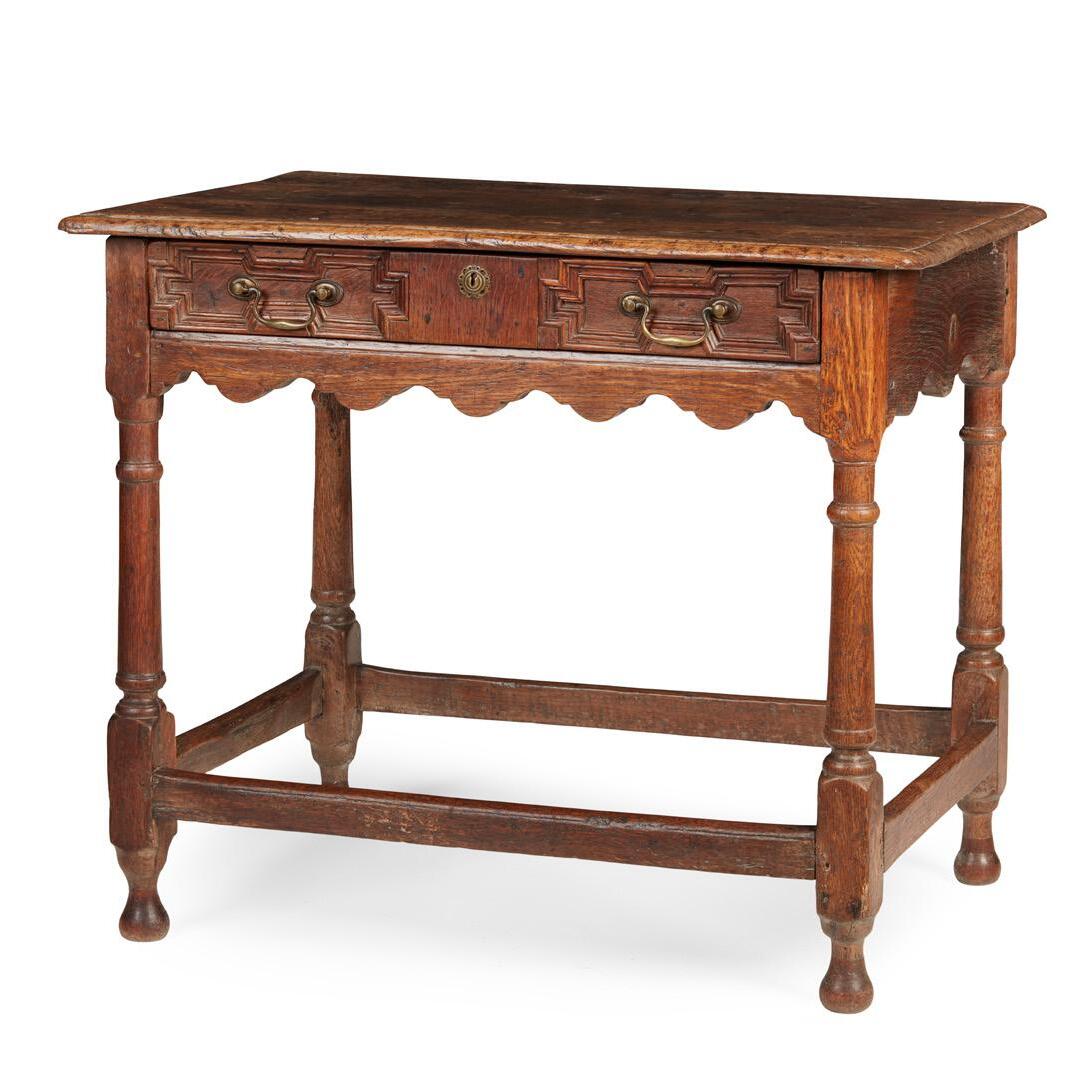
CIRCA 1790
mahogany
58cm diameter, 70.5cm high £400-600
13 Other fees apply in addition to the hammer price: see the ‘Buyer’s Guide’ section on page 2
FURNITURE & WORKS OF ART PART II

A SUITE OF EDINBURGH CRYSTAL ‘THISTLE’ PATTERN GLASS 20TH CENTURY

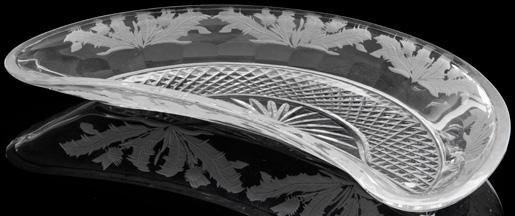

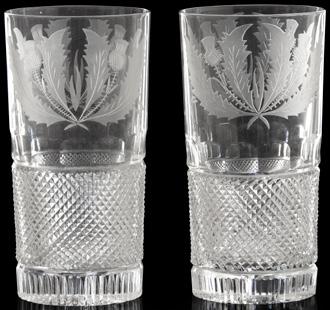
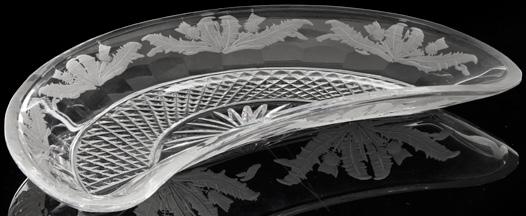



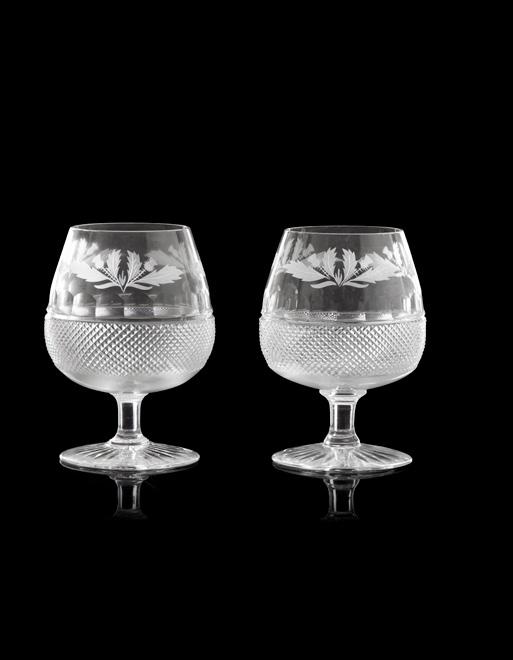




comprising eleven tumblers, 10cm high; fourteen whisky glasses, 10cm high; seven brandy balloons, 13.5cm high; two tall highballs; three whisky nips, 8.5cm high; three smaller whisky nips, 6.5cm high; fourteen crescent-shaped dishes; a pair of decanters with stoppers, 29cm high; a claret jug with stopper, 30.5cm high; a large jug, 20cm high; and a tall, slender bud vase, 25.2cm high (qty)




From the collection of the late G. A. Cannon, Chelsworth, Suffolk. £700-1,000
30 Y
SCOTTISH ROSEWOOD WINE COASTER BY WYLIE & LOCHHEAD, GLASGOW
LATE 19TH CENTURY
with moulded border, the centre glazed with maroon felt embroidered with roses in gold thread, on three brass and leather castors, the base stamped ‘8364, Wylie & Lochhead, 65 Buchanan Street, Glasgow’

23cm in diameter
£250-350

29
14 Other fees apply in addition to the hammer price: see the ‘Buyer’s Guide’ section on page 2
Lot part shown
FURNITURE & WORKS OF ART
A SUITE OF EDINBURGH CRYSTAL ‘THISTLE’ PATTERN GLASS




20TH CENTURY
comprising ten flutes; eight large goblets, 16.5cm high; thirteen red wine glasses, 12.3cm high; sixteen tall white wine glasses, approx 16cm high with slight variation; fourteen smaller white wine glasses, 13cm high; ten port glasses, 11.5cm high; ten sherry glasses, 11.5cm high (qty)
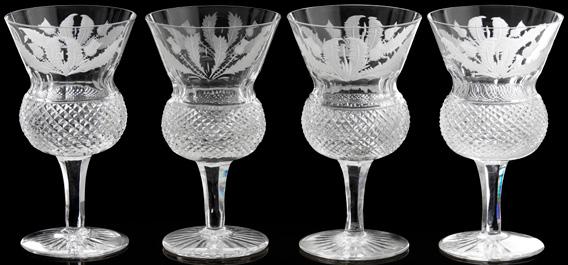

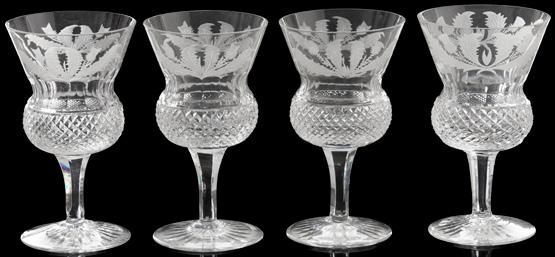

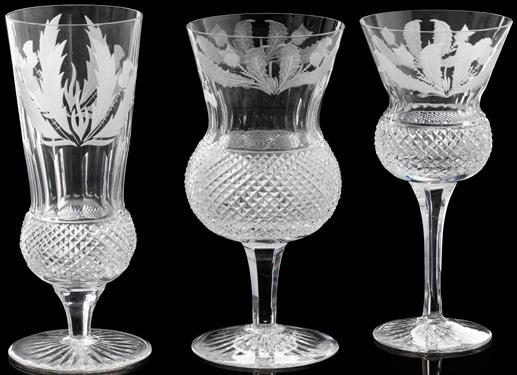



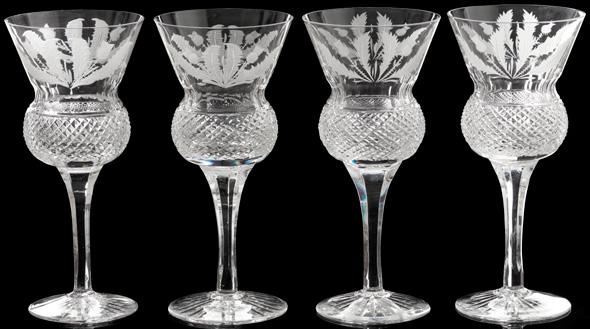









From the collection of the late G. A. Cannon, Chelsworth, Suffolk.
£700-1,000
32

THREE VICTORIAN ENGLISH PAINTED CERAMIC BARREL DISPENSERS
19TH CENTURY
all of oval form, with matching magenta and gilt decoration, each with gilt labels ‘Special Scotch’, ‘B. L. Gin’ and ‘Special Irish’, the tops with circular lids and stamped ‘T. Knight Glass & Bottle Manufr, China Barrel Merchant, 170 Hampton St, Birmingham, each with a brass tap also stamped ‘T. Knight, Birmingham’
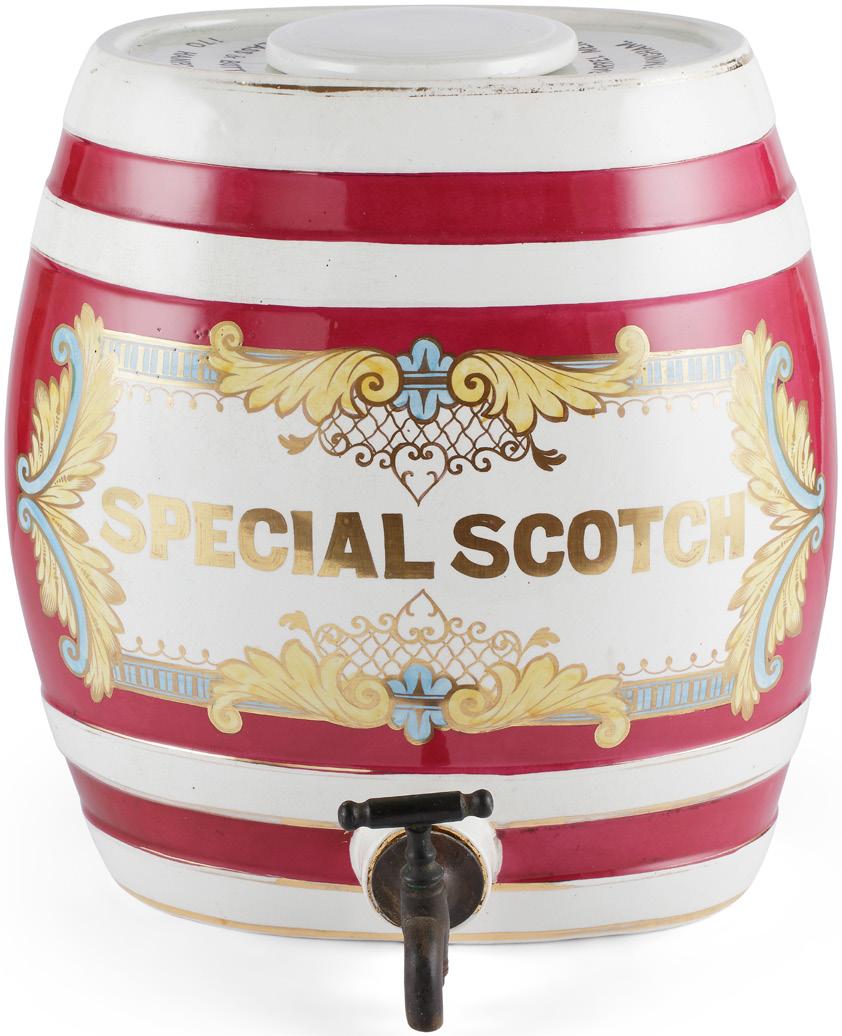

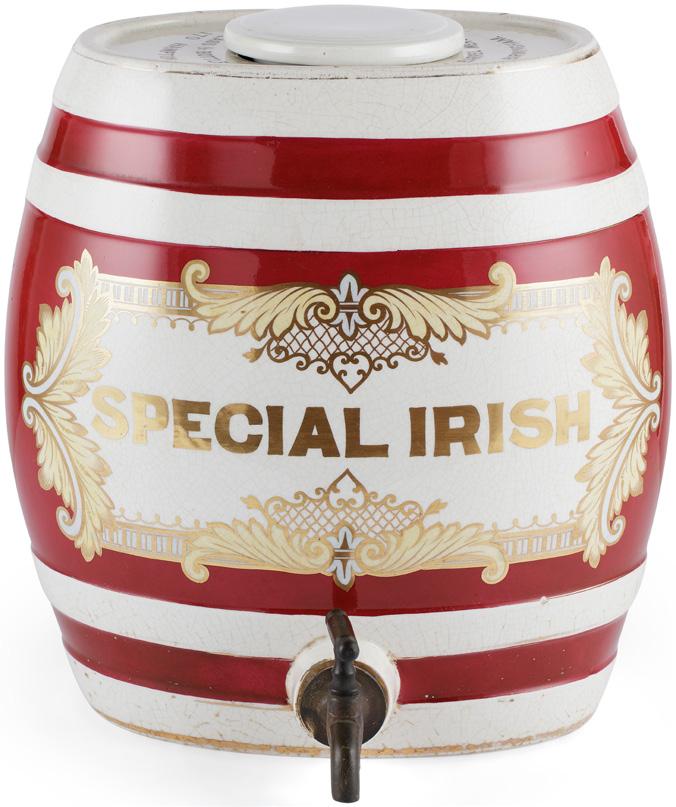
29cm wide, 34cm high, 20cm deep
£1,500-2,000
31
Lot part shown 15

16
FIGURE OF ROBERT LOUIS STEVENSON BY THOMAS J. CLAPPERTON (SCOTTISH 1879 - 1962)
DATED 1909

bronze, dark brown patina, raised on a stepped marble base, signed in the bronze THOS. J. CLAPPERTON/ 1909, 59cm high, 71cm including plinth; together with an associated EDWARDIAN REVOLVING BOOKCASE, mahogany, 48cm wide, 103cm high, 48cm deep (2)


the bronze figure 59cm high
Note: Regarded as ‘The Border Sculptor’, Thomas Clapperton studied at the Mechanics Institute in Galashiels before completing his training at the Glasgow School of Art and at Kensington School of Art, as well as the Royal Academy School in London. He became an apprentice to Sir William Goscombe John, one of the most eminent sculptors of the period. After further study in Paris and Rome, Clapperton eventually settled in London and setup a sculptor’s studio in Chelsea. His most renowned work is the sculpture of Robert the Bruce at Edinburgh Castle, and other well-regarded works include the frieze ant Liberty & Co. in London; ‘The Border Reiver’ at the Galashiels War Memorial, the bust of Sir Walter Scott in Bank Street, Galashiels, and the Flodden Memorial and bronzes surrounding the Mungo Park Memorial in Selkirk. Clapperton is also known for the much-loved Wonderland statue in Oamaru’s Botanical Gardens (New Zealand), the reduction of which was sold in these rooms (Decorative Arts, 1st April, 2020, lot 231).
£10,000-15,000
33
17 Other fees apply in addition to the hammer price: see the ‘Buyer’s Guide’ section on page 2
34 BURNS TAM
O’SHANTER TAPESTRY

WALL HANGING
LATE 19TH / EARLY 20TH CENTURY
of square form with a quarter repeating design in two-tone red and black, centred on the witch pulling Meg’s tail as Tam O’Shanter flees over the Brig O’Doon around a diamond of thistles, the corners with scenes of the ruined Alloway Kirk, the outer borders with a similar thistle design 205cm high, 184cm wide
£400-600
BUST OF ROBERT LOUIS STEVENSON BY THOMAS J. CLAPPERTON (SCOTTISH 1879-1962)

EARLY 20TH CENTURY
bronze, dark brown patina, signed to the edge ‘Tom Clapperton’, on a square green serpentinite plinth base
11cm wide, 22cm high, 8cm deep
£300-500
GERMAN BERLIN CAST IRON STATUETTE OF SIR WALTER SCOTT
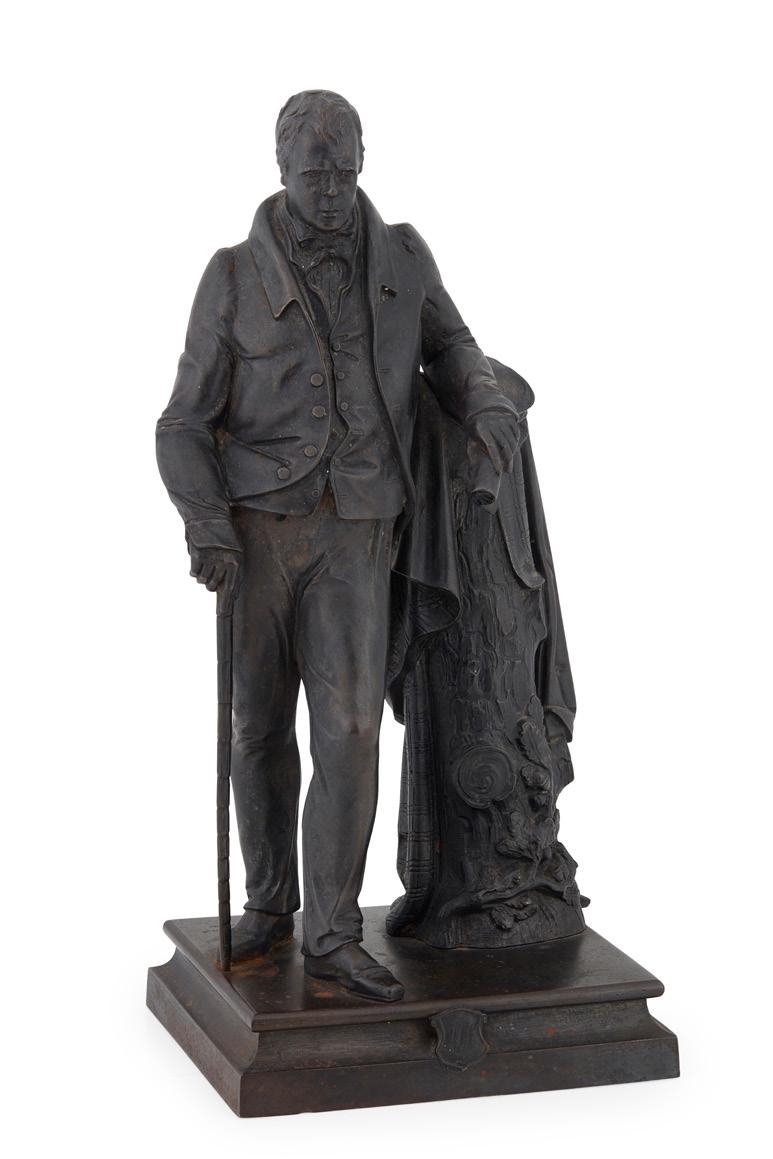
MID-19TH CENTURY
depicting the poet leaning against a stump draped in tartan holding a manuscript in his left hand, the front of the stepped base with a cartouche with initials ‘WS’, engraved on the back of the base with German inscription and signed by the Devaranne foundry, after the model by Johann Karl Wilhelm Kratzenberg circa 1834
11cm wide, 24cm high, 10cm deep
£400-600
36
35
18
FOUR SCOTTISH CARVED LIMEWOOD TABLEAU SCENES FROM TAM O’SHANTER, WORKSHOP OF THOMAS HALL TWEEDY
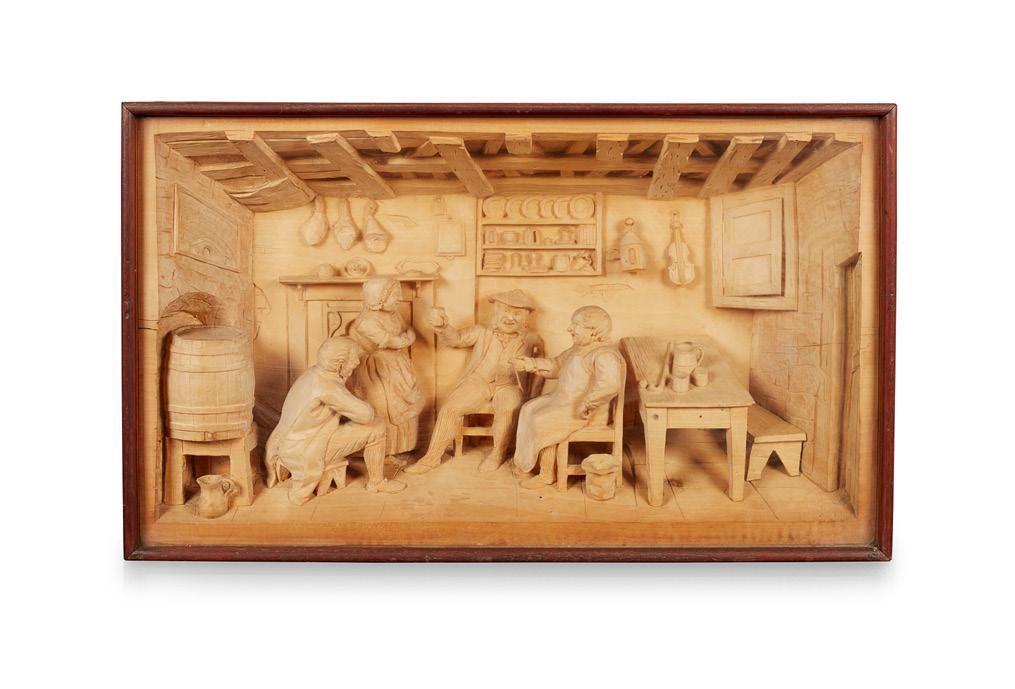
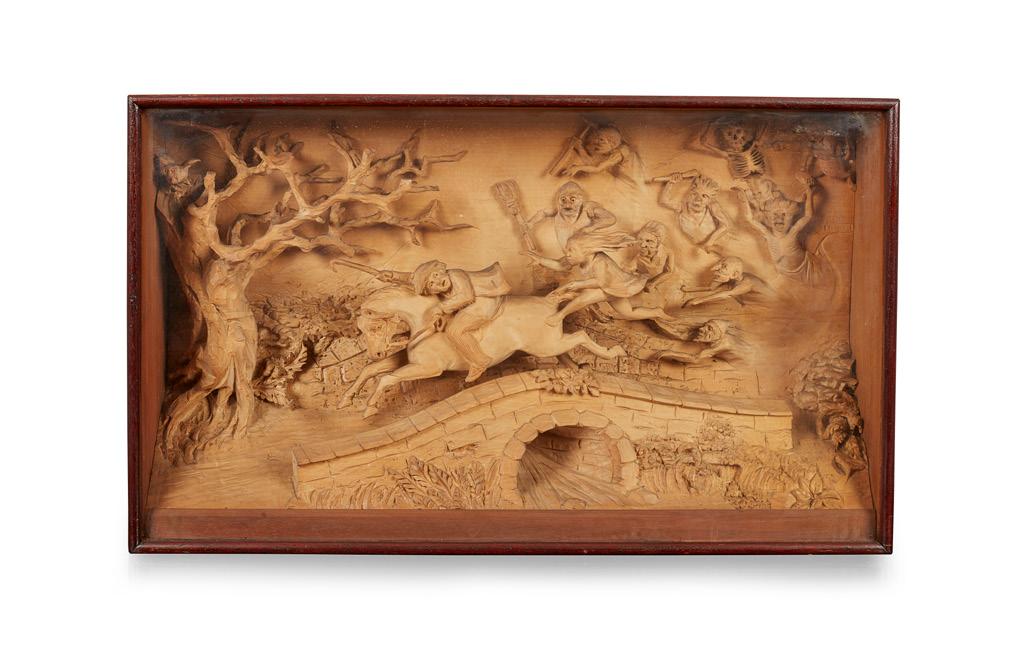

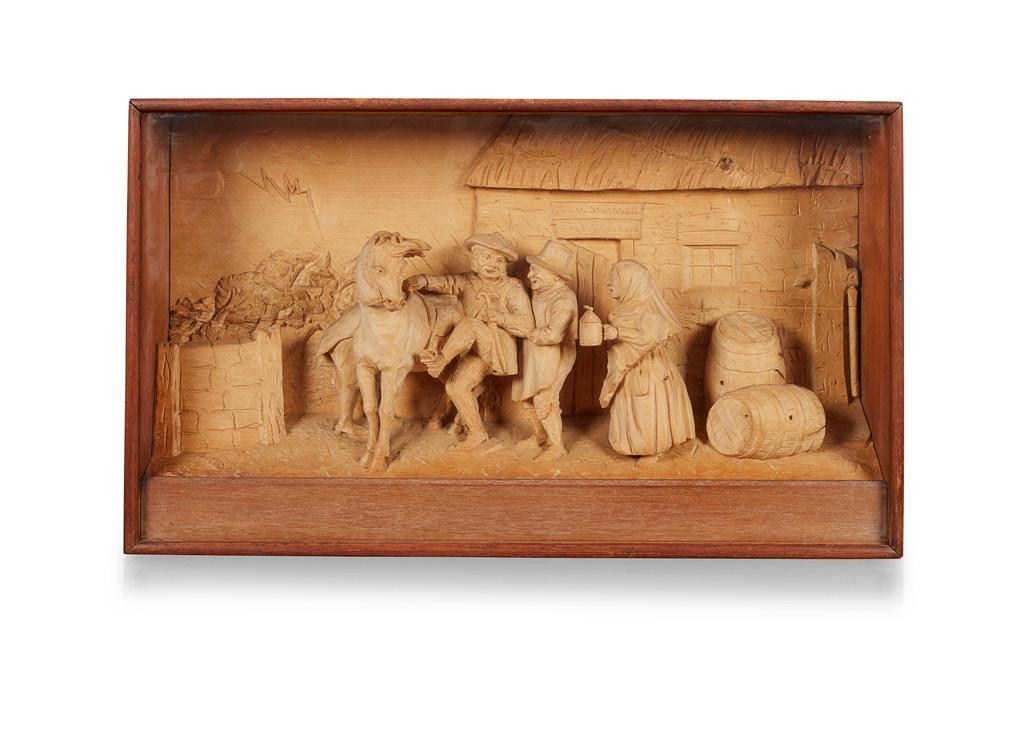
CIRCA 1860
each carved in high relief from a single piece of limewood, depicting Souter Johnnie and Tam O’Shanter conversing and drinking while the Miller and proprietress look on, Tam drunk outside the tavern preparing to ride into the night, the interior scene of the local haunted church lit up with witches and warlocks dancing, the Devil playing the bagpipes and Tam at the window, lastly Tam spurs Meg towards the River Doon as the creatures give chase and the witches come so close to catching Tam and Meg that they pull Meg’s tail off just as she reaches the Brig O’ Doon, each in a glazed mahogany case (4) 68cm wide, 41cm high, 18cm deep
£2,000-3,000
Note: Based in Newcastle, Thomas Hall Tweedy (18161892) was a noted woodcarver working in England in the mid-nineteenth century. Tweedy was primarily a business man rather than a craftsman. It is recorded by his apprentice Ralph Hedley that he only saw him hold a tool once when he changed the figure of Miranda from a panel of the “Tempest” into a rock. However, he did have the gift of recognising skilled workmen and giving them employment thus enhancing his considerable reputation. A set of four carved tableaux from ‘Tam O’Shanter’ attributed to Tweedy are in the collection of the Robert Burns Museum, Ayrshire, and are stylistically very close to this set.
38
19TH CENTURY
bronze, dark green patina, depicted sitting on a tree stump, his head raised, beneath his feet is a scroll inscribed with a passage of his poetry, on an integral rectangular plinth base 28cm wide, 49cm high, 33cm deep £600-800
 FIGURE OF ROBERT BURNS BY SIR JOHN STEELL RSA (SCOTTISH 1804-1891)
FIGURE OF ROBERT BURNS BY SIR JOHN STEELL RSA (SCOTTISH 1804-1891)
37
19 Other fees apply in addition to the hammer price: see the ‘Buyer’s Guide’ section on page 2
COLLECTION OF CHARACTER ETCHINGS BY JOHN KAY (1742-1826)

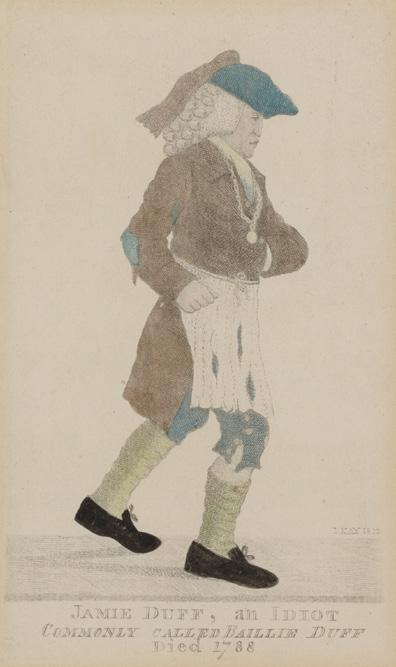

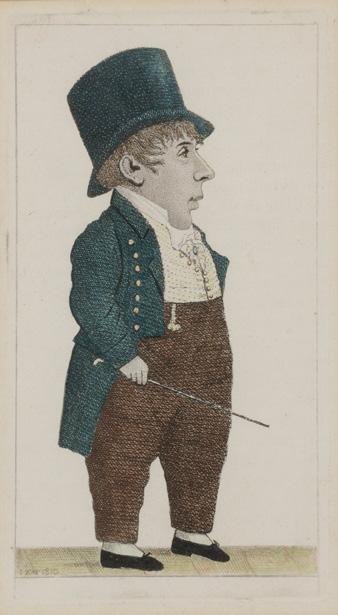
LATE 18TH/ EARLY 19TH CENTURY

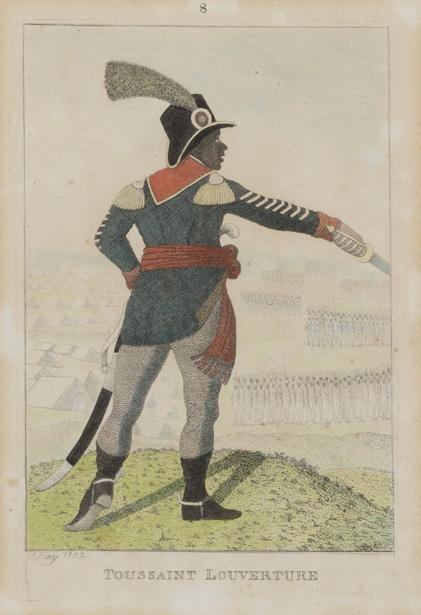
mostly coloured; mounted and framed, of various themes including religious, ecclesiastical and theatrical; titles including:
‘Jamie Duff, an Idiot Commonly Called Baillie Duff’, ‘Geordy Sime, a Famous Piper in his Time’, ‘Generous Sportsman’, ‘Toussaint Louverture’, ‘Mr H E Johnston In the Character of Hamlet’ (13)
smallest 13cm high, 9cm wide, largest 21cm high, 13cm wide (excluding frames)
£250-350
40
FRENCH ADRIEN DUBOIS COMBINATION BOTANY GADGET CANE



CIRCA 1880 - 1920
bamboo cane with finger pull in the ash handle that allows the shears to the end to snip, the handle also with a small concealed pollination brush and gilt-stamped ‘Fleur’ and ‘Fruit’ verso with a brass cap to the end, the cane and handle with ink inscription ‘T. Methven, 15 Princes St, Edinburgh’

119cm long
Provenance: Thomas Methven was a noted Scottish botanist and businessman that set up the firm of Thomas Methven & Sons based at 15 Princes Street, Edinburgh. They were large-scale purveyors of seeds, nursery plants and also a florist. The firm once had premises on Macdonald Road and several nurseries based around the city including at 9 Croall Place, Leith Walk and Warriston, Inverleith and Bangholm. Following the death of their father, the business was run by his sons Henry & John Methven. John was closely connected with the two important Scottish horticultural societies, the Royal Caledonian and the Scottish Association. He also had links with the Royal Scottish Arboricultural Society.
Note: For an identical example see the collection of the Isabella Stewart Gardner Museum
£1,500-2,500
41
A SCOTTISH MAHOGANY CASED SET OF ‘HYDROSTATICAL GLASS BUBBLES’ OR SPECIFIC GRAVITY BEADS
RETAILED BY A. GALLETTI, NO. 10 NELSON STREET GLASGOW
containing eighteen glass beads in a fitted mahogany case, with a pull-off lid, to the insert with original paper label ‘directions how to prove spirits’

9cm diameter
£300-500
39
20 Other fees apply in addition to the hammer price: see the ‘Buyer’s Guide’ section on page 2
WROUGHT IRON CHANDELIER, OF CLAN CRAWFORD INTEREST

19TH CENTURY
the corona composed of fleurs-de-lis suspending a central orb of scrolls, boxwood sprigs and a pendant light fitting, within a wrought iron ring band bearing the motto TUTUM TE ROBORE REDDAM [My Strength Will Keep You Safe] in wrought iron letters, alternating with panels bearing the monogram EC, a stag’s head, laurel, and boxwood sprigs; mounted with four candle lights, converted to electricity 76cm diameter; 113cm high to ceiling rose approx
Provenance: Captain Alastair Wardrop Euing Crawford (1896 - 1924), hence by descent to the present vendor
£600-800
43 UNION OF SCOTLAND AND ENGLAND PAINTED DIAL MAHOGANY
LONGCASE CLOCK BY J SHARPE OF STAMFORDHAM
19TH CENTURY
the cream-painted break arch dial with black Roman numerals and subsidiary second and date dials, the arch with a scene of the Union of Scotland and England, the spandrels painted with Naval scenes, signed ‘J. Sharpe, Stamfordham’, the mahogany case with flat top with moulded dentine frieze above an arched door flanked by a pair of gilt metal mounted columns, the trunk with a Gothic arched door and boxwood inlaid chamfered corners, on a moulded square plinth base, the twin train brass movement striking to a bell 216cm high, 57cm wide, 30cm deep

£400-600
44
CIRCA 1920
each with pierced splat back above drop-in tan leather seat and square legs united by H-stretchers

55cm wide, 81cm high, 40cm deep
£300-500

42
PAIR OF OAK ‘GOSSIP’ CHAIRS BY WHEELER OF ARNCROACH
21
45
SCOTTISH MAHOGANY ROUND-DIAL WALL CLOCK

LATE 19TH CENTURY

the white enamelled dial with Roman numerals and signed ‘J.A.S. Ritchie & Son, Edinburgh’, the single chain fusee timepiece movement with anchor escapement
38cm in diameter
£400-600
46
POLISHED IRON AND BRASS PLATFORM FLOOR
SCALES, BY J. WHITE & SON, AUCHTERMUCHTY
EARLY 20TH CENTURY
with a platform base and sliding weight scale gauge, with cast maker’s name to the platform 109cm high

£1,000-1,500
47
SCOTTISH WINDSOR ‘SHOP’ SIDE CHAIR BY F. EAST & CO, DUNDEE
CIRCA 1900
stained birch, the back fitted with a ‘Watson’s Matchless Cleanser’ enamel sign made by the Falkirk Iron Company, the saddle seat on turned legs united by stretchers
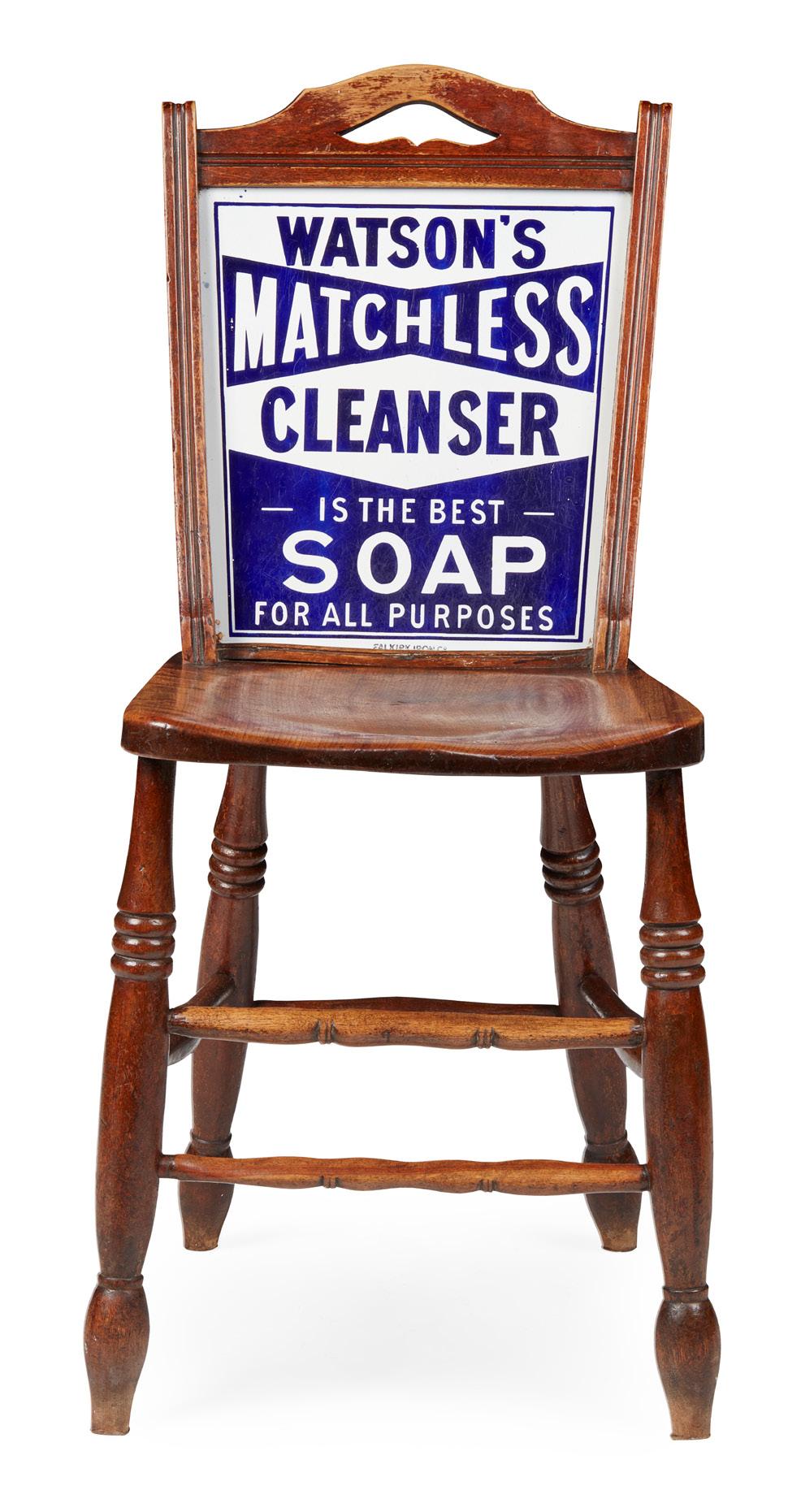
43cm wide, 91cm high, 46cm deep
Literature: For an identical chair, see Bernard D. Cotton, ‘Scottish Vernacular Furniture’, Thames & Hudson, London, 2008, p.212
£600-800
22 Other fees apply in addition to the hammer price: see the ‘Buyer’s Guide’ section on page 2

23
TWO WEMYSS WARE MATCH STRIKERS ‘CHERRIES’ AND ‘CABBAGE ROSES’ PATTERN impressed WEMYSS and printed T.Goode & Co mark (2)
9.2cm high
£150-250
WEMYSS WARE
48
A WEMYSS WARE TALL QUAICH ‘CABBAGE ROSES’ PATTERN


twice impressed WEMYSS, green painted Wemyss
16.6cm high
£100-200
A COLLECTION OF WEMYSS WARE ‘CABBAGE ROSES’ PATTERN, EARLY 20TH CENTURY

comprising a biscuit barrel, 12cm high, a beaker vase painted by James Sharpe, 16cm high, a tall mug, 18cm high, a teapot, 10cm high, and a small plate, 14.2cm diameter, various painted and impressed factory marks, biscuit barrel with printed T. Goode & Co mark (5) the largest 18cm high
£150-200
50
49
24 Other fees apply in addition to the hammer price: see the ‘Buyer’s Guide’ section on page 2
A RARE WEMYSS WARE BIRTH BOWL
‘CABBAGE ROSES’ PATTERN, CIRCA 1900 glazed earthenware, painted WEMYSS

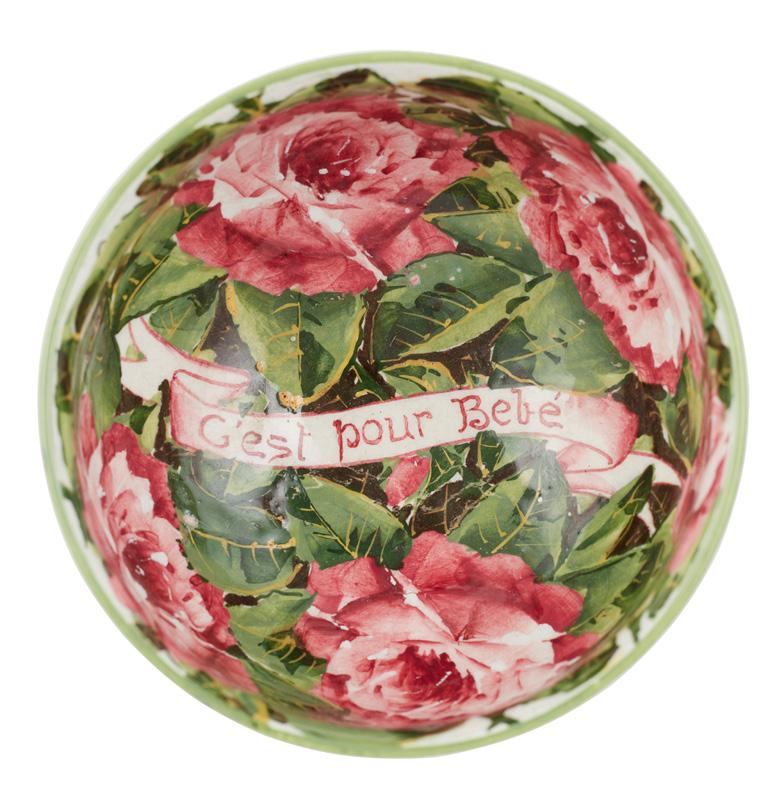
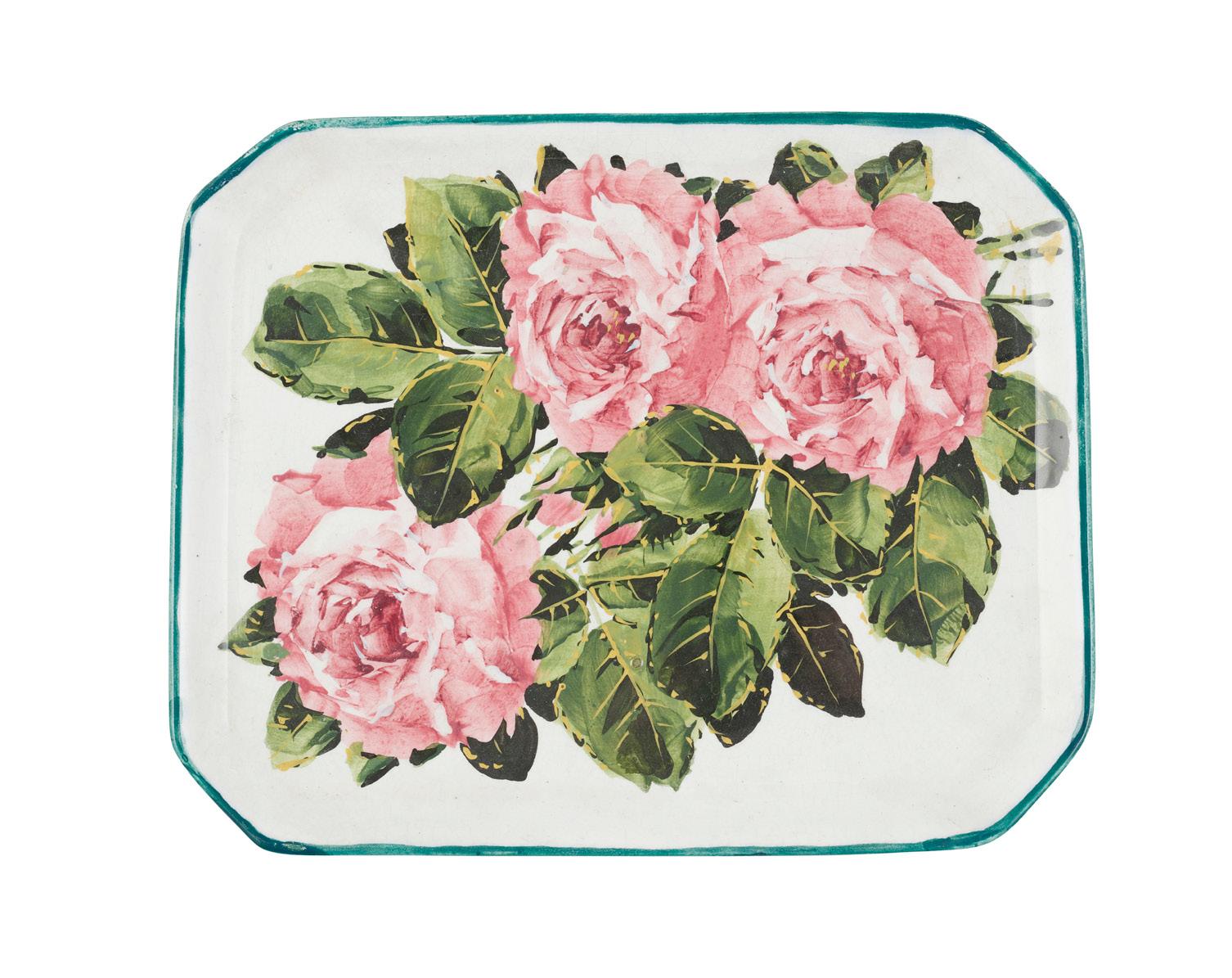
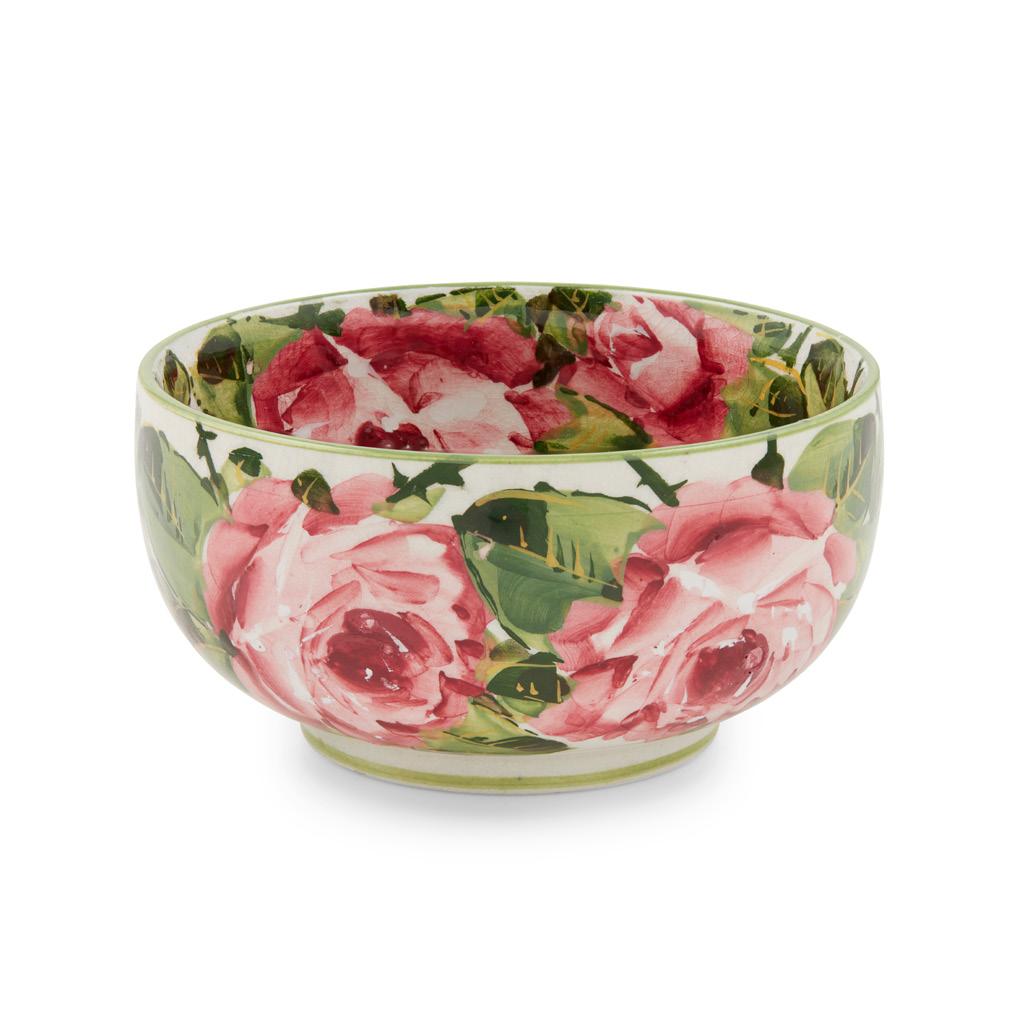
11cm diameter
£400-600
TWO PIECES OF WEMYSS WARE
‘CABBAGE ROSES’ PATTERN, CIRCA 1900 comprising a beaker vase, impressed WEMYSS, green painted Wemyss, 17cm high, and a feeding cup, printed T.Goode & Co retailer’s mark, 16cm wide (2) the larger 17cm high
£200-300
A WEMYSS WARE COMB TRAY
‘CABBAGE ROSES’ PATTERN, CIRCA 1900 impressed WEMYSS, yellow painted Wemyss
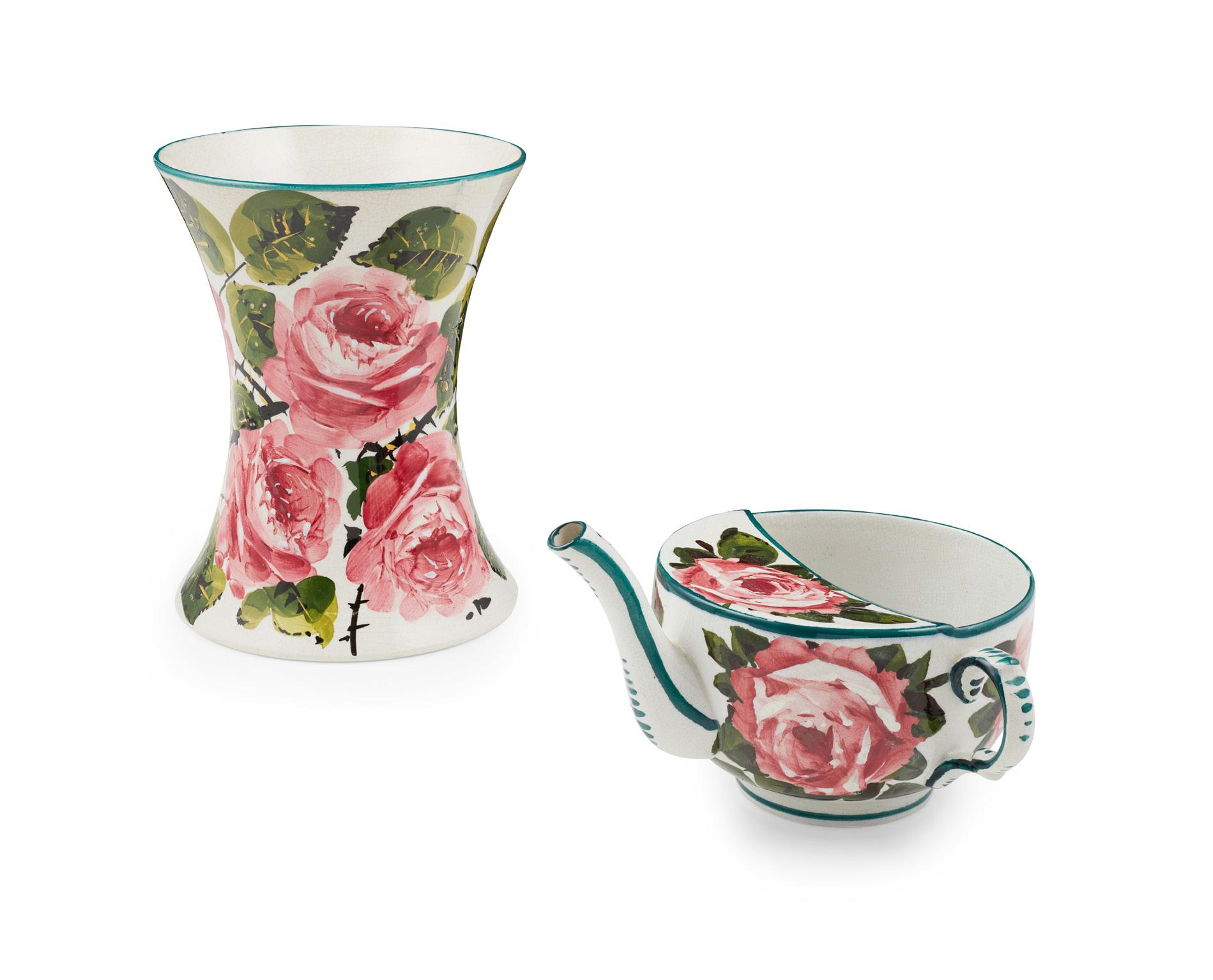
25.5cm wide
£300-500
52
53
51
25
55
A WEMYSS WARE PLATE ‘FIFIES’ PLATE, CIRCA 1900 impressed WEMYSS WARE / R.H & S, printed T. Goode & Co retailer’s mark 19cm diameter
£300-400
A WEMYSS WARE PLATE ‘FIFIES’ PATTERN, CIRCA 1900
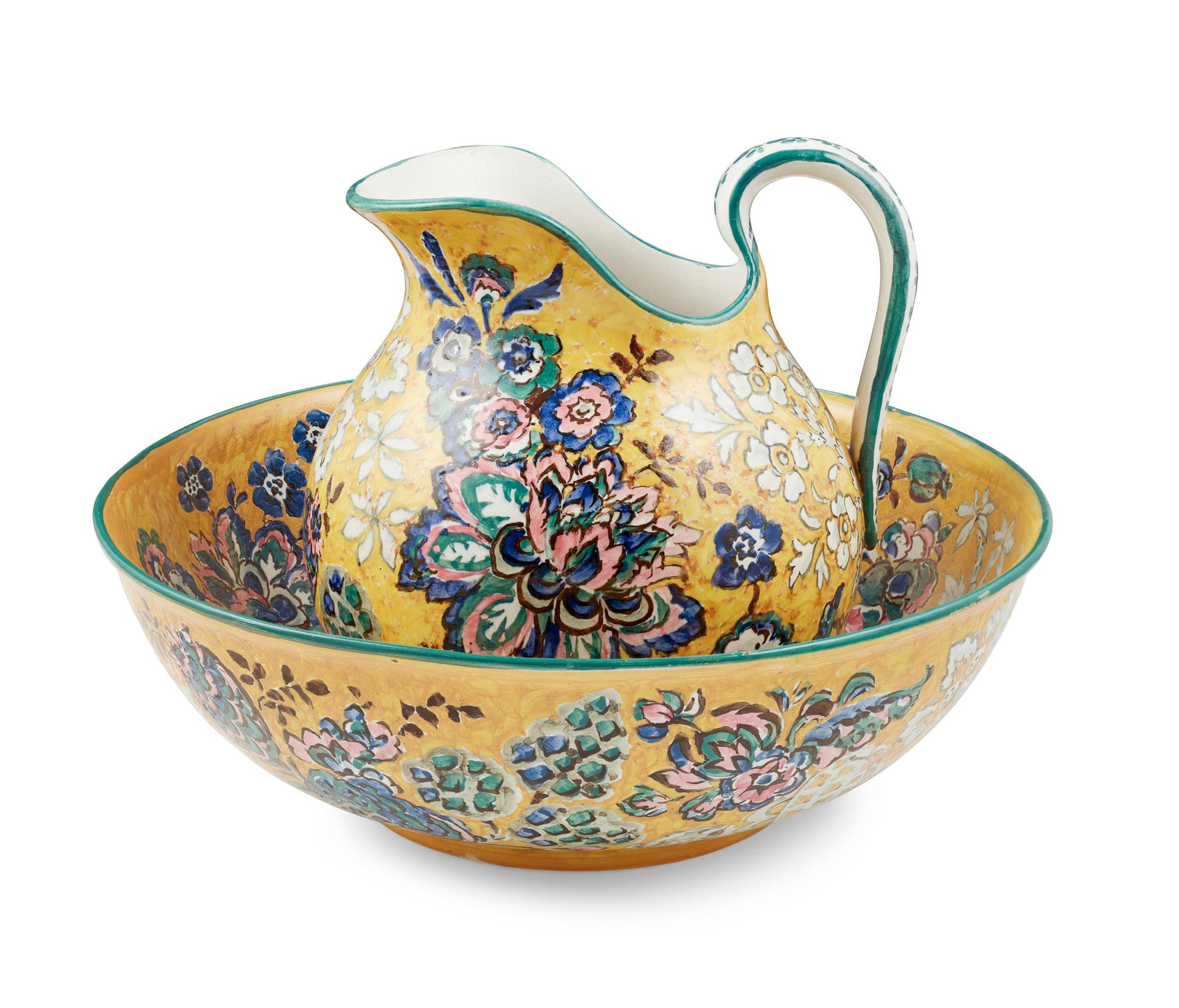
painted by Karel Nekola with ships and boats within a blue enamelled and moulded border with a gold, scalloped rim, painting signed K N, unmarked 26cm diameter
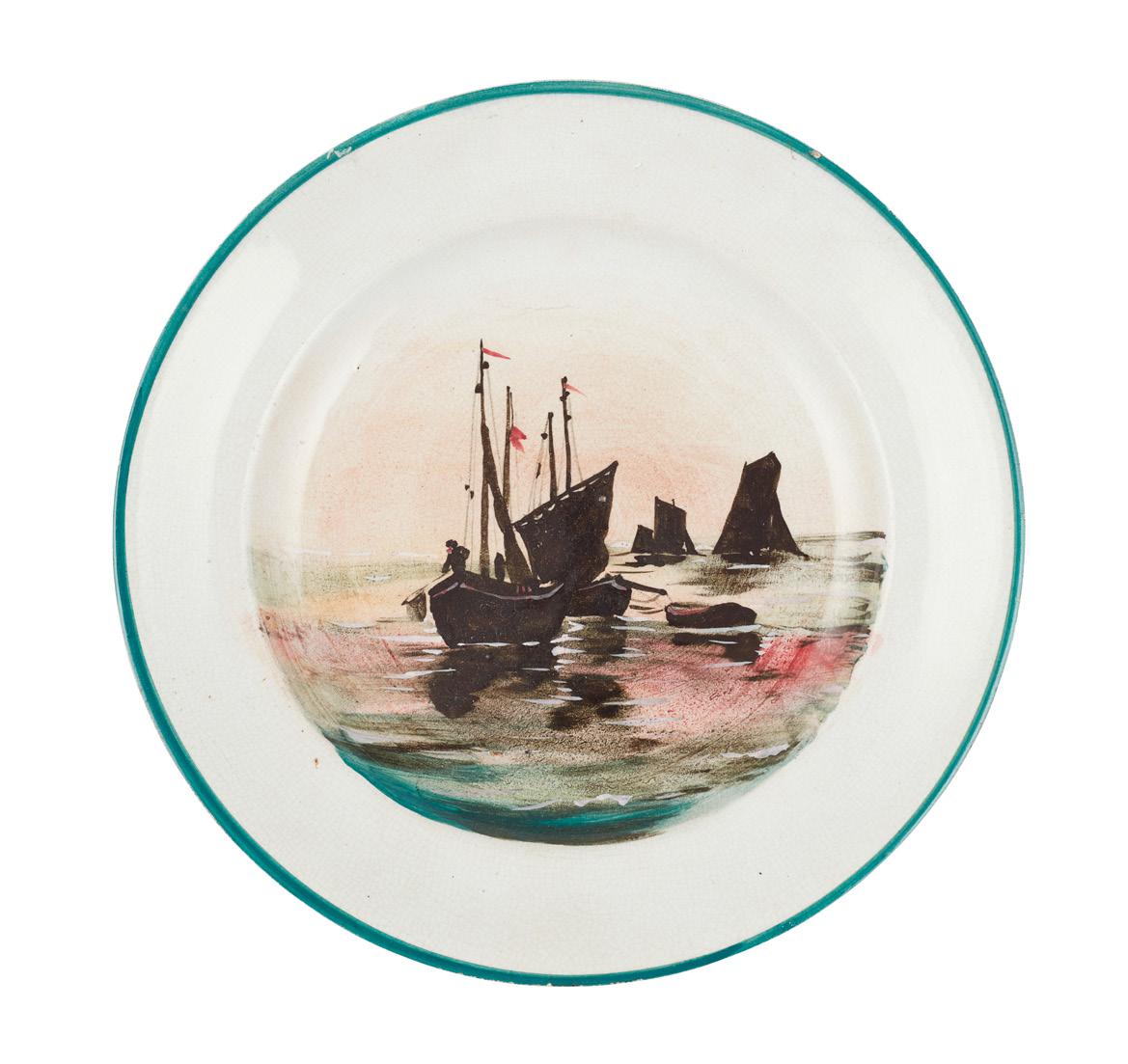
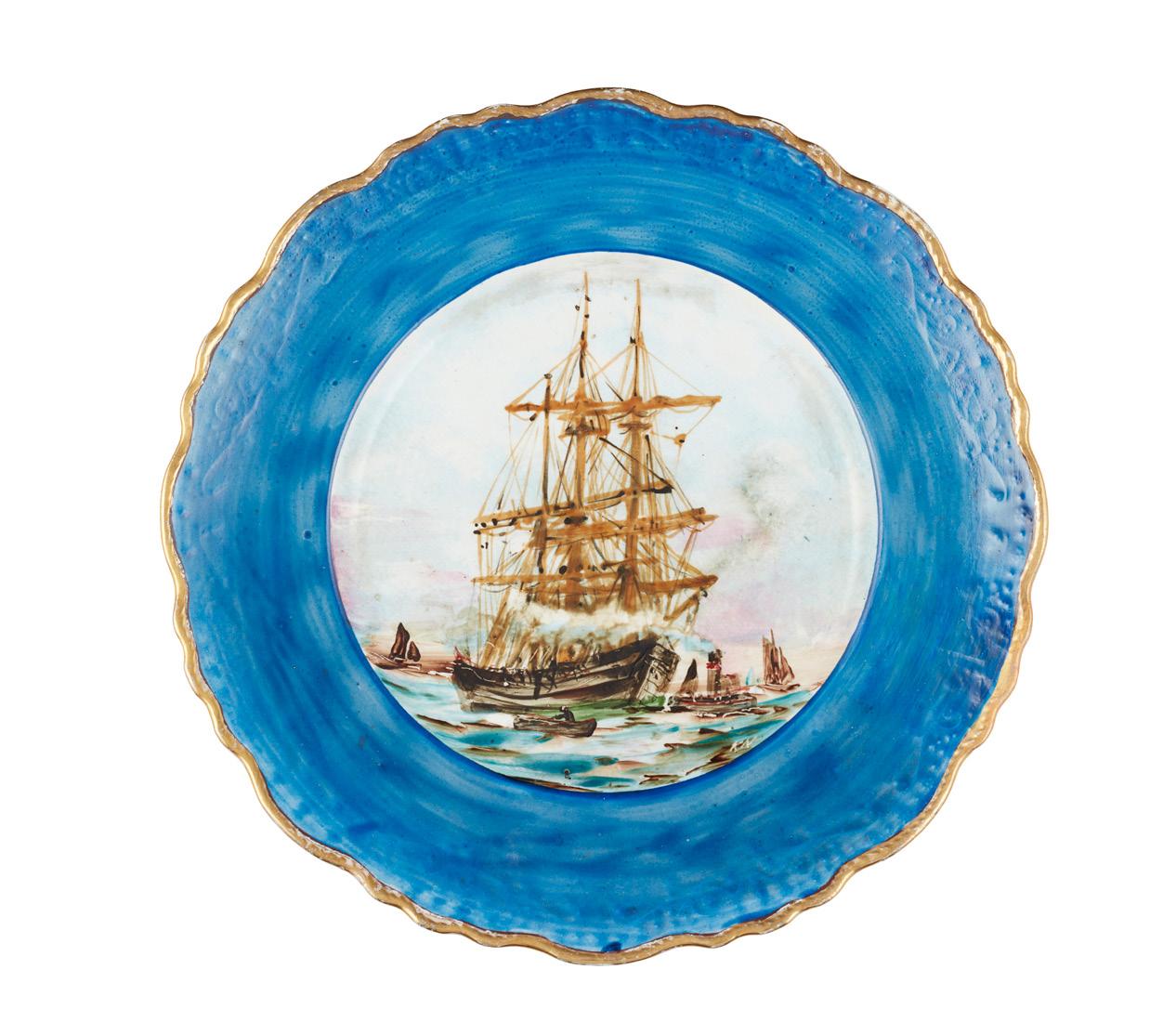
Provenance: Sticker for Wemyss Exhibition 1976, Sotheby’s Belgravia, Rogers de Rin, No. 466
£200-300
56
AN UNUSUAL WEMYSS WARE EWER AND BASIN EARLY 20TH CENTURY
painted with various flowers and foliage on a mottled yellow ground, impressed WEMYSS (2)
the ewer 26cm high, the basin 39cm diameter
£200-400
54
26 Other fees apply in addition to the hammer price: see the ‘Buyer’s Guide’ section on page 2
57
A WEMYSS WARE BUTTON CIRCA 1900
probably painted by Karel Nekola with one single rose on a dark green ground, impressed WEMYSS 2cm diameter


£200-300
60
A WEMYSS WARE BUTTON CIRCA 1900

with a painted border of violets and a green rim, impressed WEMYSS
3.1cm diameter
£400-600
CIRCA 1900
painted with three roses within a turquoise border, impressed WEMYSS
3.1cm diameter
£400-600
61
A LARGE WEMYSS WARE BUTTON CIRCA 1900
probably painted by Sandland, decorated with three roses within a green rim, green painted Wemyss
4.2cm diameter

£250-350
painted by Karel Nekola with a bee within a black band, impressed WEMYSS

3.2cm diameter
£400-600
62

A WEMYSS WARE HAT PIN

CIRCA 1900
painted with two dog roses on a black ground, impressed WEMYSS
5.1cm diameter
£200-300
CIRCA 1900
57 58 59 60 61 62 27
A WEMYSS WARE TEAPOT
‘BLACK COCKERELS AND HENS’ PATTERN, EARLY 20TH CENTURY inscribed in red ‘ Maduinn mhaith dhuibh’, faintly impressed WEMYSS WARE 12cm high
£250-350
64
A WEMYSS WARE BEAKER VASE AND A SOAP DISH
‘BLACK COCKERELS AND HENS’ PATTERN vase impressed WEMYSS, soap dish impressed WEMYSS, green painted Wemyss and printed T. Goode & Co mark (2) vase 15.4cm high, soap dish 13.4cm wide


65
A WEMYSS WARE DOUBLE VICTORIA INKWELL ‘BROWN COCKEREL AND HEN’ PATTERN impressed WEMYSS
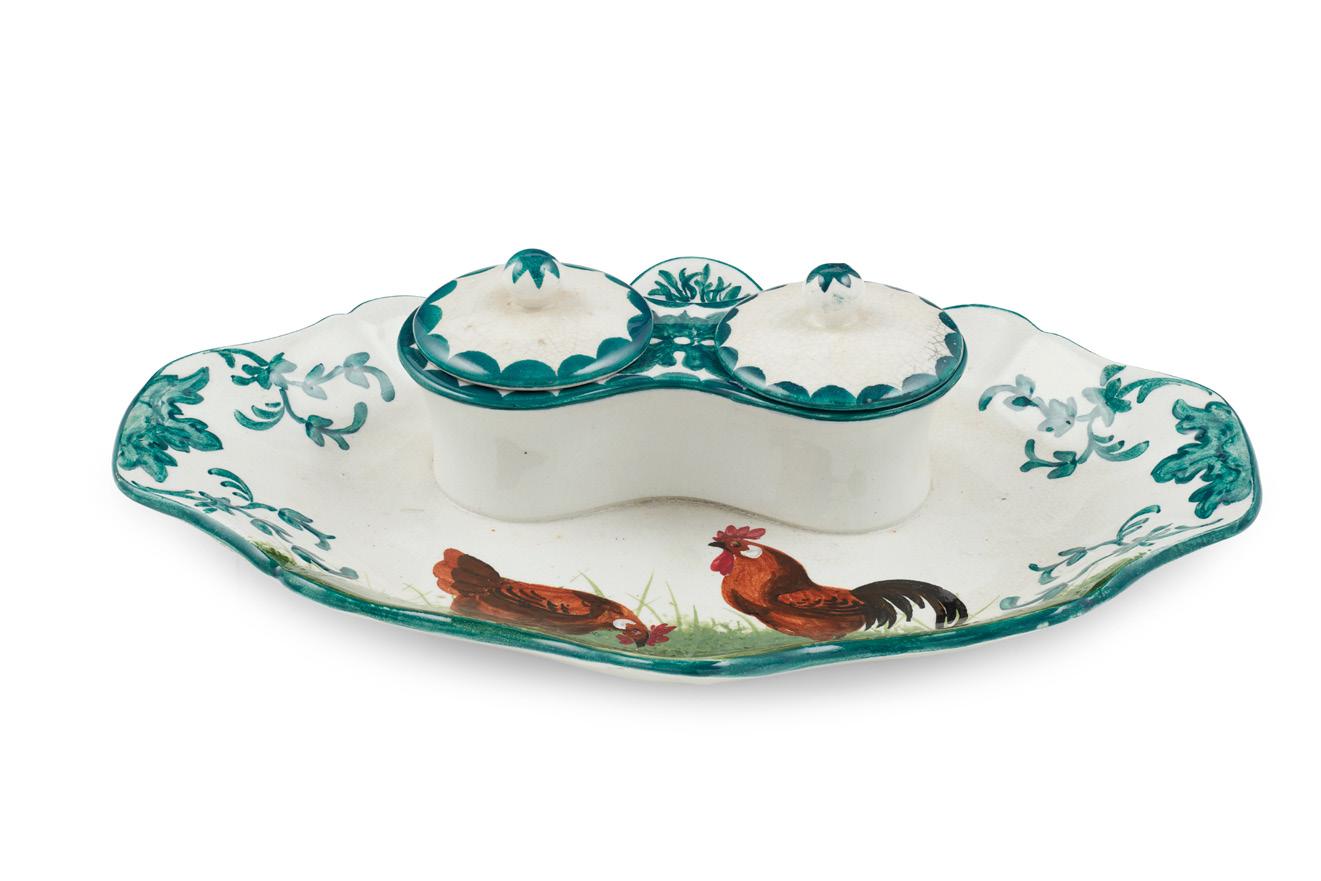
26cm wide
£200-300
£150-250 66
A WEMYSS WARE MEDIUM BASKET ‘BROWN COCKERELS AND HENS’ PATTERN, CIRCA 1900 impressed WEMYSS WARE / R.H & S, printed T. Goode & Co

31cm wide, 20cm high
£250-350
63
28
A LARGE WEMYSS WARE MUG ‘PHEASANTS’ PATTERN, CIRCA 1900 with green painted rim and handle, impressed WEMYSS

14cm high
£250-350
A WEMYSS WARE BEAKER VASE ‘EARLSHALL’ PATTERN, EARLY 20TH CENTURY painted WEMYSS, 11cm high

£250-350
69
A WEMYSS WARE MUG AND PLATE ‘BROWN COCKERELS AND HENS’ PATTERN, CIRCA 1900

the mug with a red painted rim, impressed WEMYSS WARE / R.H & S, printed T Goode & Co retailer’s mark, 9cm high; the plate with a shaped green painted rim and square section well, impressed WEMYSS, green painted T Goode & Co retailer’s mark (2) 27cm wide
£300-400 70
A WEMYSS WARE DOUBLE VICTORIA INKWELL ‘GEESE’ PATTERN impressed WEMYSS WARE / R. H & S mark 26cm wide
£200-300
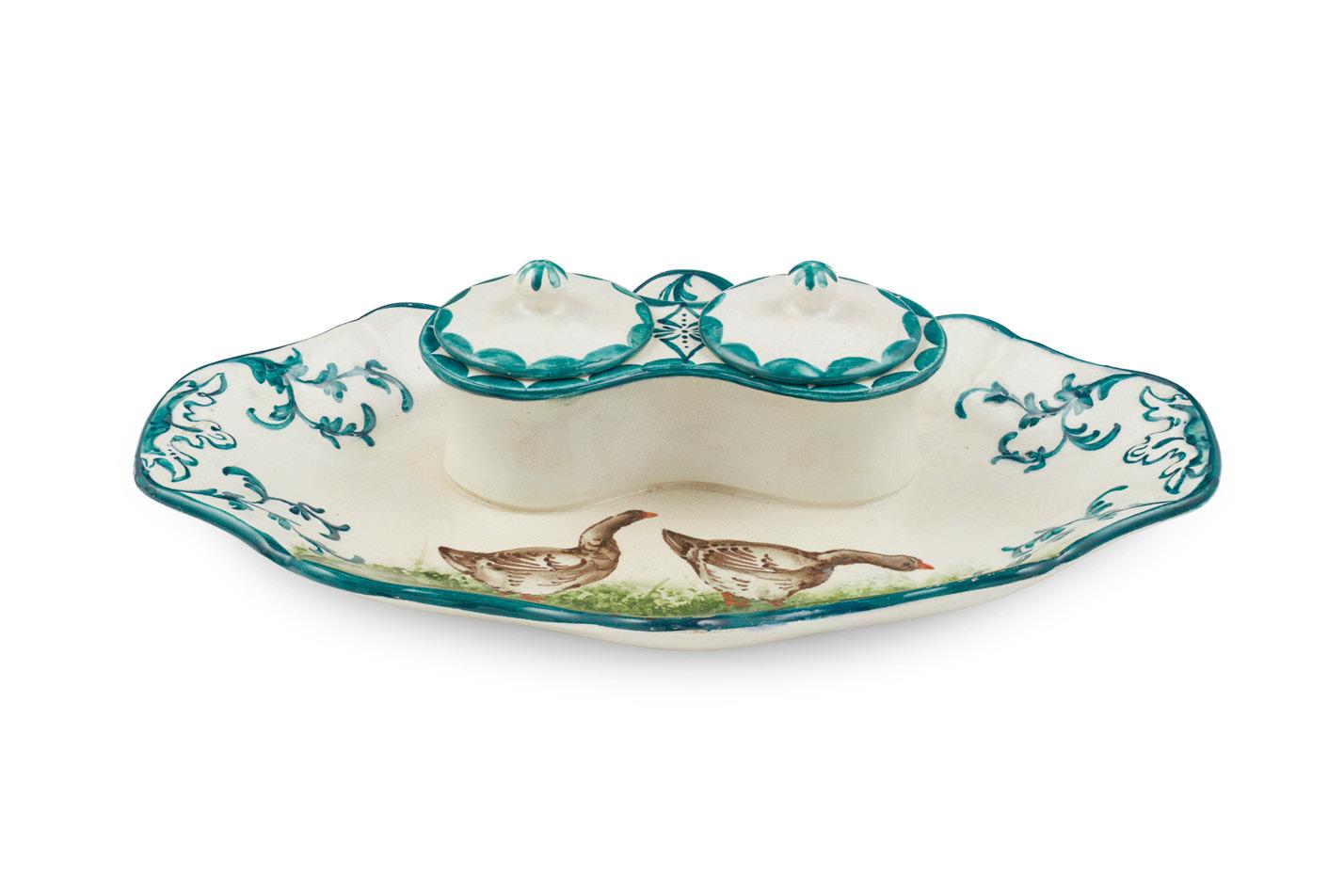
68
67
29 Other fees apply in addition to the hammer price: see the ‘Buyer’s Guide’ section on page 2
72
A WEMYSS WARE
TRAY
‘VIOLETS’ PATTERN
painted by James Sharpe, impressed WEMYSS, yellow painted Wemyss 26cm wide £200-300
71
A WEMYSS WARE LETTER RACK
‘DOG ROSES’ PATTERN, EARLY 20TH CENTURY

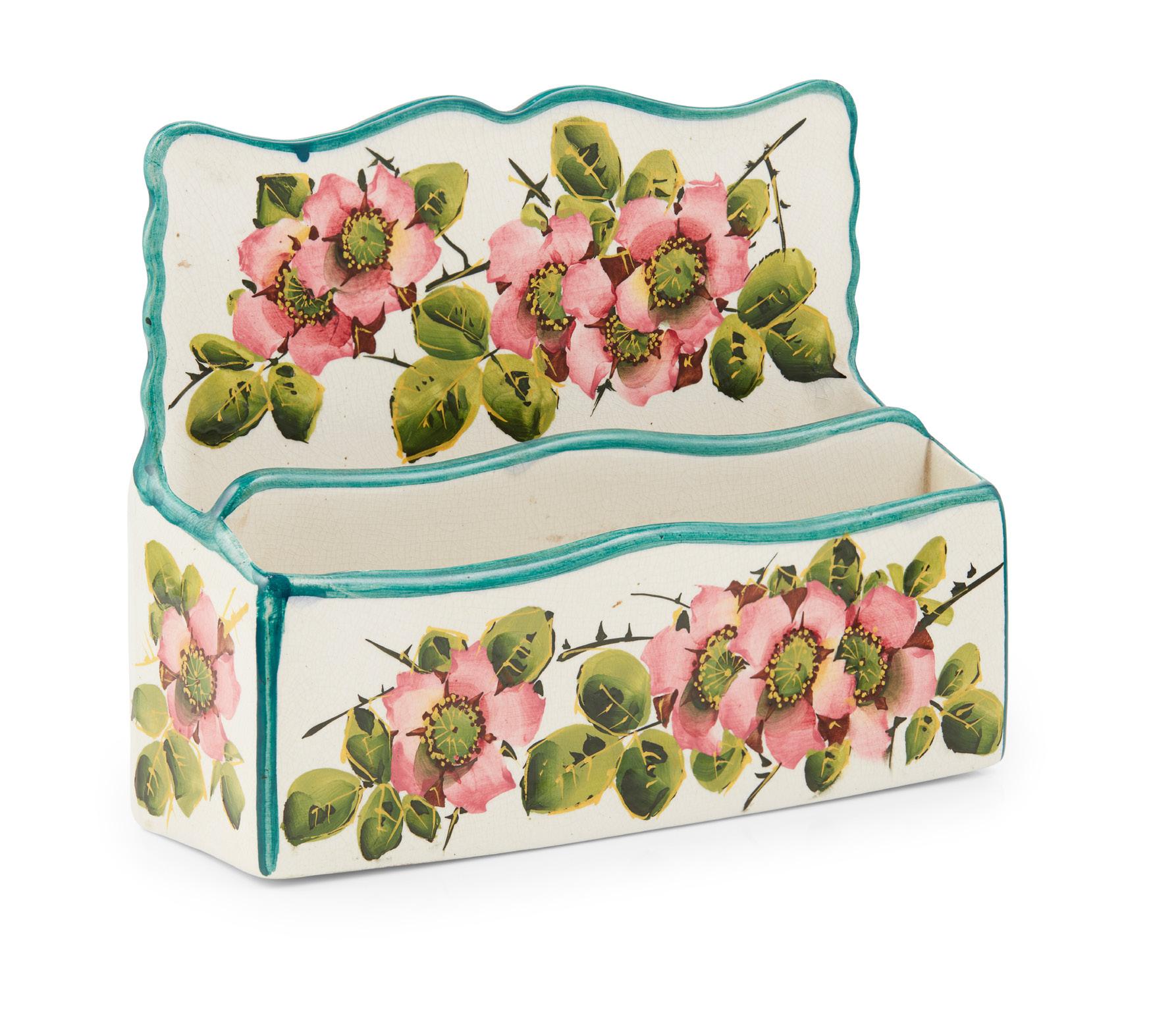
painted to the front and back, with two divisions, impressed WEMYSS, black painted Wemyss
22.5cm wide, 28cm high
£800-1,200
30 Other fees apply in addition to the hammer price: see the ‘Buyer’s Guide’ section on page 2
A WEMYSS WARE THISTLE SHAPED VASE ‘CARNATIONS’ PATTERN

impressed WEMYSS and printed T. Goode & Co mark
14.2cm high
£150-250
74
A WEMYSS WARE LARGE MUG ‘TULIPS’ PATTERN, CIRCA 1900 impressed WEMYSS WARE / R. H & S mark

14.2cm high
£200-300
75
A WEMYSS WARE TYG ‘IRISES’ PATTERN

impressed WEMYSS, printed T. Goode & Co retailer’s mark
14cm high
£150-250
76
A WEMYSS WARE HEART SHAPED INK WELL ‘FORGET-ME-NOT’ PATTERN, CIRCA 1900 with original liners, impressed WEMYSS
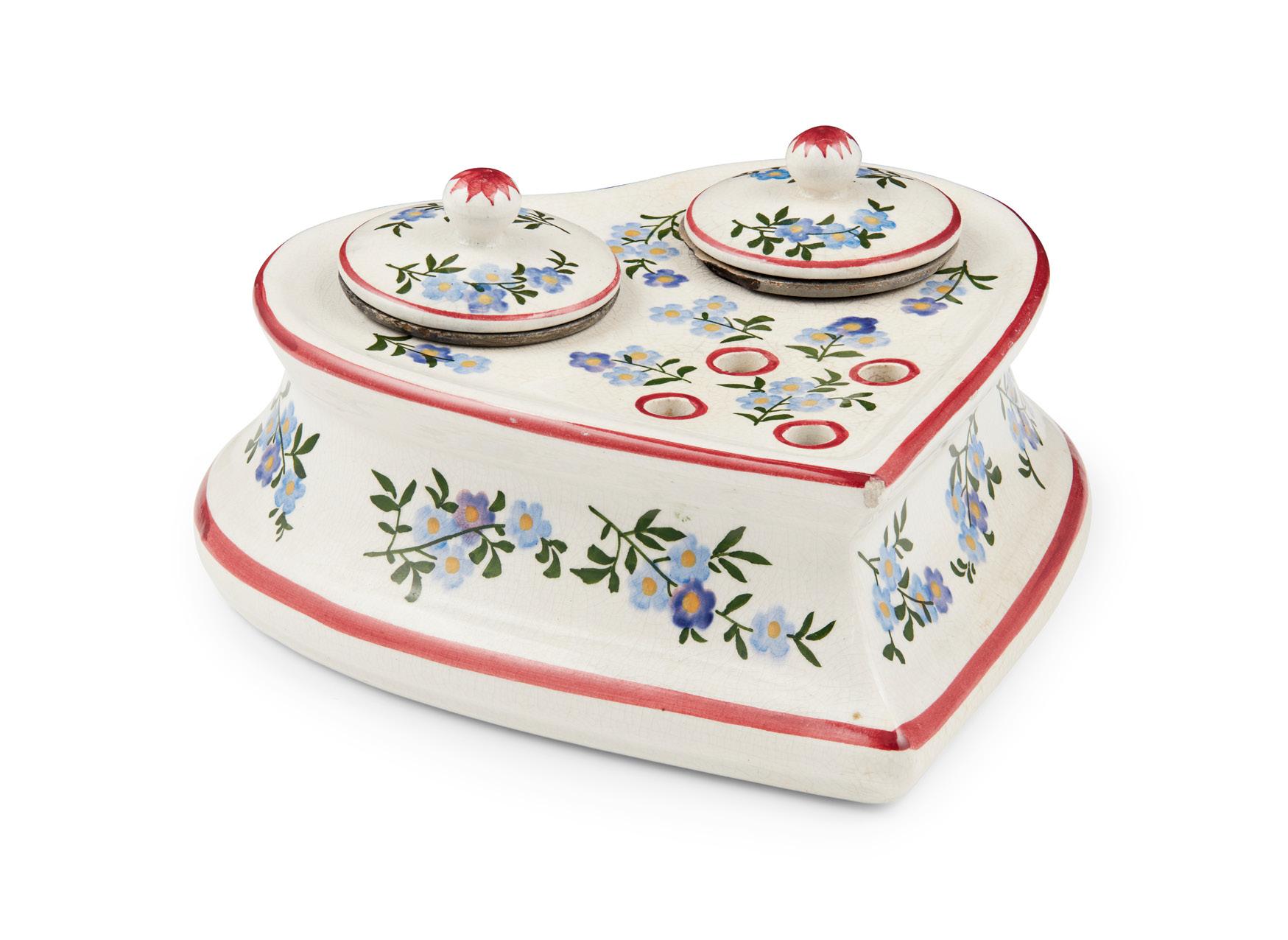
18cm wide
£200-300
73
31
A WEMYSS WARE LARGE PRESERVE POT ‘BLACKCURRENT’ PATTERN
impressed WEMYSS WARE / R. H & S and printed T. Goode & Co retailer’s mark, 16cm high, together with a WEMYSS ‘PLUMS’ BISCUIT BARREL, the cover inscribed ‘Biscuits’, painted by James Sharpe, impressed WEMYSS, yellow painted Wemyss / T. Goode & Co / London, 12cm high (2) the larger 16cm high
£200-300
78
A WEMYSS WARE GORDON DESSERT PLATE
‘PLUMS’ PATTERN, CIRCA 1900

impressed WEMYSS, black painted Wemyss 21cm diameter
Wemyss Exhibition 1976, Sotheby’s Belgravia, Rogers de Rin £250-350
79
A WEMYSS WARE COMBE FLOWER POT ‘APPLES’ PATTERN, CIRCA 1900 impressed WEMYSS, black printed T. Goode & Co mark 17cm high

£250-350
80
A COLLECTION OF WEMYSS WARE ‘CHERRIES’ PATTERN, EARLY 20TH CENTURY

comprising a tall quaich, 12cm high, a single ink well, 16cm diameter, an oblong tray, 28cm wide, and a Gordon dessert plate painted by James Sharpe, 21cm diameter, with various impressed and T. Goode & Co retailer’s marks (4) the largest 28cm wide £250-350
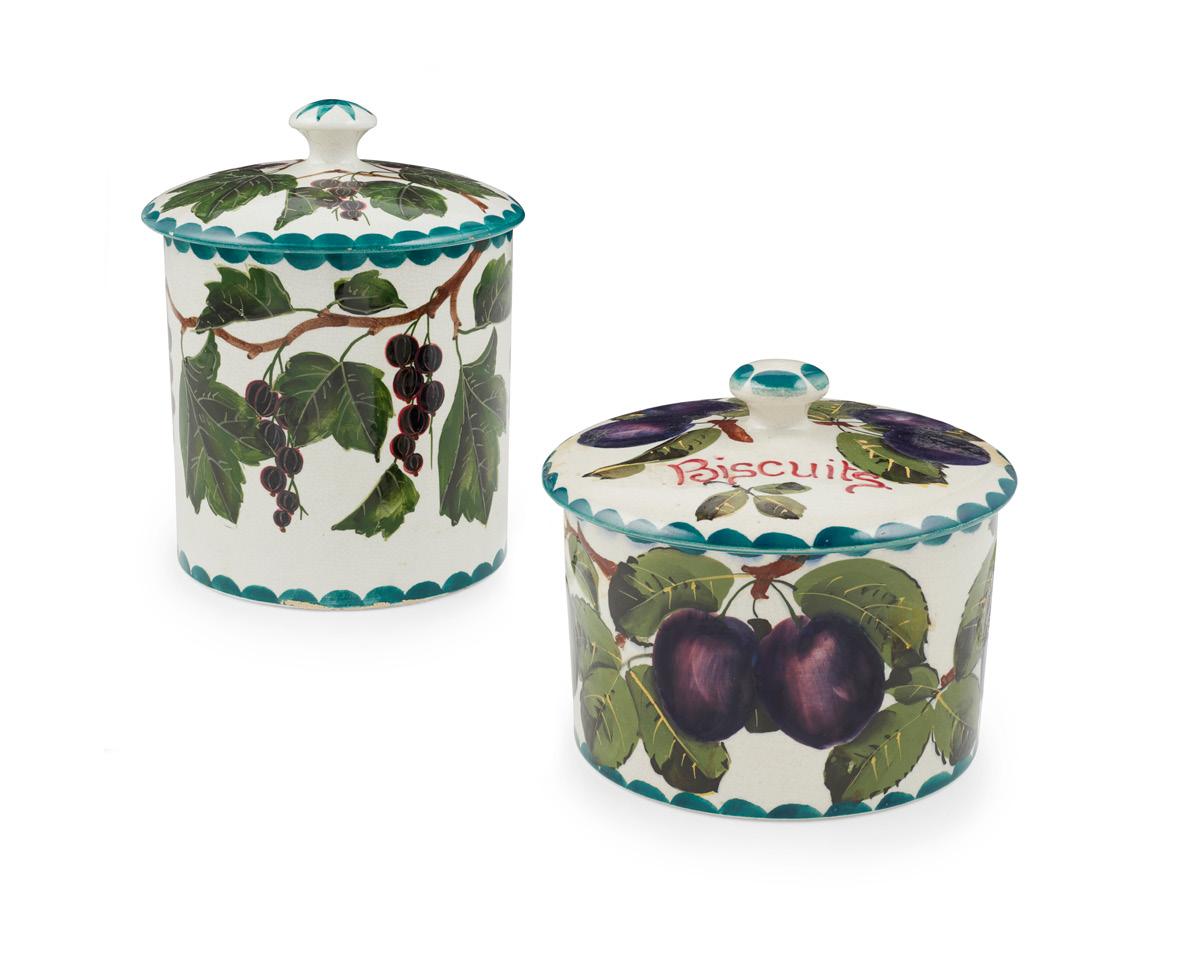
77
32
81
THREE PIECES OF WEMYSS WARE POTTERY
EARLY 20TH CENTURY comprising a ‘Chrysanthemum’ biscuit barrel, painted by Karel Nekola, the flowers painted on a black ground, the cover inscribed ‘Biscuits’, green painted Wemyss mark, 16cm high, a ‘Jazzy Roses’ beaker vase, painted Wemyss 218, 15.8cm high, and a green razor holder, the cover with a white enamelled monogram, possibly W A Y, unmarked, 20cm long (3) the largest 20cm long £200-300

82
THREE WEMYSS WARE GORDON DESSERT PLATES ‘APPLES’, ‘BLACKCURRENTS’ AND ‘SHAMROCKS’ PATTERN
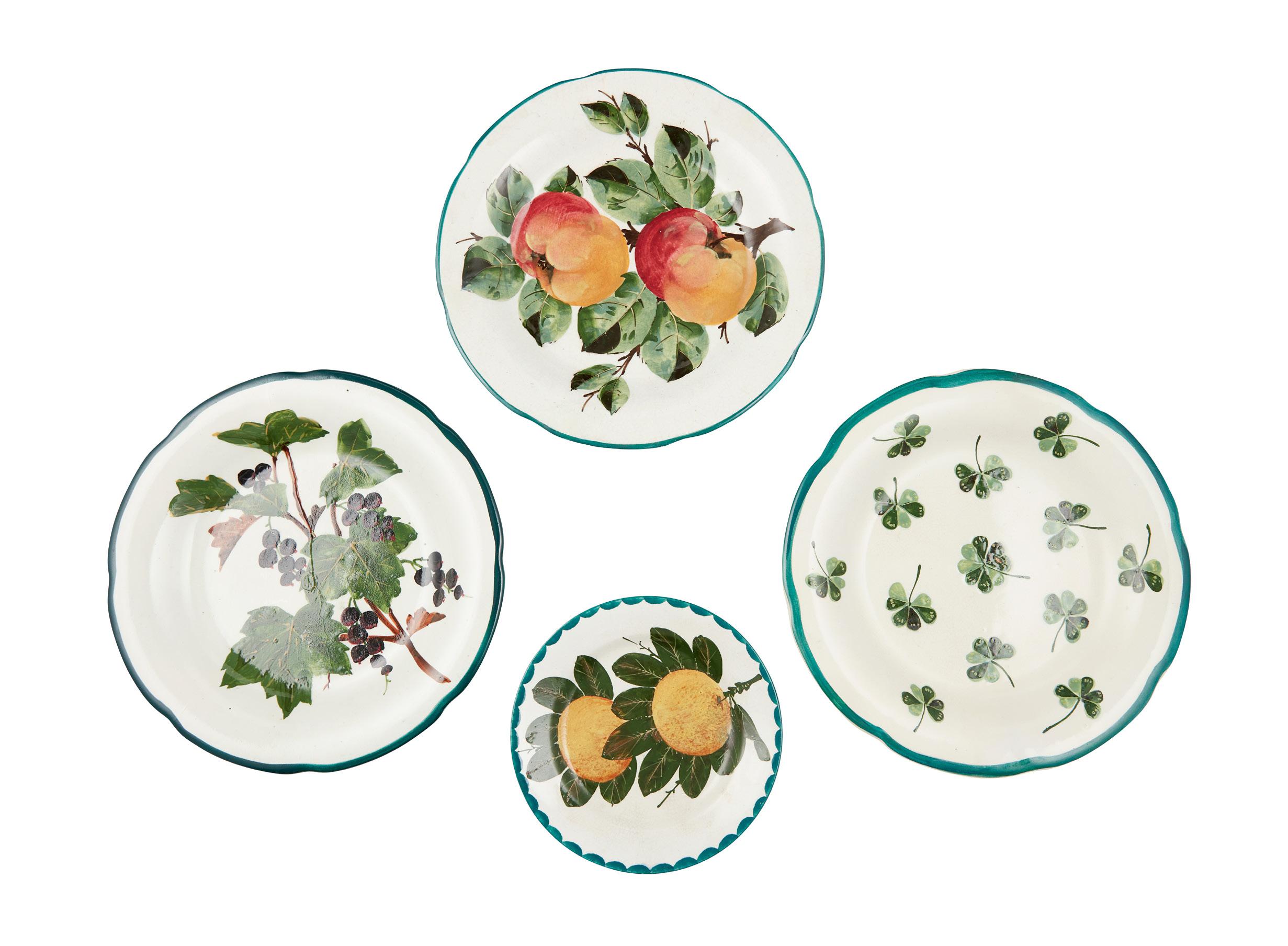
the ‘Apples’ plate painted by James Sharpe, all 21cm diameter; together with a small ORANGES STAND, 14cm diameter, all with various impressed and painted marks (4) the larger 21cm diameter
The ‘Shamrocks’ plate with a sticker for Rogers de Rin, London £300-500
33 Other fees apply in addition to the hammer price: see the ‘Buyer’s Guide’ section on page 2
A WEMYSS WARE MONEY BOX PIG ‘CLOVER’ PATTERN, CIRCA 1900 painted by James Sharpe, impressed WEMYSS, yellow painted Wemyss 16cm long



£300-500
£300-500
sponged decoration, impressed WEMYSS WARE R.H. & S mark 16cm long
£400-600
83
A WEMYSS WARE MONEY BOX PIG CIRCA 1900 with a green glaze, impressed WEMYSS 16cm long
A WEMYSS WARE MONEY BOX BLACK AND WHITE PIG CIRCA 1900
83 85 84 34 Other fees apply in addition to the hammer price: see the ‘Buyer’s Guide’ section on page 2
86
A RARE WEMYSS WARE MONEY BOX PIG ‘VIOLETS’ PATTERN, EARLY 20TH CENTURY inscribed ‘Letitia’, painted Wemyss 16.5cm long


£1,000-1,500
87
A WEMYSS WARE MONEY BOX PIG ‘THISTLES’ PATTERN, CIRCA 1900 impressed WEMYSS, green painted Wemyss 16cm long


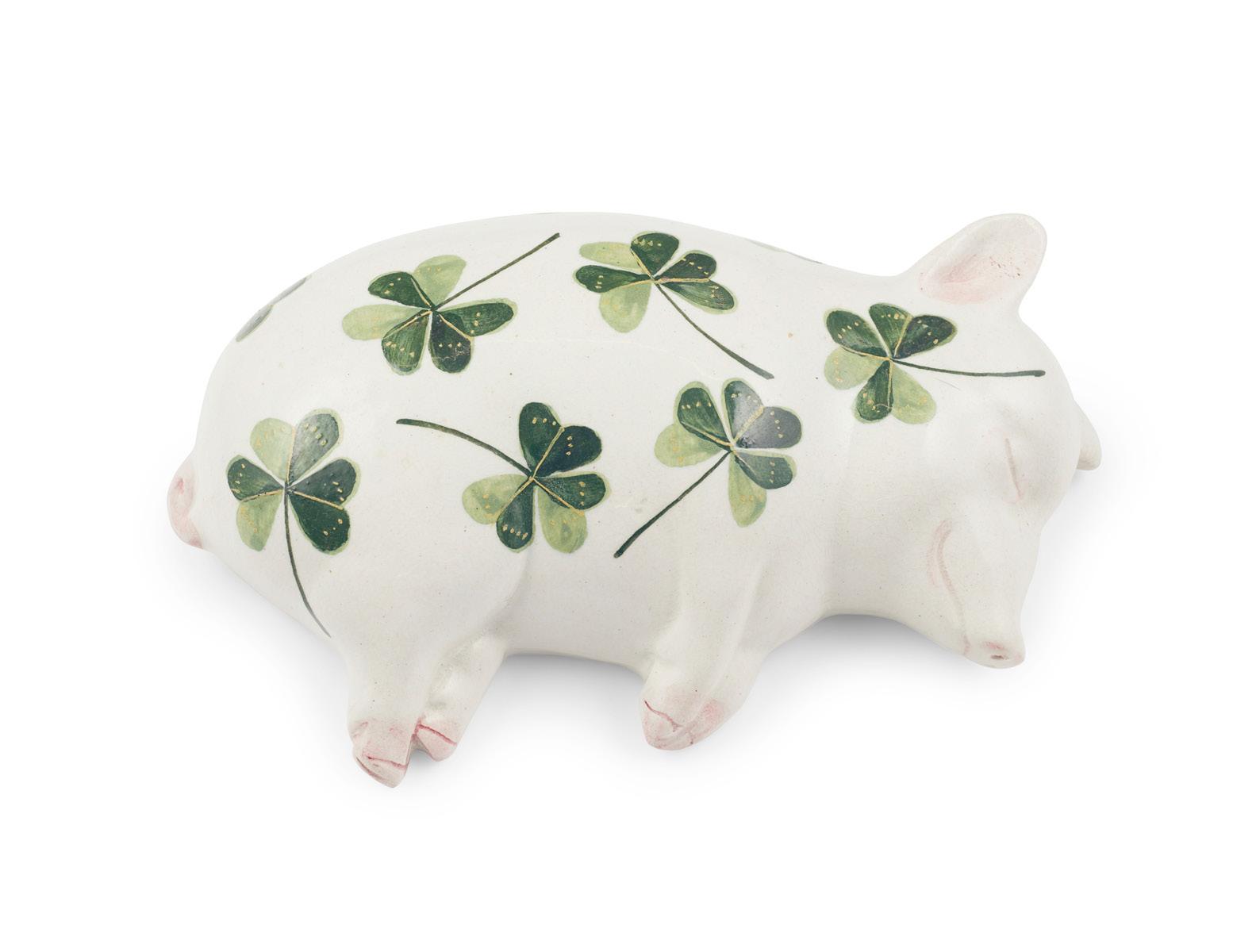
£600-800
88
A WEMYSS WARE SLEEPING PIGLET ‘SHAMROCKS PATTERN’, CIRCA 1900 impressed WEMYSS 16cm long
£2,000-3,000

35
89
A SMALL WEMYSS WARE PIG
‘CABBAGE ROSES’ PATTERN, CIRCA 1900 impressed WEMYSS 16cm long
£250-350
90
A SMALL WEMYSS WARE PIG
EARLY 20TH CENTURY white glazed, impressed WEMYSS WARE / R. H. & S. 16cm long
£200-300
91
A LANGTOUN WARE MONEY BOX PIG
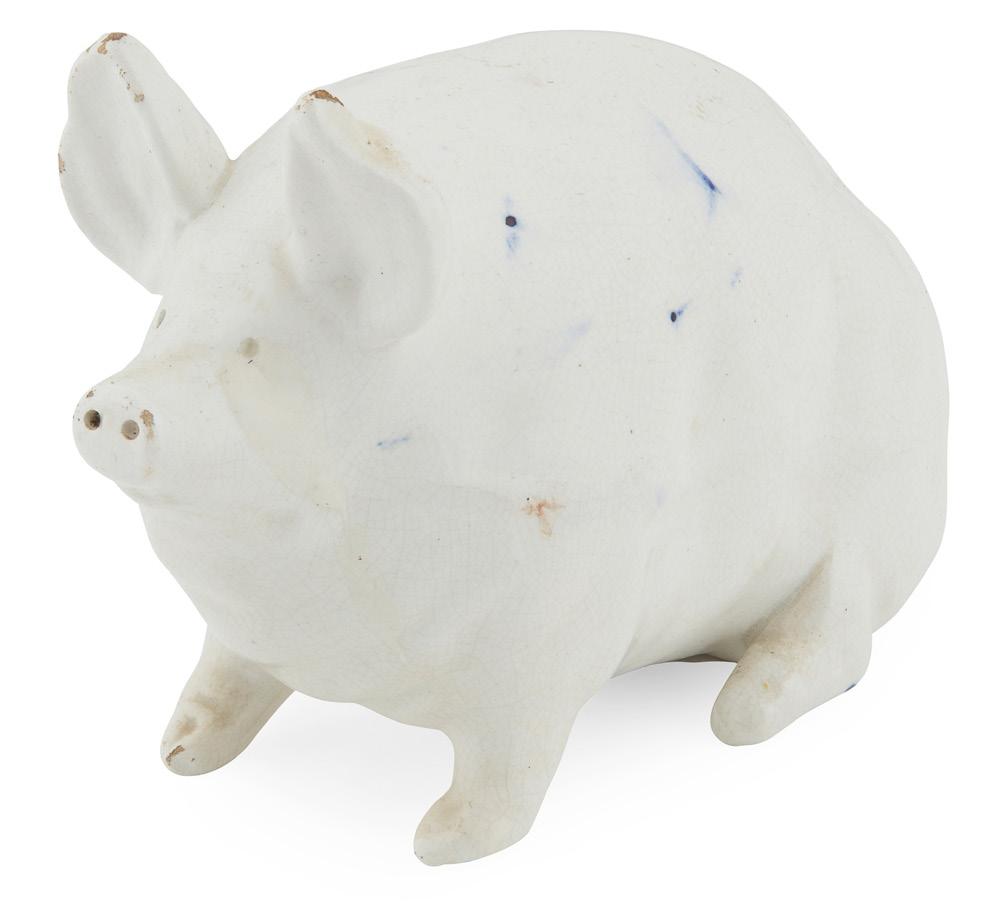


EARLY 20TH CENTURY
painted with stylised floral decoration in shades of blue, yellow, green and brown, painted W65 16.5cm long
£200-300
36 Other fees apply in addition to the hammer price: see the ‘Buyer’s Guide’ section on page 2

COLLECTABLE SILVER & JEWELLERY
A VICTORIAN CITRINE AND HARDSTONE BROOCH UNMARKED
of circular outline, claw set to the centre with a Cairngorm citrine, in a border of various hardstones including, bloodstone, Montrose agate, in a stylised border

£300-500
A PAIR OF VICTORIAN GOLD MOUNTED SCOTTISH AGATE EARRINGS

the oval drops with an engraved border and set to the rim and the internal drop with polished agate panels
A VICTORIAN HARDSTONE KILT PIN
modelled as a basket-hilted sword, set with chalcedony and bloodstone, with ball finials; together with another kilt pin, modelled as a dirk, with pastes set to the terminal and the bi-knife and fork (2)
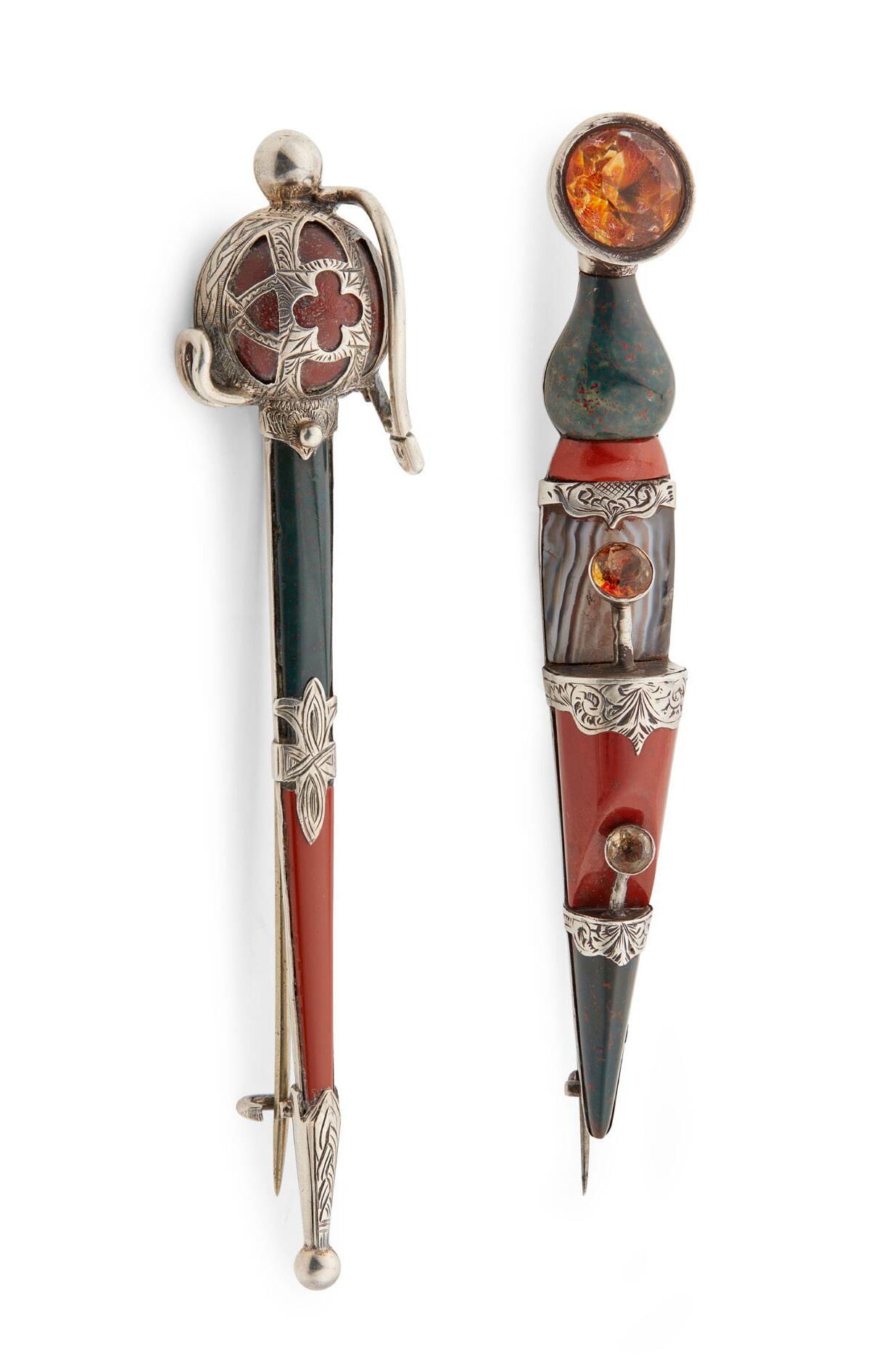
92
38
95
A VICTORIAN HARDSTONE AND GEM-SET BROOCH of circular outline, set with various panels of agates, an applied thistle to the centre with pearl and amethyst flowerheads, modelled in an unmarked yellow metal with a loop bale and brooch fitting
6cm diameter
£600-800 97
A VICTORIAN HARDSTONE AND CITRINE SET BROOCH
UNMARKED
96
A VICTORIAN SCOTTISH GOLD MOUNTED AGATE BROOCH UNMARKED of shaped oval outline with varicoloured agate panels, centrally set with a saltire cross and crown similar set, with a hinged pin and safety chain 5.5cm high

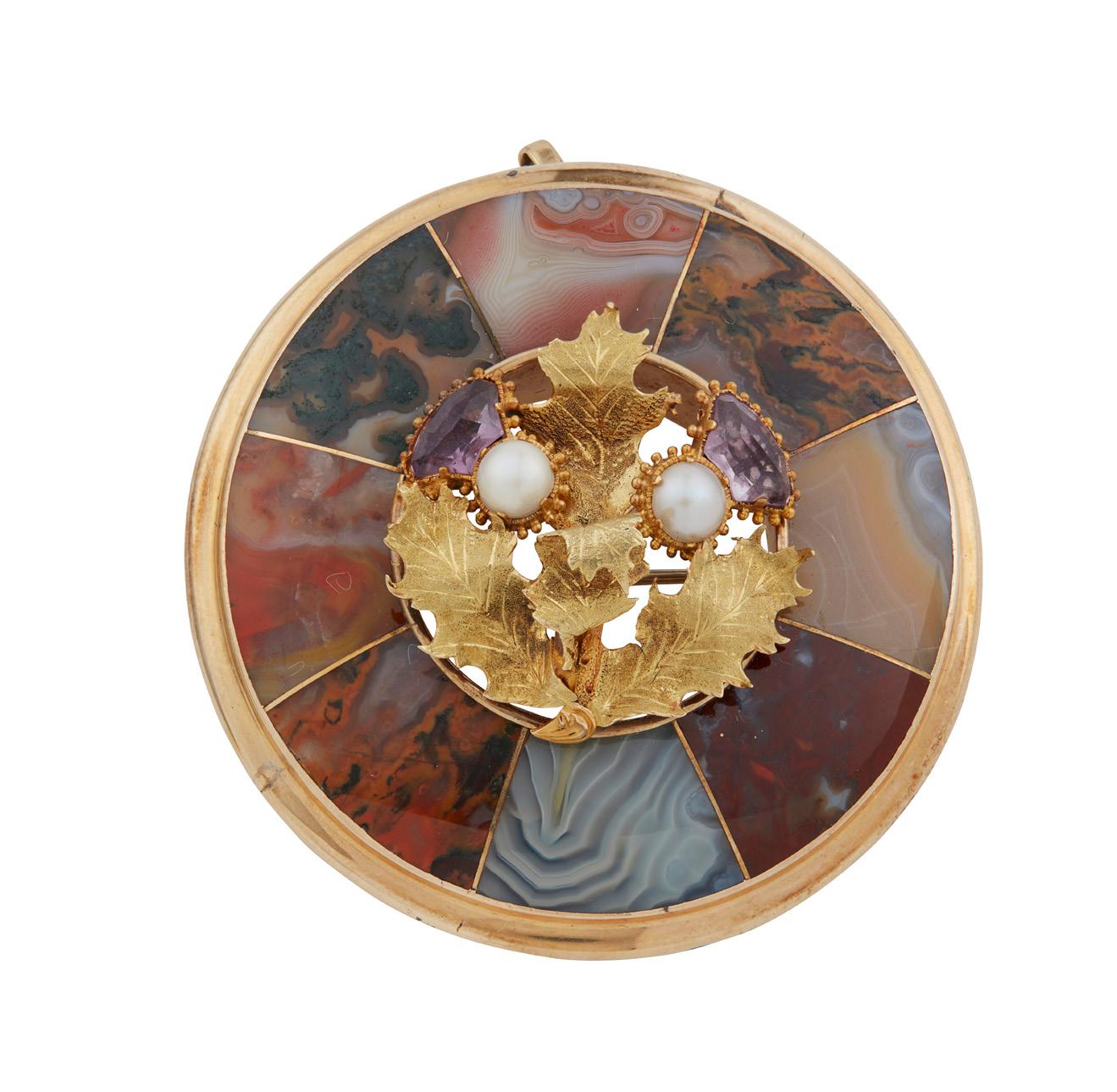
£350-500
of circular outline, claw set to the centre with a Cairngorm citrine, in a pierced scroll border, the outer border set with alternating panels of hardstones, including bloodstone, Montrose agate etc and orange pastes, with brooch and bale fittings; together with another smaller similar example; a shield surmounted with a crown-shaped brooch, set with a citrine and various pastes and a scroll-shaped hardstone brooch (4)
£300-500
98
A COLLECTION OF THREE VICTORIAN ANNULAR HARDSTONE BROOCHES
UNMARKED each set throughout with various hardstones including, bloodstone, moss agate, Montrose agate, chalcedony, etc, with brooch fittings (3)
£300-500
39 Other fees apply in addition to the hammer price: see the ‘Buyer’s Guide’ section on page 2
100

ABERDEEN - A COLLECTION OF SCOTTISH GRANITE JEWELLERY


to include, two granite set crosses, both by John Duncan; together with an oval brooch, marked M RETTIE & SONS

ABERDEEN and another, marked JW, ABDn, composed of alternating pink and grey granite, in a stylised border (4)
5.6cm, 3.7cm length of crosses, 6.2cm, 7cm across brooches £300-500

A VICTORIAN GRANITE BRACELET
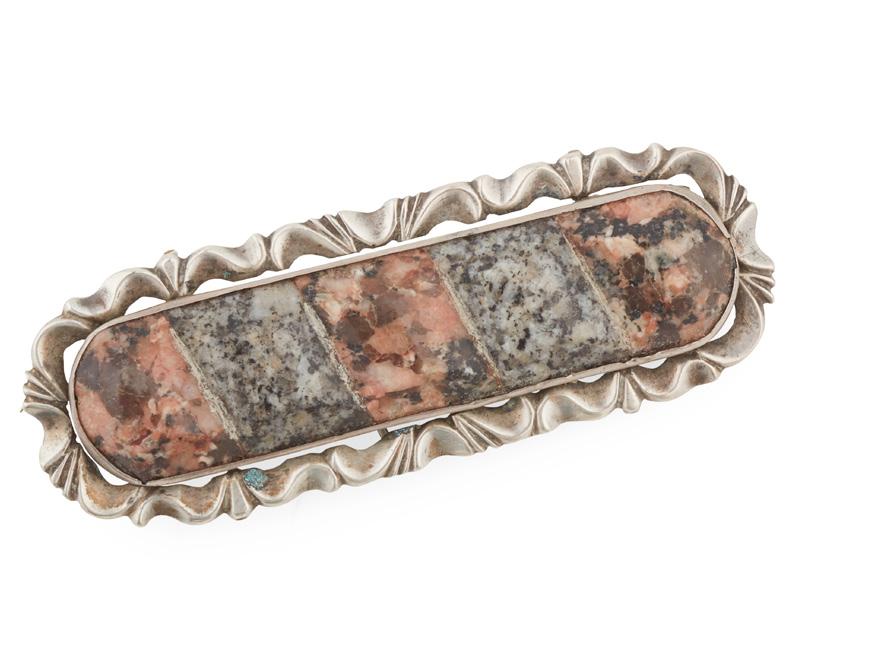
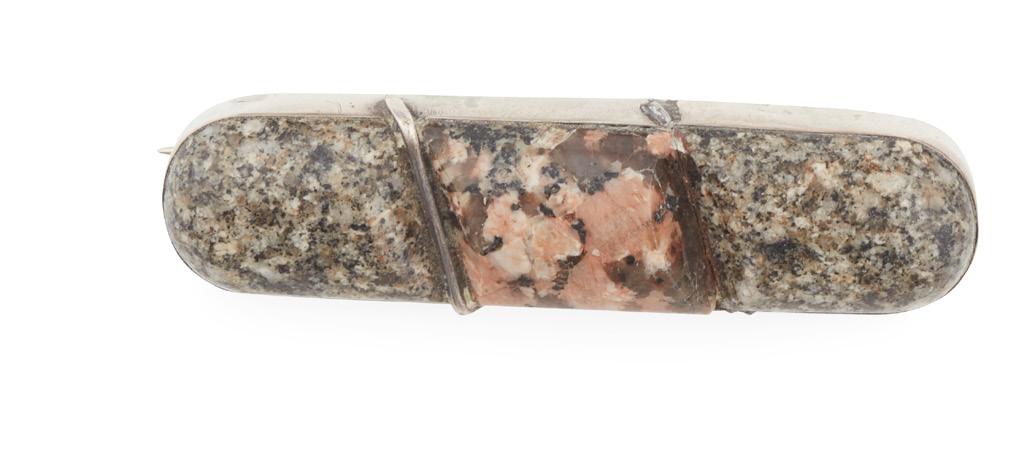
M RETTIE & SONS, ABERDEEN
marked M RETTIE/& SONS, ABERDEEN, composed of six octagon pink granite links with engraved mounts, the engraved padlock clasp with locket to reverse and silver granite panel to obverse; together with a bracelet formed of alternating silver and pink granite links and a granite bar brooch, both unmarked (3) 23cm, 22cm and 7cm long £400-600

99
40 Other fees apply in addition to the hammer price: see the ‘Buyer’s Guide’ section on page 2
A COLLECTION OF THREE VICTORIAN GRANITE BROOCHES

ABERDEEN
to include, one of oval outline; another of oval outline with an applied scallop border and one composed of quartered granite to a stylised border; together with an octagonal column granite charm, composed of alternating pink and grey granite columns, to a loop bale (4) 5.7cm, 6cm, 6.7cm across, 1.6cm height of charm
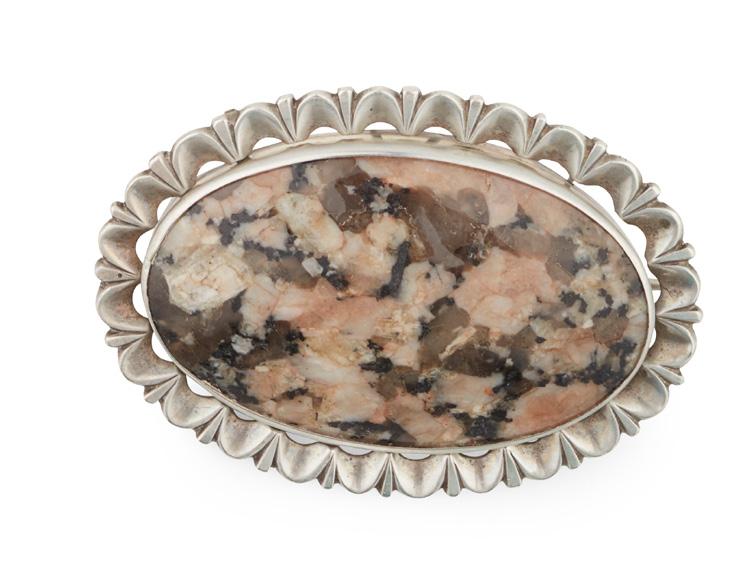


£300-500
102
A COLLECTION OF VICTORIAN GRANITE BROOCHES
ABERDEEN
to include, Jamieson of Aberdeen, the annular granite with applied intertwined scroll branches; another, J.W. of oval outline, scallop border and another similar marked A&JS, ABDN (3) 5cm, 5cm, 6.5cm across £300-500
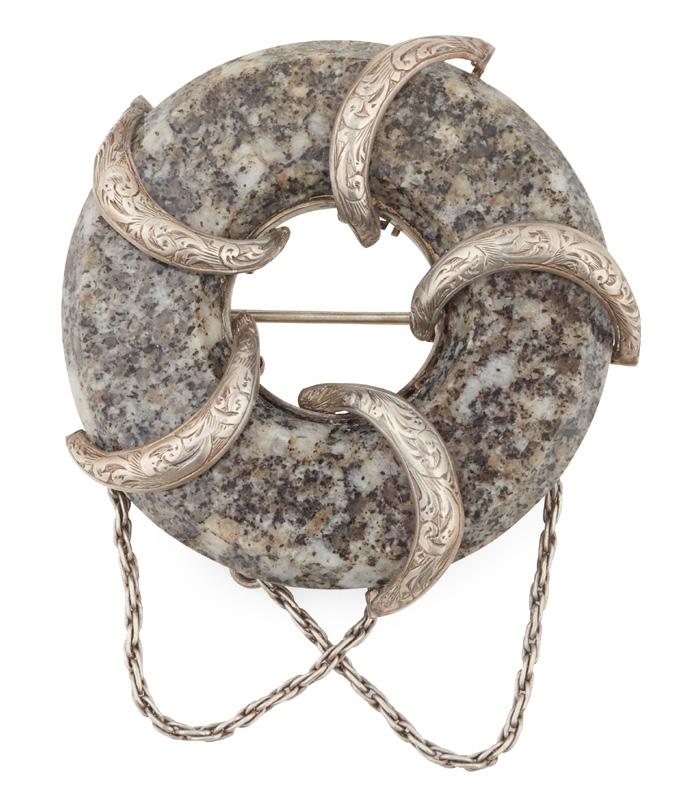
101
41
103
AN 18TH CENTURY LUCKENBOOTH BROOCH of traditional crowned heart design, engraved to the reverse ‘I S 1786, Love’, with pin fitting 7.5cm long, 24.5g
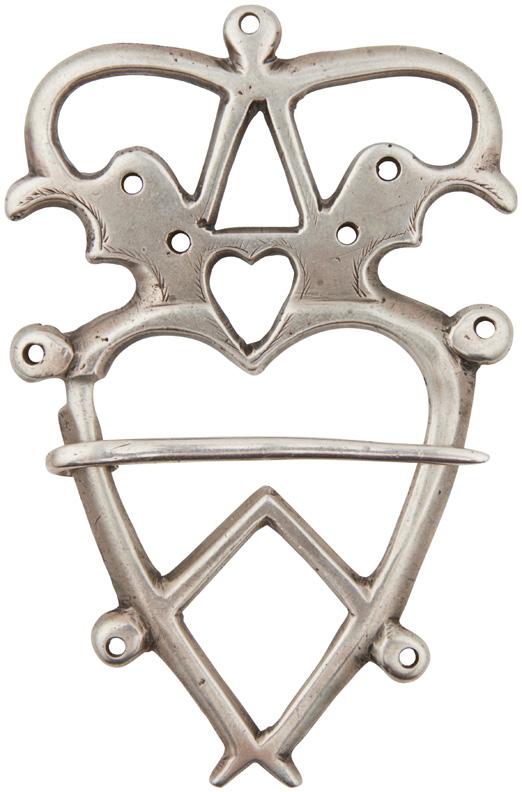
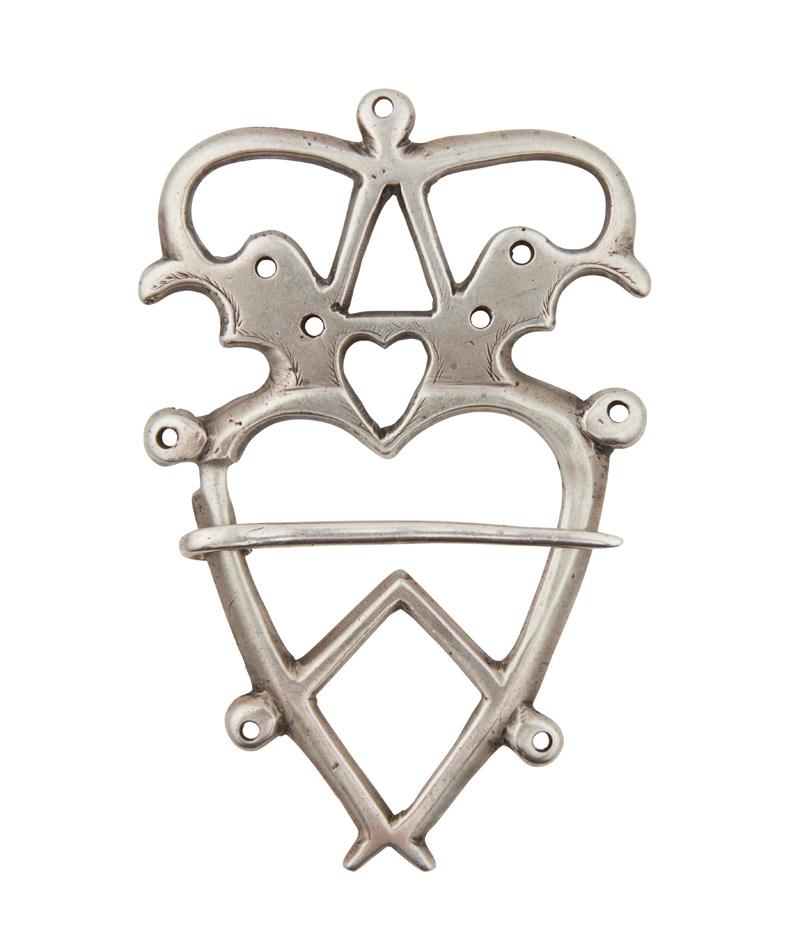
£200-300
104
AN IMPRESSIVE CASED SET OF CAIRNGORM BUTTONS comprising twenty-four larger and twelve smaller, all claw set to a loop fastening, presented in a fitted box, retailed by Fergusson & MacBean, Highland Jewellers Inverness 24cm width of case



42 Other fees apply in addition to the hammer price: see the ‘Buyer’s Guide’ section on page 2
A COLLECTION OF 9CT GOLD SCOTTISH JEWELLERY SHETLAND SILVERCRAFT, EDINBURGH
to include two 9ct gold gem-set scroll brooches from the ‘Glasgow Girls’ collection, each with a pearl dependent and another brooch modelled as a stylised tree, claw set with a citrine to the centre; together with another Celtic scroll brooch, by Ola Gorie (4)

£300-500
106
A COLLECTION OF SCOTTISH JEWELLERY

OLA GORIE, EDINBURGH
to include two pendants, one silver and one 9ct gold, each of scrolling design, to a fancy link chain and a 9ct gold Celtic scroll brooch; together with a gem set silver brooch, Shetland Silvercraft and a silver-gilt Ritchie style galleon brooch, Ralph Weston (5)

£300-500
107
THE ARMS OF HUME-CAMPBELL EARLS OF MARCHMONT AND LORDS OF POLWARTH FOB SEAL LATE 18TH CENTURY
the oval carnelian matrix with arms of Hume-Campbell, for Alexander Hume Campbell, 2nd Earl of Marchmont and Lord Polwarth (1675-1740), the domed mount with foliate engraved detail, to a scroll surmount with shell detail and a suspension loop


3.5cm overall, matrix: 2.1cm x 2cm
Heraldry: Arms: Quarterly 1st Gyronny of eight or and sable (for Campbell) 2nd and 3rd Grandquarters Quarterly 1st Vert a lion rampant argent (for Hume) 2nd Argent three papingoes vert (for Pepdie) 3rd Gules three piles engrailed argent (for Polwarth) 4th Argent a cross engrailed azure (for St Clair of Herdmanston) over all on an escutcheon azure an orange with the stalk erect slipped and over it an Imperial Crown all proper and 4th Gyronny of eight ermine and gules (for Campbell of Loudoun)
Motto: Constanter et prudenter [Firmly and prudently]
£600-800
105
43
HIGHLIGHTS FROM THE MATRIX COLLECTION PART II
108
THE CUNNINGHAM CLAN DESK SEAL
A VICTORIAN AGATE MARY QUEEN OF SCOTS MEMORIAL DESK SEAL
the facetted column engraved to the terminal with the crest and motto of Cunningham within a garter, the matrix terminal of diamond outline engraved with the coat of arms of Mary Queen of Scots, engraved M R flanking the shield
4.5cm long

Note: The matrix to this seal uses Mary Queen of Scot’s armorial seen on her signet ring. After her imprisonment at Loch Leven the seal of Mary Queen of Scots ring, came into the possession of the well-known Scottish antiquary, the Earl of Buchan who was one the few people allowed to visit her. The ring, which is now in the Royal Collection was exhibited at Holyrood Palace in 1843, and facsimiles were sold as souvenirs.

It is interesting to see here that the arms fashioned in the classic diamond shape have been applied to a seal in this instance. With a female monarch on the throne, the Victorians harked back to the few female predecessors of Victoria. The 1873 biography of Mary Queen of Scots by Agnes Strickland sought to explore the complicated personalities of Mary offering a female voice. Her arms have appeared in rings at auction, most recently, on the 5th July 2022. Sotheby’s offered a 19th-century ring with the arms of Mary Queen of Scots which achieved £6,048.
£800-1,200
109
THE BURGH OF IRVINE SEAL
A 17TH CENTURY SCOTTISH BURGH SEAL
unmarked, the simple circular silver matrix engraved with motto S’ COMMUNE BURGI DE IRVINE’ around the crest of a crowned lion gardant flanked by two trees, the simple socket set to a short wooden handle
4cm matrix diameter, 7cm long overall
Literature: Ancient Scottish seals, Henry Laing 1866 page 218 Note: This remarkable 17th-century Scottish sale is one of the earliest silver matrices to be available to private collectors. A high number of early seals such as this were made in base metal and those that do survive are most commonly found in institutions, Burgh or civic collections. One of the few silver examples to come to the open market in recent years was for the Burgh of Easter Anstruther by David Milne of Edinburgh 1613-14, sold Lyon & Turnbull Scottish Silver 16th August 2011 lot 105 (£37,250 inc. premium).
The Burgh of Irvine has been in existence since before the reign of Alexander II in the 13th century. Robert the Bruce re-erected the Royal Burgh in 1308, “mentioning it as a place of great antiquity, and from him the town obtained the right to use the royal crest on its Arms, and which appears in them as, on a shield’ “a lion sejant, fullfaced, gules, crowned or; holding in his dexter paw a naked sword proper, and in the sinister a sceptre, both erect.” The lion sejant is seen on this seal.
£1,500-2,500
44 Other fees apply in addition to the hammer price: see the ‘Buyer’s Guide’ section on page 2
110
THE DOUGLAS FAMILY DESK SEAL
AN EARLY 19TH CENTURY GOLD AND ROCK CRYSTAL SEAL
the faceted tapering rock crystal handle to a fluted mount, to a circular rock crystal matrix with the crest and motto ‘Dum vivimus vivamus’ of Douglas
5.5cm long, matrix:2cm diameter
£400-600
111
A VICTORIAN HARDSTONE AND SILVER DESK SEAL
JAMES AITCHISON, EDINBURGH 1900
the domed handle and tapering stem set throughout with various panels of hardstones, with engraved scroll and foliate decoration, the orange paste matrix engraved with a crest in coronet

8cm long, matrix: 1.8cm x 2.2cm
£400-600
112
ROBERTSON OF KINDEACE - A FAMILY DESK SEAL
A LATE 19TH CENTURY SERPENTINE AND GOLD DESK SEAL
the serpentine handle of mushroom form, to a baluster mount with engraved foliate detail throughout, the polished carnelian matrix engraved with the arms of Robertson of Kindeace

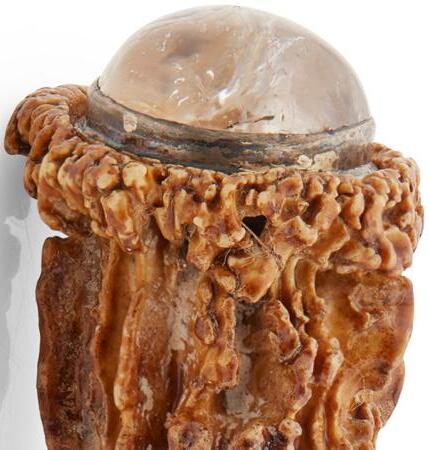



9cm long, matrix:2.5cm diameter
Heraldry: Arms: Robertson quartering Cruickshank impaling Wilson For Charles Robertson Esq. of Kindeace, Greenyards, and Glencalire, Co. Ross, J. P. And DL. born April 1831; married 10 December 1868
Helena Emma Maryon-Wilson
£500-800
113
A PERSONAL DESK SEAL
A VICTORIAN ANTLER AND GEM SET DESK SEAL
the antler handle set with a quartz crystal cabochon terminal, the silver collar to a faceted smokey quartz matrix engraved with a dragon crest surmounting a cypher
10cm long, matrix: 3.2cm x 2.6cm
£300-500
END OF COLLECTION 45
COLLECTABLE SILVER & JEWELLERY PART II
114
A MID-18TH CENTURY BONE SNUFF MULL of baluster standing form with applied silver butterfly hinge, the bone cover with simple vacant cartouche
6.5cm high
£250-350
115
A VICTORIAN SNUFF MULL EARLY VICTORIAN
the polished tapered curly cow horn body with applied silver terminal and applied silver shield with crest, the hinged lid with ball socket, chased thistle decoration and a border with engraved presentation inscription, collet set with a yellow paste to the centre
10cm long
£300-500
116
A MID-18TH CENTURY CURLY HORN SNUFF MULL

the large coiled cow horn body with long tapered mount to the point, the hinged horn lid with butterfly hinge and applied oval cartouche
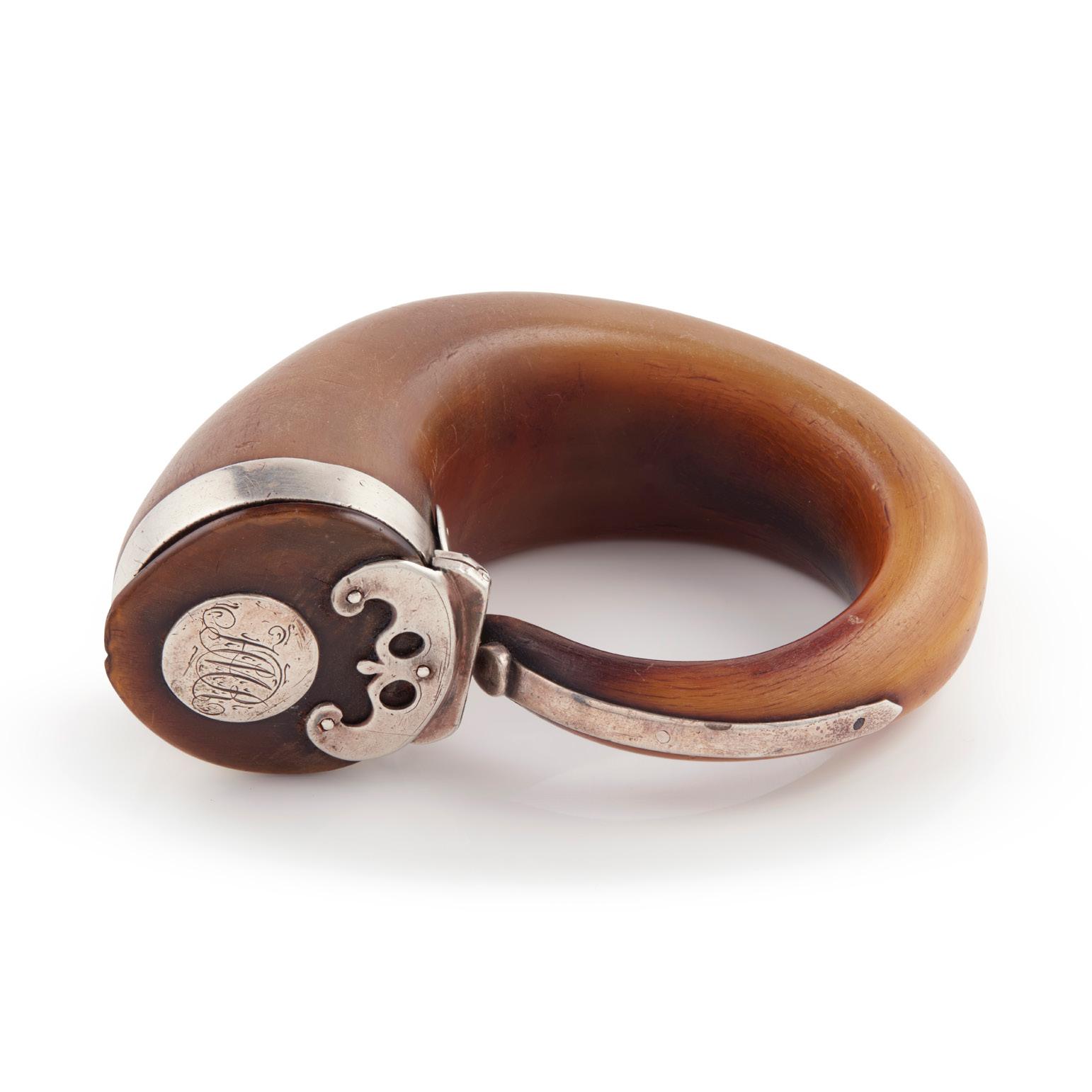
14cm long
Note: This early example of a curly horn snuff mull would appear to date to circa 1750/60, and uses a hinge far more commonly found on baluster snuff mulls. This would appear to date it between the popularity of both styles and makes it a transitional piece.


£300-500
117
A CURLY HORN SNUFF MULLFARMING INTEREST UNMARKED
the horn of simple curled form, with collar mount to rim engraved with the inscription ‘Presented from the Society to J. Marshall 1829’, the hinged domed lid with scallop border, the circular disc engraved with ‘GILCOMSTON FARMER’S SOCIETY 1759’ set with a foil backed yellow paste; with associated newspaper clipping regarding the society
11cm long
£200-300
46
HORN SNUFF MULL IN THE FORM OF A BOAT


19TH CENTURY
with white metal mounts, the top applied with a pierced crown and anchor

12.2cm long
£150-200
A COLLECTION OF SCOTTISH SNUFF MULLS to include, William Dunningham & Co., Edinburgh 1910, the hinged lid with a scallop border, claw set to the centre with a yellow paste; together with four curly horn snuff mulls, two with thistle decoration to the hinged lids (5)
Provenance: Captain Alastair Wardrop Euing Crawford (18961924), hence by descent to the present vendor
£500-800
AH1171; together with another, engraved to the collar, ‘Niven MacVicar Sept 1821’ with applied thistle detail to the hinged lid (2) 11cm, 9cm long
Provenance: Captain Alastair Wardrop Euing Crawford (1896 - 1924), hence by descent to the present vendor
£300-500
120
118
47 Other fees apply in addition to the hammer price: see the ‘Buyer’s Guide’ section on page 2
121
A COLLECTION OF VICTORIAN HARDSTONE BOXES
to include, a vesta case, Joseph Cook & Son, Birmingham 1907; together with a snuff box and a sovereign case, James Fenton & Co, Birmingham 1897, all with engraved scroll decoration inset with various hardstones including Montrose agate, bloodstone etc (3)

Width: 3.5cm, 5.2cm, 3.5cm, gross weight: 91g
£250-350
122
A BANDED CARNELIAN AGATE SET BOX
of rectangular outline, the gilt frame with cross-hatch detail, raised on four agate ball feet; together with a similar smaller, a moss agate box and a carved banded carnelian agate desk seal (4)

11.5cm, 7cm, 5.5cm wide, 6cm length of seal
£300-500
48 Other fees apply in addition to the hammer price: see the ‘Buyer’s Guide’ section on page 2
AN EARLY 19TH CENTURY SCOTTISH GOLD HARD STONE VINAIGRETTE
UNMARKED
of large rounded rectangular form with chased floral rim and thumb piece, the hinged cover and base with polished agate, the interior with finely pierced and engraved floral grille

5.8cm x 4cm, gross weight 70.6g
£1,000-1,500
A VICTORIAN HARDSTONE SET PAPERKNIFE
UNMARKED, POSSIBLY CRICHTON OF EDINBURGH
the tapered handle set with various hardstone sections, to a tapered ormolu blade with a stylised scroll mount


25.5cm long
£600-800
125
A VICTORIAN GRANITE AND ANTLER MOUNTED INKWELL unmarked, the rectangular pink granite base with a simple mounted rim and raised on four antler base feet, set with an engraved thistle and citrine inkwell, with hinged granite lid, flanked by roe deer antler and with pen try to front

Base 23cm wide
£500-800
123
49
PROVINCIAL SILVER

ABERDEEN – A SCOTTISH PROVINCIAL TOAST / BANNOCK RACK

GEORGE BOOTH
marked G.B, A, B, N, the seven scrolling bars set on a reeded rounded rectangular base, with central foliate loop handle, raised on four ball feet
16.5cm wide, 11oz
£800-1,200
127
ABERDEEN – A SCOTTISH PROVINCIAL WINE LABEL
WILLIAM JAMIESON
marked WJ, ABD, of canted rectangular form with simple incised border, inscribed BRANDY, suspended from a belcher link chain; together with a rectangular version inscribed SHERRY by Rettie & Sons of Aberdeen marked R&S SILVER (2)
4.5cm and 4.4cm wide
£300-500
128
ABERDEEN - A SCARCE SCOTTISH PROVINCIAL QUAICH
GEORGE WALKER
marked GW in a serrated punch, of traditional form the bowl formed of staves, the lugs each of baluster form, engraved initials in a stylised border, raised on a circular foot

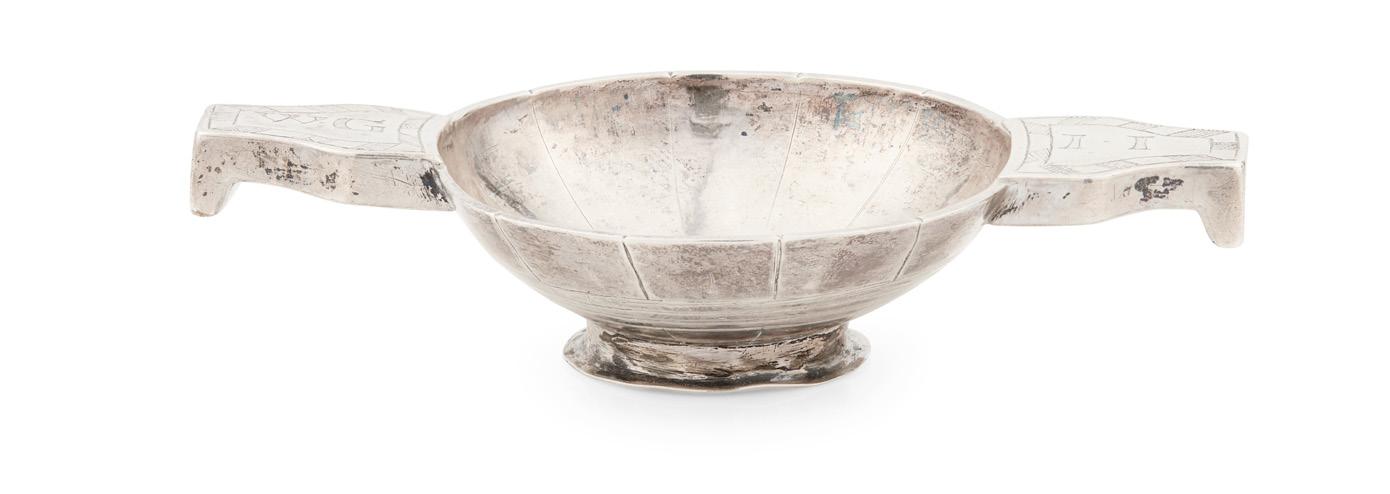
9.5cm across lugs, 25.5g
£400-600
129
ABERDEEN – A SET OF SIX SCOTTISH PROVINCIAL TABLE FORKS
JAMES ERSKINE
marked hand and dagger, E, three towers, of Fiddle Pattern with initial engraved to terminal (6)
19.5cm long, 12.6oz
£300-500
130
ABERDEEN – A SCARCE SET OF SIX SCOTTISH PROVINCIAL TABLESPOONS
GEORGE COOPER
marked GC, three towers, gothic E, of Hanoverian pattern with script initials AAL to terminal and facetted drop to the heel of the bowl (6)
20.5cm long combined weight 12.5oz
£800-1,200
131
ABERDEEN – A SCOTTISH PROVINCIAL WINE FUNNEL AND STAND
JAMES ERKSINE
marked to each piece JE, the baluster bowl with reeded rim and simple clip, with reeded collar to straight spout, on a slightly domed circular dish with reeded rim (2)
Funnel height 12,5cm, stand 10cm diameter, combined weight 4.3oz
£800-1,200

126 128 131 51 Other fees apply in addition to the hammer price: see the ‘Buyer’s Guide’ section on page 2 126
ABERDEEN - A SET OF SIX SCOTTISH PROVINCIAL DESSERT SPOONS
PETER GILL & SONS
marked PG, &, SON,A,B,D of Fiddle pattern with initials to terminal; together with a collection of Aberdeen flatware two toddy ladles by W Whitecross, N Gillet, J Erskine; dessert spoons by A Grant, N Gillet and J Erskine (qty)
12.5oz (combined)
£350-450
133
ABERDEEN – TWO SCOTTISH PROVINCIAL WINE LABELS
GEORGE BOOTH
marked G.B, A, B D, of canted rectangular outline with simple incised border, inscribed LISBON and MADEIRA, suspended from a belcher link chain (2)
49mm wide, 10.5g and 11g
£200-300
134
ABERDEEN - A COLLECTION OF SCOTTISH PROVINCIAL TEASPOONS
to include examples by J Begg, G Booth, P Ross, J Erskine etc (qty)
11.3oz (combined)
£200-300
135
ABERDEEN – A SCOTTISH PROVINCIAL TOOTHBRUSH BOX
JAMES CARR
marked J.C, ABDn, of simple rectangular outline the hinged lid with shaped thumbpiece and gothic initial WA engraved the interior gilded
18cm long, 4.2oz
£250-350
136
ABERDEEN - A GROUP OF SCOTTISH PROVINCIAL MEDALLIONS
to include an agricultural medallion from Monquhitter Agricultural Association by R Yule; a similar medallion by J Walker Aberdeen and a military prize medallion for the 1st Aberdeenshire Rifle Volunteers by JTT (unknown) (3)
4cm, 5cm diameter and 4cm wide
£300-500
137
ABERDEEN - A GROUP OF SCOTTISH PROVINCIAL TABLESPOONS
to include pairs of Hanoverian pattern by James Wildgoose; Old English pattern examples by J Law, J Wildgoose and J Gordon (9)
18.5oz (combined)
£300-500
138
ABERDEEN - A GROUP OF SCOTTISH PROVINCIAL TABLESPOONS
to include Old English pattern examples by J Erskine, J Davidson, J Gordon and Fiddle pattern examples by P Gills & Sons and W Jamieson (7)
13oz (combined)
£300-500
139
ABERDEEN - A COLLECTION OF SCOTTISH PROVINCIAL FLATWARE
VARIOUS MAKERS, NATHANIEL GILET, GEORGE WYLLIE, WILLIAM JAMIESON ETC
to include, fourteen teaspoons, of Old English pattern, fifteen of Fiddle pattern; together with a pair of sugar tongs, marked W.W. ABDN; a toddy ladle, marked WJ and a collection of flatware (qty)
17.7oz (weighable silver)
£300-500
140
ABERDEEN - A SET OF FIVE SCOTTISH PROVINCIAL DESSERT SPOONS
JAMES ERSKINE
marked IE, boar’s head, thistle of Old English pattern with engraved initials to the terminal, together with a similar example; also to include a collection of Aberdeen flatware by various makers (qty)
13oz (combined)
£300-500
141
ABERDEEN - A COLLECTION OF SCOTTISH PROVINCIAL FLATWARE
JAMES PIRIE, COLINE ALLAN, WILLIAM JAMIESON ETC
to include, a pair of tablespoons, James Pirie, marked JP ABD JP thrice, of Fiddle pattern, and another similar Peter Ross of Aberdeen; together with a table fork, William Jamieson, marked WJ A B D W&J thrice, of Fiddle pattern, and another similar William Fillan, marked WF thistle twice and another table fork, Coline Allen, marked CA, ABD, three towers, of Hanoverian pattern, engraved arms to terminal (6)
12.5oz (combined)
£250-350
142
ABERDEEN - A SET OF SIX SCOTTISH PROVINCIAL SILVER TABLE FORKS
GEORGE BOOTH
marked G.B, A,B,D,N of Fiddle pattern with engraved script initial to the terminal; together with a pair of toddy ladles by Rettie & Son, dessert spoon by William Jameson etc (qty)
26oz (combined)
£250-350
143
ABERDEEN - FOUR SCOTTISH PROVINCIAL TABLESPOONS
ALEXANDER THOMPSON
marked AT, ABDN, of Old English pattern with initials CG to the terminal; together with a Hanoverian example by the same maker (5) 21cm long, 65g each
£350-450
144
ABERDEEN - A SCOTTISH PROVINCIAL FISH SLICE
WILLIAM FILLAN
marked WF, thistle twice, of Fiddle pattern, double crest and motto engraved to the terminal, the pierced blade with an engraved foliate border; together with another Robert McGregor, Dundee, marked RMcG, pot of lilies thrice, of Fiddle and Shell pattern (2) 29cm long, 11oz (combined)
£300-500

143 52 132
145
ABERDEEN - A SCOTTISH PROVINCIAL WINE FUNNEL STAND
JAMES GORDON
marked IG, of circular outline beaded rim, engraved initials to the dish; together with a wine label, James Gordon, marked IG thrice, of canted rectangular outline, engraved CLARET (2)
9.5cm diameter, 3.5cm width, 37.5g (combined)
£300-500
146
ABERDEEN - A SCOTTISH PROVINCIAL SNUFF BOX


GEORGE BOOTH
marked G.B. A.B.D.N, of rounded rectangular outline, foliate thumbpiece, engraved inscription to interior of lid
8cm wide, 5oz
£300-500
147
ABERDEEN - A SET OF SIX SCOTTISH PROVINCIAL TEASPOONS ALEXANDER MOLLISON
marked A.M. A B D, of Fiddle pattern, engraved C to the terminal; together with two spoons by George Booth, of Old English pattern, a jam spoon, and an unattributed dessert spoon, marked T.S. (10) 6oz (combined)
£300-500
148
ABERDEEN - A SCOTTISH PROVINCIAL PUNCH LADLE
GEORGE & ALEXANDER BOOTH
marked GB, AB, the part twisted baleen handle with simple finial; together with a soup ladle, John Leslie, marked IL, ABD, of Old English pattern (2)
33.5cm, 32cm long, 6.5oz (weighable silver)

Provenance: Private Scottish Collection from Moray
£250-400
149
ABERDEEN - A SET OF SIX SCOTTISH PROVINCIAL TODDY LADLES
JOHN EWAN
marked JoE, lion mask, of Fiddle pattern, engraved initials to the terminal; together with another pair, James Gordon, marked I.G. thistle, b, duty mark and another Alexander Cameron, Dundee, marked C, thistle, pot of Lilies, AC, foliate initials engraved to terminal (9)
16cm long, combined weight: 7oz
£250-350
150
ABERDEEN - A COLLECTION OF SCOTTISH PROVINCIAL FLATWARE
various makers and marks, to include, a pair of tablespoons, John Davidson, marked I.D, of Hanoverian pattern, engraved initials to terminal and another two tablespoons, Coline Allen and James Gordon; together with a collection of teaspoons, five by James Erskine, of Fiddle pattern, four by Peter Ross, of Old English pattern, another two Aberdeen, various makers and four by William Ferguson of Elgin; together with a sugar spoon, marked JP, AB, DN, of Fiddle pattern (20)
17.5oz (combined)
£300-500
151
ABERDEEN / MONTROSE – A SCOTTISH PROVINCIAL MASKING SPOON BENJAMIN LUMSDEN
marked B.L, B.L, the slender tapered stem with simple ball finial; together with a pair of Aberdeen butter knives by William Jamieson marked WJ, ABD, WJ, with shaped blades and flared rectangular handles (3)
Masking spoon, 16.5cm long
£300-500
136 135 146 53 Other fees apply in addition to the hammer price: see the ‘Buyer’s Guide’ section on page 2
152
ARBROATH – AN IMPORTANT SCOTTISH PROVINCIAL SNUFF BOX



ANDREW DAVIDSON
marked to cover and base, plant, AD, portcullis, of rectangular outline with engraved foliate running border, the central panels with scrolling foliage with script initials WL within a cartouche, cast foliate thumb piece, the body with reeded sides, the base similarly engraved as the cover with ivy leaf border and vacant centre, the interior gilt

6.5cm x 4.3cm, 73.3g
£4,000-6,000
Note: Although the flatware of Andrew Davidson of Arbroath is well recorded, any work on a larger scale is rare. This snuff box appears to be one of just four larger pieces by his hand to survive. Currently the other three recorded pieces, a goblet, cowrie shell snuff box and pen knife, all reside within museum collections. While it is often tempting to consider rare pieces such as this ‘bought in’ and only marked by provincial makers (a practice that no doubt happened) the size, proportion and manufacture of this box seems to dismiss this theory. The hand which has made this, skilled no doubt, was not a specialist box maker. Possibly the only piece of Arbroath holloware outside a museum collection and arguably the finest piece by the maker, this box is an important survivor for this Scottish centre of silver production.

153
AYR - A SCARCE SCOTTISH PROVINCIAL HORTICULTURAL MEDALLION
WILLIAM ALLEN
marked W.Aln, AYR, of circular outline with arched and beaded border and inscribed ‘For 4 species cut flowers 3 of each…..’, with shaped suspender and suspension ring 45mm diameter, 19.2g
£300-500
54 Other fees apply in addition to the hammer price: see the ‘Buyer’s Guide’ section on page 2
157
154
BALLATER - A SCOTTISH PROVINCIAL BOOKMARK
WILLIAM J FRASER
marked W.J.F, Edinburgh 1937, the terminal formed as an engraved Celtic cross, with tapered blade and with clip to reverse; together with a small thistle engraved annular brooch by J Knowles & Sons marked J.K.&S, STG and a cardboard jewellery box inscribed to lid William J Fraser…… (3)
Bookmark 12.5cm long
£200-300
155
BALLATER - A SCOTTISH PROVINCIAL SILVER-MOUNTED BEAKER
WILLIAM ROBB, EDINBURGH 1902
of traditional form, applied vacant shield to centre; together with a pair of sugar tongs, 1919 and a paper-knife, 1918, formed as a Celtic cross (3)
11cm high
£300-500
156
BALLATER - A SCOTTISH PROVINCIAL QUAICH
WILLIAM ROBB
marked ROBB / BALLATER, Edinburgh 1908, the shallow bowl with twin inswept handles and raised on a collet foot 13cm across lugs
£300-500
157
BALLATER – A SCOTTISH PROVINCIAL TABLE SNUFF BOX
WILLIAM ROBB
marked ROBB/ BALLATER, Edinburgh 1906, of straight-sided oval outline with hinged cover set with a facetted Cairngorm to centre, surrounded by eight Scottish freshwater pearls in collet mounts, the body set with eight similar mounted freshwater pears, with gilt interior
8.5cm wide, 2.6oz
Note: This lot has been granted a license from The Scottish Government, Rural Directorate, Landscapes and Habitats Division, and it contains freshwater pearls legally taken from the wild prior to 27 March 1991.
£800-1,200
158
BALLATER - A SCOTTISH PROVINCIAL QUAICH
WILLIAM ROBB
marked ROBB/ BALLATER, Edinburgh 1918, of typical low dish form with elegant swept handles, raised on a simple collet foot 10cm wide across lugs, 24.5g
£300-500
159
BALLATER - A SCOTTISH PROVINCIAL AGATE SNUFF BOX
WILLIAM ROBB, EDINBURGH 1908 of oval outline, the hinged lid set with a brown moss agate, scallop thumbpiece

5.6cm diameter
£300-500
162
160
BALLATER - A SCOTTISH PROVINCIAL BOOKMARK
WILLIAM ROBB
marked WR, BLTR, Edinburgh 1919, with an engraved cross formed terminal and inscription to the tapered blade, with a paper clip to reverse, and a souvenir teaspoon with engraved armorial and inscribed to bowl Invercauld, by the same maker; together with a baleen handled pickle ladle with a small bowl by Ferguson & McBean Inverness (3)
Bookmark 9.5cm long
£200-400
161
BALLATER - A SCOTTISH PROVINCIAL NAPKIN RING
WILLIAM ROBB
WR, BLTR, Edinburgh 1924, of simple circular form with reeded rim; together with four thistle topped teaspoons with twisted stems, by William Robb, Edinburgh 1923 and 1924 (5)


Napkin ring 4.5cm diameter, teaspoons 11cm long
£300-500
162
BALLATER - A SCOTTISH PROVINCIAL QUAICH
WILLIAM ROBB, EDINBURGH 1918
of traditional form, the lugs of slight scroll form
11.7cm (across lugs), 45.2oz
£300-500
163
BALLATER - A SCOTTISH PROVINCIAL CAKE KNIFE / LETTER OPENER
WILLIAM ROBB
marked WR, BLTR, Edinburgh 1924, the roe deer antler handle with a tapered silver blade with the single fuller and scalloped back edge

29.5cm long
£400-600
164
BALLATER - A SCOTTISH PROVINCIAL LETTER OPENER
WILLIAM ROBB, EDINBURGH 1911
the blade of tapered form, the handle formed of two intertwined branches, collet set with an oval citrine to the terminal
22cm long
£300-500
165
BANFF - A COLLECTION OF SCOTTISH TEASPOONS
GEORGE ELDER
various marks, all of Fiddle pattern with engraved initials to terminal; together with a jam spoon and an egg spoon (10)
4oz (combined)
£200-300
166
BANFF - A SCOTTISH PROVINCIAL TODDY LADLE
JOHN KEITH
marked R, IK, salmon, B, of Old English pattern, engraved initials to the terminal; together with a pair by Robert Keay, Edinburgh 1806 and another, J W Howden & Co, Edinburgh 1817; together with two provincial teaspoons, and one condiment spoon (7)
18cm long, 4.5oz (combined)
£300-500
Other fees apply in addition to the hammer price: see the ‘Buyer’s Guide’ section on page 2
163
167
BANFF - A RARE SCOTTISH PROVINCIAL WINE FUNNEL AND STAND
JOHN KEITH
marked to funnel and stand, ribboned B, IK, F, the stand of simple circular outline with reeded border and engraved initials

‘JMC’ to centre, the funnel of conventional baluster form with reeded rim and matching engraved initials to the body, the pull-off spout with simple reeded detail (2) funnel 14cm high, stand 10.6cm diameter, combined weight 4.7oz

Provenance: John Noble Collection
N. Shaw, 2005
Lyon & Turnbull, Scottish Silver & Accessories
19th August 2013 lot 449
Private Collection, Edinburgh
£3,000-5,000
Literature: Compendium of Scottish Silver R & J Dietert Volume 2 page 262
Compendium of Scottish Silver II R & J
Dietert page 585
Note: Of the two recorded wine funnels by this maker this appears to be the only example with its original stand. The other example, ex David Morris Collection is now within Aberdeenshire Museums collection (B4320-1-3.)
168
BANFF - A SCOTTISH PROVINCIAL TABLESPOON
JOHN MCQUEEN
marked B, A, thistle, McQ, of Old English pattern, engraved initials to terminal; together with a collection of Scottish provincial flatware, including, a teaspoon, Dingwall, marked AR; a collection of flatware from Aberdeen and Montrose (13)
10oz (combined)
£250-350
169
BANFF - A SET OF SIX SCOTTISH PROVINCIAL DESSERT SPOONS
JOHN KEITH
marked B, urn (?), IK, B, of Old English pattern (6)
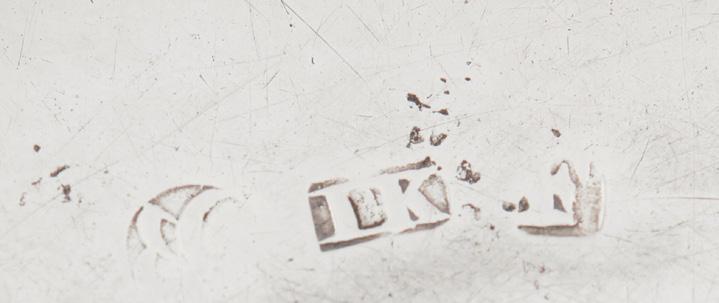
18cm long, 5oz
£300-500
170
BANFF - A SET OF FOUR SCOTTISH PROVINCIAL TABLESPOONS
GEORGE ELDER
marked GE, thistle, B, of Fiddle pattern (4)
22.5cm long, 10.5oz
£400-600
57
171
A COLLECTION OF SCOTTISH PROVINCIAL FLATWARE
DUMFRIES, DUNDEE, ELGIN, PAISLEY, PERTH to include various makers and marks, a Fiddle pattern teaspoon, by Joseph Pearson of Dumfries and another, Adam Burgess; another, possibly of Cupar, marked GC***; a fish slice and toddy ladle, by Cameron of Dundee; a toddy ladle, William Ferguson of Elgin, a teaspoon by J. Pozzie and R. Stewart and two salt spoons by Charles Fowler; a Greenock dessert spoon, a collection of Paisley flatware including William Hannay and of Perth, including Robert Keay and a collection of unattributed (qty)
18oz combined
£300-500
172
A COLLECTION OF SCOTTISH PROVINCIAL TODDY LADLES
VARIOUS MAKERS
to include, a pair, William Whitecross, marked W.W. A B D N, and another Dundee, marked pot of lilies four times, all of Fiddle pattern, engraved initials to the terminal; together with another, LB, Edinburgh of Old English pattern, engraved initials to the terminal and a sugar sifter, Brook & Sons, Edinburgh 1935 (5)
4.5oz (combined)
£250-400
173
CALCUTTA - A COLLECTION OF SIX TABLE FORKS
GEORGE GORDON
marked GG, thistle, of Fiddle pattern, engraved crest to the reverse of the terminal with a set of four similar dessert forks, by Robert Gordon; together with a set of six table forks, WE, London 1839, of Fiddle pattern (16) 21cm long, 32.4oz (combined)
£300-500
174
CANONGATE - A SCOTTISH PROVINCIAL PUNCH LADLE

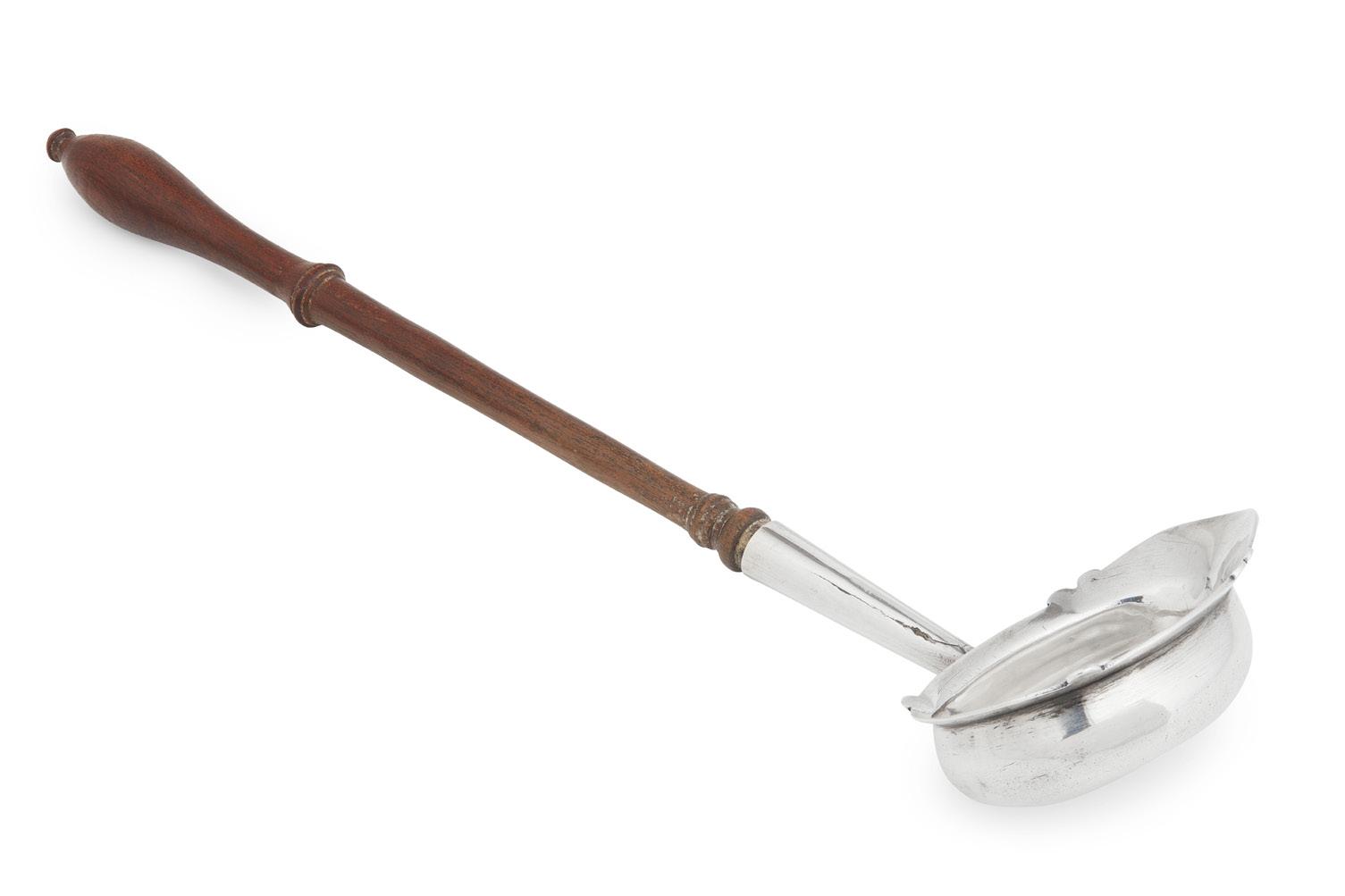
COLIN MITCHELL
marked CM, stag’s head, CM, the bowl of oval outline, the everted rim with spout to one side, engraved initials to underside JD/EA, the wooden handle of baluster form with ball terminal 30cm long
£300-500
175
CUPAR - A SCOTTISH PROVINCIAL TEASPOON
ROBERT ROBERTSON
marked RR, fleur de lys twice, RR, of Fiddle pattern, engraved initials to terminal


14.5cm long, 16g
£250-350
176
CUPAR - A SCOTTISH PROVINCIAL TEASPOON

ROBERT ROBERTSON
marked R.R. fleur de lys twice, R.R., of Fiddle pattern
14cm long, 16.5g
£250-350

58 Other fees apply in addition to the hammer price: see the ‘Buyer’s Guide’ section on page 2
175 176
174
177
DINGWALL - A SCOTTISH PROVINCIAL TEASPOON
ALEXANDER ROSS
marked AR, sunburst, of Old English pattern, engraved G to the terminal; together with a dessert spoon, Ewan Wilson, Leith, marked star twice, thistle, EW, of Fiddle pattern, crest and italic B engraved to the terminal; a salt spoon, St. Andrews, marked H.W.* * TL, of Fiddle pattern, initial engraved to the terminal; and a pair of sugar tongs, Montrose (4)
13.7cm, 90g (combined)
£300-500
178
DUMFRIES - A SCARCE SCOTTISH PROVINCIAL TEASPOON
James Johnstone, marked stag’s head, K, anchor, JI, of Fiddle pattern with initial to the terminal; together with a small group of Dumfries flatware including sugar tongs, toddy ladles and a teaspoon various makers (6)
6.4oz (combined)
£200-300
179
DUNDEE - A SET OF FIVE SCOTTISH PROVINCIAL TEASPOONS
ALEXANDER CAMERON
marked CAM/ERON, Edinburgh marks 1848 DUN/DEE, of Fiddle pattern; together with a set of four teaspoons, David Manson, marked DM, pot of lilies, DM, of Old English pattern, initials engraved to the terminal, a pair of teaspoons, Robert Keay of Perth, marked RK, double-headed eagle twice, of Fiddle and Shell pattern, initials engraved to the terminal and another Charles Murray of Perth, marked CM, double-headed eagle, twice, of Fiddle pattern, initials engraved to terminal (12)
5.8oz
£300-500
180
180
DUNDEE – A SCOTTISH PROVINCIAL WINE LABEL WILLIAM SCOTT
marked WS, pot of lilies, WS of shaped rectangular outline with feather edged decoration and inscribed RUM suspended from a belcher link chain; together with a fruiting vine spirit label inscribed PORT by John Muirhead Glasgow 1831 (2)

5.4cm and 5.5cm wide
£250-350
181
DUNDEE- A GROUP OF SCOTTISH PROVINCIAL TABLESPOONS to include a Hanoverian pattern tablespoon by J Steven; Fiddle pattern tablespoons by J Mills, T Shannon, J Austen and W Constable; a dessert spoon of the same pattern R Naughton and two table forks by A Cameron (8)
16oz (combined)
£250-350
182
DUNDEE - A COLLECTION OF SCOTTISH PROVINCIAL FLATWARE various dates and makers to include sugar tongs, dessert spoons, teaspoons etc; together with a small group of Montrose spoons (qty)
15.2oz (combined)
£150-250
183
DUNDEE - A SET OF TWELVE SCOTTISH PROVINCIAL TABLESPOONS WILLIAM CONSTABLE
marked WC, with Edinburgh hallmarks for 1817, each of Old English pattern, engraved italic C to terminal (12) 21.5cm long, 22.5oz (combined)
£500-700

59
185
184
ELGIN - A SET OF SIX TABLESPOONS
JOSEPH POZZI & ROBERT STEWART
marked J P ELGIN RS, of Fiddle pattern, engraved initials to terminal (6)
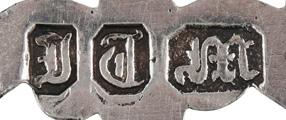
23cm long, 14.5oz
£300-500
185
ELGIN – A RARE SCOTTISH PROVINCIAL LUCKENBOOTH
JAMES THOMSON MACKAY
marked J, T, M (all in gothic script), MACKAY, ELGIN, of large conjoined open heart form with Inverness style open spectacle crown surmounting, the whole with foliate engraved decoration
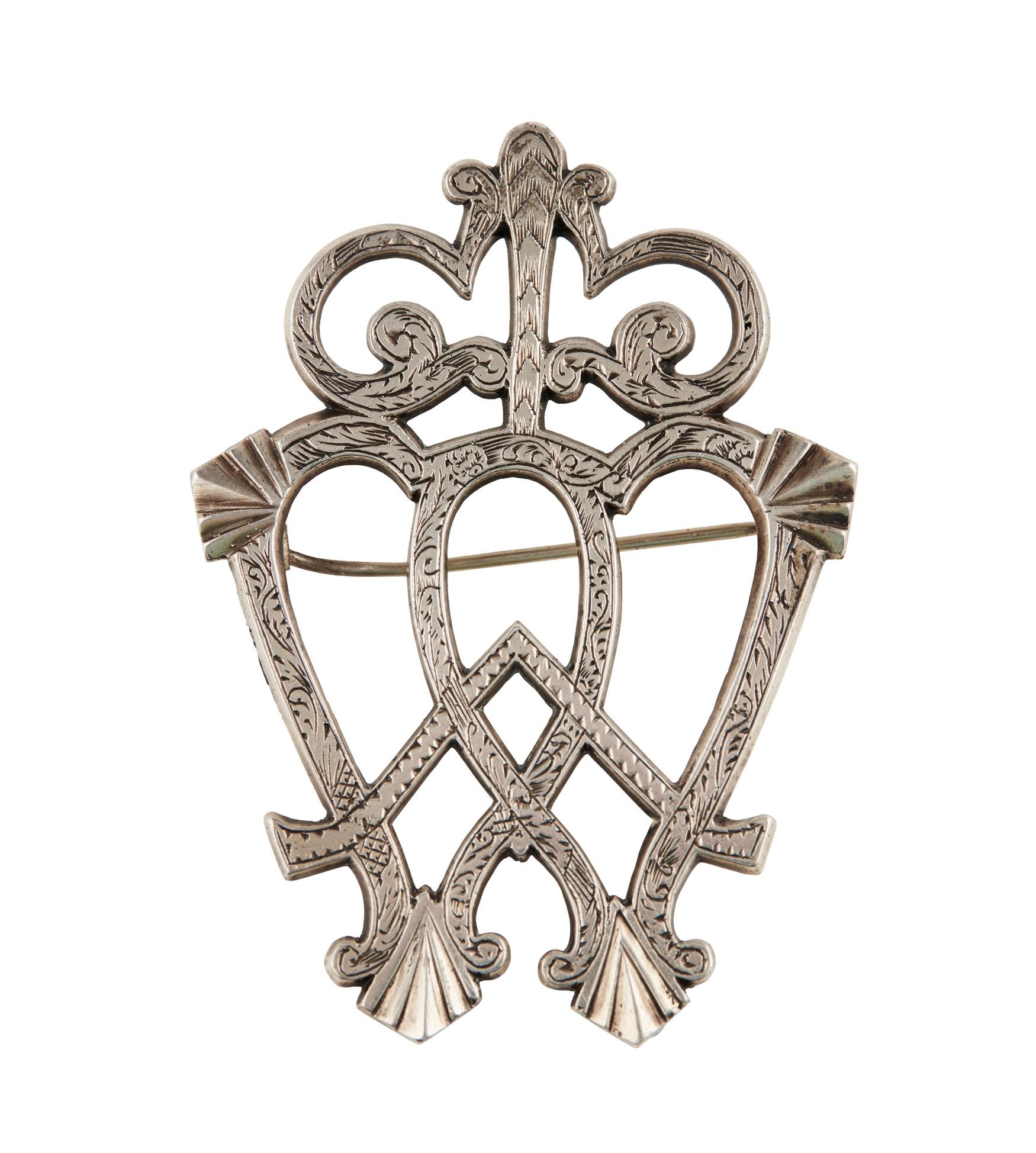
7cm high, 22.5g
Note: Little work by James T MacKay seems to survive, it is interesting to note that the only piece illustrated in ‘Provincial Silversmiths of Moray and Their Marks’ by G P Moss is a smaller simpler version of a Luckenbooth. The marks to that piece appear only be the MACKAY and ELGIN punches meaning its attribution was tentative to either J T MacKay or J R MacKay, the combination of marks struck to this piece now confirms that this piece must have been made after 1863 when James took over the running of the business from his brother.
£800-1,200
186
ELGIN - A SET OF THREE PIN TRAYS
JAMES THOMPSON MACKAY
marked J T M ELGIN, of circular outline, raised border with feather edge; together with a similar unmarked (4)
8cm diameter
£300-500
60 Other fees apply in addition to the hammer price: see the ‘Buyer’s Guide’ section on page 2
187
GLASGOW - A RARE SCOTTISH PROVINCIAL CHOCOLATE POT
JAMES GLEN
marked town mark, M, IG twice, of traditional tapered form, a scroll spout, scrolling wood handle, pull-off lid, with pull-out finial
25cm high, 23.5oz
£2,500-4,000
188
GLASGOW - A SCOTTISH PROVINCIAL SAUCE BOAT
MILNE AND CAMPBELL
marked M&C, tree, M&C, O, of traditional form with a stylised scalloped border, the S-scroll handle with acanthus detail, raised on three scrollcapped hoof feet
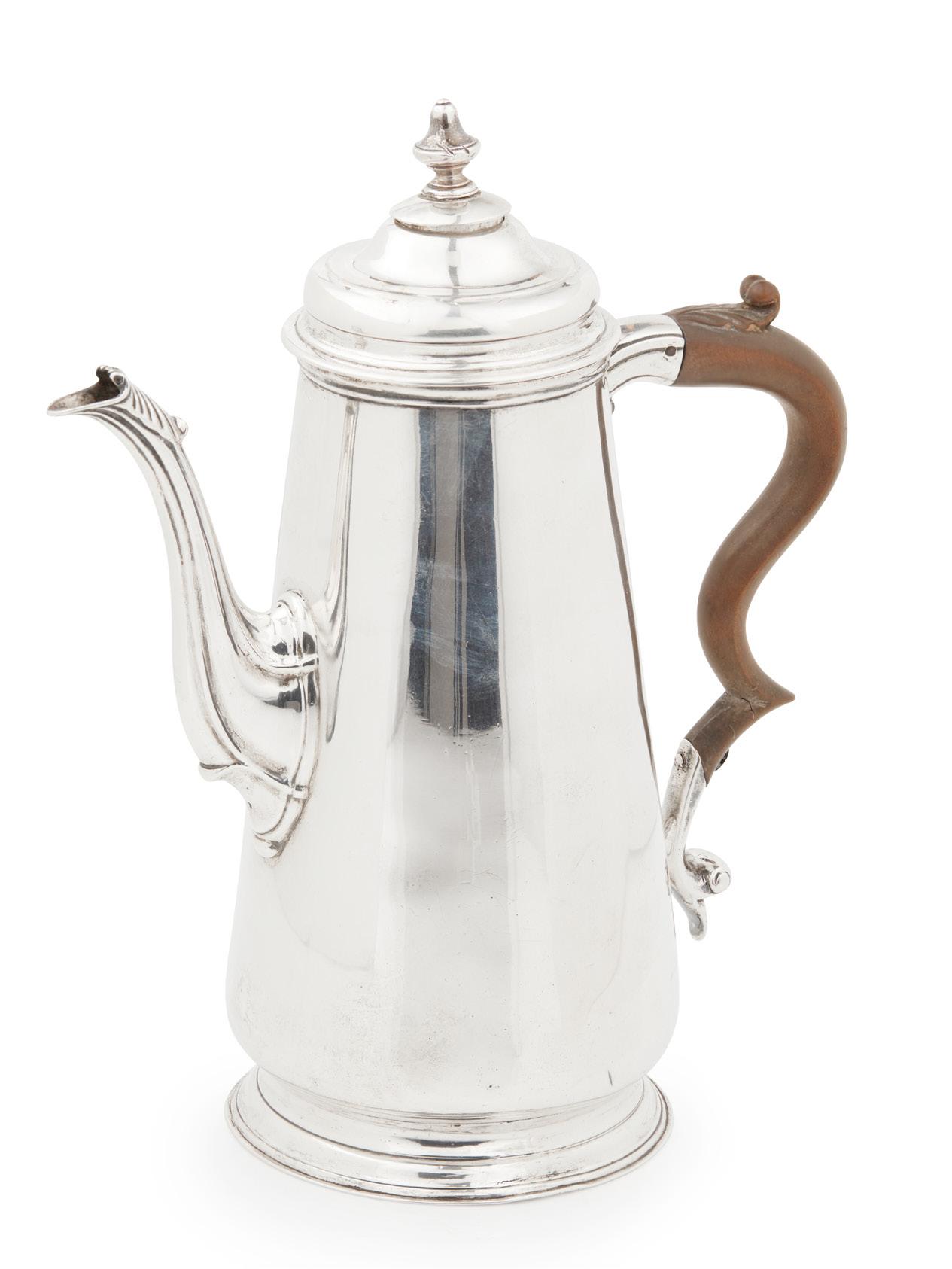
7cm high, 5.4oz
£400-600
189
GLASGOW - A SCOTTISH PROVINCIAL BOWL
ROBERT LUKE
marked RL, S, RL, town mark, of slightly everted form with a scallop border, chased acanthus and scroll decoration to the interior of the gilt bowl
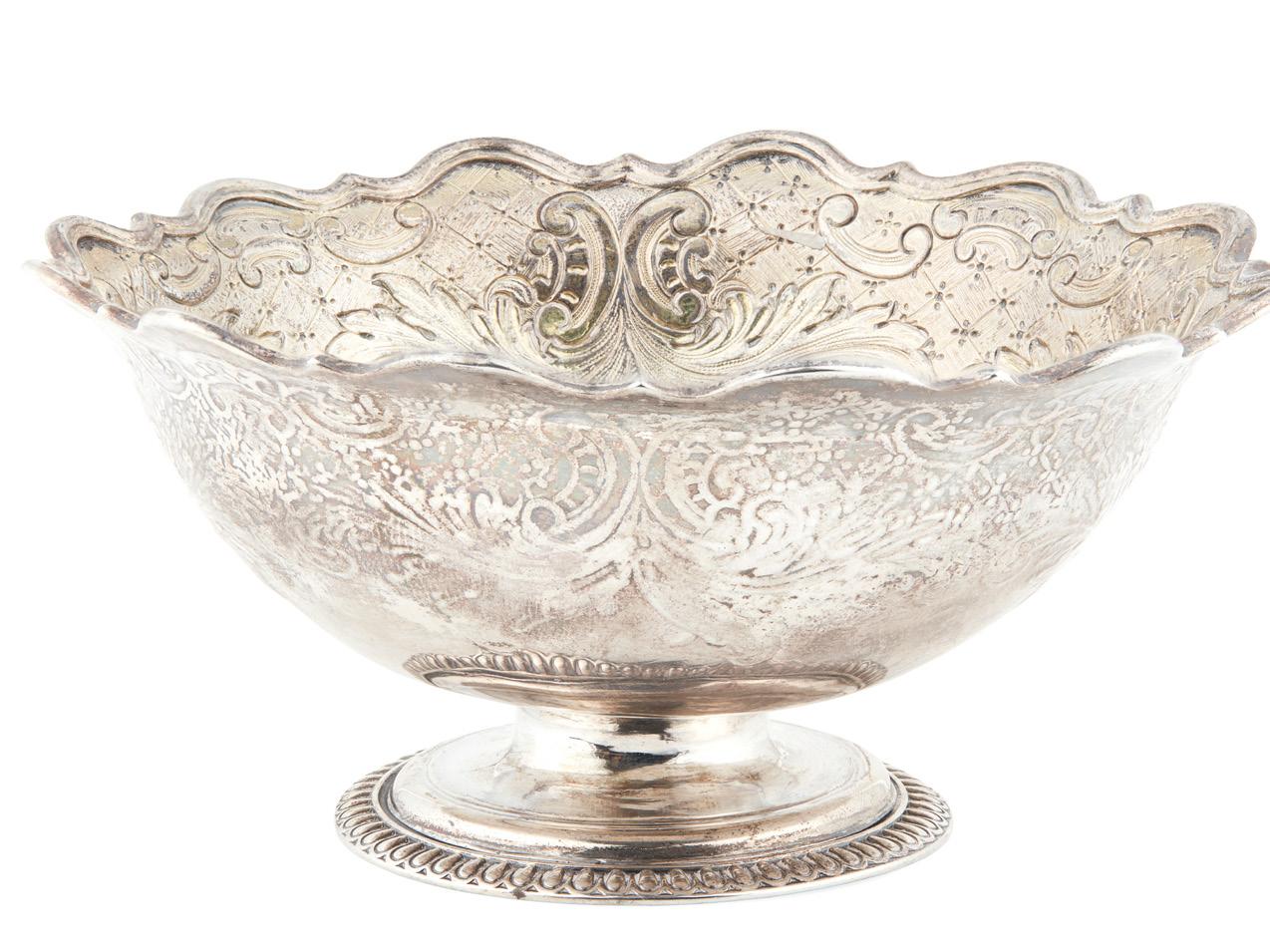
13.5cm across, 6.5cm high, 6.5oz
£800-1,200
190
GLASGOW - A SCOTTISH PROVINCIAL TABLESPOON
MILNE & CAMPBELL
marked M&C, town mark, O, of Hanoverian pattern, engraved initials to reverse of the terminal; together with a matched pair, John Leslie of Aberdeen, marked IL, ABD, of Old English pattern, engraved initials to the terminal, another John Ewan, Aberdeen, marked JoE, thistle, of Old English pattern, engraved initials to the terminal and one by William Ritchie of Perth, marked WR, double-headed eagle thrice; together with a pair of dessert spoons, Lothian and Robertson, Edinburgh, of Hanoverian pattern, engraved crest and motto to reverse of the terminal (7)
22cm long, 12.5oz (combined)
£300-500
191
GLASGOW - A SCOTTISH
PROVINCIAL SAUCEBOAT
ADAM GRAHAM
marked town mark, AG, town mark, of oval outline with slightly scalloped border, crest to the body, acanthus clasped S-scroll handle, raised on a stepped oval foot
10cm high, 4.5oz
£500-700
192
A GEORGE II MUG
ROBERT LUKE, GLASOW 1734 of slight baluster form, engraved initials to body ‘M/ I C/ IC’ with an S-scroll handle, to a stepped circular foot
9.5cm high, 5.5oz
£400-600
61
187
189
193
A GEORGE II TABLESPOON
ROBERT GILCHRIST, GLASGOW
of Hanoverian pattern, rat-tail bowl, engraved italic initials to reverse of terminal
20cm long, 2.3oz
Note: This spoon would appear to be one of as few as four surviving pieces of silver by Robert Gilchrist of Glasgow. Trained by William Clerk he is first mentioned in 1719. Little is known about his career which is a mystery as he was trained by, arguably, the finest goldsmith in Glasgow at the time but does not appear to have made much impact. It seems likely that while working on his own, shown by the survival of his maker’s mark, he was mainly working for other makers. This spoon along with two quaichs (one in a Private Collection the other within the collection of Dundee Art Galleries and Museums) and a hash spoon last sold by Bonhams Edinburgh ‘The Scottish Sale’ 21st August 2003 lot 73 are his only recorded works.
£500-800
194 Y
A SCOTTISH BULLET TEAPOT

ROBERT LUKE GLASGOW CIRCA 1734
of traditional form, straight spout and stylised S-scroll handle, a chased border to the hinged lid with a knopped finial, raised on a stepped circular foot
15cm high, 18.5oz
Provenance: Captain Alastair Wardrop Euing Crawford (1896 - 1924), hence by descent to the present vendor
Note: Accompanied by a tag for the 1951 Festival Exhibition of Scotland
Architecture and Crafts in Scotland
Note: With non-transferable CITES self-certification number: P9J1S4U7
£2,000-3,000
62 Other fees apply in addition to the hammer price: see the ‘Buyer’s Guide’ section on page 2
194
195
GREENOCK - A SET OF FOUR MATCHED SCOTTISH PROVINCIAL TABLESPOONS
ALEX CAMPBELL
marked AC, ship, anchor, ship, one marked, AC, anchor, tree, anchor, all of Old English pattern, engraved initials to a terminal; together with another Adam Graham of Glasgow, marked AG, tree, twice, of Old English pattern and a tablespoon, Ker & Dempster, Edinburgh 1765, of Hanoverian pattern, foliate initials engraved to reverse of the terminal (6)
21cm long, 12.4oz (combined)
£250-400
196
GREENOCK – A SET OF SIX SCOTTISH PROVINCIAL TABLESPOONS
MAKER UNKNOWN
marked C, ship, anchor, tree, of Celtic Point pattern with foliate initial D to terminal (6)
22.5cm long, 10.4oz
£250-350
197
INVERNESS - A COLLECTION OF SCOTTISH PROVINCIAL TEASPOONS
to include a pair of teaspoons, Alexander McRae, marked AMR, running horse, H, of Fiddle pattern, engraved initials to the terminal and another similar pair, by William Munro; together with three various spoons, by J Pozzi of Elgin and another teaspoon by William Ferguson of Elgin, all of Fiddle pattern, engraved initials to terminal (8) 4oz
£300-500
198
INVERNESS - A SCOTTISH PROVINCIAL MASKING SPOON
WILLIAM MASON
marked WM, INS of Fiddle pattern with twisted stem; a set of six teaspoons by C Jamieson and other items by R Naughton, A McRae, D Fraser (qty)
9.2oz (combined weight)
£250-350
199
INVERNESS - A SCOTTISH PROVINCIAL PLAID BROOCH
PETER G WILSON
marked PGW, INS, set with a stag’s head to the centre, the border with engraved ‘CABAR FEIDH’, engraved presentation inscription to the reverse; together with another, Alex and John Smith of Aberdeen, marked A&JS, ABDN, a cast Lion rampant to the centre holding rose and standing on a shield, ‘DUW A DIGON’ to the border (2)
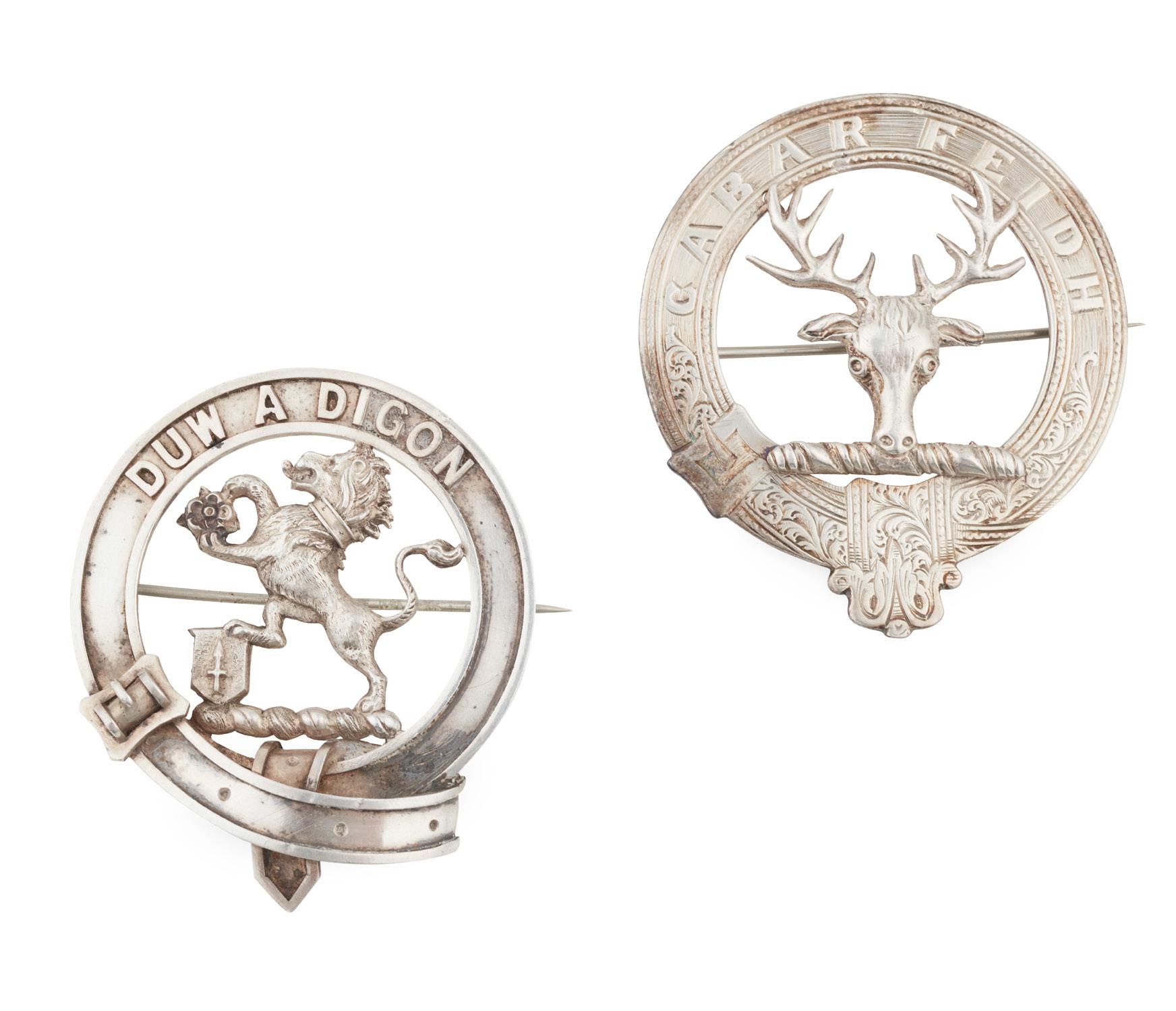
5.3cm, 4.9cm, across
£300-500
200
INVERNESS - A PAIR OF SCOTTISH PROVINCIAL BASTING SPOONS
ROBERT NAUGHTON
marked RN, cornucopia, thistle, of Fiddle pattern, engraved initials to terminal (2)
31cm long, 7oz
£300-500
201
INVERNESS - A SCOTTISH PROVINCIAL LUCKENBOOTH BROOCH
PETER G. WIILSON
marked PGW, INS, formed with a cypher to the centre, flanked to either side by a thistle and a fleur de lys, each with scroll shoulders, surmounted by a coronet; together with a tablespoon, Donald Fraser, marked DF, INS, of Old English pattern, engraved crest to the terminal, and a teaspoon, of Fiddle pattern; together with a pair of sugar tongs, by Alexander MacLeod and two various condiment spoons (6)
6cm wide, 5.5oz (gross weight)
£300-500
63
199
203
202
IONA - A SCOTTISH PROVINCIAL ENAMEL BRACELET

ALEXANDER RITCHIE
marked AR IONA, formed of five Celtic knot work panels each with turquoise enamel central section, joined by belcher links
18cm long
£300-500
203
IONA - A SET OF SIX SCOTTISH PROVINCIAL BUTTONS
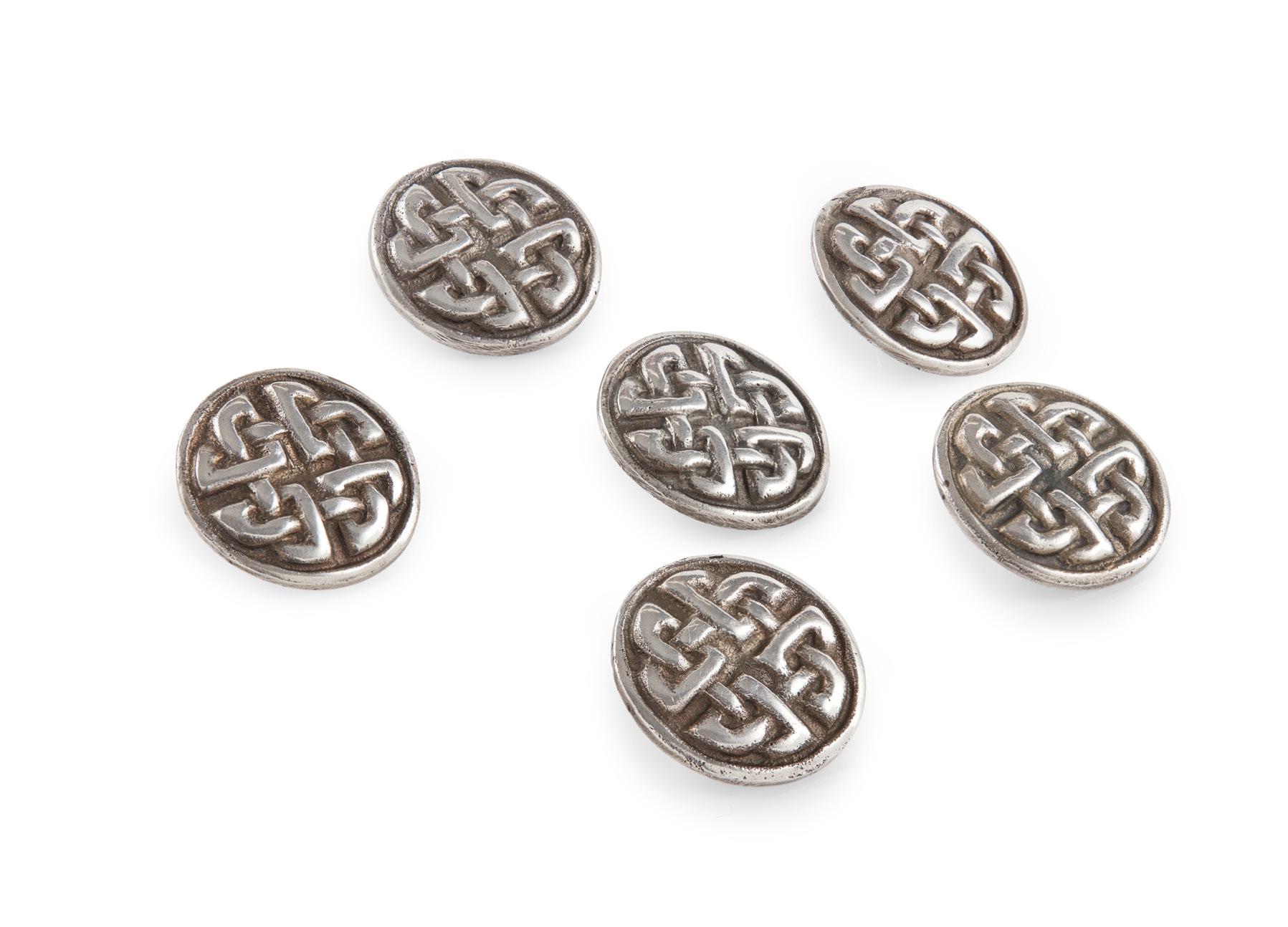
ALEXANDER RITCHIE
marked AR IONA, each of circular outline with Celtic knotwork
1.6cm diameter
£400-600
204
IONA - A SCOTTISH PROVINCIAL CADDY SPOON
ALEXANDER RITCHIE, BIRMINGHAM 1938 with additional Iona Celtic Arts marks, the bowl of shovel form, the terminal of tapered form with Celtic bosses and motifs; together with five teaspoons, 1935, each with a Celtic warrior to the terminal (6)
12.5cm, 10cm, 3.3oz
£350-500
205
IONA - A SCOTTISH PROVINCIAL ENAMEL SET ANNULAR BROOCH
ALEXANDER RITCHIE
marked A.R. IONA, ICA, Birmingham 1938, of simple annular form, turquoise enamel with a Gaelic motto, with an integral swing pin

3.5cm diameter
Note: The Gaelic inscription ‘A H-UILE LATHA SONA DHUIT’ translates as ‘May all your days be happy’ a traditional inscription on wedding gifts
£400-600
64
202 205
206
MONTROSE - A SILVER AND WOODEN FREEDOM CASKET

JAMES REID & CO., GLASGOW 1913
of rectangular outline, Celtic knotwork detail throughout with Celtic knot bosses, the hinged lid with the Montrose Coat of Arms, a silver presentation plaque to the front with engraved inscription ‘...Freedom of the Burgh conferred upon Mrs. Helen Wyllie, daughter of Rev. Alexander Keith D.D. St.Cyrus and widow of James Wyllie Merchant London 17th June 1914’ with twin loop handles, raised on four stepped feet
23.5cm wide
£400-600
207
MONTROSE / ABERDEEN – A PAIR OF SCOTTISH PROVINCIAL SALTS
PETER LAMBERT
marked PL, thistle, PL, thistle, of navette outline the straight side with wriggle work engraved border and simple foliate cartouches, raised on ball feet, each with blue glass liner (2)
9cm wide, 2.95oz
£400-600
208
PETERHEAD - A PAIR OF SCOTTISH PROVINCIAL TEASPOONS

WILLIAM FERGUSON
marked WF PHD, of Fiddle pattern, foliate M engraved to terminal 13.5cm long, 28.5g
£500-800
209
PETERHEAD – A SCARCE SCOTTISH PROVINCIAL WINE LABEL
WILLIAM FERGUSON
marked WF, PHD, Edinburgh 1826, of shaped rectangular form with embossed flowerhead and scroll border, inscribed CLARET and suspended from a belcher link chain
4.5cm wide, 11g
£300-500
65
206 207
6.2cm high, 3.5oz
£400-600
212
PERTH - A SCOTTISH PROVINCIAL PART CANTEEN
ROBERT KEAY
most with marks for Edinburgh 1848, comprising, eleven tablespoons, eleven table forks, ten dessert spoons, four dessert forks, one butter knife, and eight condiment spoons, all of single struck King’s pattern, with engraved italic F to terminal (45)
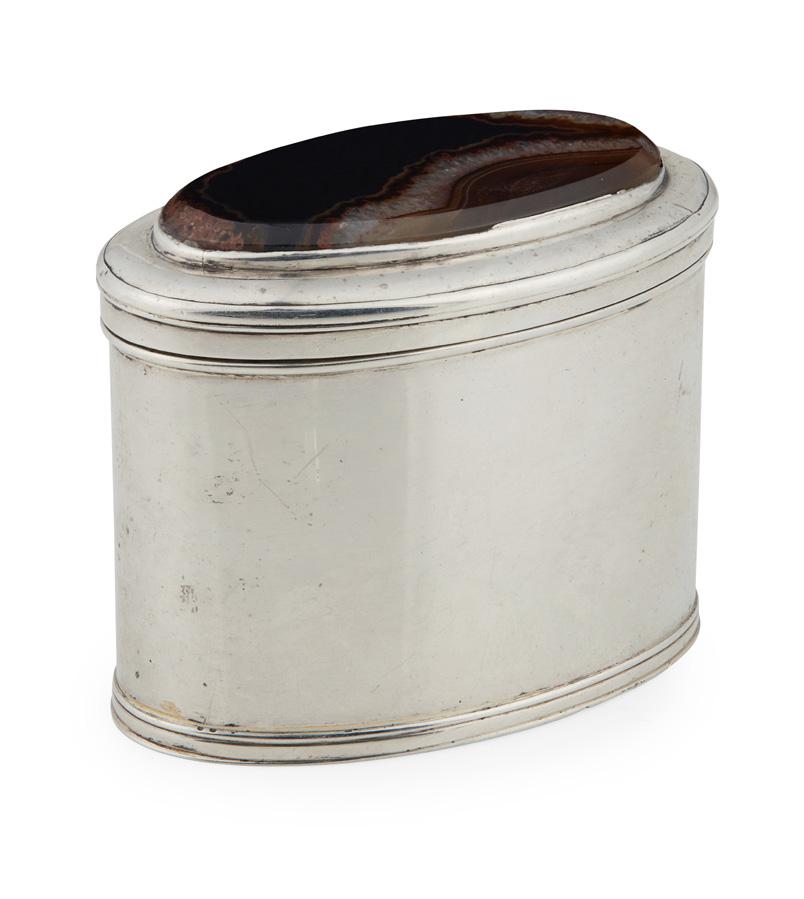
70.5oz
£600-800
214
PERTH - A SET OF SIX TABLESPOONS
ROBERT KEAY
marked RK, double-headed eagle, twice, RK, of Fiddle pattern, italic G to terminal 22cm long, 12oz
£300-500
215
PERTH - A SCOTTISH PROVINCIAL QUAICH
CHARLES MURRAY
marked CM, double-headed eagle, CM, of traditional form, the lugs engraved with crest and motto to one and presentation inscription to the other, ‘From Mrs. Colonel Stewart to Henry Glassford Bell’, raised on a circular foot 13cm across lugs, 2.7oz
£400-600
italic PM engraved to terminal; together with four tablespoons, Edinburgh 1847, of Fiddle pattern, engraved initials to terminal (15) 23cm long, 30oz
£500-600

217
STONEHAVEN - A SCOTTISH PROVINCIAL SPOON


WILLIAM ROBB
marked ROBB Stonehaven, the finial set with an oval-shaped cairngorm to tubular stem and rounded bowl, engraved ‘WEMBLEY 1924’ 10cm long, 6g
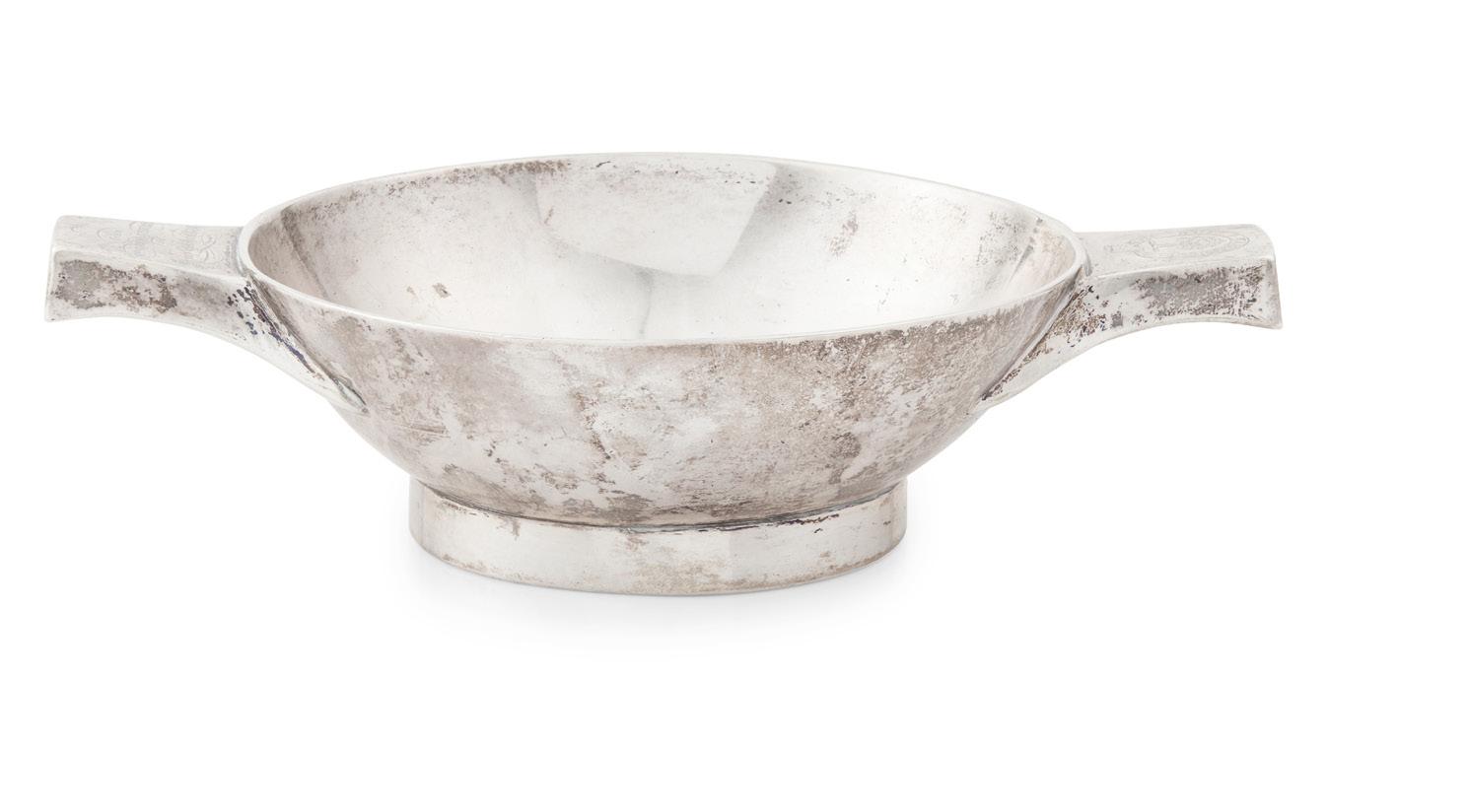
Note: Wembley Park was the venue for the British Empire Exhibition which ran from April 1924 for a year.
The Empire Stadium which was purpose-built for the event, went on the become Wembley Stadium.
£300-500
Other fees apply in addition to the hammer price: see the ‘Buyer’s Guide’ section on page 2
217 211 215
218
TAIN - A SCOTTISH PROVINCIAL SNUFF MULL UNMARKED, ATTRIBUTED TO HUGH ROSS
the polished cow horn, with applied mounts, the hinged lid with the applied plaque with an engraved inscription ‘Gift Captn. Alexr. Ross of Calrosie To the Revd. Mr. Pat Grant Minister of Loggy Er 1774’

9cm long
Literature: Pg 29 -The Tain Silver Collection, Tain & District Museum Trust, written and compiled by Estelle Quick, 2012. Note: Although unmarked the cursive script to the engraving has been found on other pieces by the silversmith Hugh Ross of Tain. Hugh Ross II (c.1710-1776) and Hugh Ross III (1736-1786) were uncle and nephew and were part of an extended family of hammermen. The two worked together for 25 years so in most cases it is very difficult to ascertain which hand is which. A capstan-shaped snuff mull in the Tain Museum collection also offers a comparative due to the cursive script. The base is inscribed with the Sutherland crest and “Gift of the Earl of Sutherland to Carroll 1747” showing the calibre of customers.
The inscription refers to the completion of the major rebuilding of the Kirk at Logie-Easter, Ross & Cromarty. Patrick Grant had been itinerant Minister in the bounds of the Presbytery of Abertarff when he was admitted to the ministry of Logie-Easter in 1744. Two decades later he stated ‘that the Church of Logie-Easter has for many years been in a most ruinous condition; that the timber of the roof was rotten, and the heather thatch did not hold out a drop of rain; the walls were out of plumb, and there was not a pane of glass in any of the windows’. A Committee was thereupon appointed to assist Mr. Grant in taking immediate action to have the Logie-Easter Church restored. Four years later Captain Alexander Ross of Calrossie was one of those nominated for rebuilding the Kirk at Logie and persuaded the parishioners that a new church on a better site was required. The presentation of the snuff mull represents the completion of the new Kirk in 1774. Revd. Grant was still minister at Logie when he died on 19th July 1776 and was succeeded by Capt. Ross’s kinsman John Ross.
£1,000-1,500
67
219
TABLESPOON


ALEXANDER STEWART
marked AS, TAIN, wheat sheaf, of Old English pattern with engraved initials ‘JM’ and number 5 23cm long, 76g
£500-800
220
JOHN SELLAR
marked JS, of Old English pattern with script initials JM to terminal and numbered 9 23.5cm long, 79.3g

Note: John Sellar’s work is well recorded in Wick and is the most prolific of the two makers recorded there. However, less well known, is that Sellar also worked and marked silver in Elgin seen with ‘ELGIN’ and tree and bauble town marks, and in Tain.
His work in Tain is, without doubt, his rarest and dates between 1821 – 1825. During this time two maker’s punches are attributed to him, JS with incurved sides and a matching town punch and the example under discussion.
The punch seen in the following three lots is distinctively different to the one he uses in Wick as the proportion and spacing of the J and S are much wider and the punch is slightly more crudely cut. The tablespoon is perhaps the most important example of this mark extant as it has obviously been made to match or extend a set of Alexander Stewart-made Tain spoons. This and the direct family provenance from the Tain area give additional confirmation of the origin.
For further examples and discussion see ‘The Tain Silver Collection, in Tain and District Museum’ pages 72 - 73
£800-1,200
 TAIN - A SCOTTISH PROVINCIAL
TAIN - A RARE SCOTTISH PROVINCIAL TABLESPOON
TAIN - A SCOTTISH PROVINCIAL
TAIN - A RARE SCOTTISH PROVINCIAL TABLESPOON
Other fees apply in addition to the hammer price: see the ‘Buyer’s Guide’ section on page 2
221
TAIN - A RARE SET OF SIX SCOTTISH PROVINCIAL TABLESPOONS

ALEXANDER STEWART
marked A.S, TAIN, wheat sheaf, of Old English pattern, with script initials JM and numbers 6,7,8, 10, 11, 12 to terminal (6) 23cm long, 15oz £3,000-5,000
222
TAIN - A SET OF SIX RARE SCOTTISH PROVINCIAL DESSERT SPOONS
ALEXANDER STEWART
marked A.S, TAIN, C, of Old English pattern, with script initials GM to terminal (6) 18.7cm long, 7.6oz £2,000-3,000

221 (centre six spoons)

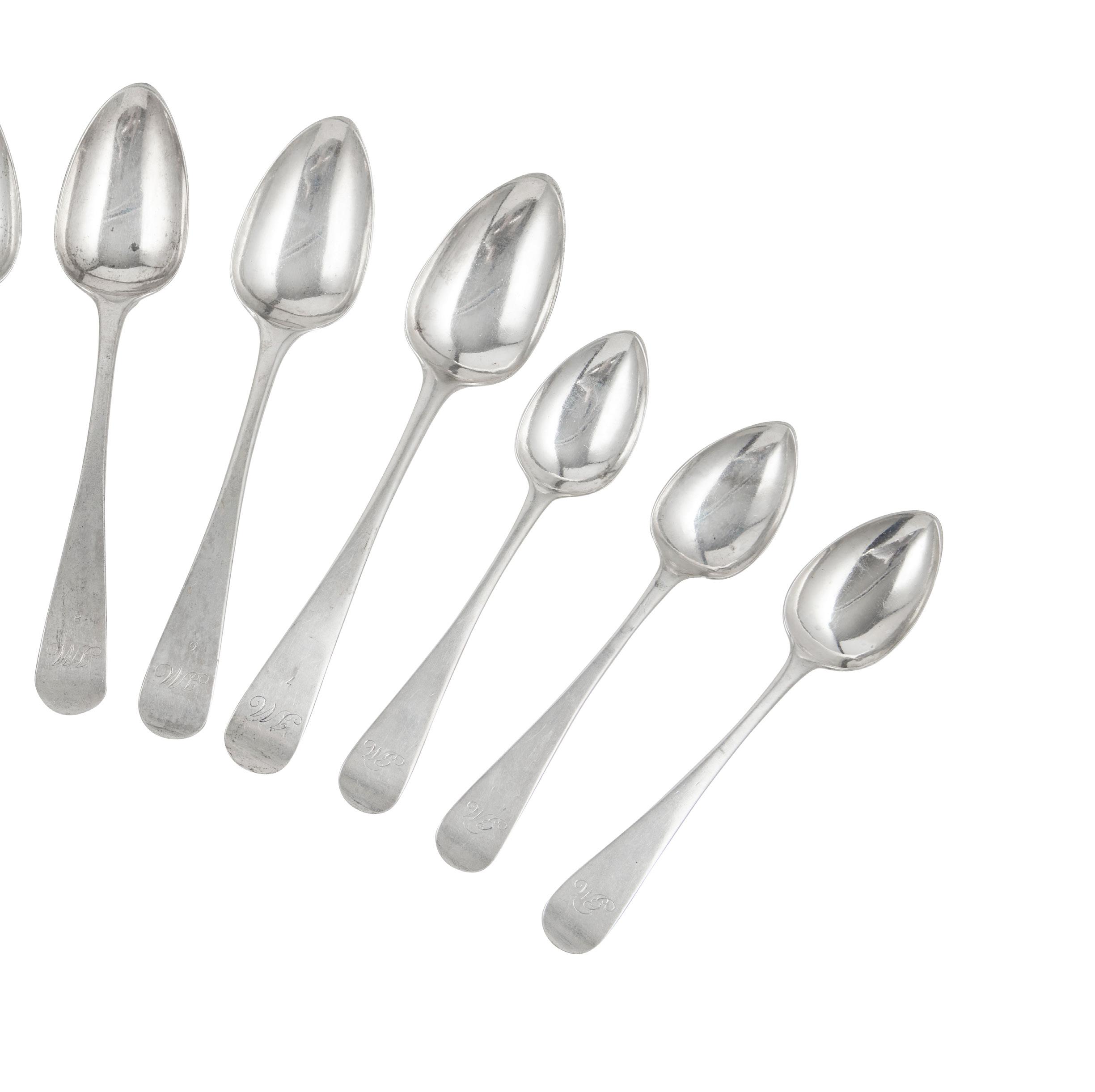
222 (outer six spoons)
223
TAIN / INVERNESS - A SCOTTISH PROVINCIAL RING
ALEXANDER STEWART marked A.S, of heart outline, engraved I.E, to a plain shank Ring size: S £300-500
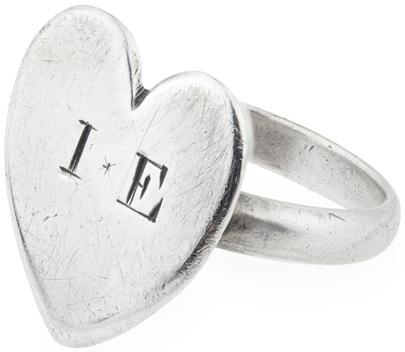
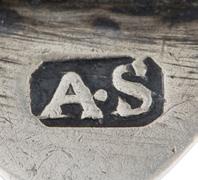

224
WICK - AN EXTREMELY RARE SCOTTISH PROVINCIAL WINE FUNNEL
JOHN SELLAR
marked JS, WICK, the tapered baluster bowl with engraved crest of a griffin head above a torse, the slender tapered spout with reeded detail at the base of the bowl, the pull-out double muslin rim with reeded border 11cm long, Diameter of bowl 7cm, 3.09oz

Note: Considered one of the classic rarities of Scottish silver the survival of Wick-made silver has always been considered remarkable. Wick hollowware is certainly rarer than Tain silver, which is often ranked amongst the rarest. Tain has in excess of twenty items of holloware by Hugh Ross I and II alone, while Wick only has four or five items by either of the recorded makers.
Of the recorded surviving Wick hollowware it would appear that only three of the items can be considered Wick-made and of these one is highly likely to have been bought in and marked by Sellar. Both mugs seem likely Wick-made (although one now later embossed and decorated) as are simple and plainly made and certainly within the skills of Sellar. For a recently sold example, the other in a Private Collection, see Woolley & Wallis 28th October 2009 ‘A Private Collection of Scottish Silver’ lot 123, hammer price £14,000.

The wine funnel under discussion, one of possibly three recorded, is almost certainly made in Wick, while the other surviving example (within Inverness Museum and Art Gallery’s collection) is highly likely bought in. Its style is certainly more Edinburgh or London with cast gadrooned border and shell clip, both features that would be impossible to make in a workshop the size of Sellar’s.
£4,000-6,000
Other fees apply in addition to the hammer price: see the ‘Buyer’s Guide’ section on page 2
HALLMARKED SILVER

A MODERN GEM SET CUP


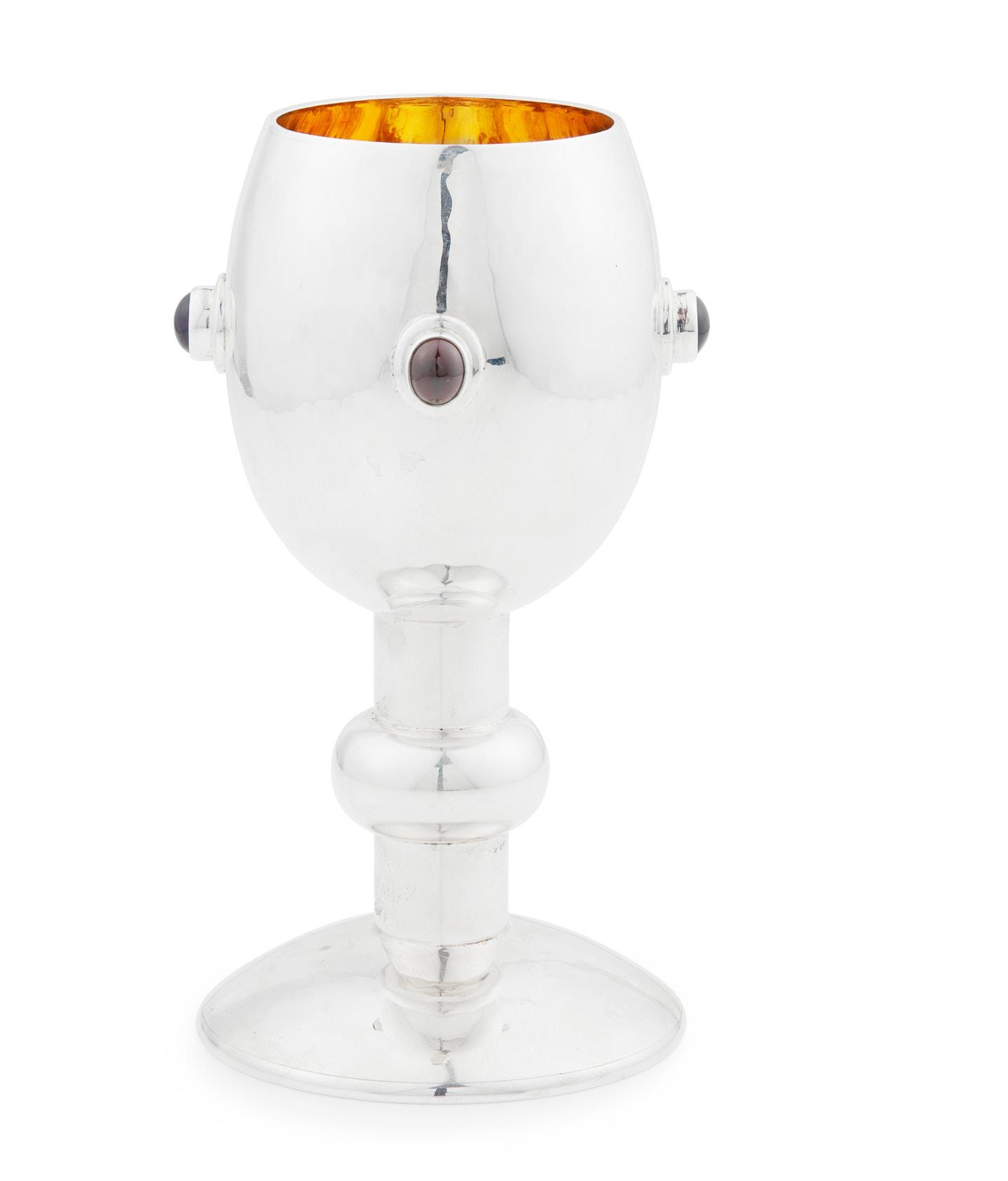
GRAHAM LEISHMAN STEWART, EDINBURGH 2009
the oval bowl of slightly planished finish, with gilt interior, collet set with various oval cabochon gem set bosses, including amethyst, garnet etc, to a knopped stem and large circular foot 18cm high, 18oz £3,000-5,000
Not only was Graham Leishman Stewart (1955-2020) one of Scotland’s foremost silversmiths of the late 20th and early 21st centuries, but he was also a master of hand engraving. The inspiration for his forms was mainly nature. He did not replicate what he saw, but it was organic and often intuitively so. He had great respect for words and was a devotee of the Irish bard Seamus Heaney. When he discovered Heaney’s favourite prose was the BBC’s Radio’s Shipping Forecast, this resulted in a series of bowls that have been much admired. He chose and arranged the almost hypnotic words of the Forecast with the flow of a poet. The series was expanded to other themes, the inspiration coming from poetry and Celtic spirituality. The engraving brought life to his bowls.
Stewart established his workshop in Dunblane in 1978. He always worked with a small team of skilled craftsmen. His father, an industrial designer, was a leading influence in his life as he had a keen interest in silversmithing. His brother, an engineer, joined him when he retired which explains why Stewart used a hydraulic press, not a tool normally associated with silversmithing, for very large commissions.
As visitors enter the Scottish Parliament, they are greeted with the Three Honours a large silver sculpture designed and made by Stewart. It is an impressive, intertwined creation with the three elements representing Scotland’s State Jewels, its crown, sceptre and sword, which are held in Edinburgh Castle. Arguably it has been one of the most viewed pieces of modern silver in Britain today.
His commissions reflect the admiration and respect others had for him, including those commissioning the impressive claret jugs which are part of the Millennium Collection for Bute House.
His shop in Dunblane provided a great opportunity to meet and chat with Stewart, allowing customers to grow their collections and acquire one-off pieces.
With important pieces now included within numerous British institutions including the Aberdeen Museum and Art Gallery, as well as The Pearson Silver Collection (which is devoted to Post-War II British silver), his work is well represented in both public and private collections which supports his place as a key contributor to modern Scottish and British silver.
72 225 §
226 §
A MODERN CENTREPIECE BOWL

GRAHAM STEWART, EDINBURGH 2006 the deep hemispherical bowl of planished finish and gilt interior, the pull-off lid with central pierced section of intertwined lattice 30cm diameter, 87.5oz £5,000-8,000
227 §
A MODERN SPOON
GRAHAM STEWART, EDINBURGH 2005 of hourglass outline with an oval bowl and planished finish 21cm long, 5.8oz
£300-500
228 §
A MODERN SPOON
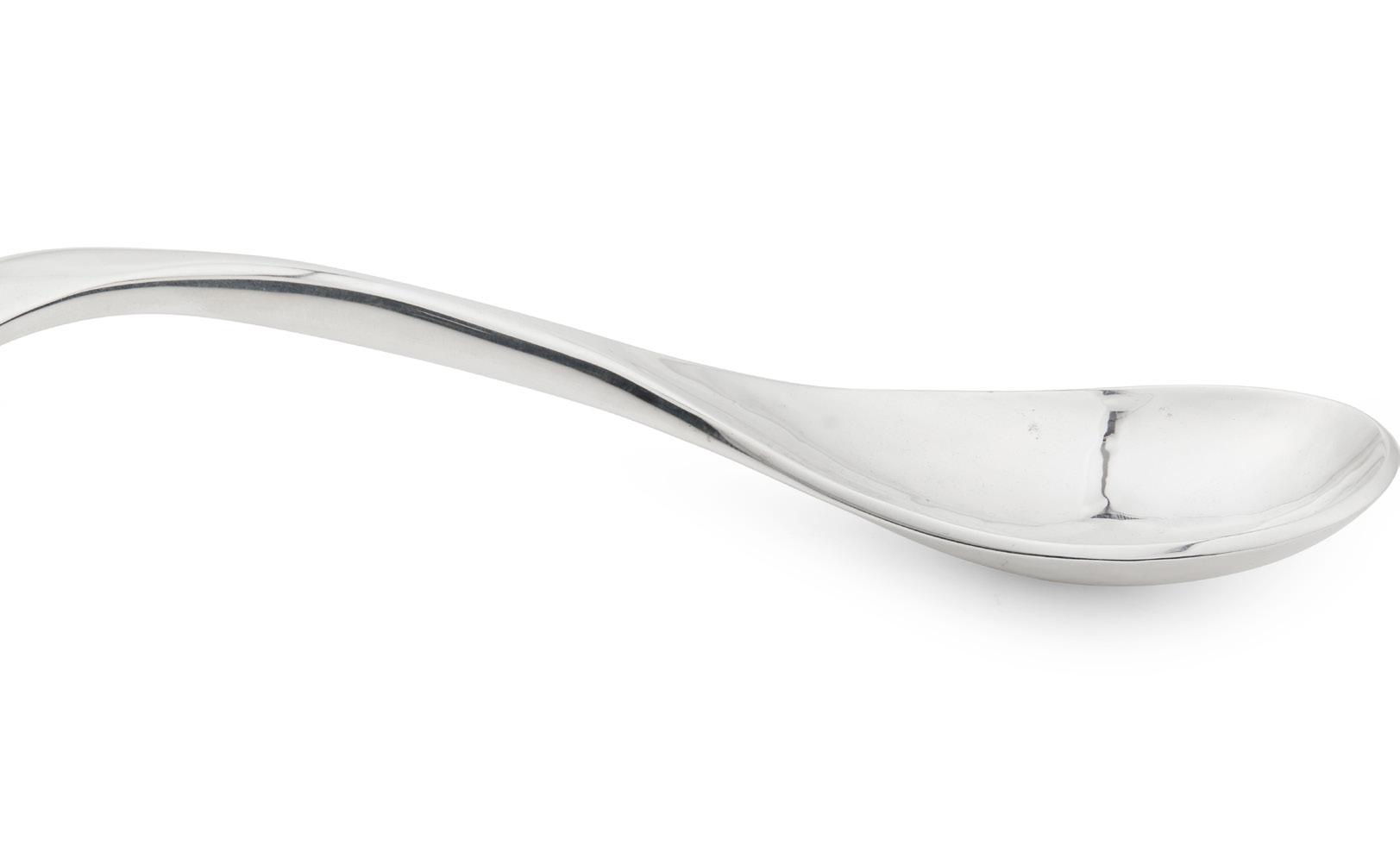
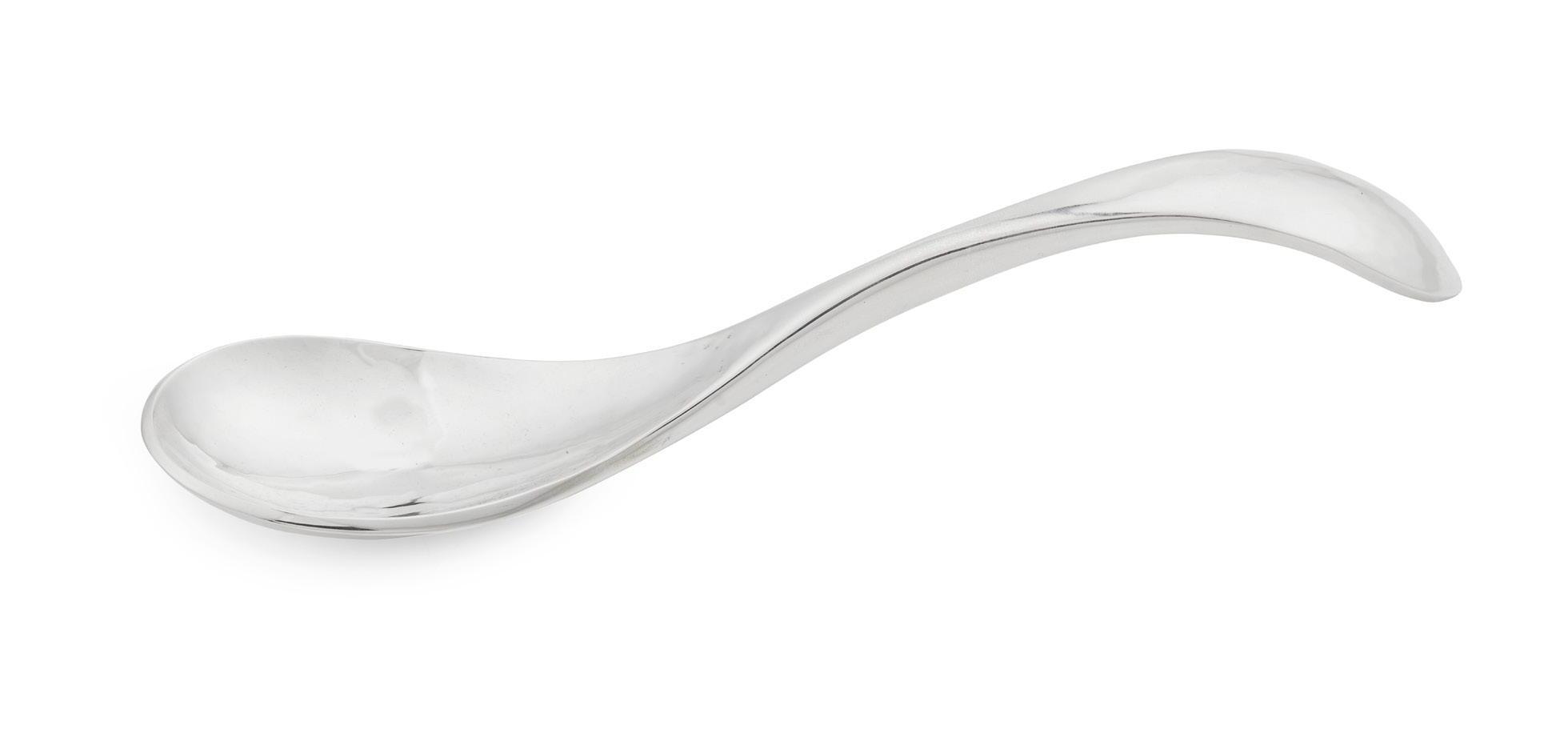
GRAHAM STEWART, EDINBURGH 2005 of hourglass outline with a planished finish 21cm long, 6.4oz
£300-500
Other fees apply in addition to the hammer price: see the ‘Buyer’s Guide’ section on page 2
226 227 228
229 §
A MODERN BELLIED WATER JUG

GRAHAM STEWART, EDINBURGH 2002 of hand raised and planished baluster form with long tapered spout the handle of curved form with scrolling terminal
17.5cm high, 25.3oz
£2,500-4,000
230 §
A MODERN PRESENTATION GOBLET
GRAHAM STEWART, EDINBURGH 1994
the deep planished bowl with engraved unicorn to the front, the stem with twisted vine detail, to a circular foot, engraved to the underside ‘Presented to Peter Dennis by his friends of Barclays Unicorn 1957-1994’

19cm high, 12.5oz
£1,500-2,500
Other fees apply in addition to the hammer price: see the ‘Buyer’s Guide’ section on page 2
A MODERN BROOCH
GRAHAM STEWART, EDINBURGH 1993
modelled as a stylised swan; together with an oval silver pendant with pierced detail of a bird to centre, and another silver pendant (3) 6cm, 1.6cm, 5cm wide £400-600
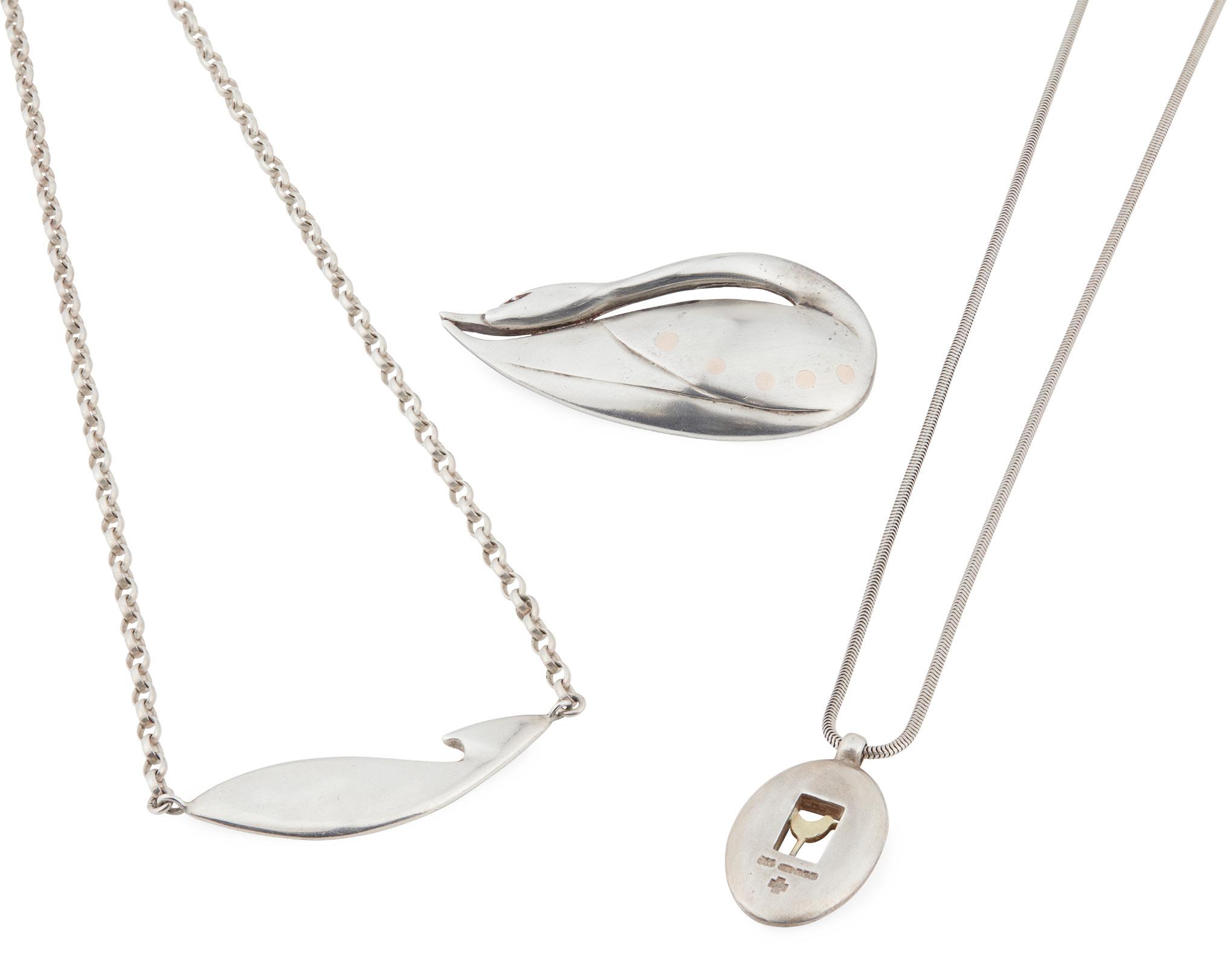
A MODERN BOWL
GRAHAM STEWART, EDINBURGH 1993
the shallow hemispherical bowl with engraved line motifs, with planished finish

8.5cm diameter, 89g
£300-500
A MODERN GEM-SET BROOCH IN A PRESENTATION BOX
GRAHAM STEWART, EDINBURGH 1990
formed as an abstract tree, collet set to the centre with a pear-shaped watermelon tourmaline cabochon, in a textured border, presented in a fitted wooden oval box (2)
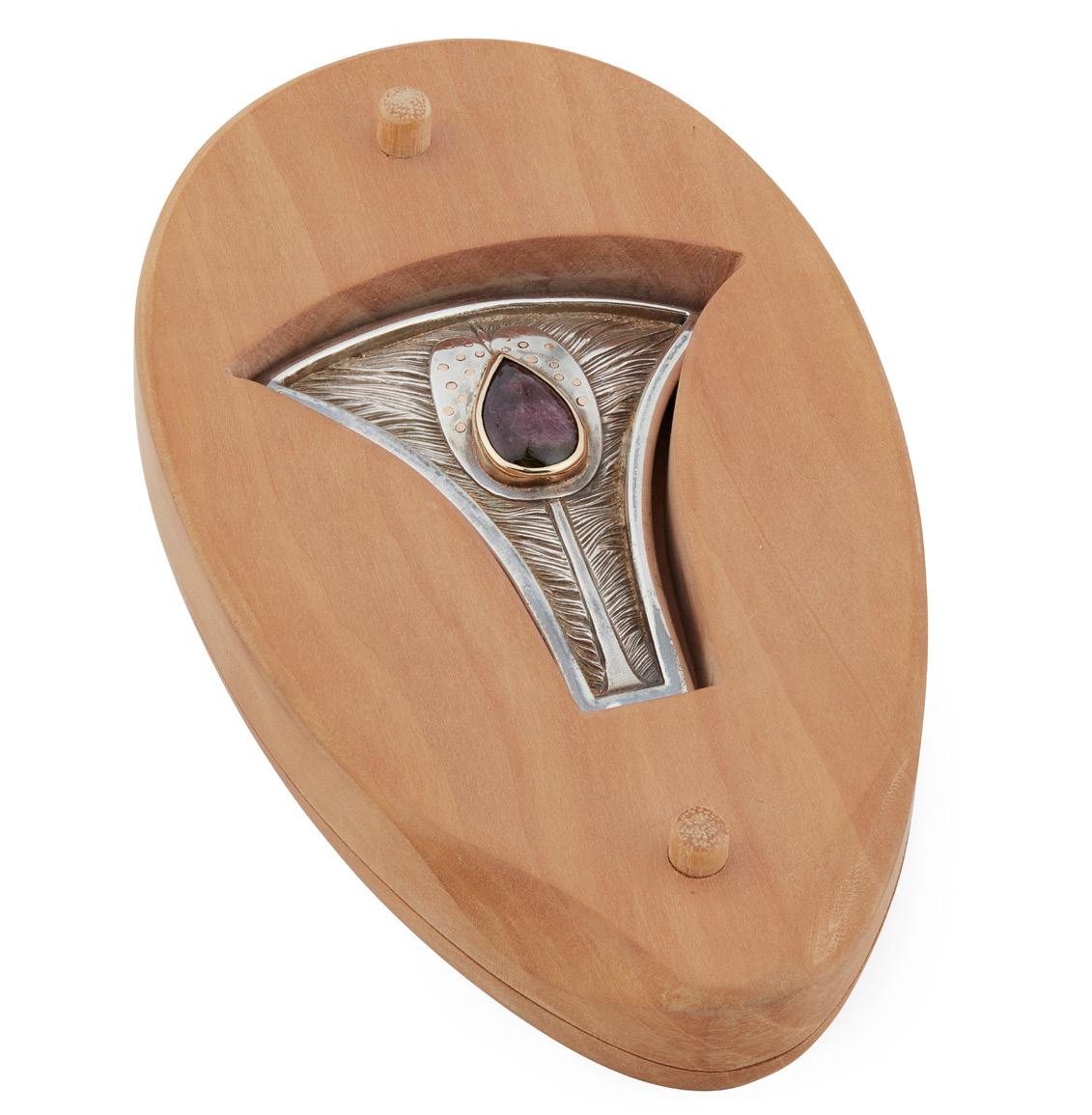
5.5cm long
£400-600
75
231 §
232 §
233 §
234 §
A MODERN BOWL
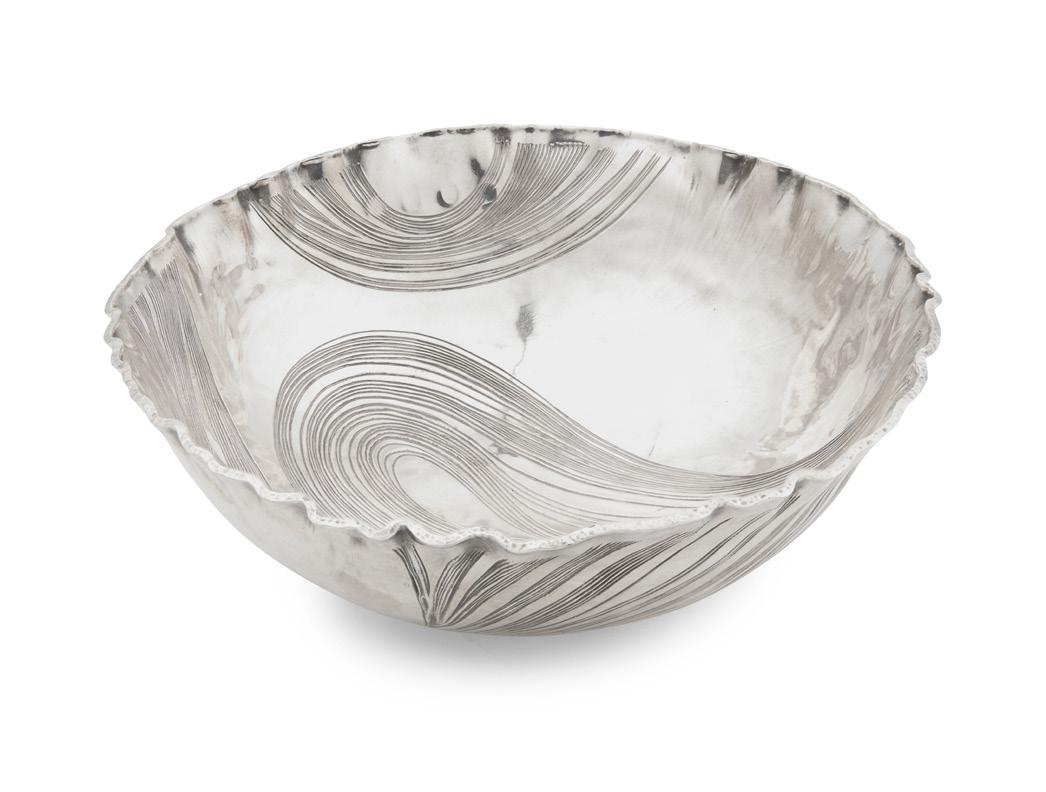
MALCOLM APPLEBY, EDINBURGH 1991 the slightly everted rim of undulating form, sweeping engraved detail throughout 18cm across, 16.9oz £500-700
235 §
A TREE PLAID BROOCH
MALCOLM APPLEBY, EDINBURGH 1990 the pin formed as a tree crown with a double stem trunk, to a double circular fitting with a textured finish, presented in a fitted case for Malcolm Appleby 12cm long, 7cm across brooch
£400-600
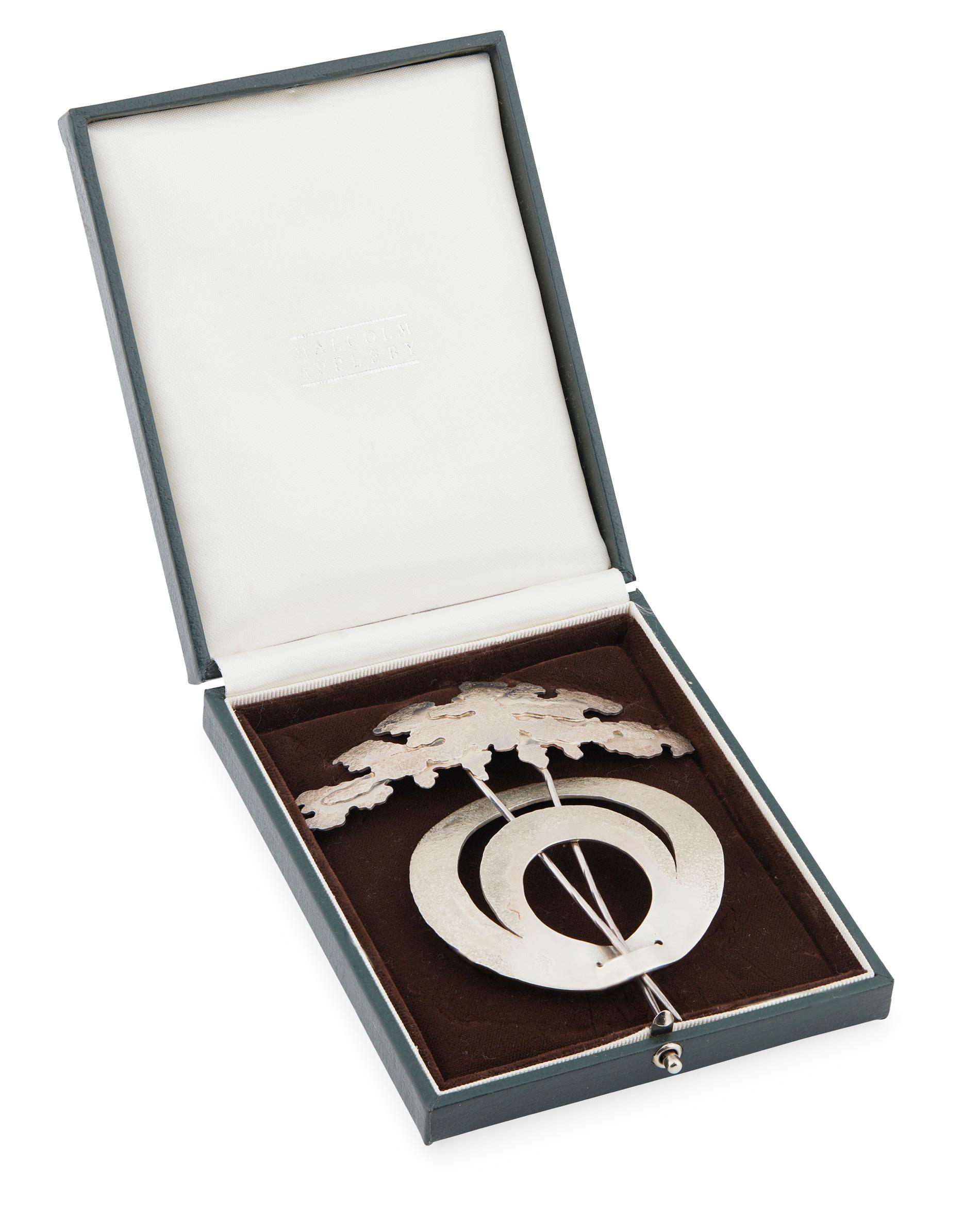
76

237
A 1970S STAG S M S CASTINGS, LONDON 1974 modelled naturalistically 14cm high, 16.2oz £1,000-1,500

236

A CONTINENTAL WOODCOCK marked to foot, (A835), modelled naturalistically 14cm high £700-1,000

238
A BRACE OF CONTINENTAL PHEASANTS with marks for Hannau to the wing, comprising a male and female each modelled as a pheasant in walking motion (2) 23cm high £5,000-8,000

78 Other fees apply in addition to the hammer price: see the ‘Buyer’s Guide’ section on page 2
240
A BRACE OF CONTINENTAL GROUSE IMPORT MARKS RM, LONDON 1983 each modelled naturalistically with articulated wings (2) 16cm high, 25.5oz (combined)
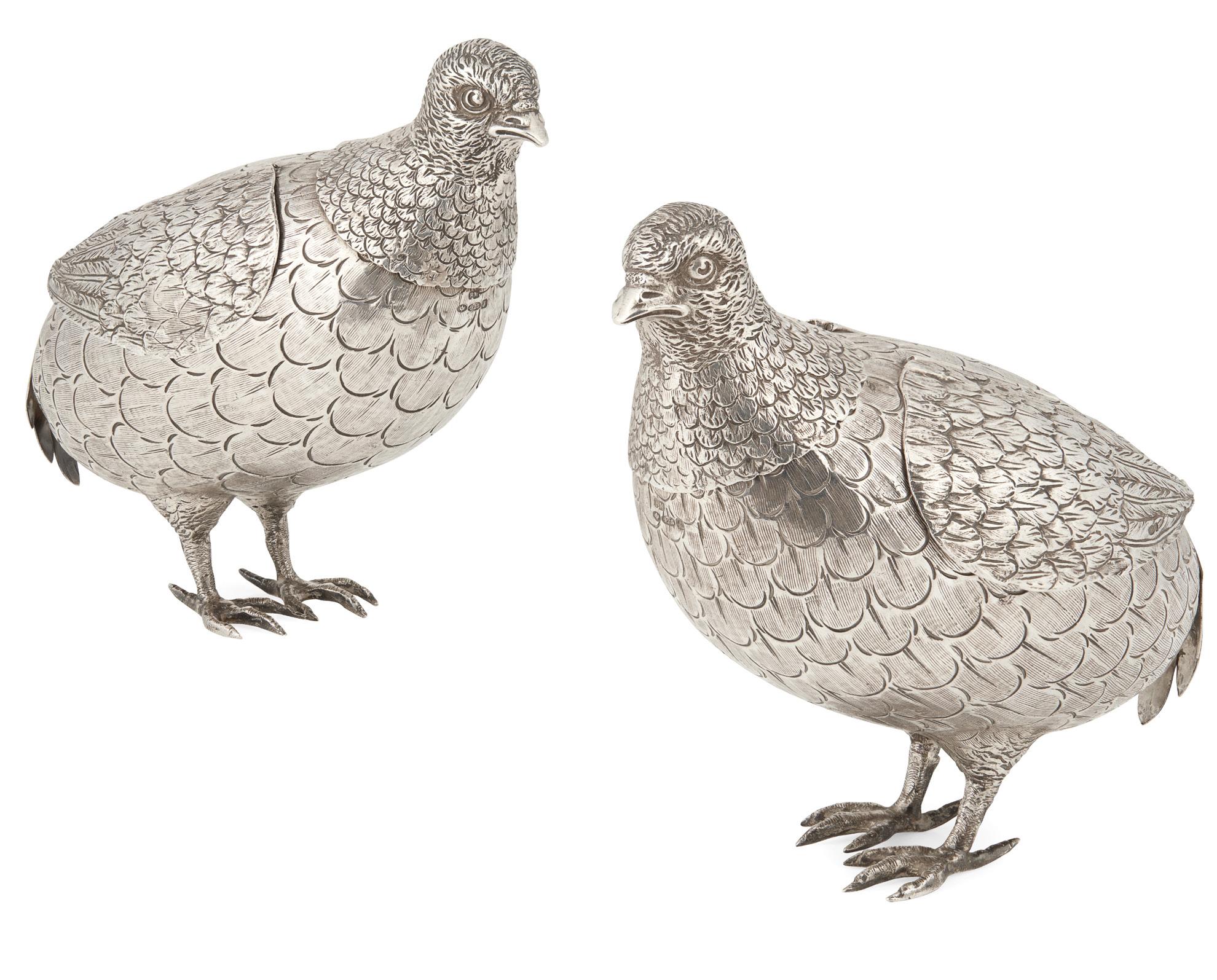

£2,500-3,500
239

A BRACE OF PHEASANTS
J R & CO. LTD. LONDON 1957 with import marks, each modelled as a pheasant in motion (2) 9.5cm high, 9.5oz
Provenance: Private Scottish Collection, Moray
£300-500
241
A 1970S PRESENTATION TWIN-HANDLED CUP
IRISH SILVER LTD, DUBLIN 1976
the hemispherical bowl with a Celtic knot-work border, engraved to the body, ‘THE JUBILEE CELTIC BOWL PRESENTED BY MR AND MRS GRIFFITH’ the S-scroll handles each modelled as a sea serpent, to a short stem, the pull-off lid with pierced Celtic beast motifs, the plinth with applied plaque, engraved with recipients including Fiona Hyslop MSP, Susan Boyle etc (2)
16.5cm high (cup), 44oz (weighable silver)

£1,000-1,500
Note: Instigated in the 11th century as a means to select those best for battle, Highland Games popularity soared in the 19th century following the lift on the ban on highland dress and culture. The Games incorporate all aspects of Highland culture including, music, dance, athletics and community spirit. The Jubilee Cup formed part of the West Lothian Highland games and was presented to those who advocated each year for the games, with recipients including Fiona Hyslop MSP and Susan Boyle. Starting as Bathgate Highland Games in 1972, the event took place on the last Saturday in May attracting families from West Lothian and all over Scotland. Furthermore, it hosted the British Pipe Championships for three years, attracting some of the best pipe bands in the world to West Lothian. The West Lothian games have now been disbanded and the vendors are selling the cup on behalf of charitable aims.
80 Other fees apply in addition to the hammer price: see the ‘Buyer’s Guide’ section on page 2
242
A LARGE QUAICH
EDWARD’S & SONS (OF GLASGOW), LONDON 1937
the large hemispherical bowl with twin-shaped lugs each with foliate engraved border, raised on a simple out turned collet foot
29cm across lugs, 18oz
£350-450
243
A 1930S THREE-PIECE TEA SERVICE
HAMILTON & INCHES, EDINBURGH 1936 comprising a teapot, twin-handled sugar basin, and a milk jug, all of oval baluster outline with a gadrooned border, C-scroll handles and each raised on a flared oval foot (3)
13.5cm teapot height, 35oz weight (all in)
£300-500
244
A COLLECTION OF SCOTTISH CLAN BADGES
to include examples by A Medlock, Medlock & Craik and McKenzie and Co of Inverness; together with Edinburgh hallmarked examples, of belted garter form with applied crest and motto (10)
Largest 41mm diameter
£250-350
245
A MATCHED PAIR OF VICTORIAN AND LATER TEA CADDIES ONE HAMILTON & INCHES, EDINBURGH 1916, THE OTHER HAWKSWORTH EYRE &CO LONDON 1895
of tapered bombé form with floral swags and fluted sections, with domed cover, one with pull-off, the other with a hinged (2)

15cm high, 19oz
£600-800
246
AN EDWARDIAN DISH RING
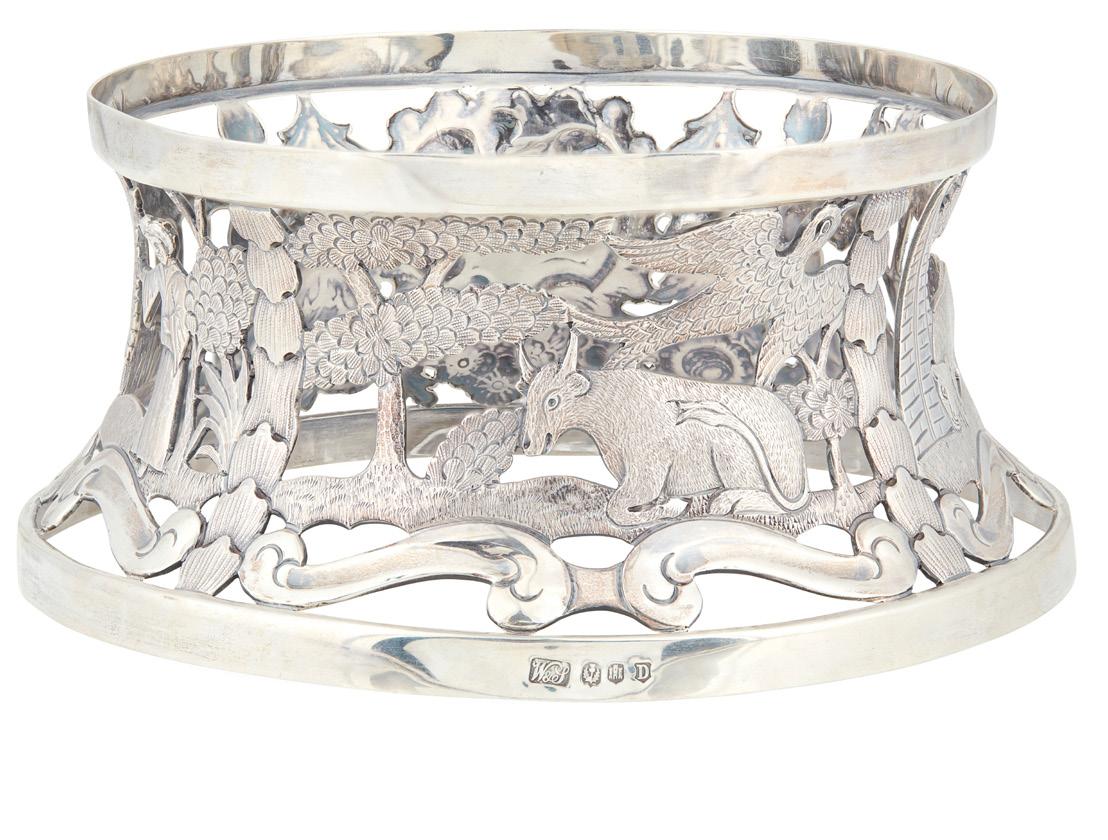
WILSON & SHARP, EDINBURGH 1909
of traditional circular outline, the pierced sides depicting an Oriental landscape, a stylised vacant cartouche to the centre in a floral border 20cm across at widest, 14oz
£600-800
247
AN EDWARDIAN SCOTTISH MARKET ‘CASTLE TOP’ CARD CASE
CRISFORD & NORRIS, BIRMINGHAM 1904
of rectangular outline with deeply embossed foliate and Rococo scrolls creating a cartouche enclosing a scene of Monarch of The Glen, the reverse similar decorated with vacant cartouche
10cm high, 2oz
£250-350
81
245
246
248
A EDWARDIAN CARD CASE CRISFORD & NORRIS LTD., BIRMINGHAM 1904
of rectangular outline, chased scroll and foliate detail throughout, with a stag on a Scottish hill depiction to one side, vacant cartouches to either side
10cm long, 2oz
£300-500
249
AN EDWARDIAN PART SET OF FISH KNIVES AND FORKS HAMILTON & INCHES, EDINBURGH 1902
comprising; six knives and five forks, of Old English and Thread pattern, with shaped and engraved blades; together with a matched set of six knives and seven forks all EPNS (qty)
£200-300
250 Y
A LATE VICTORIAN FOUR-PIECE TEA-SERVICE

LAWSON & CO., GLASGOW 1900 comprising a teapot, waterpot, sugar basin and a milk jug, each of inverted pear form, all-over chased floral and shell decoration, engraved initials to central cartouche, ivory inserts to S-scroll handles, the domed hinged lids with stylised finials (4) 25cm high, 57oz (combined weight)
Note: With non-transferable CITES selfcertification number: RXCFC5ES
£600-800
251
A VICTORIAN FOOTED SALVER
AC, EDINBURGH 1897 of scalloped circular outlook with moulded border, the dished centre with profuse floral and scroll decoration and engraved earls coronet and initials to McEnroe, raised on four short feet
Diameter 22cm, 13.5oz
£250-350
252
A VICTORIAN WHISKY DECANTER
HENRY TITTERTON BROCKWELL, LONDON 1893
the ovoid glass body with all over ribbed decoration engraved through in flowing script Whisky, with simple C scroll handle and silver mounted rim, the ovoid glass stopper silver mounted 20.5cm high
£300-500
253
THE 5TH DUKE OF SUTHERLAND’S VICTORIAN SILVER AND EBONY PARTNERS DESK STAND

JOHN GRINSELL & SONS, LONDON 1893
retailed by J C Vickery Regent Street London, the rounded rectangular ebony base with reticulated galleried sides, set with twin pen rests flanking a pair of inkwells with domed cover engraved with a coronet and cypher flanking a powder pot, each with a cut crystal base
Tray 39cm wide
Provenance: 5th Duke & Duchess of Sutherland
By descent
The Dunrobin Attic Sale, Bonhams Edinburgh 20th April 2021, part lot 327
£500-800
82
250 253
254
A VICTORIAN ENAMEL SET TABLE CIGAR BOX DEAKIN & FRANCIS LTD, BIRMINGHAM 1892 of rectangular outline, the hinged lid set with an enamel depiction of Highland soldiers in dance with a piper, engraved monogram and 11TH DEC 1893 to the front 19.5cm wide, 18.5oz £3,000-5,000

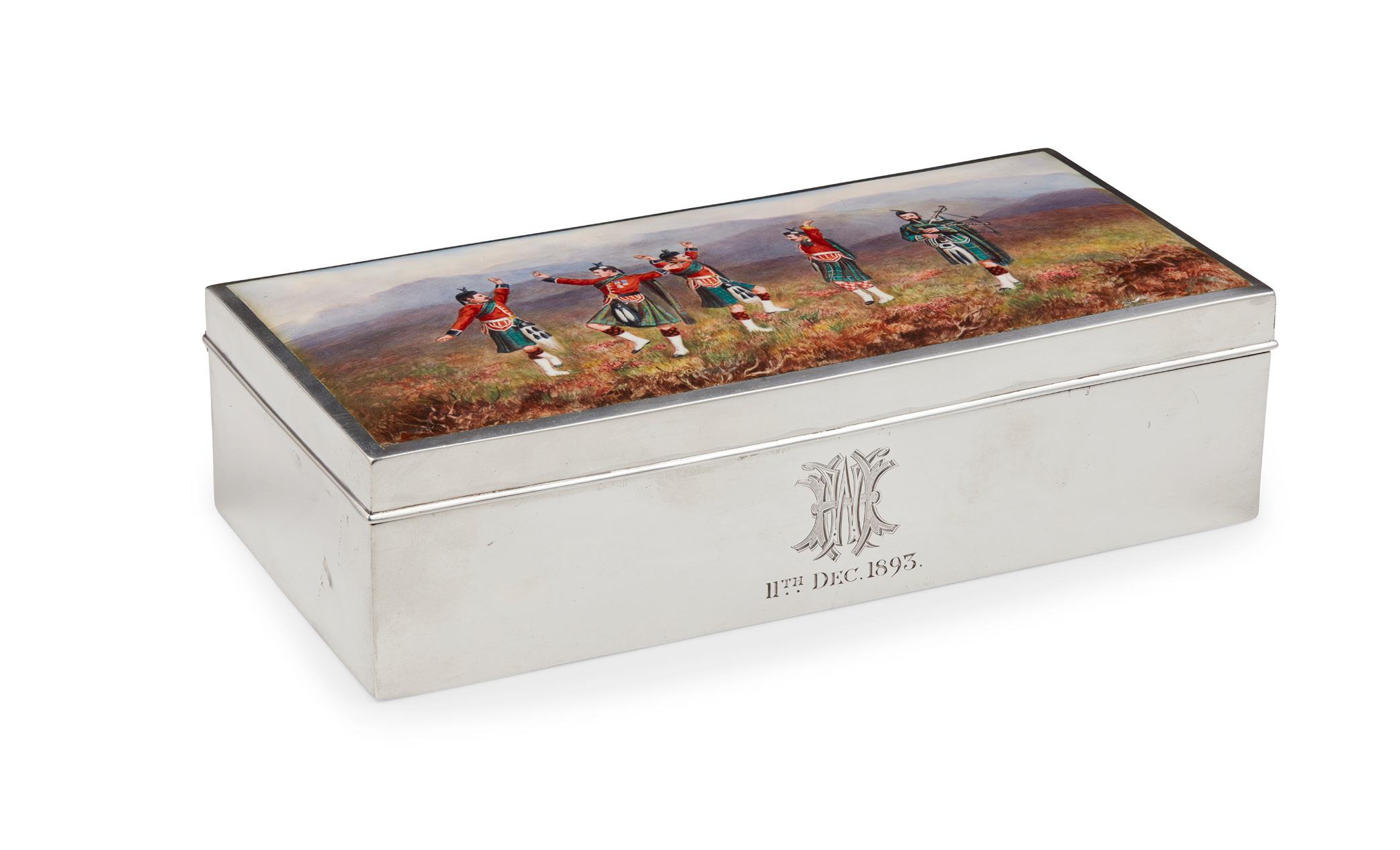
Other fees apply in addition to the hammer price: see the ‘Buyer’s Guide’ section on page 2
257
255
A LATE VICTORIAN MUG

WILLIAM MARSHALL, EDINBURGH 1891 of slightly tapered outline, with all-over chased scroll, foliate and floral decoration in a ground background, engraved inscription to the rim, ‘ Kenneth William Gordon Duke, from Aunt Isa 26th Feb 1898, the handle formed as a snake

10.2cm high, 6.5oz
£300-500
256
A PAIR OF VICTORIAN CHAMBERSTICKS
G & M CRICHTON, EDINBURGH 1888
the deep dished bases with bead rim and engraved crest, with gadrooned C scroll handle and centrally set with tall sconce and drip pan (2)
16cm diameter of base, 25.5oz (combined weight)
£500-800
257
A LATE VICTORIAN ASTROLOGICAL SUGAR BASIN
MACKAY & CHISHOLM, EDINBURGH 1883 of deep hemispherical form, with a chased border of astrological signs, chased scroll decoration throughout, to a gilt interior
8.7cm high, 7oz
£300-500
84 Other fees apply in addition to the hammer price: see the ‘Buyer’s Guide’ section on page 2
255
258
A VICTORIAN PIGGIN
RETAILED BY WILSON & SHARP, EDINBURGH 1883
maker’s mark JC (incuse) unknown, of simulated staved form with withies binding, the single loop handle with acanthus joint
14.5cm high, 7.2oz
£300-500
259
A VICTORIAN SILVER MOUNTED PRESENTATION COCONUT CUP

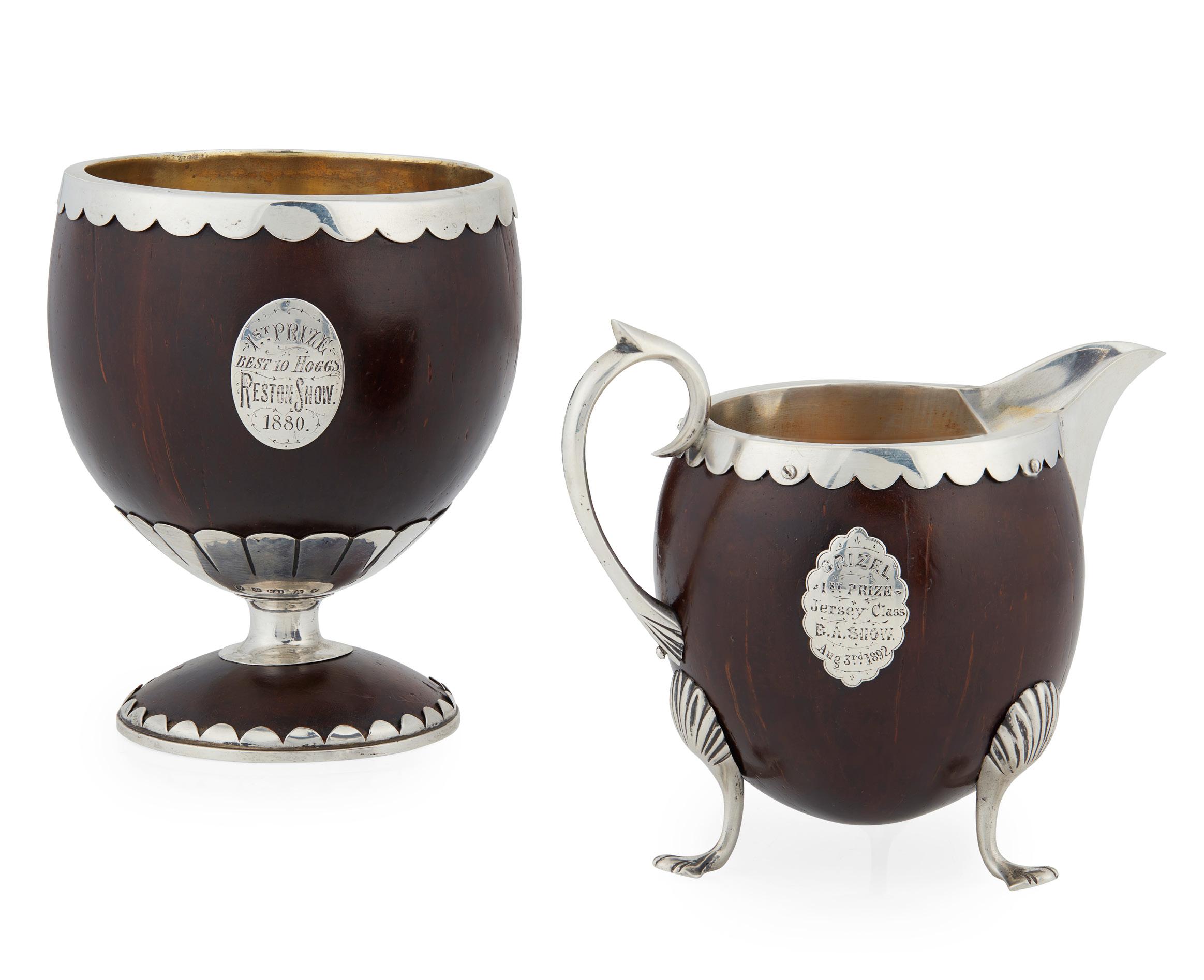
HAMILTON & INCHES, EDINBURGH 1880
the deep bowl, with applied scallop border, applied plaque to centre with engraved presentation inscription ‘1st Prize Best 10 Hoggs, Reston Show, 1880’, raised on a short stem with circular foot, both with similar applied border; together with another coconut jug, unmarked, applied disc ‘Grizel, 1st Prize, “Jersey” Class... 1892’, raised on three clasped moulded feet (2)
13cm, 12cm high
£400-600
85
258
259
260
AN IMPORTANT SUITE OF TEN CANDLESTICKS AND MATCHING PAIR OF CANDELABRA
JOHN CRICHTON III, EDINBURGH 1879
the foliate writhen sconces above a similarly decorated twisted baluster stem, raised on a stepped shaped circular domed base, each with flared foliate formed pull out sconce, each engraved with crest and motto, the triple branch candelabra of similar form with scrolling foliate arms (16)


candlesticks: 22cm high, candelabra: 46cm high, 17.8oz + 59.5oz each
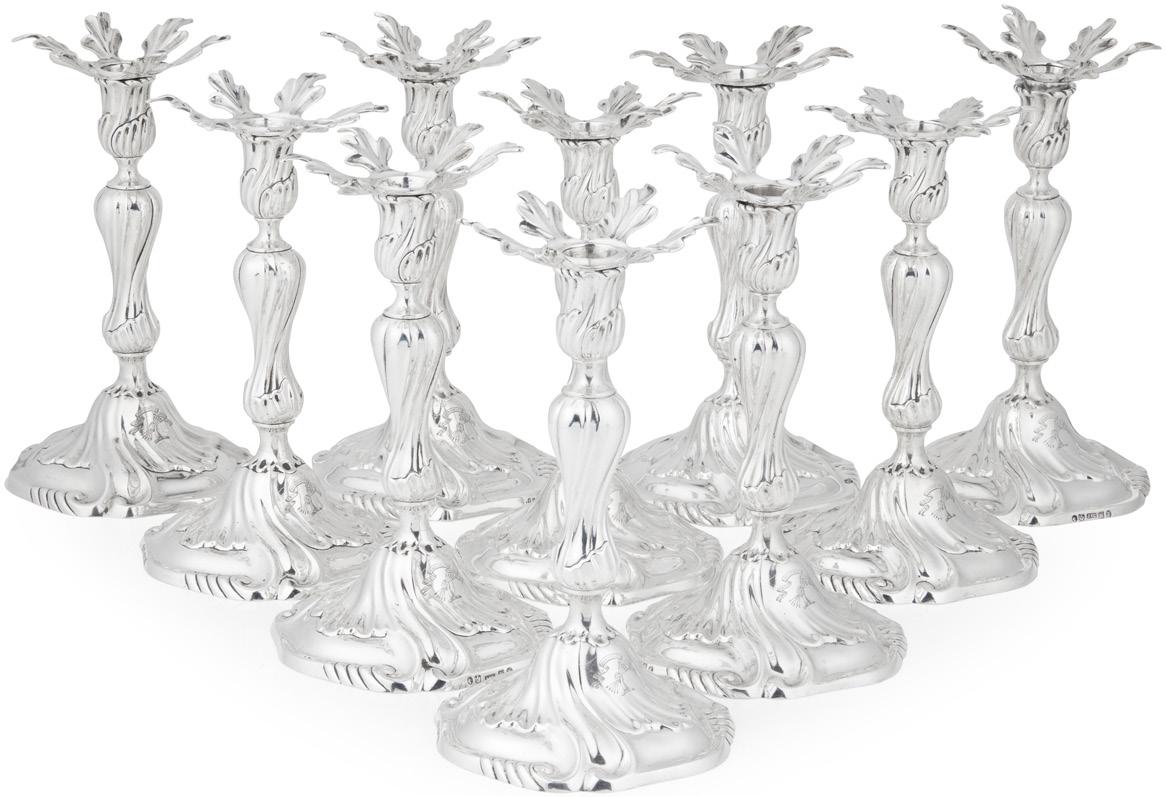


Provenance: Private collection, Property of a Gentleman

Heraldry: The Crest of Brodie of Lethen, Co. Elginshire (or Nairnshire)
Crest: A dexter hand holding a bunch of five arrows all proper Motto: Be mindful to unite
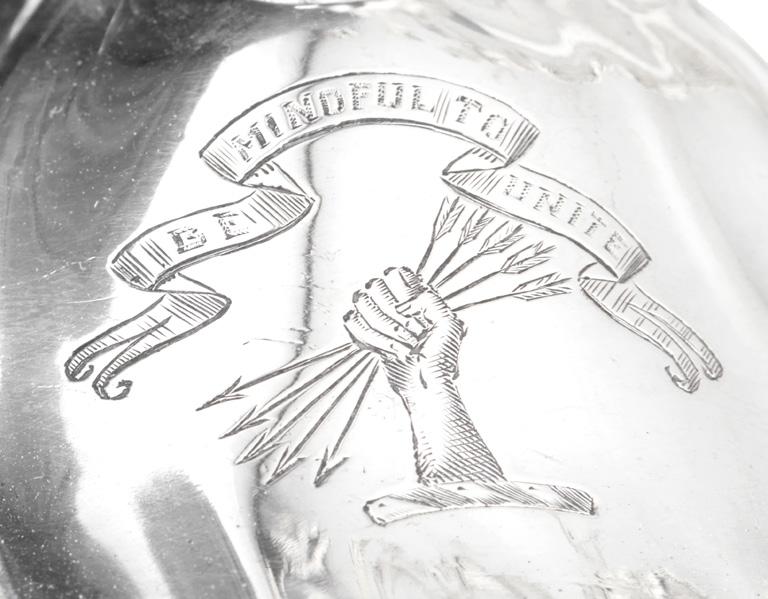
Note: This remarkable suite of candelabra and matching candlesticks must rank amongst the largest sets of Scottish hallmarked examples ever recorded.
Commissioned by James Campbell John Brodie of Lethen, the 12th of Lethen, who was born 26th March 1848 and died 26th February 1880 a month before his 32nd birthday and likely only just after this commission was complete.

James had succeeded his elder brother, Thomas Stewart Brodie in 1865. Married to Fanny Sophia Constance Wood (died 21st March 1909) on the 7th September 1869. She was the third daughter of Edmund Thomas Wedgwood Wood, of Henley Hall, Ludlow in the County of Shropshire and his wife, Sophia Schmidt.
James served as the Lord Lieutenant for the County of Nairnshire from 1873 until his death as well as the Deputy Lieutenant for the County of Morayshire. He was succeeded by his eldest son, Alexander who was only 4 years old at the time.
This remarkable suite directly copies European cast mid-18th century (and earlier) candlesticks. The design commonly found in major cities in central Europe notably Strasburg and crossing the border into Germany. The copy is so direct it seems highly likely that the Brodie of Lethen family had, at least, a pair of such sticks and wanted to enlarge a set. This original set presumably a family heirloom and now in wealthier and / or raised in status the family wished to cement their heritage while promoting their current standing.
£25,000-35,000
86 Other fees apply in addition to the hammer price: see the ‘Buyer’s Guide’ section on page 2

A VICTORIAN TWIN-HANDLED BOWL
JAMES KIRKWOOD, EDINBURGH 1871
the deep hemispherical bowl with a gadrooned border, engraved to the body with the Stewart coat of arms, the twin handles each modelled as lion rampant supporters
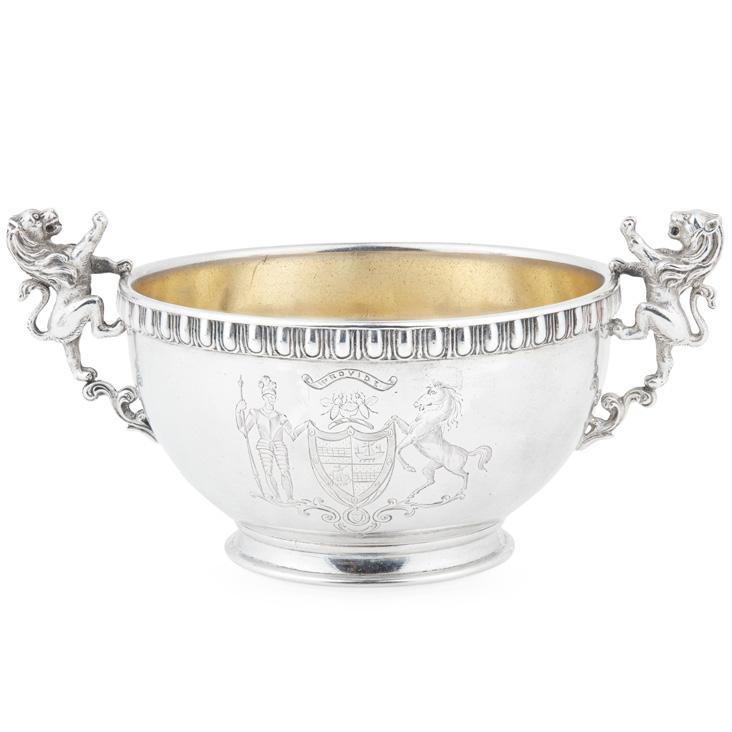


14cm across handles, 7.7oz
Heraldry: The Arms of Stewart of Grantully in the County of Perthshire otherwise of Blair and Balcaskie in the County of Fifeshire
Crest: Arms: Quarterly 1st and 4th Or a fess chequy azure and argent (for Stewart) 2nd and 3rd Argent a lymphad with its oars in action sable (for Lorn) all within a bordure azure charged with eight buckles or
Below the arms is pendant the badge of a Baronet of Nova Scotia.
Crest: Two bees countervolant proper
Supporters: (Dexter) A man in armour holding in his exterior hand a lance (all proper?) (Sinister) A horse (argent?)
Motto: Provide
Given the date of hallmarking this bowl was in the possession of either Sir William Drummond Stewart of Grantully in the County of Perthshire, the 19th Laird of Grantully and the 7th Baronet of Blair and Balcaskie in the County of Fifeshire (born 26th December 1795 died 28th April 1871) or his surviving brother, Sir Archibald Douglas Drummond Stewart of Grantully, 20th Laird of Grantully and the 8th Baronet of Blair and Balcaskie (born 29th August 1807 died 1890).
£400-600
262 Y
A VICTORIAN PRESENTATION LIDDED JUG
JAMES MCKAY, EDINBURGH 1861
of cylindrical form, with allover engraved scroll cartouches for various winners, the central cartouche with presentation inscription, ‘...MID LOTHIAN COAST ARTILLERY VOLUNTEERS/ JULY 1862’, the domed hinged lid with the finial modelled as artillery, the S-scroll handle with similar scroll decoration with ivory insert
28cm high, 34oz
Note: With non-transferable CITES self-certification number: 2VAQU555
£600-900
263 Y
A VICTORIAN LIDDED BEER JUG
JAMES MCKAY, EDINBURGH 1857
of baluster outline, chased panels depicting baskets of fruit, in scroll surrounds, the vacant cartouche in a foliate scroll border to front, the acanthus clasped S-scroll handle with similar engraved floral detail and ivory inserts, the domed lid with chased floral decoration, raised on a circular foot
26cm high, 28oz
Note: With non-transferable CITES self-certification number: QUKY3CRX
£800-1,200
264
AN EARLY SCOTTISH VICTORIAN INCORPORATION OF GOLDSMITHS OF EDINBURGH BADGE
ROBB AND WHITTET, EDINBURGH 1853
cast as the Incorporation of Goldsmiths of Edinburgh, motto, plain ring suspension and hinged pin
5cm, x 4cm
£400-600
88 Other fees apply in addition to the hammer price: see the ‘Buyer’s Guide’ section on page 2 261
261
262 263
265 Y
A VICTORIAN EWER
JM, GLASGOW 1852
of slender baluster form, the body with chased floral decoration and a vacant cartouche in a foliate border, to a ground background, the C-scroll handle with similar floral chasing, the hinged lid with a foliate finial, all raised on a domed circular foot with floral detail 35cm high, 33.5oz
Note: With non-transferable CITES self-certification number: AVT34KE2
£600-800
266
A VICTORIAN SCOTTISH MARKET ‘CASTLE TOP’ CARD CASE
NATHANIEL MILLS, BIRMINGHAM 1849
of conventionally shaped rectangular outline the obverse engraved with a scene of Balmoral Castle within the landscape surrounded by alternating bands of engine-turned decoration, the reverse with similar banded decoration and engraved armorial
10cm, 2.3oz
£800-1,200
267
A VICTORIAN 18CT GOLD SNUFF BOX
DAVID MCDONALD, GLASGOW 1843 of rounded rectangular outline, engraved acanthus scroll-work throughout, vacant cartouche to hinged lid with foliate thumbpiece 7cm wide, 79g
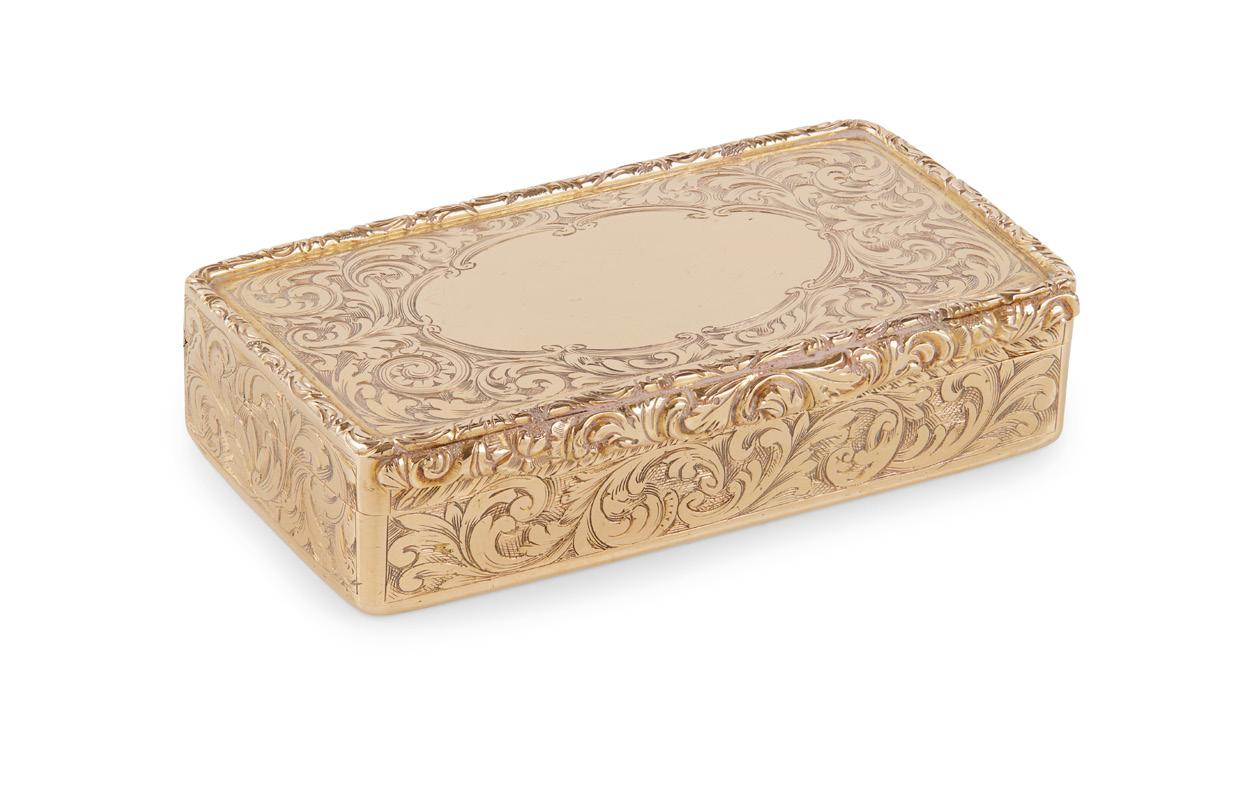

£2,000-4,000
268
A PAIR OF WILLIAM IV BEAKERS

ROBERT GRAY AND SONS, GLASGOW 1837 of plain tapering form with engraved full armorials, slight stepped foot rim (2)
11cm high, 13oz (combined)
£1,000-1,500
89
267 266 268
269
A WILLIAM IV SNUFF BOX
JAMES NAYSMITH, EDINBURGH 1836 of rectangular outline, cross-hatch pattern throughout, the hinged lid with engraved initials and Masonic emblems, foliate thumbpiece, the interior lid engraved ‘Mr. James Marshall/ H.M. Customs/ North Berwick 1847’; together with another George Edward & Sons, Glasgow 1896, of oval outline, chased floral decoration throughout (2)
7cm, 5cm wide, 3oz (combined)
£300-500
270
A WILLIAM IV TWIN-HANDLED SOUP TUREEN


GEORGE INNES GLASGOW 1835
of oval outline, with a slightly everted cast shell and floral border, with an engraved armorial to the centre of one side, and presentation engraving to the other ‘Presented by the Congregation at Grey Friars Church to Robert Hood Esquire... 1836’, raised on four acanthus clasped scroll feet, the handles of similar decoration, the pull-off lid of bellied form, with an acanthus clasped loop handle (2)

38cm wide, 26.5cm high, 84.5oz
£3,500-5,000
270
271
A MATCHED SET OF SIX GEORGE III TABLE FORKS
JAMES MCKAY, EDINBURGH 1834/7 of Fiddle pattern, engraved initial to terminal; together with a set of ten dessert forks, Rettie & Son of Aberdeen, Edinburgh 1765 (16)
20cm long, 27oz
£300-500
272
A WILLIAM IV SCOTTISH MARKET SNUFF BOX
LONDON 1831 (PART MARKED)
the rectangular snuff box with all over finely chased training intertwined thistle the hinged cover with cartouche engraved ‘R Wright’ and with floral thumbpiece, gilded interior
9.2cm wide, 6.2oz
£400-600
90 Other fees apply in addition to the hammer price: see the ‘Buyer’s Guide’ section on page 2
273
A GEORGE IV SWING-HANDLED BASKET

MACKAY, CUNNINGHAM & CO., EDINBURGH 1829
of circular outline with a cast shell and floral border, the raised edge with embossed panels depicting arable and pastoral farming scenes, raised on a short stem with a moulded foot, the swing handed with a floral motif and vacant cartouche to centre
34cm diameter, 11cm height with handle down, 47oz
£1,200-1,500
274
A SET OF SIX SINGLE-STRUCK GEORGE IV TABLESPOONS
MUIR & SONS, GLASGOW 1824
of single struck King’s variant pattern, engraved crest to terminal (6) 22cm long, combined 16oz
£200-400
275
A MATCHED GEORGE III WINE FUNNEL AND STAND
W & P CUNNINGHAM EDINBURGH 1820 & J MCKAY, EDINBURGH 1817
of single piece form with wide bowl and curved spout, the stand J McKay Edinburgh 1817 of dished circular form with gadrooned rim (2)
Funnel 12cm high, stand 10cm diameter, total weight 3.8oz
£300-500
276 Y
A GEORGE III ‘REGENCY’ THREE PIECE TEA-SERVICE

WILLIAM MARSHALL, EDINBURGH 1820
comprising a teapot, twin-handled sugar basin and a milk jug, all of circular outline, heavily chased with floral decoration to the body with vacant cartouches to either side, the everted rim with a cast floral border, the C-scroll handles with ivory inserts to the teapot, raised on a circular foot (3)
15cm high teapot, 48.4oz (combined)
Note: With non-transferable CITES self-certification number: 1XR7TUPR
£1,200-1,500
91
273 276
277
A GEORGE III PRESENTATION SNUFF BOX
JOHN SHAW BIRMINGHAM 1820
of rectangular outline, with an embossed shell and floral border, the hinged lid with presentation engraving ‘ ...To Mr. Thomas Paul, by the Deacon’s of the Incorporated Trades of the Royal Burgh of Lanark...1821’, gilt interior
8cm wide, 4oz
Provenance: Captain Alastair Wardrop Euing Crawford (1896 - 1924), hence by descent to the present vendor
£300-500
278
A COLLECTION OF FIDDLE PATTERN FLATWARE
to include, a basting spoon, Philip Grierson Glasgow 1819, a set of three tablespoons, J.S. Glasgow 1836, engraved initials to the terminal and a set of twelve dessert spoons, Andrew Wilkie, Edinburgh 1812; together with a dessert spoon, Francis Howden, Edinburgh 1804 and a condiment spoon (18) 24.5oz (combined)
£300-500
A REGENCY GEORGE III SALVER

JAMES MCKAY, EDINBURGH 1818
of circular outline, cast gadrooned border, engraved armorials to the centre raised on three scroll bracket feet 46cm, 96.8oz
Heraldry: The Arms of Hay of Smithfield and Haystoun in the County of Peeblesshire
Arms: Quarterly 1st and 4th Azure three cinquefoils argent (for Fraser) 2nd and 3rd Gules three bars ermine (for Gifford of Yester) over all an escutcheon argent three escutcheons gules (for the Paternal Arms of Hay) within a bordure vert charged with unicorns’ heads couped alternating with mullets argent Below the arms is pendant the badge of a Baronet of Nova Scotia.
Crest: An ox-yoke in bend or the bows gules
Supporters: (Dexter) A countryman proper holding over his shoulders an ox-yoke or bows gules
(Sinister) A royal stag proper
Motto: Pro patria [For my country]
Note: Given the date of hallmarking this salver was in the possession of Sir John Hay of Smithfield and Haystoun in the County of Peebleshire, the 5th Baronet (born 15th January
1755 died 23rd May 1830). Sir John was the eldest son of Sir James Hay, the 4th Baronet and his wife, Dorriel Campbell, the youngest daughter and co-heiress of Daniel Campbell of Greenyards in the County of Stirlingshire. Sir John married The Honourable Mary Elizabeth Forbes, the second and youngest daughter of James Forbes, the 17th Lord Forbes and his wife, Catharine Innes on the 9th of July 1785. He succeeded his father as the 5th Baronet of Smithfield and Haystoun on the 21st of October 1810.
£3,000-5,000
280
A GEORGE III SWING HANDLED BREAD BASKET

WILLIAM PEAT, EDINBURGH 1814 of oval form, heavy cast gadrooned and shell border, deep bowl with crest, motto and italic HMN to centre, raised on an oval foot with gadroon border, the handle similarly decorated with crest, motto and initials to the bowl 24cm across, 36.2oz
Heraldry: With the crest and motto for MacNeil of Barra
£600-800
279
279
280
281
A GEORGE III SAUCE BOAT
GEORGE MCHATTIE, EDINBURGH 1812 of traditional baluster form, armorial engraved to the body with a gadrooned border to rim, acanthus leaf clasped S-scroll handle, raised on an oval foot
25.5cm high, 16oz
Provenance: Captain Alastair Wardrop Euing Crawford (1896 - 1924), hence by descent to the present vendor
£300-500
282
A GEORGE III FISH SLICE
JOHN ZEIGLER, EDINBURGH 1805 of Fiddle pattern, the blade with pierced oval decoration in an engraved floral and foliate border, engraved italic initials to terminal; together with a collection of flatware, various makers and marks, including a toddy ladle, J.N. 1816, of Fiddle pattern, a pair of sugar tongs, and various teaspoons and dessert spoons (10)
19cm long, 10.4oz (combined)
£150-250
283
A SET OF FIVE SCOTTISH WINE AND SPIRIT LABELS - MACDONALD CLAN INTEREST each marked R.G, circa 1800, each of cut out form as the MacDonald crest, engraved for Brandy, Madeira, Rum, Sherry, Port, with belcher link chains (5)
4.5cm wide
£500-700
284 Y
A SCOTTISH GEORGE III TEAPOT ALEXANDER CAMERON, EDINBURGH 1798

of inverted pear shape, all-over embossed floral and scroll decoration, the cartouches each engraved with armorials, the hinged lid with seated Chinese man, bold ribbed spout, raised on a spreading foot
13cm high, 14oz
Note: With non-transferable CITES self-certification number: FX31P6XL
£1,500-2,500
285
A GEORGE II TEAPOT AND STAND FRANCIS HOWDEN, EDINBURGH 1790 each of oval outline, Bright-cut engraved borders, with a straight spout and C-scroll handle to the teapot, the stand raised on four striated legs (2)
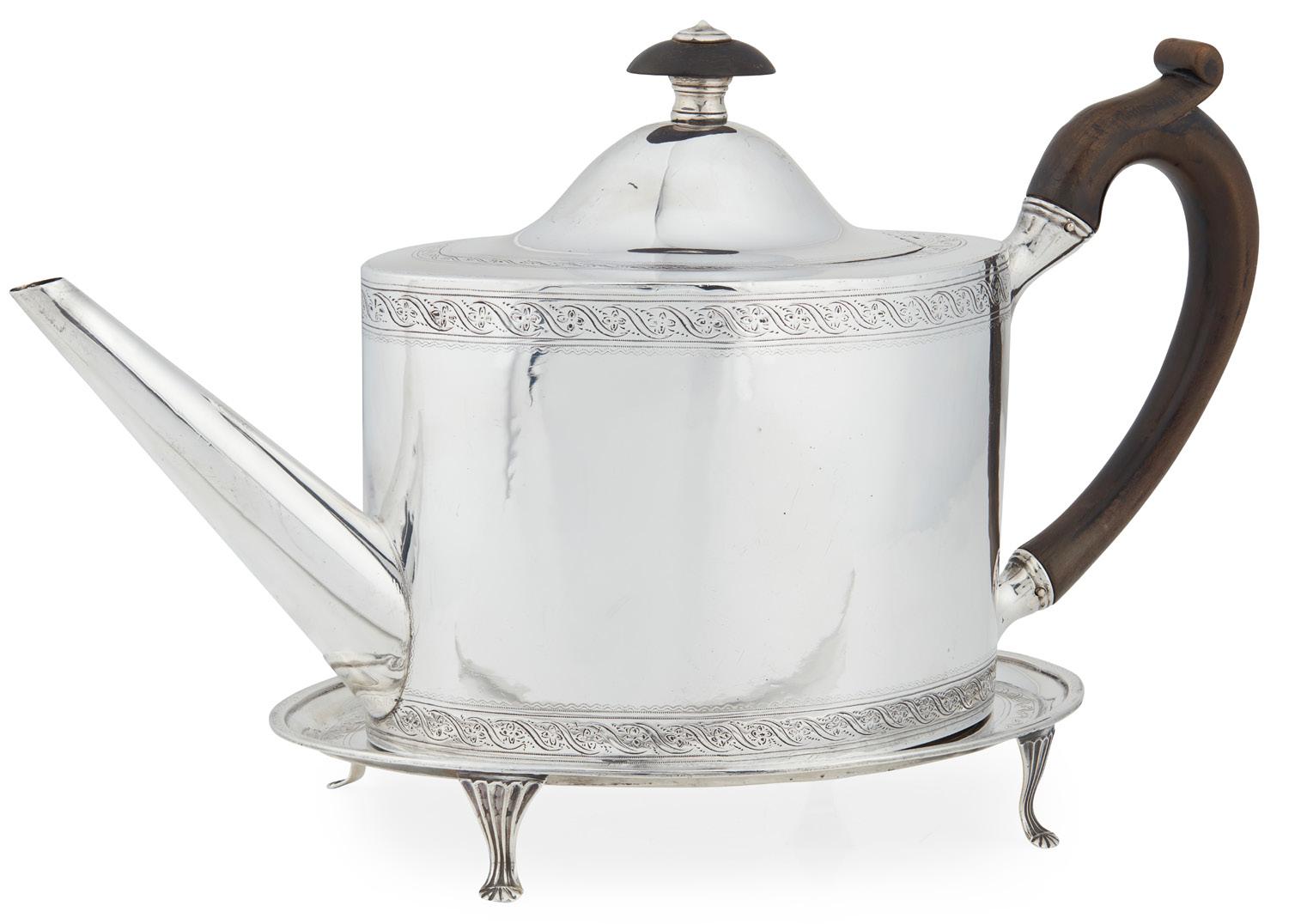
18cm high (teapot), 22oz (combined)
£1,000-1,500
286
A GEORGE III DISH CROSS MAKER’S MARK LACKING, EDINBURGH 1789
of conventional hinged form, with a central circular section with four square section supports, each with sliding pierced mount with S-scroll legs to gadrooned and pierced circular feet, the upper section with curved arm and pierced and beaded fan terminal 32cm wide, 14.4oz
£400-600
287
A MATCHED SET OF CELTIC POINT PATTERN TWELVE TABLESPOONS
VARIOUS
to include, three by Patrick Robertson, Edinburgh 1789, four by Francis Howden and five by R. Smith & Son Glasgow 1898, all of Celtic Point pattern, engraved motto and initial to the terminal; together with a meat skewer, marked WB, with a shell terminal and an unmarked pair of sugar tongs (14) 22cm long, 28.5oz (weighable silver)
Provenance: Captain Alastair Wardrop Euing Crawford (1896 - 1924), hence by descent to the present vendor
£300-500
Other fees apply in addition to the hammer price: see the ‘Buyer’s Guide’ section on page 2
284 285
288
A RARE SUITE OF TWENTYFOUR GEORGE III SCOTTISH SILVER GILT TABLE AND DESSERT KNIVES
DAVID MARSHALL, EDINBURGH
CIRCA 1785 - 1795 (DATE LETTER LACKING)
comprising twelve table knives and twelve dessert knives, each with rounded silver gilt handles, beaded edges and oval cartouches with ribbon tied surmount each engraved with crest and armorials, simple steel blades (24)
table knives 25cm long, dessert knives

22.5cm
Note: Scottish hallmarked knives are incredibly rare in any quantity. Sets such as this of both table and dessert knives are virtually unheard of. The poor survival rate and likely limited production levels due to supply from specialist cutlers/ knife makers in Sheffield and London undercutting the Scottish makers
£1,200-1,500
289
A GEORGE III SWING HANDLED SUGAR BASKET
WILLIAM DEMPSTER, EDINBURGH 1783 the tapered oval bowl with engraved ribbon and rose swags with an oval vacant cartouche, the beaded rim with a beaded hinged handle, raised on an oval base with acanthus engraved border and beaded rim
14cm wide, 5.6oz
£350-450
290
A GEORGE II SALVER JAMES WELSH, EDINBURGH 1779 of moulded circular outline with a cast gadrooned border, raised on three hoof feet
18cm diameter, 8.3oz
£1,200-1,500
291
A SET OF SIX GEORGE III TABLESPOONS WILLIAM DAVIE, EDINBURGH 1775
of Hanoverian pattern with script initial NO to terminal and wide heel to reverse of bowl (6)
21.5cm long, 13.5oz (combined weight)
£500-800
292
292
A GEORGE III DRUM TEAPOT

WILLIAM DEMPSTER, EDINBURGH 1768 of traditional drum form, chased floral and swag border, the hinged lid with an engraved coronet and initial, and bun finial, the C-scroll handle and spout with acanthus detail

12cm high, 19.5oz
£800-1,200
293
A SET OF SEVEN MATCHED GEORGE III TABLESPOONS
PATRICK ROBERTSON, EDINBURGH 1766/80 all of Old English pattern, engraved crest and motto to terminal (7)
22cm long, 14.3oz
£300-500
294
A GEORGE III HASH SPOON LOTHIAN AND ROBERTSON, EDINBURGH 1762
of Hanoverian pattern
42cm long, 7.5oz
£600-800
Other fees apply in addition to the hammer price: see the ‘Buyer’s Guide’ section on page 2
288
AN IMPORTANT PAIR OF EARLY GEORGE III ROCOCO TWIN BRANCH CANDLEBRA WILLIAM DEMPSTER, EDINBURGH 1760
the large baluster sconce with shell clasped detail above a scroll-shouldered tapering stem with concave fluting, on a compressed knop to a large stepped and fluted shell and scroll-shaped circular base, the twin acanthus capped scrolling branches with fluted central knop with classical female figures supporting a reeded and shell detailed circular drip pan, the baluster sconces with shell clasped details (2)

38cm high, 41cm wide, 120.5oz
Provenance: Private collection, Property of a Gentleman
Note: As has been discussed before the survival of cast George II/ III Scottish candle sticks is unusually small, particularly when compared to the much larger survival of English examples. However, when this rare survival of candle sticks is compared to the survival of candelabra they appear to number as few as three or four pairs across the 18th century.
These include a pair of twin light candelabra from a set of four candlesticks, the branches by James Ker 1728, matched to earlier candlesticks by Colin McKenzie of 1710 (see Scottish Gold and Silver Work, I Findlay plate 79), a pair within National Museum of Scotland collection by Milne and Campbell of Glasgow c1760 (see Silver Made in Scotland, G Dalgleish & H Steuart Fothringham item 5.52).
Perhaps of most interest, are a pair from a Private American collection on typical inswept square-based candlesticks, William Dempster 1759 with comparable earlier branches of 1747 by the same maker to those under discussion.
One theory for this has always been that Scottish makers would have retailed these types of wares rather than made them, so they would carry the mark of their English maker rather than a Scottish retailer. With the rise of specialist candlestick makers south of the border, it seems a credible explanation.
These candelabra also showcase the height of rococo design in Scotland, a style that is often considered not to have taken off. Although more restrained than the opulent and fully embraced style in London fuelled by the influx of Huguenot craftsmen in London.


The style, proportion and decoration of these sticks is rather unusual and definitely point to a Scottish design and manufacture. The shell and scroll detail to the base and stem are more elaborate than often found, the overall proportions and deeply concave base, while reminiscent of English examples is rather quirky in their designs. There is little doubt these were made in Scotland rather than just retailed.
The base and stem to these examples show great skill in casting and design. However, it is in the cast branches with the female figures to the leaf-capped scrolling arms, which come from the same earlier mould used in 1747, that the true skill of the maker and designer are seen. It should be noted this design element is virtually unique in Scottish silver.
£12,000-18,000

95 295
A GEORGE II TEAPOT
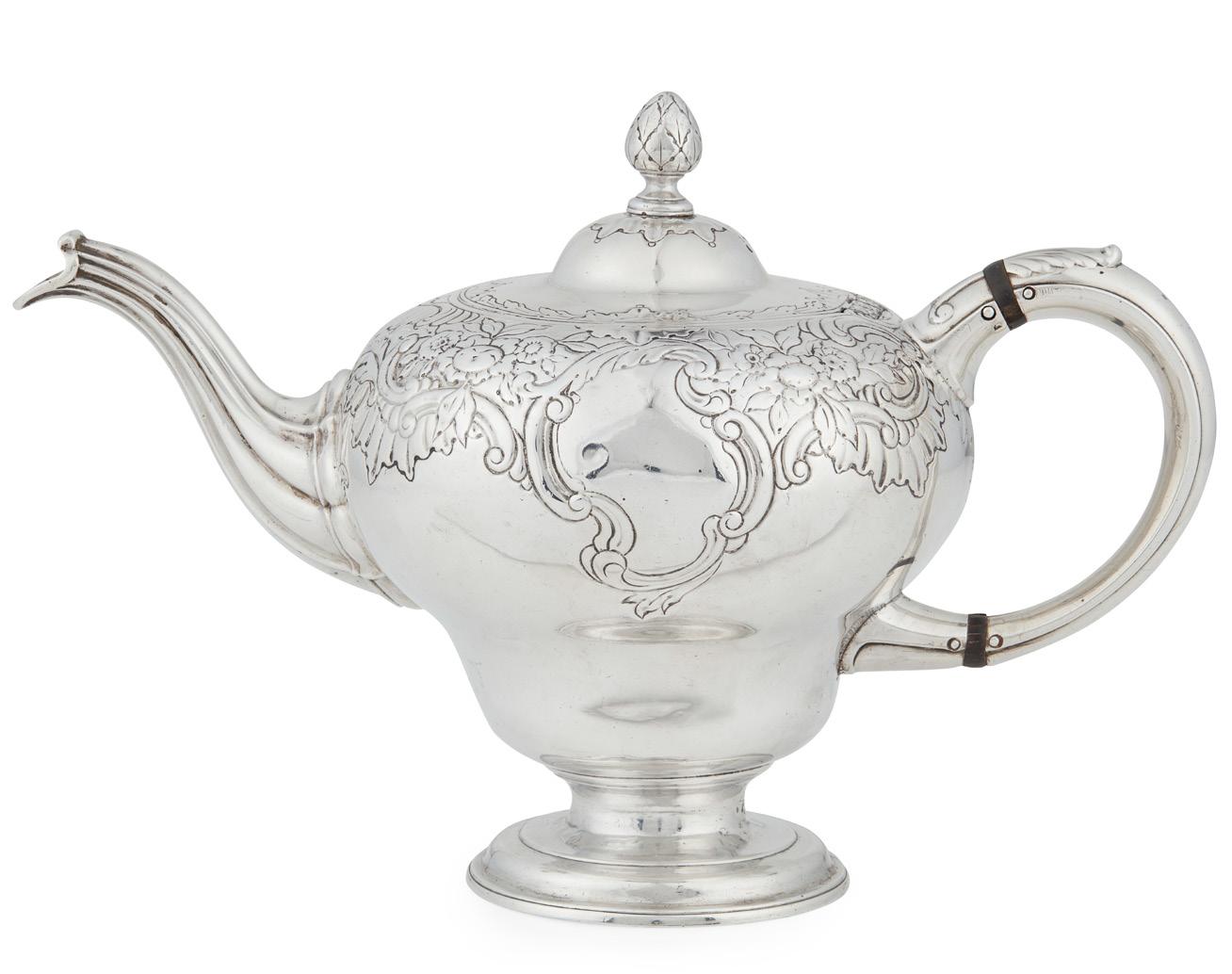
JAMES WELSH, EDINBURGH 1758
Assay Master Hugh Gordon, of typical inverted pear-shaped design with a chased border of scrolls and flower heads within rococo scroll panels, with twin, vacant, scroll formed cartouches, with fluted S-scroll spout and simple C-scroll handle with insulators and acanthus capped thumb piece, raised on domed foot
17cm high, 23oz
£1,000-1,500
297 Y
A GEORGE II SPIRIT KETTLE AND STAND WILLIAM AYTOUN, EDINBURGH 1749
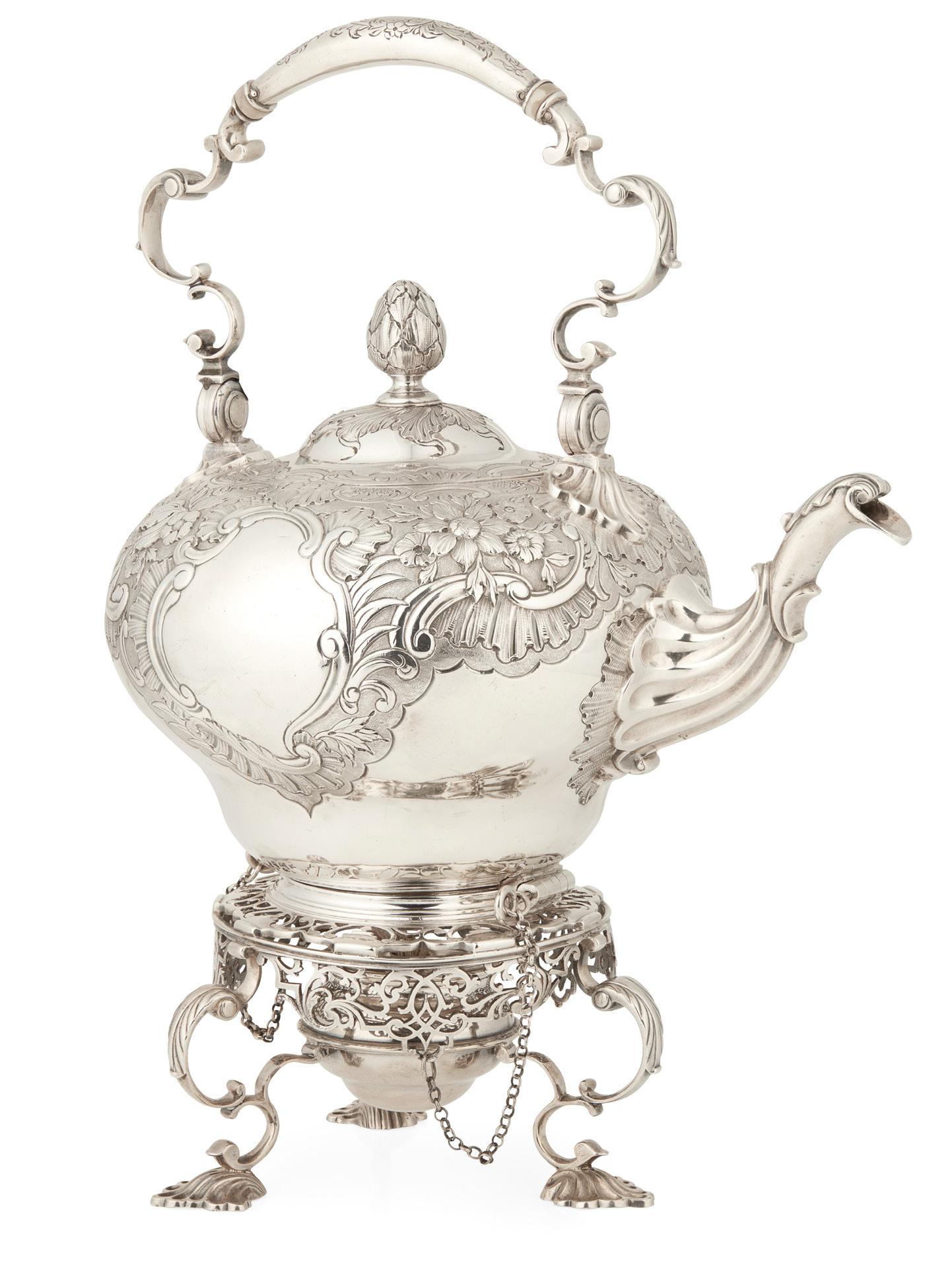
Assay Master Hugh Gordon, the body of inverted pear shape with a finely chased border of flower head clusters within scroll and shell borders, twin vacant cartouches, the domed hinged cover with spiralled foliate decoration emanating from a cone finial, the whole raised on a tripod stand with leaf capped S-scroll and shell supports with integral burner
36cm high, 56.3oz
Note: With non-transferable CITES selfcertification number: T55AD3KK
£3,000-5,000
298
A GEORGE II CASTER
PATRICK ROBERTSON, EDINBURGH 1756 of baluster outline, with sweeping fluted detail, the pull-off pierced lid with knopped finial
19.5cm high, 6.3oz
£300-500
96 Other fees apply in addition to the hammer price: see the ‘Buyer’s Guide’ section on page 2 296
296 297
A PAIR OF GEORGE II TABLE CANDLESTICKS
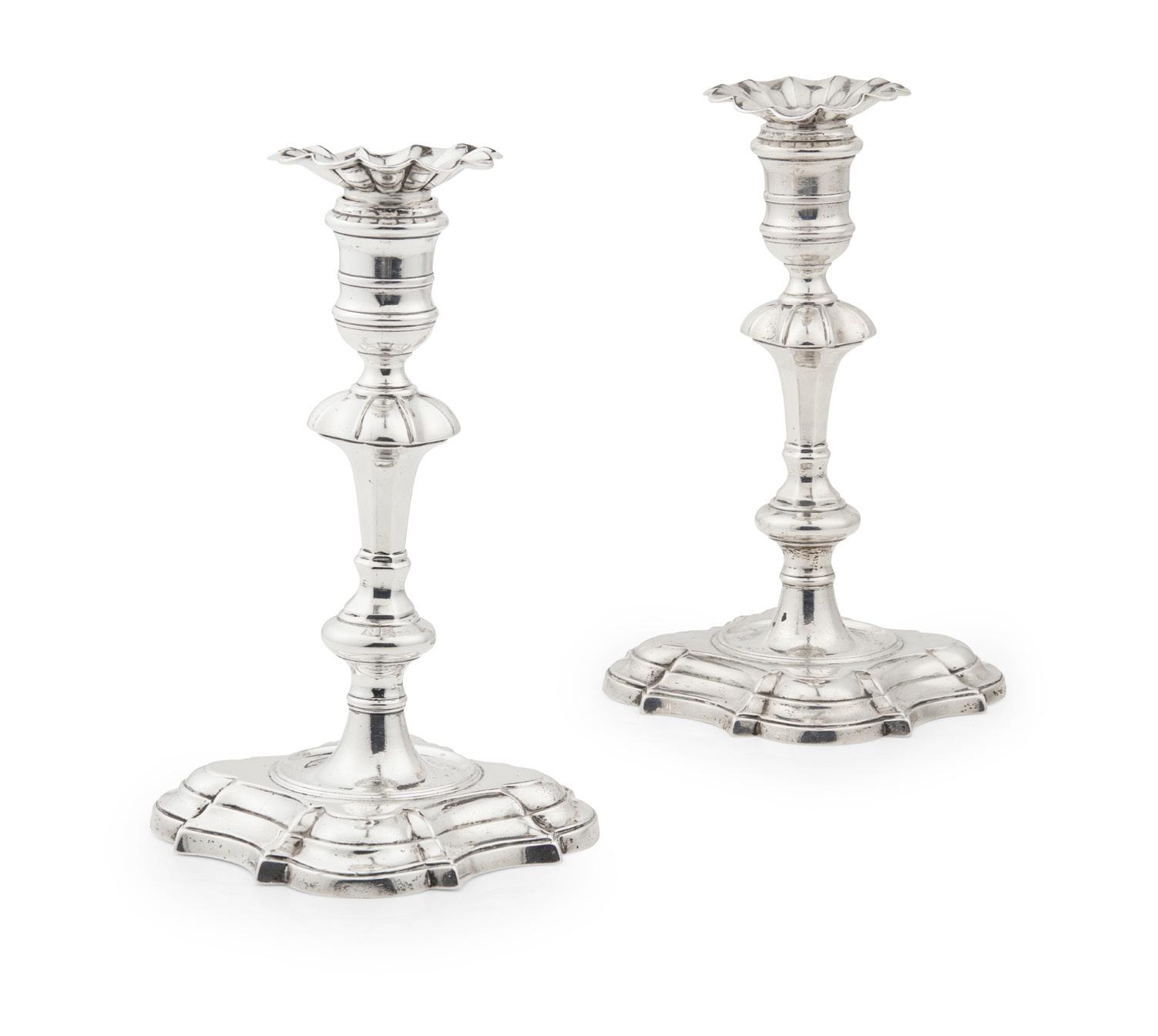
ROBERT LOW, EDINBURGH 1746
Assay Master, Hugh Gordon, cast and of traditional knopped form, bobeches (unmarked), lobed, stepped rounded square base, engraved crest and motto “Tendimus” (2)
19cm high, 32 (combined)
£2,500-3,500
300
A GEORGE II BRANDY PAN


JAMES WEMYSS, EDINBURGH 1744
Assay Master Hugh Gordon, of traditional outline, baluster turned wooden handle
21cm high, 13.3oz (gross)
£800-1,200
301
A SCARCE GEORGE I SQUARE SALVER
ROBERT GORDON, EDINBURGH 1743
Assay Master Edward Lothian, of rounded square outline, moulded edges, with crest and motto to centre, raised on four moulded bracket feet to corners
20.5cm wide, 18oz
£3,500-5,000
302
A QUEEN ANNE MUG
LIKELY EDINBURGH 1705 of slight bellied form with S scroll handle and flared simple foot, the underside engraved with traces of double engraved initials
9cm high, 5oz
£1,200-1,500
303
A SCARCE PAIR OF GEORGE II TRENCHER SALTS
PATRICK GRAHAM, EDINBURGH 1729
Assay Master Archibald Ure, of traditional elongated octagonal outline, italic initial engraved to body (2)
7.4cm wide, 6oz (combined)
Provenance: Private collection, Property of a Gentleman
£2,500-3,500
304
A CLAN GUNN HARDSTONE SNUFF BOX
EARLY 18TH CENTURY
unmarked, of rounded rectangular outline, the base inset with a lapis lazuli panel, in a border of chased scroll decoration, the hinged lid with the armorial for Clan Gunn, engraved Elizabeth Duff/ 1713
7cm wide, 84g
£350-500
299
299 301 303
A QUEEN ANNE TABLESPOON
JOHN SEATOUN, EDINBURGH 1712
Assay Master Edward Penman, of Hanoverian pattern, rat tail bowl, with engraved initial to the reverse of terminal
20cm long, 2oz
£300-500
A RARE PAIR OF QUEEN ANNE SUGAR CASTERS
COLIN MCKENZIE, EDINBURGH 1708
Assay Master Edward Penman, of flared cylindrical form with moulded foot and girdle, engraved with crest and motto, the pull-off domed cover with pierced and engraved decorations and cast acorn finial (2)


17cm high, 15.2oz (combined)
Provenance: Sotheby’s 24th February 1966 lot
35
Lyon & Turnbull, Scottish Silver & Accessories, 12th August 2015 lot 425
Private Collection
Heraldry: With crest and motto of Thomson £4,000-6,000
A WILLIAM & MARY TREFID SPOON
ROBERT INGLIS, EDINBURGH 1690 marked to stem RI in a heart punch, with a rat tail bowl, engraved initials ‘WV/ IA’ to reverse of the trefid terminal 19cm long, 46g
£300-500
98 Other fees apply in addition to the hammer price: see the ‘Buyer’s Guide’ section on page 2
306
308
A RARE PAIR OF LATE 17TH CENTURY CONTINENTAL TANKARDS MARKED PB TO MOUNTS AND BASE
the straight-sided laburnum body silver mounted, the upper rim engraved with trailing foliage and flower heads, the lower girdle similarly engraved, the two rims joined by an S-scroll handle with an acanthus leaf and figural thumbpiece with prick engraved 1680, the hinged cover with foliate scroll thumb piece and embossed with a border of four male masks flanking panels of fruit, the centre with engraved armorial for Ogilvy Lord Banff, the whole resting on a simple domed and socle foot with scroll decoration (2) 15cm high
Heraldry: Arms: Quarterly 1st and 4th Argent a lion passant guardant gules imperially crowned or (for Ogilvy) 2nd and 3rd Argent three papingoes vert beaked and membered gules (for Pepdie of Dunglas)
The arms are ensigned with a Lord of Parliament’s coronet.
Crest: A lion’s head erased gules (for Ogilvy)
Supporters: (Dexter) A man in armour with a target proper (Sinister) A lion rampant gules
Motto (not shown): Fideliter [Faithfully]
£8,000-12,000
Note: These armorial bearings (although heavily rubbed) pertain to the Lordship of Banff that was created for Sir George Ogilvy (died 1663), Baronet within the Peerage of Scotland on the 31st August 1642. Owing to the style of the engraving it most probably dates to the mid to late 18th Century and no later to 1803 when the Lordship of Bamff and the two Nova Scotian baronetcies either fell into extinction or dormancy for the want of a male heir. Given the presumed period of engraving, the tankard was probably in the possession of one of the following: Alexander Ogilvy, the 6th Lord Banff (born 1718 died 1746), Alexander Ogilvy, the 7th Lord Banff (died 1771) or William Ogilvy, the 8th Lord Banff (died 1803).
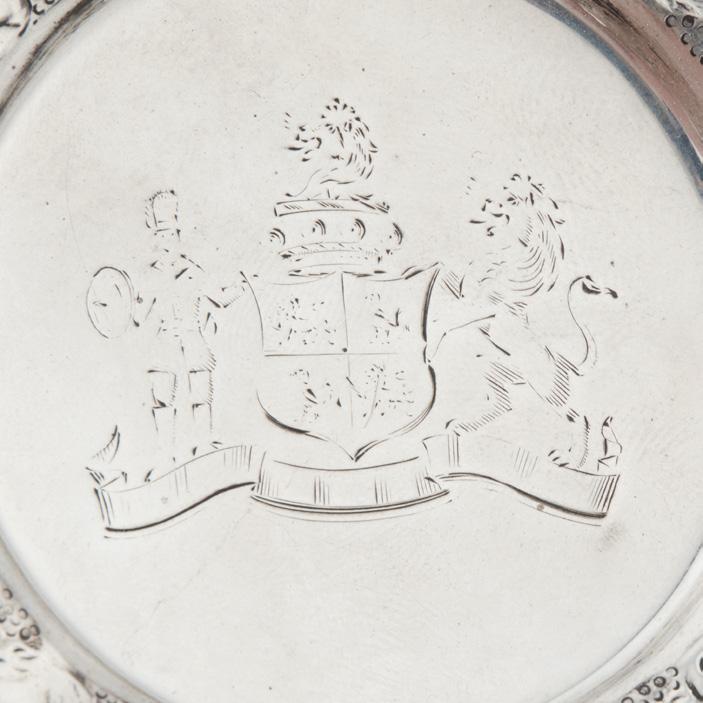
Note: This pair of 17th-century wooden tankard pair with a rare single example sold ‘Scottish Silver’ Lyon & Turnbull 16th August 2011 lot 103, were originally attributed to Thomas Cleghorne of Edinburgh. This attribution has since been disproven and it would appear these rare tankards have a more likely origin of the Swiss, German or Baltic States. What is interesting and a connection yet unproven is that all three have later armorials engraved with Scottish connections, perhaps suggesting these all were housed in Scotland at one time.


The original example sold had been considered that the (later) Royal arms engraved to the cover may have connections with the Royal visit of King George IV to Scotland. This visit created such a large part of Scotland becoming interested in its history and past once again. It was not uncommon to see relics of the past restored for use, display etc, whether it be tartan and kilts, swords or artworks. A tempting case has been muted that this tankard sold in 2011 may form one of the pair given to King George by Walter Scott for use at the ceremonial closing dinner for his state visit. This theory now perhaps extends to the pair under discussion also having been present and Lord Banff having been a likely guest at the Royal events. While this first sounds fanciful, it is noted that ‘the goblets which the King would drink were antique, two centuries old’, this timeline would certainly fit with the original manufacture and their adornment with the Royal arms could easily be explained. While this is only circumstantial evidence, it does add a colourful thought to the full history of the piece.
Literature: For a full account of the King’s visit and description of the closing banquet see ‘The Kings Jaunt, George IV in Scotland, 1822’ John Prebble
99
Alexander Seton, Chancellor of Scotland and later the first Earl of Dunfermline. Image © National Galleries of Scotland

Note: While this form of communion cup is well recorded for the Edinburgh and East Lothian area, these examples are of a particularly high quality, and rightly considered amongst the finest surviving examples. The overall shape and form, while restrained in design, show great skill and quality in manufacturing. The large knop to the stem, while at first looking slightly cumbersome, gives the piece real presence when in the hand. The only additional flourish of decoration, seen in the running border of foliage to the foot rim, is of exceptional quality and skill for the period and shows the fine degree of craftsmanship employed for the pieces overall. As noted by Burns, these cups originally formed part of a larger gift, of five cups (four without engraved decoration - such as this), and one with the addition of Alexander Seton’s armorial to the interior of the bowl. The example with the additional engraved armorial is now in the collection of Huntley House Museum, City of Edinburgh Museums. The other two cups sold originally in 1999, and were later offered within these rooms, Lyon & Turnbull, Scottish Silver, 16th August, lot 104, achieving £72,050.

Alexander Seton, 1st Earl of Dunfermline, Lord Fyvie and Lord Urquhart, Baron of Fyvie and Pinkie, Pluscarden etc (1555 - 1622), was, without doubt, a hugely influential figure in late 16th and early 17th-century law and society. He represented King James VI (I of England) at the highest level in Scotland and held the post of Lord President of the Court of Session from 1598 until 1604 when he was elevated to Lord Chancellor of Scotland until 1622. He had previously held positions in the Privy Council from 1585, Lord of Session (as Lord Urquhart) in 1586. His title changed once more in 1598 to Lord Fyvie and finally to 1st Earl of Dunfermline in 1605
Within these positions, he was heavily involved in the uniting of the two crowns of Scotland and England and forming what would become Great Britain, creating Scotland’s King James VI as King James I of Great Britain. Alexander, from an early age, was connected to the Royal Court of Scotland and was godson to Mary Queen of Scots. As a gift she bestowed upon him the lands of Pluscarden and the priory within and the title ‘Baron of Pluscarden’. The Seton family had long been supporters of the Scottish crown and the Roman Catholic faith so this gift followed in their tradition of protecting the Church, the Benedictine Monks and the Royal family.
From an early age, great hopes were placed on Alexander’s future and he was sent to Rome where he studied at the Jesuit College. His intention was to enter the priesthood, however, this would soon change and his course of education moved towards civil and canon law. During the short time spent in Rome, he had made a great impression and it was considered that he might have reached the position of Cardinal. However, this was not to be and with the overthrow of the Roman Catholic monarchy in Scotland his vision and pursuits changed rapidly; a decision he would surely not regret.
One of Alexander Seton’s most important, and what would become controversial, positions came when he was elected an ‘Octavian’ one of eight members of the nobility who in 1596 were chosen to manage the public affairs in Scotland on behalf of the King (now based in London). The Octavians introduced various controversial reforms and were viewed with
great concern by the clergy in Scotland, a point which did not go unnoticed with the Monarchy and allowances for the clergy were made.
At this time, however, the Court of Session was often considered to have a bias towards the Monarchy’s will and their judgments were often considered lacking, however under Seton it can be seen, in very colourful terms, to be a turning tide back to the judgment of the Court.
This is most obviously seen in the case of Robert Bruce, the leader of the Presbyterian Church in Scotland, whose views obviously stood apart from those of the Roman Catholic Monarchy. During this case, King James’s views and hopes for the judgment of the court were made clear that what he wanted, would later prove to be an unjust ruling to be made against Bruce. In response to his King, Alexander Seton shows the staunch nature of his belief in the law and Court and even while acting against King James his evenhanded approach surely could not be questioned.
‘This is a matter of law, in which we are sworn to do justice according to our conscience and the statutes of the realm. Your majesty may indeed command us to the contrary, in which case I and every honest man on this bench will either vote according to conscience or resign and not vote at all’.

After this firm and fair statement, the judges voted in favour of Robert Bruce and against the will of King James, with only two voting against the majority.
Alexander Seton’s influence on Scottish architecture is well-recorded and can still be seen. His main residence, Pinkie House, which would become a favourite of Prince Charles (later to become Charles I), was restored to a new glory from its virtual destruction after the battle of Pinkie in 1547 where the long gallery survives with a finely painted ceiling. He was also instrumental in the Setons of Meldrum rebuilding the ruin of Fyvie castle, which to this day remains a jewel in the crown of Scottish Baronial architecture. Huntley House Museum, Edinburgh, houses part of a ceiling bearing his monogram and heraldry and another similar ceiling has been recently recorded in a private home. These ceilings, when considered with the Seton portraits and communion cups, show the influence and consideration Seton bore, not just on the law in Scotland, but also the arts.
Alexander Seton continued with his staunch religious and lawful ways until his death in 1622. After his spectacular funeral procession which would become immortalized in the poem ‘Tears for the Death of the Earl of Dunfermline Chancellor of Scotland’, he was buried in the vault beneath the church of Dalgety which lay in his now vast and wide-reaching lands in Scotland, after a service performed by Archbishop Spottiswood. Perhaps not the most colourful testament of Alexander Seton, 1st Earl of Dunfermline, but no doubt a restrained contemporary one, gives us a final thought on this important man and character within Scotland goes to Advocate George Seton of Cariton;
‘An able lawyer, an impartial judge, a sagacious statesman, a consistent patriot, an accomplished scholar, a discerning patron of literature, a munificent builder, a skilful herald, and an ardent lover of archery and other manly sports’.
Other fees apply in addition to the hammer price: see the ‘Buyer’s Guide’ section on page 2
A JAMES VI (I OF ENGLAND) COMMUNION CUP
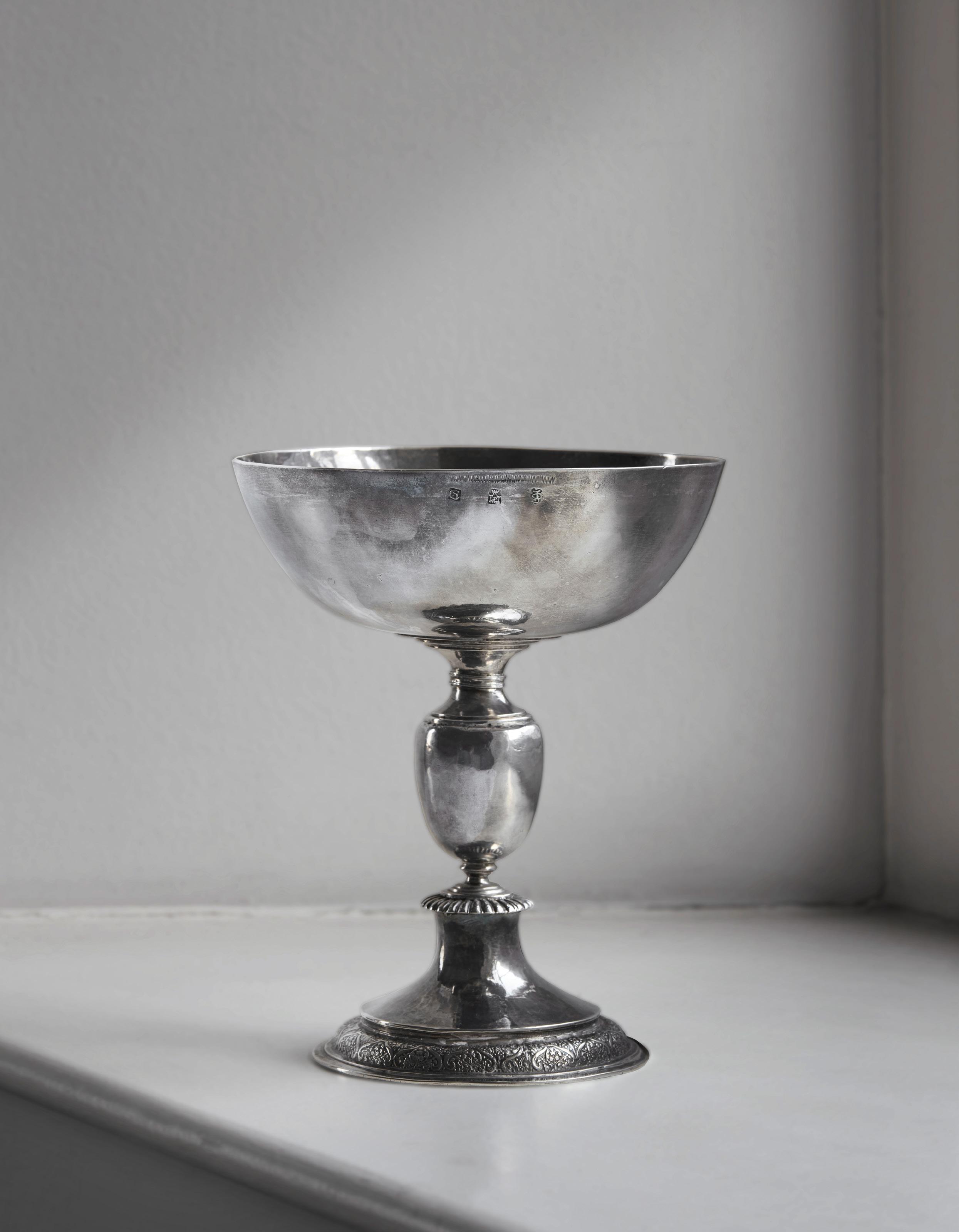
GEORGE CRAUIFORD,
EDINBURGH 1619-1621
Deacon’s mark James Denniestoun, with zig-zag assay scrape above marks, with additional assay scrapes to the interior of domed foot and base of foot rim, the wide shallow hemispherical bowls above baluster stem with large tapered knop, with stepped section with gadrooned collar bellow, on domed spreading circular foot above baluster foot decoration with fine borders of foliage, flower heads and slender S scroll formed panels, on stippled background 21.5cm, 19.5oz
Provenance: Gifted by Alexander Seton, Chancellor of Scotland and later the first Earl of Dunfermline in 1621 Inveresk Parish Church
Christie’s, London, South Kensington, ‘Scottish Silver’, 29th June 1999, illustrated Private Collection
Literature: ’Old Scottish Communion Plate’ Rev T Burns, pages 212 and 213, figure 20 £20,000-30,000
309


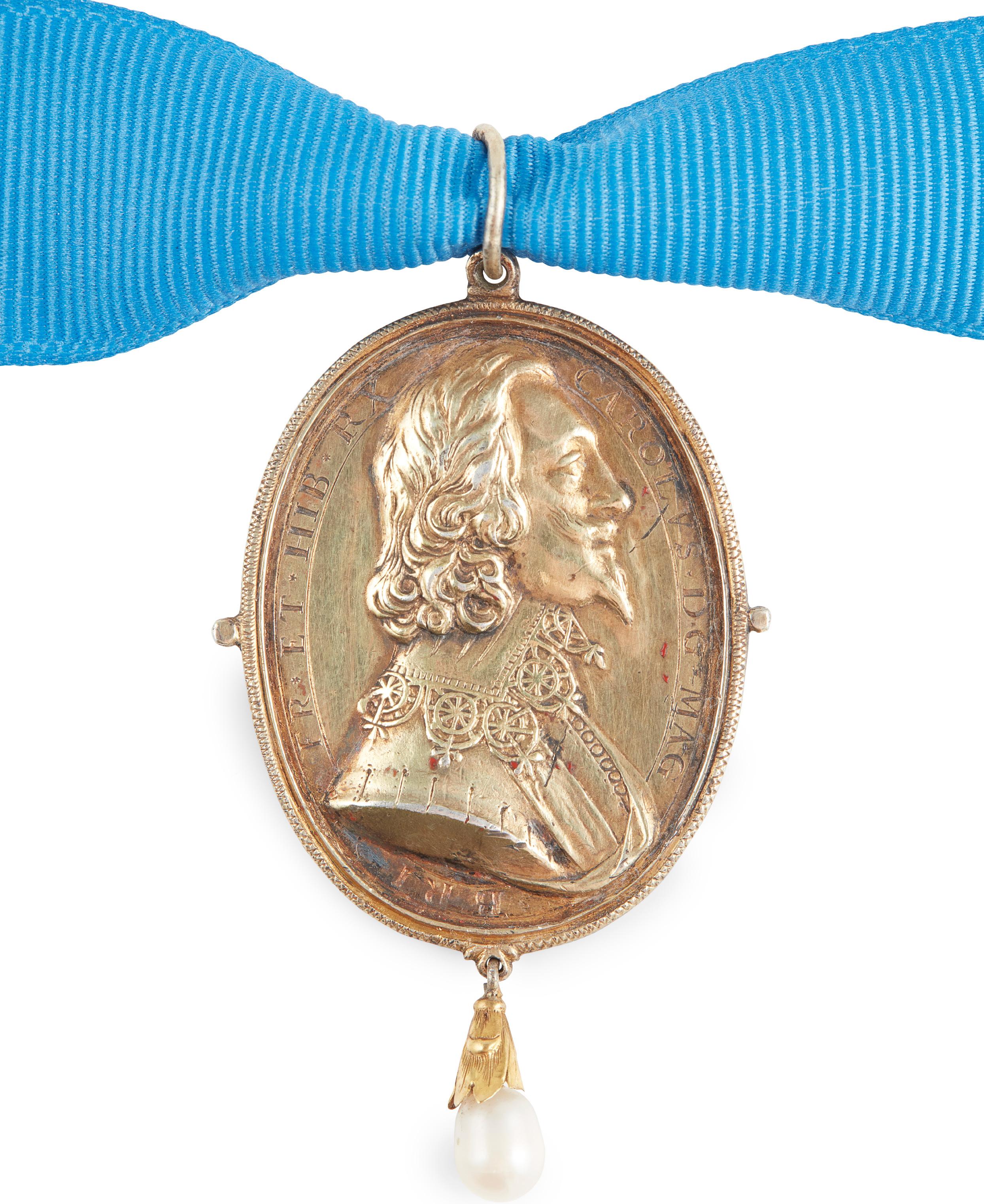
PROPERTY OF A GENTLEMAN – PREVIOUSLY FROM THE COLLECTION OF SIR COLIN MACRAE (1869-1952) OF FEORLINN AND LADY MARGARET CRICHTON STUART (1875-1964)
Lady Margaret Crichton-Stuart was the daughter of John Patrick-Stuart, the 3rd Marquess of Bute, and her daughter Gwendolin was named after her own mother. It is through Gwendolin’s daughter, Daphne Battine, that the collection descends to the current vendor.
Lady Margaret Crichton-Stuart married Colin MacRae of Feoirlinn in 1909. A Colonel in the British Army, he was appointed Commander of the British Empire (C.B.E.), and held the office of Deputy Lieutenant (D.L.) as well as the office of Justice of the Peace (J.P.). MacRae was a member of the prestigious Royal Company of Archers. In 1935 he received his knighthood and served with distinction throughout his Army career, the National Portrait Gallery houses his portraits, NPG x152976, showcasing his rank in full dress uniform.
MacRae was a huge enthusiast of pipe music and in particular Piobaireachd. As a patron of this art it encouraged his Highland heritage - both he and Lady Margaret were well-regarded supporters of the Highlands. Their links to the highland heritage seems to have driven their appetite for collecting such artefacts. An article in the Scotsman of August 20th 1945 shows that MacRae accepted the invitation to the bicentenary of the ‘Forty Five at Glenfinnan. Perhaps this allegiance to the Highland cause shaped their collecting of Jacobite works of Art, which can be seen particularly in their Jacobite quaich. This quaich is purported to be a gift to Prince Charles Edward Stuart’s servant, Ronald MacDonald, after the battle at Culloden, and a pocketbook relating to the executed Lord Lovat perhaps shows sympathies to well-known Jacobite supporters. The collection also includes a group of commemorative medallions, including two rare pendants showing support for the Stuart King Charles.
Keen to collect items of Scottish importance after the death of Sir Colin, in 1955 parts of the collection would ultimately be on long-term loan to the National Museum of Antiquities of Scotland, continuing some time into the 1980s.
103
Please click here to view Sir Colin MacRae’s portrait at the National Portrait Gallery
Note: Struck in both gold and silver there are various die pairings recorded for its production. Indeed two distinct versions of the obverse are recorded, this being the slightly simpler version. This number of variations suggests that the medallion would have been widely distributed at the birth of Prince Charles (later King Charles II) throughout the kingdoms.
310

A SILVER BIRTH OF PRINCE CHARLES MEDALLION
ENGRAVER UNKNOWN, STRUCK 1630
obverse, four shaped shields with England and France, Scotland, France, and Ireland Royal arms within, the motto HACTENVS. ANGLORVM. NVLLI around, the reverse with motto HONOR’, PRIN’, MAG’, BRIT, FRA’, ET, HIB’, NAT, 29, MAI’, ANN’ 1630, within a decorative tablet 30mm diameter, 4.5g


Literature: Eimer, C., ‘British Commemorative Medals, and their values’, item 115 £250-400
311
A FINE MID-17TH CENTURY SILVER GILT PEARL SET ROYALIST BADGE
THOMAS RAWLINS (C.1620 – 1670), STRUCK LONDON C1649 – 1660 apparently unmarked, obverse bust of King Charles I facing, wearing a lace collar with the motto CAROLVS. D.G. MAG. BRI. FR. ET. HIB. REX, reverse with Royal arms crowned within garter, the whole within a simple reeded frame with cup mounted freshwater pearl suspended below 64mm overall height (including bale), 9.3g
Literature: ‘British Commemorative Medals, and their values’, C Eimer, item 167 (variant)
Note: It is believed there are around 40 different versions of Royalist / Stuart supporters’ badges such as this example were created from the overthrow of Charles I in 1649, and latterly beheaded, to the restoration of the monarchy in 1660. Worn by supporters of the Stuart royal family they would have been hidden under clothing and a highly personal accessory. They were presumably only shown to other supporters or to back up a person’s claim to be a supporter. This example is a particularly fine survival, not only being in silver gilt, rarely seen, but with the pearl suspended from the base. This pearl has romantically been considered to represent the tears shed for the deposed and executed King. It may also represent the pearl earring Charles wore on the gallows before his beheading (now within Portland Collection Museum) and can so be seen in the Van Dyke portrait ‘Charles I in Three Positions’.

£3,000-5,000

104
312
A GILT COPPER CHARLES II RESTORATION MEDALLION
THOMAS RAWLINS (C.1620 – 1670), STRUCK LONDON 1660
obverse armoured and draped bust of King Charles II facing left with motto CAROLVS. II. D:G, MAGNAE.
BRIT. FRA. HIB. REX, reverse the three Royal crowns within an oak tree with the sun shining through clouds above and motto
TANDEM REVIRESCET
35mm diameter, 11.1g
Literature: ‘British Commemorative Medals, and their values’, C Eimer, item 215b
Note: Thomas Rawlins was an accomplished engraver working not only on coins and medallions such as this but gemstones as well. He is recorded as engraver to the Royal Mint therefore he is an obvious choice for a medallion celebrating the restoration of the monarchy.


£300-400
313
AN ENGRAVED JACOBITE TOKEN

a James II 1688 half-crown with engraved rose and bud to obverse 32mm diameter, 14g


Reference:
Host coin ‘Coins of England & the United Kingdom’ Spink, S.3408
Note: The engraving of currency issue coins to commemorate important events, and create love tokens or good luck symbols is well recorded. The use of a host coin which has a meaning/ importance is also often very apparent, a date of anniversary or foreign coin commemorating a journey or battle etc.
A 1688 James II crown is an obvious choice for a Jacobite supporter. This coin, the largest silver denomination of the period, with its large bust of King James II listing all his divinely granted royal titles and kingdoms, would have been very obvious. And of course, in the year that he and the Stuart line were deposed would have had extra poignancy. The engraved rose and bud show close comparisons to the engraved glasses that become synonymous with the Jacobite cause, these motifs shown, therefore are particularly poignant as depicted with the last Stuart King deposed in 1688, they would later promote the right to the Stuart monarchy.
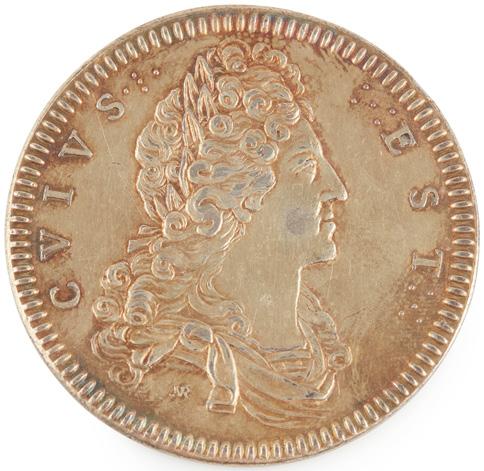
£100-200
314 A SILVER GILT PEACE NEGOTIATIONS AT GERTRUYDENBURG MEDALLION
NORBERT ROTTIER (CIRCA 1665 –1727), STRUCK 1710
obverse bust of Prince James facing right in armour with legend CVIVS EST, the revere with map of Great Britain and Ireland with ships around and motto
REDDITE in banner above
38mm diameter, 16.8g
Literature: Woolf, N., ‘The Medallic Record of the Jacobite Movement’, item 23:1a Eimer, C., ‘British Commemorative Medals, and their values’, item 449a
Note: This medallion, struck in 1710, shows the plans and hopes held by the Stuart exiled court. This medallion 5 years before the eventual invasion of 1715 was no doubt a key propaganda message. It is believed that this is the medallion from the contemporary account given by Abel Boyer which states ‘About this time, a medal was dispersed in the Netherland, the Chevalier de St. George’s Friends with the Prince’s head on the right side and the words CUIUS EST; and on the Reverse with Kingdoms of Great Britain and Ireland with this motto REDDITE. The medal was undoubtedly struck at this juncture, upon the hopes given by the Jacobites in England to their correspondents in France that the British Court and Nation were ready to invite the Pretender………. But whatever ground there was for such expectation, things were not yet ripe enough for the Pretenders Friends to throw off the Mask’ £300-500
315 A BRONZE CHARLES I MEDALLION
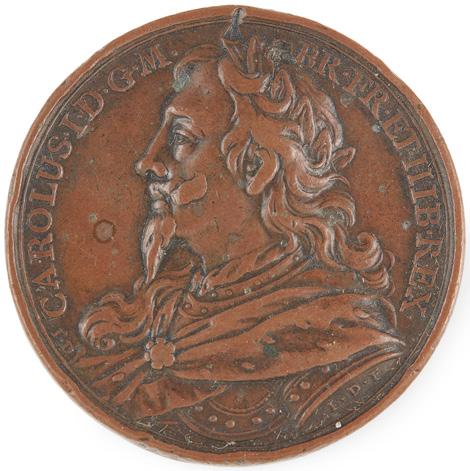
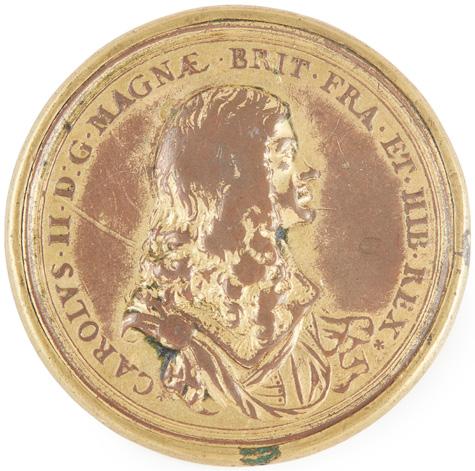
JAMES DASSIER (1676 – 1763), STRUCK 1731
obverse armoured bust of Charles I facing left with the motto CAROLUS. I. D.G. M. BR. FR. ET. HIB. REX, reverse with Britannia seated above a funeral monument with motto bellow EX.NAT. 13.

NOV. 1600 COR. 2.
FEB. 1626. M. 30.
IANV. 1649
41mm diameter, 36.4g
Literature: ‘British Commemorative Medals, and their values’, C Eimer, item 164 and 526
Note: Originally from the thirty-four medallion set produced by James Dassier ‘Kings & Queens of England’. This set illustrates the monarchs from William I to the then-current monarch George II. This set was available in bronze and silver at a cost of fifteen or six guineas and is occasionally found in original wooden trays.
£300-500
105 Other fees apply in addition to the hammer price: see the ‘Buyer’s Guide’ section on page 2
316

A FINE SILVER CHARLES I SUPPORTER’S MEDALLION

UNMARKED
the pendant formed as a finely chased half-length bust of King Charles I in court dress and wig, reverse blank, with simple suspension ring and later blue silk ribbon, with National Museums of Antiquities of Scotland label L.1955.64
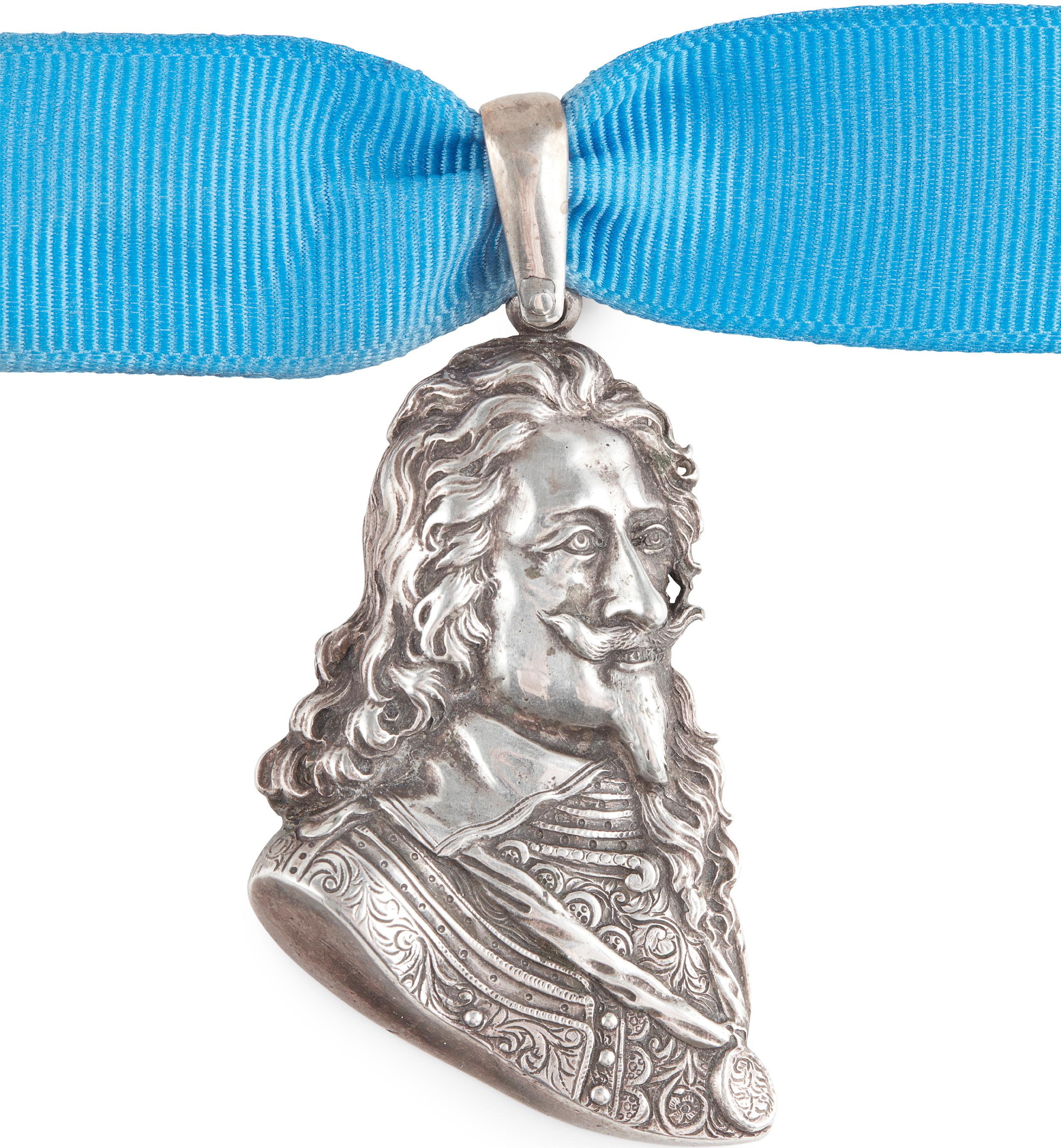
Pendant: 65mm (including bale), weight: 45.5g £2,000-3,000
Note: This Charles I supporters’ badge is of particularly fine quality. The majority of such supporters’ medallions are taken from a basic oval form with a portrait of Charles and Maria or with Royal arms. The three-dimensional nature, fine chasing and fluidity of the robes and hair show great skill in the production. the original owner of this piece was probably a high-status Stuart supporter and wanted to show this to the highest degree possible. Similarly, but less finely decorated, examples of this form are seen mounted to the lid of tortoiseshell snuff boxes. There is still debate around these and the standard types
of supporters’ medallions and if they were official issues by the Royalist Court/cause or were purely available for supporters to purchase. If any were gifted by the Stuarts to supporters it would seem likely it would be examples of this quality.
For a very similar example purchased by Queen Mary in 1935 see
The Royal Collection Trust RCIN 43830.
317
A BRONZE PRINCE CHARLES AND PRINCE HENRY, LEGITIMACY OF THE JACOBITE SUCCESSION MEDALLION
OTTONE HAMERANI (1694 – 1764), STRUCK ROME 1731
obverse, the right-facing bust of Prince Charles with star in field, motto MICATE INTER OMNES, reverse the left-facing bust of Prince Henry with motto ALTER. AS. ILLO, the edge with raised motto DIE. XXXI. DECEMBR. MDCCXX. EXTVLIT. OS. SACRVM. COELO
42mm diameter, 34g
Literature: ‘The Medallic Record of the Jacobite Movement’, N Woolf, item 43:1
‘British Commemorative Medals, and their values’, C Eimer, item 521
Note: Two main types of this classic ‘Two Princes’ medallion exist: those without edge lettering, and the rarer type, such as this, with the additional motto to the edge. Struck in 1731 to mark Prince Charles’ 11th birthday it shows an almost 7-year-old Prince Henry on the reverse. Unusually neither of the princes is mentioned by name, perhaps suggesting hope of a widespread dispersal of this medallion not just on the Continent but also on British soil. It is recorded one of these was sent by King James to Bishop Atterbury and is mentioned in contemporary correspondence. Showing not only the close relationship James and Clementina had in the production of these medallions but the value they placed in them being seen in high circles of society, further making the claim of their legitimacy and now a claim with heirs.
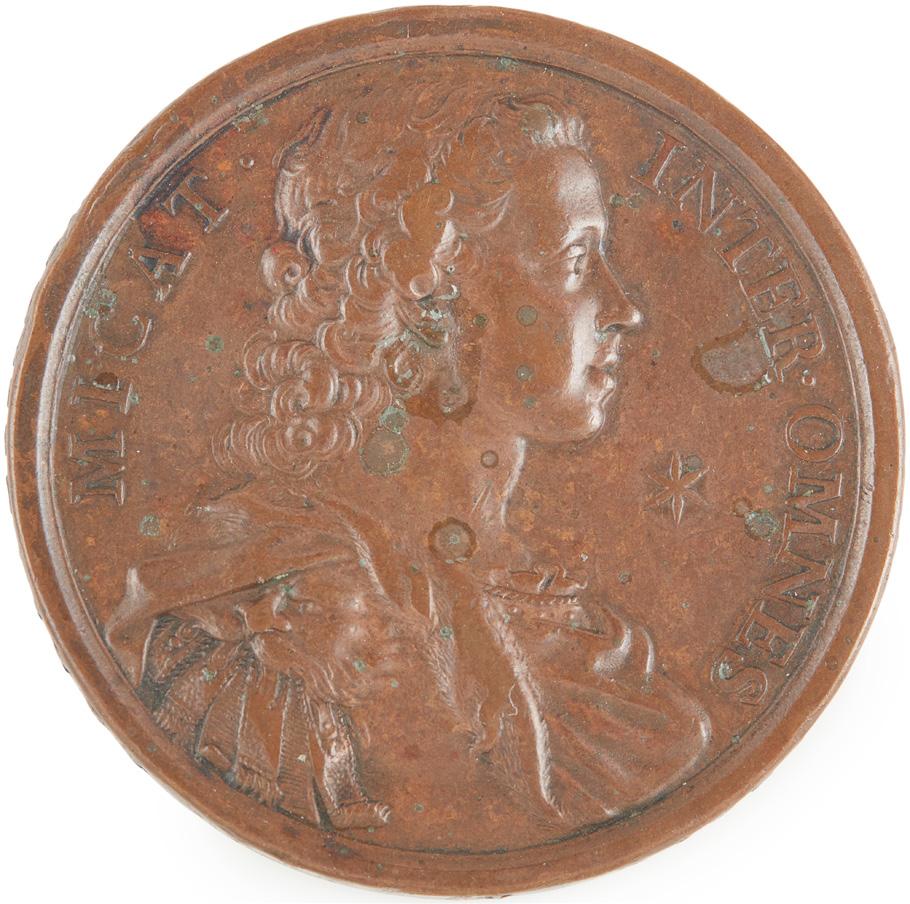

£150-250
318
A SILVER QUEEN MARY MEMORIAL MEDALLION
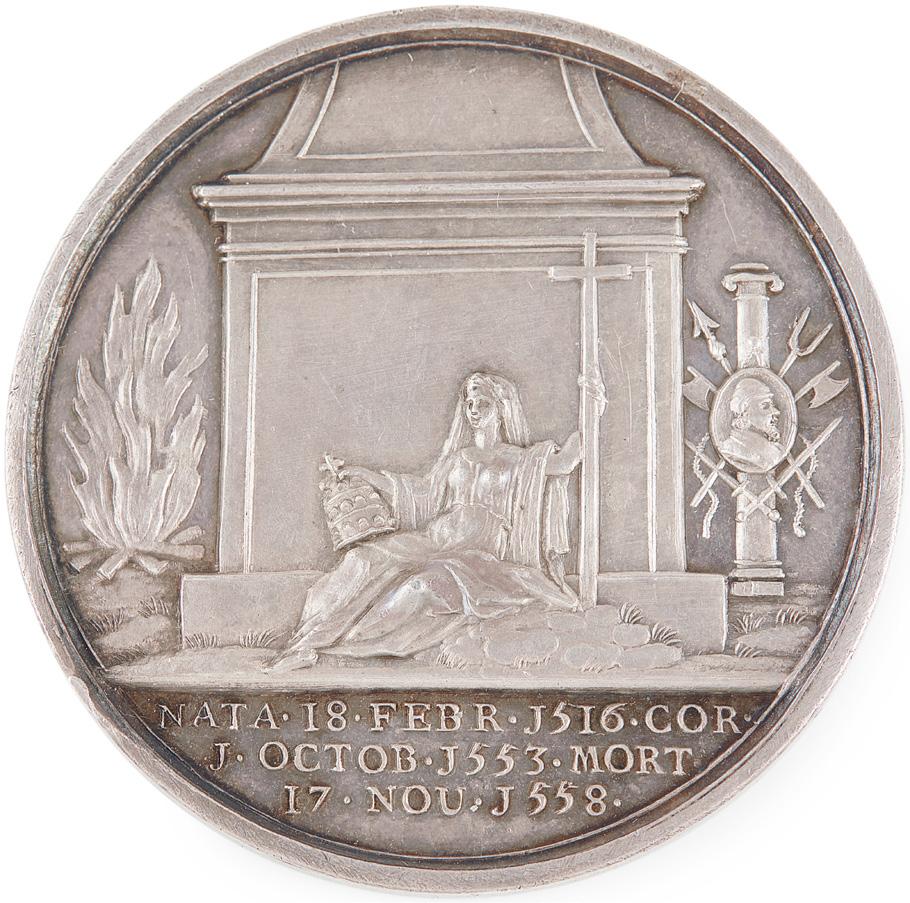
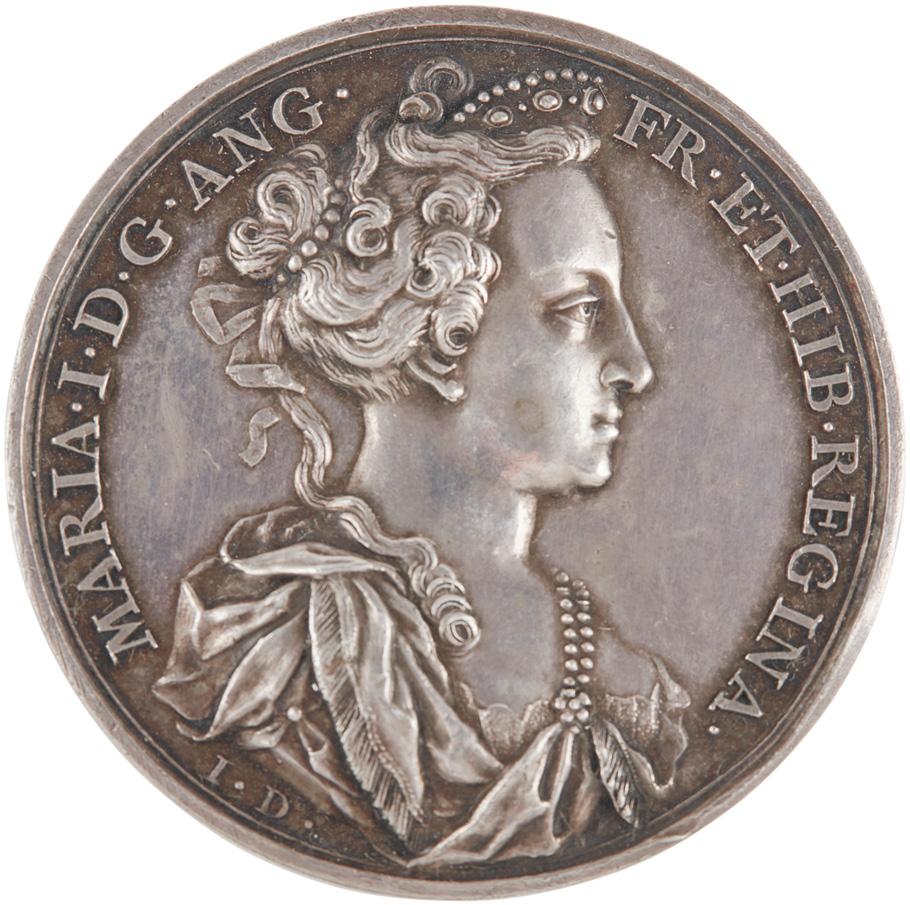
JAMES DASSIER (1676 – 1763), STRUCK 1731
obverse three-quarter bust of Queen Mary facing right with the motto MARIA. I. D.G. ANG. FR. ET. HIB. REGINA, reverse with the figure of Religion seated before a monument to the right, a column, mounted with a medallion of the Pope, motto NATA. 18. FEBR. 1516. COR. 1 OCTOB. 1553. MORT 17. NOV. 1558
41mm diameter, 32.1g
Literature: ‘British Commemorative Medals, and their values’, C Eimer, item 38 and 526
Note: Originally from the thirty-four medallion set produced by James Dassier ‘Kings & Queens of England’. This set illustrates the monarchs from William I to, the then, current monarch George II. This set was available in bronze and silver at a cost of fifteen or six guineas and is occasionally found in original wooden trays.
£300-500
107 Other fees apply in addition to the hammer price: see the ‘Buyer’s Guide’ section on page 2
319
A SILVER MARRIAGE OF CHARLES III MEDALLION
FERDINANDO HAMERANI (1730 – 1789), STRUCK 1772
obverse bust of Charles III facing left with moot CAROLVS.III.N.1720.M.B.F.ET.H.REX.1766, reverse bust of Louise of Stolberg facing left with motto LVDOVICA.M.B.F.ET.H.REGINA.1772
32mm diameter, 13.5g
Literature: ‘The Medallic Record of the Jacobite Movement’, N Woolf, item 71:1
‘British Commemorative Medals, and their values’, C Eimer, item 743
Note: The marriage of Charles Edward – now self-titled Charles III after his father’s death in 1766 – was an important moment in the Jacobite cause. A marriage would surely mean an heir to keep the now ageing cause alive.
Princess Louise of Stolberg was chosen from the minor courts of Europe. She was nineteen when they married and Charles, now 50, was keen to have a Queen even if only in exile. A proxy marriage took place in Paris on 28th March 1772. Louise’s mother insisted on the greatest secrecy as the Empress Maria Theresa who they were under the care and pension of, was considered easily swayed by the Hanoverian King George.
It was not until 17th April that the bride and groom would meet in person. They immediately headed to Rome to meet Charles’ brother where a state entry to the city had been arranged and he would give Louise a fine gold and diamond snuff box with his portrait and 40,000 crowns.
The production of these medallions is accounted for on the day Charles and Louise met and Hamerani is recorded supplying 214 silver medals. By 1774 he is commissioned to produce 3030 further in silver and 212 in copper. This shows the popularity of the medal and therefore by association the popularity the Jacobite cause still had.
Ferdinando Hamerani was an obvious choice for Charles to commission these medallions from as his hand is seen producing the Charles III touch pieces produced earlier in Charles ‘reign’ as King.
£600-800
320
AN 18TH CENTURY ENGRAVED SILVER ‘PASS’
unmarked, the circular disc with engraved stylised leaf border, engraved in script ‘The Temple of Peace – A present from The Earl of Bute to his sister Lady Mary Menzies 1767’, the rear plain 5.8cm diameter

£250-400
321
A SILVER PRINCE CHARLES AND PRINCE HENRY, LEGITIMACY OF THE JACOBITE SUCCESSION MEDALLION OTTONE HAMERANI (1694 – 1764), STRUCK ROME 1731 obverse, the right-facing bust of Prince Charles with star in field, motto MICATE INTER OMNES, reverse the left-facing bust of Prince Henry with motto ALTER. AS. ILLO, the edge with raised motto DIE. XXXI. DECEMBR. MDCCXX. EXTVLIT. OS. SACRVM. COELO 42mm diameter, 37.7g

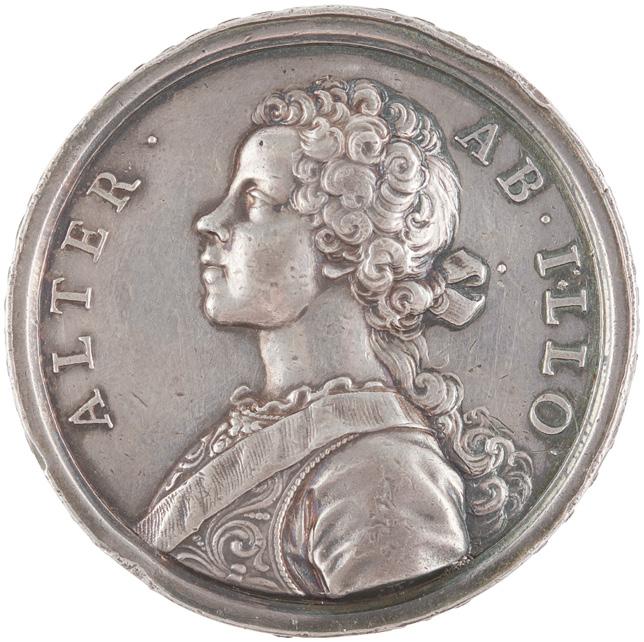

Literature: ‘The Medallic Record of the Jacobite Movement’, N Woolf, item 43:1
‘British Commemorative Medals, and their values’, C Eimer, item 521 Note: Two main types of this classic ‘Two Princes’ medallion exist: those without edge lettering, and the rarer type, such as this, with the additional motto to the edge. Struck in 1731 to mark Prince Charles 11th birthday it shows an almost 7-year-old Prince Henry on the reverse. Unusually neither of the princes is mentioned by name, perhaps suggesting hope of a widespread dispersal of this medallion not just on the Continent but also on British soil.
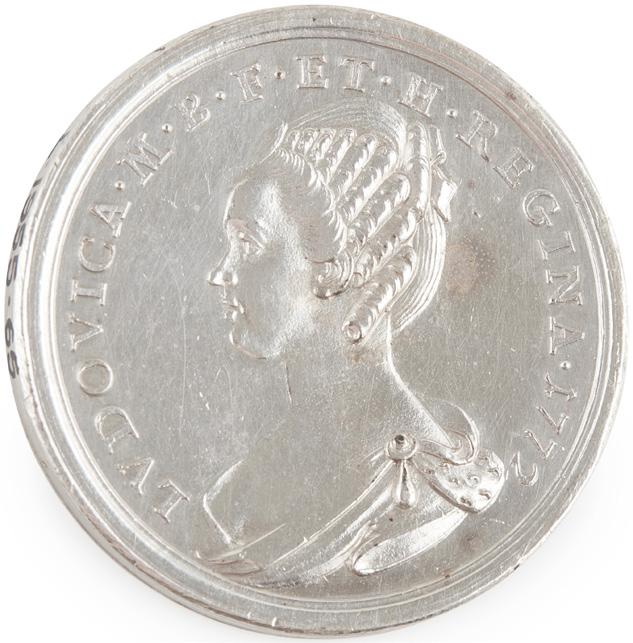
It is recorded one of these was sent by King James to Bishop Atterbury and is mentioned in contemporary correspondence. Showing not only the close relationship James and Clementina had in the production of these medallions but the value they placed in them being seen in high circles of society, further making the claim of their legitimacy and now a claim with heirs.
£200-300
108 Other fees apply in addition to the hammer price: see the ‘Buyer’s Guide’ section on page 2
AN INTERESTING GROUP OF 18TH CENTURY AND LATER TARTAN FRAGMENTS
comprising a fragment of early 19th-century wool tartan sleeve, Glenorchy, Cumming of MacIntyre tartan; a section of ‘New Bruce’ early 19th century tartan, by Wilson’s of Bannockburn, circa 1820-1840; a mid-19th century tartan fragment of a variant of Kennedy tartan; an early 19th century section of silk tartan ribbon, of a Mackenzie variant with National Museum of Antiquities of Scotland labels L.1955.9, 10, 11 (2)


Note: This so-called ‘New Bruce’ pattern would also latterly be called ‘Drummond’ or ‘Grant’ in the wide-ranging copies of historic tartan copied by Wilson’s of Bannockburn. This range was fuelled by the growing interest in Scottish heritage from the writings of Sir Walter Scott and culminating in the visit of King George IV to Scotland.

Regarding the silk ribbon, the pattern of tartan appears to be unrecorded in its current colours. However, it is essentially a Mackenzie pattern with red changed to a light blue. By family repute it has previously been thought to have been a section of McLeod tartan and been part of bed hangings from Raasay House where Prince Charles Edward slept on this escape to France after the defeat at Culloden.
Accompanied with a hand-written note stating that the ‘McGregor, woven and spun and dyed by a ‘Miss MacGregor, MacKellar’s great great grand aunt’
£500-800
323
A PORTION OF DRESS FABRIC
POSSIBLY 18TH CENTURY
pale blue ground with a pattern of tied sheaves of corn, with National Museum of Antiquities of Scotland label L.1955.7, with a note detailing provenance relating to Lady Lovat
26cm x 22.5cm
Note: The note mounted on a card stating cloth part of dress worn by Lady Lovat...... given by Lady Lovat to a kinswoman Mary Muir of Lanark, she gifted it to *** who adds it to Mr James Noble’s Collection, September 1864
£200-300
324
A PAIR OF LATE VICTORIAN TARTAN HOSE
of Ross tartan, full-length hose, with steel eyelets and leather lined edges, inner flap, with National Museum of Antiquities museum label L.1955-15
63cm long
Note: These fine tartan hose appear to be late Victorian and part of the renewed interest in all things Scottish and the ‘formalisation’ of tartan patterns and wear. Due to the family provenance within this collection, it is possible that they belonged to William Skeoch Cumming who produced many paintings of Scottish military life and in his latter years designed four monumental tapestries for which some of his props still survive
£500-700
109
322
325
A COLLECTION OF 18TH AND 19TH CENTURY CHILDREN’S CLOTHING comprising a child’s cap with later lacework detail and a jabot, each with similar lace detail; a small pair of mittens with lace detail; and another cap, possibly late 18th century with a drawn thread medallion at the crown (4)

£500-700
326
A LACE BORDER OF SILVER AND SILVER-GILT THREAD


POSSIBLY 19TH CENTURY
the rectangular portion showing scrolling flowers with good open work detail in a 17th century style, with National Museums of Antiquities of Scotland label L.1955.12 103cm long, 14cm wide £800-1,200

327
A VELVET FRAGMENT
POSSIBLY 18TH CENTURY
of rectangular form, with National Museums of Antiquaries of Scotland label L.1955.1; previously believed to be part of the border from Charles I coat sleeve, the faded velvet with delicate embroidered floral and stylised leaf design, mounted on card; together with a handwritten note; “Piece of Charles the 1st coat sleeve 1625” 34.5cm x 19cm

£300-500
328
A VELVET FRAGMENT
POSSIBLY 18TH CENTURY
plain with unfinished edges, and a National Museum of Antiquities museum label L.1955.8; together with a letter saying part of cloth cut from clothing of Prince Charlie 1746, on headed note paper from the Society of Antiquaries of Scotland to Miss Juliet MacDonald dated 20.6.(18)79, and her visiting card with a handwritten note (2)
13.5cm x 22cm
£250-400
110 Other fees apply in addition to the hammer price: see the ‘Buyer’s Guide’ section on page 2
A FINE EARLY 18TH CENTURY GILT TOOLED LEATHER AND SILVER MOUNTED POCKET BOOK

RELATING TO SIMON FRASER, LORD LOVAT
the gilt tooled leather with panels of intricate floral scrolls, tulips emanating from vases and flower head borders, the hinged cover secured by a two-piece engraved silver clasp with flower head and twin buds, the interior with vellum and paper pages, one titled page inscribed ‘Memd. 30th Novem: 1738, took the oaths of Allegiance & Adjuration at the Court House on Tower Hill’, with National Museum of Antiquities of Scotland label L.1955.39, together with various papers
Note: The inscribed note within the pages of this pocketbook is intriguing and appears to show the varied allegiances Lovat was so famous for. The ‘Allegiance and Adjuration’ mentioned in 1738 is likely Lord Lovat confirming his undivided support for the newly born Prince George William Frederick, eldest son of Frederick Prince of Wales, who would later be crowned King George III in 1760 who was born in June of this year.
Simon Fraser, 11th Lord Lovat (1667/ 8 - 1747) came from a line of Jacobites which included his father, Thomas, who had played a powerful role in the Jacobite rising under John Graham of Claverhouse, Viscount Dundee, in 1689, for which he suffered imprisonment.
Simon had a rather colourful and, in some cases, unseemly early life, trying to bribe family members to change inheritance and lands to his benefit. Trying to force his cousin to marry him when his bribery failed, however marrying her protector under duress in her stead, only to call the marriage a sham years later when its value was not apparent – having married two other women while not divorced from her.
Trouble followed him most of his early life and it took a pardon from King William, only after he had been found guilty of High Treason. However, this plea to King William was for personal gain only and he was still harbouring his Jacobite feelings. Shortly after, he made two trips to the Jacobite Court in St Germaine. To further enhance his relationship in the Stuart court, and after King William’s death, he converted to Catholicism and met with Mary of Modena and the titular James VIII and III. He aligned himself with the Duke of Perth’s factions and was promoting an uprising from as early as 1703.
By 1715 he had bought his pardon and returned to London. By this time, the Duke of Argyll had convinced him to support King George I. He headed north towards Inverness and took and held the city on behalf of King George. His fortunes now changing for the better, he appeared a Hanoverian. However, the disbandment of his forces and the city handed to others meant his income fell and his rise was short-lived. This likely helped push him away from the Hanoverians and before long back to the Jacobites.
This change of allegiances was as blatant as it was regular, and it appears it was only his highly regarded charm that kept him out of trouble, balancing the possibilities of uprising and establishment. This renowned charm got him not only into, but more often out of, some rather tricky situations between King George and King James on both sides.
By 1745 it was clear that his Whig allegiances had not given him the power, land, and full title he had expected, and this seems to have sent him back, for a final time, to the Stuart cause. As early as 1690 King James had promised him reward for his support as Lieutenant-General of
friends.
After the defeat of Culloden, Prince Charles fled and sought shelter from Lovat, who urged him on and promised men for another battle, presumably seeing his hopes, land, fortune, and life slipping from his grasp. Charles declined and left, Lovat fled his home too, and en route seeing his previous castles burned in retribution by William, Duke of Cumberland. In his escape, he is recorded as having a close shave with Hanoverian troops sailing up Loch Morar and he hid in a hollow tree to evade capture. However, the tree could not hide him, and he was spotted and taken prisoner to Fort William.
Transported to London, he was interviewed and famously sketched by William Hogarth, whose engraving became in high demand. Lovat at this time was described by the Gentleman’s Magazine thus:
the Highlands; furthermore, the Pretender might be willing to elevate him to a Dukedom. In 1739 Lovat was the first to join the association formed to invite the Pretender to land in Scotland; his allegiance was secured by the promise of a patent of a dukedom.
Although a player from the outset in the return of Prince Charles Edward Stuart, Lovat was not at Glenfinnan in August, in part, due to feigned sickness possibly in part as the promised patent of Dukedom had not reached him. This countered with the non-arrival of the French troops, part of the original party’s plans perhaps caused him some points of thought.
Even throughout the campaigns, once he had pledged the Lovat Fraser’s and himself to the cause, he was keeping all avenues open and wrote regularly to the Whig hierarchy, still hoping that if they could not turn him, they could at least secure his neutrality.
By 1746 Lovat was in his 80’s and hardly a player on the battlefield. This fell to his son and heir who was threatened by disinheritance not to take part. He indeed was captured and imprisoned in Inverness, only to escape with help from local
“Lord Lovat makes an odd figure, being generally more loaded with clothes, than a Dutchman with his ten pair of breeches; he is tall, walks very upright considering his great age, and is tolerably well shaped; he has a large mouth and a short nose, with eyes very much contracted and down-looking, a very small forehead, almost all covered with a large periwig; this gives him a grim aspect, but upon addressing anyone he puts on a smiling countenance”. He was tried for High Treason before the House of Lords and gave his own defence, much evidence was given and debated, was legally questionable. At the end of his case, in inimitable fashion and charm, he replied: “Nothing except to thank your lordship for your goodness to me. God bless you all, and I wish you an eternal farewell. We shall not meet again in the same place; I am sure of that”.
While public executions always attracted crowds, that of Simon Lord Lovat attracted a huge crowd by any measure. Perhaps the larger-thanlife character, his life story and advanced age convinced more to turn out for this. Due to this popularity, the crowds were huge and too much for the erected scaffolding platforms to hold, resulting in their destruction under the weight of the crowd, killing 20 spectators.
True to his character, Lovat found this implausibly funny and was seen to laugh heartily and loud all the way to the executioner’s block. It is reputed that this is the origin of the saying to ‘laugh your head off’ Lovat apparently laughing till his final moments. This seems a little extension of the truth as his final words are recorded, taken from Horace ‘Dulce et decorum patria mori’
Lovat was beheaded and latterly buried at Tower Hill on April 9th, 1747.
£2,000-3,000
111 329
330
AN 18TH CENTURY TURNED WOODEN QUAICH WITH SILVER APPLIED INSCRIPTION

the hemispherical oak body with four small lugs and flattened girdle, the underside with an applied engraved silver plaque, inscribed “Prince Chas Edw Stuart gave this quaich to his servant Ronald MacDonald after the battle of Culloden 1746” within a rope-twist border, with National Museum of Antiquities of Scotland label L.1955.35
3.5cm high, diameter across bowl: 6.2cm
£4,000-6,000

112 Other fees apply in addition to the hammer price: see the ‘Buyer’s Guide’ section on page 2

331
A ‘STUART CRYSTAL’ GOLD AND HAIR MOUNTED MEMORIAL RING
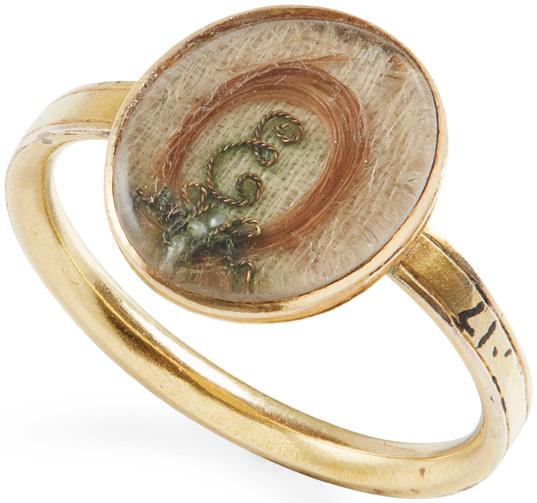
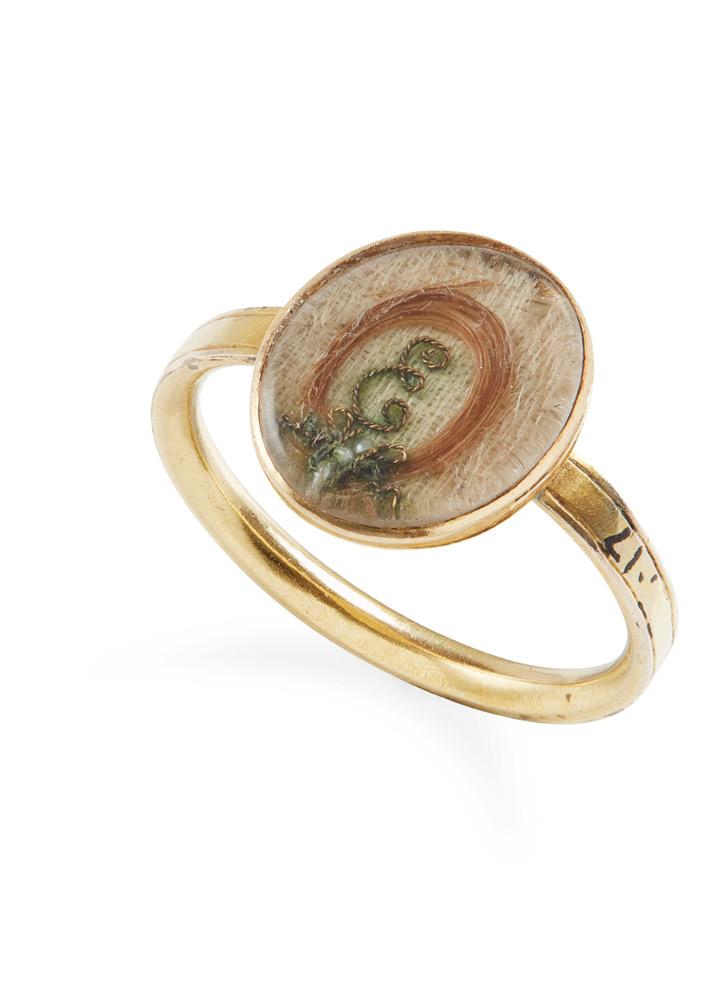
commemorating the death of Princess Elizabeth Stuart, the oval glazed panel enclosing a locket of hair with the letter E in script on a woven silk ground, plain rub over setting, the rear engraved ‘Princess Elizth Ob Sept 8 1650, the shank within a slight threaded edge; together with a photograph (early 20th century) of the tomb in the Isle of Wight of Princess Elizabeth and envelope from the National Museum of Antiquities of Scotland
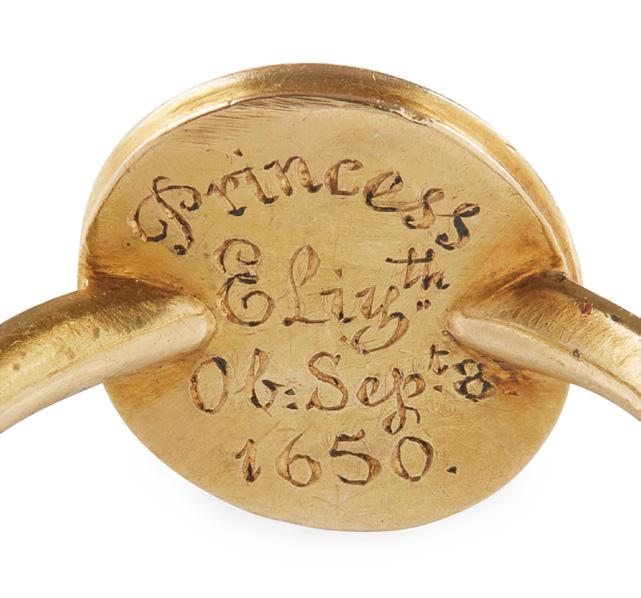
L.1955.17 (2)
Ring size: N1/2
Note: Elizabeth Stuart (28 December 1635 – 8 September 1650) was the second daughter of Charles I, King of England, Scotland and Ireland, and his wife, Henrietta Maria of France.
From age six until her death at age 15, Elizabeth was a prisoner of the English Parliament during the English Civil War. Her emotional written account of her final meeting with her father on the eve of his execution and his final words to his children have been published in numerous histories about the Civil War and Charles I.

£4,000-6,000
332
A MID TO LATE 18TH CENTURY SILVER LUCKENBOOTH BROOCH MAKERS MARK INDISTINCT A*
of traditional ‘Inverness’ style the open heart form surmounted with spectacle crown and with engraved linear detail, the reverse engraved with contemporary initials ‘WR IMR’, with integral swing pin 8.5cm high, 14.8g
Note: Although the maker’s mark struck to this piece is poorly struck it seems safe to say that this brooch is provincially made and most likely in the Inverness / Highland region. The study of marked examples that follow this traditional large open form with ’spectacle’ crown surmount predominantly come from Inverness-based or trained makers.
Although the Luckenbooths that these brooches take their name from are closely linked to Edinburgh’s Royal Mile, it is surprising how rare Edinburghmarked examples are.
For furtherreading and new light on the geographic styles of Luckenbooth brooch see‘Scottish Heart Brooches a Re-evalaution of the Lucknbooth’ L A McGill,Proceedings of the Society of Antiquaries of Scotland Vol 151 2022, page 223-234.

£250-400
333
the curved horn handle engraved with the Crest and motto of MacRae of Feorlinn, and initials CMR, with the Regimental badge of the Blackwatch, plain white metal tip
£800-1,200

114
A CEREMONIAL WALKING STICK/CROMACH HANDLE
334
JAMES FRANCIS EDWARD STUART (1688-1766)
CONTEMPORARY MANUSCRIPT COPY OF HIS DECLARATION GIVEN AT ROME AS JAMES VIII, 23 DECEMBER 1743

12 pp. (numbered 3-14 but the text complete), 18.2 x 14.6cm, early wrappers, front wrapper verso with the early inscription ‘This Declaration was read at the Cross at Edinburg, in 1745, when the Pretender had possessed himself of that city. It was the first of three there then read’, bookplate of John Towneley (see note), first 2 leaves loose
Provenance: John Towneley (1731-1818) was the member of a prominent English Jacobite family; an uncle was executed for his participation in the Jacobite rising of 1745. He inherited the family seat of Towneley Hall, Lancashire in 1808. After his death his library was sold by Evans as the Bibliotheca Towneleiana in two major sales conducted in 1814 and 1815.
Note: James promises a royal pardon to all transgressors against ‘our royal father, or our-selves’, to call a free parliament t’to repair the breeches [sic] caused by so long an usupration’, to ‘free our people from the unsupportable burthen of the malt-tax and all other hardships’, and to guarantee the free exercise of religion for Protestants. The text was printed in A Collection of Declarations, Proclamations, and Other Valuable Papers. Published by authority at Edinburgh, in the years 1745 and 1746 (Edinburgh, 1748, ESTC T163990).
£800-1,200
115 Other fees apply in addition to the hammer price: see the ‘Buyer’s Guide’ section on page 2
JACOBITE WORKS OF ART
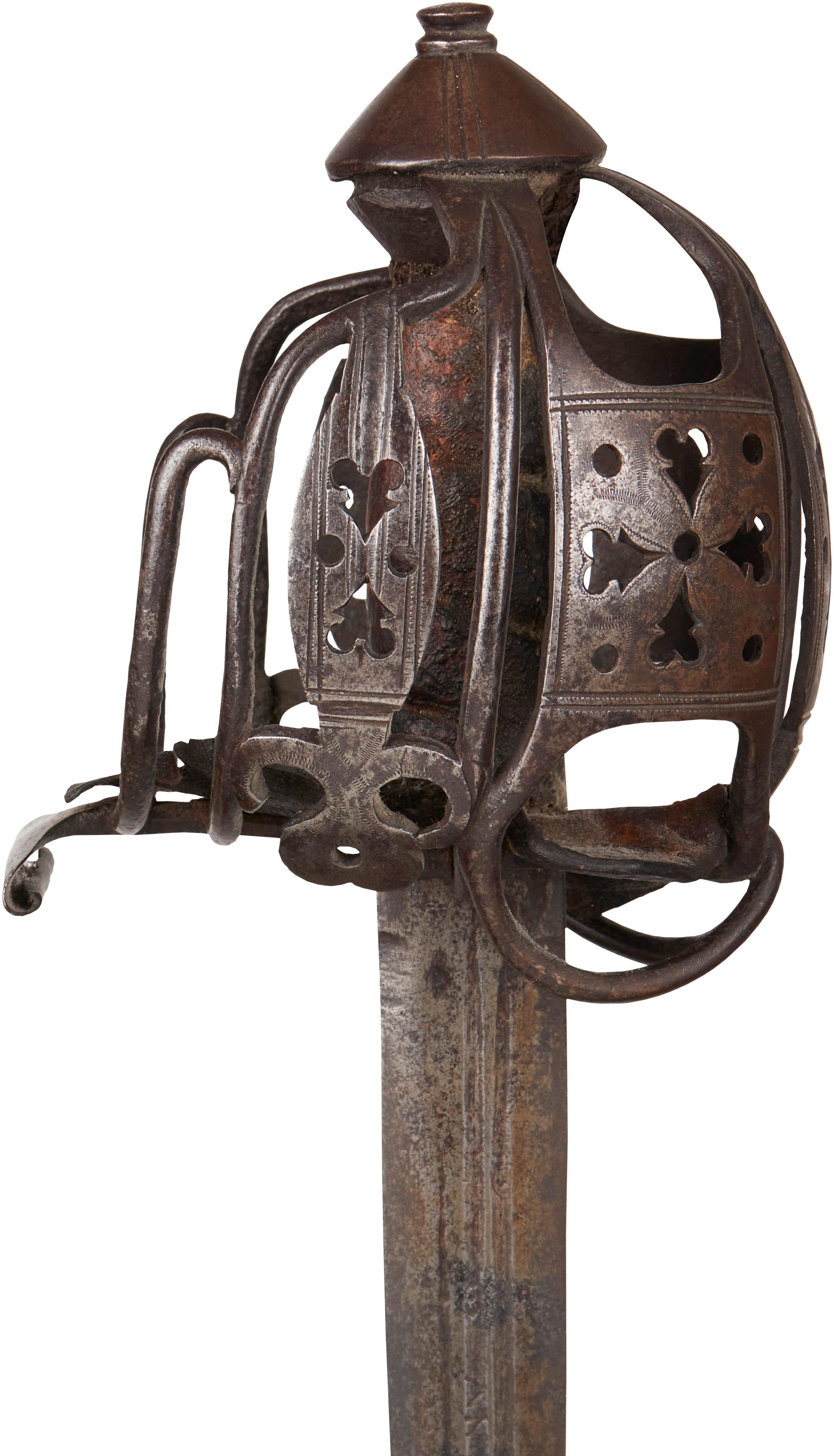

335
A RARE SET OF EIGHTEENTH CENTURY JACOBITE WINE GLASSES
the bell-shaped bowl with flared rim, engraved with trailing display of open displayed rose head flanked by twin buds and foliage, on an air twist stem and circular foot with folded rim, broken pontil to underside (6) 15cm high, rim 7cm, foot 6.5cm

Note: The engraving to this and the larger wine glass (lot 351) bear a striking resemblance, and perhaps suggest that this rare set of wine glasses is also by Engraver C. This rare set of six Jacobite wine glasses is remarkable as ‘sets’ of Jacobite glassware are virtually unheard of. This may be due to the majority of Jacobite glasses being made as singles or pairs, or that sets have regularly been split up over the years. The latter seems unlikely as there would always have been great status and value in keeping a complete set together, suggesting groups like this were very rarely made. It is tantalizing to consider that these glasses must have sat on a Jacobite table, belonging to a supporter who was very confident in his position and status, and who had a close group of companions he could share his views with. As such a statement of wealth, taste and prominence within the Jacobite community, it can be assumed they were owned by an important high-ranking Jacobite.



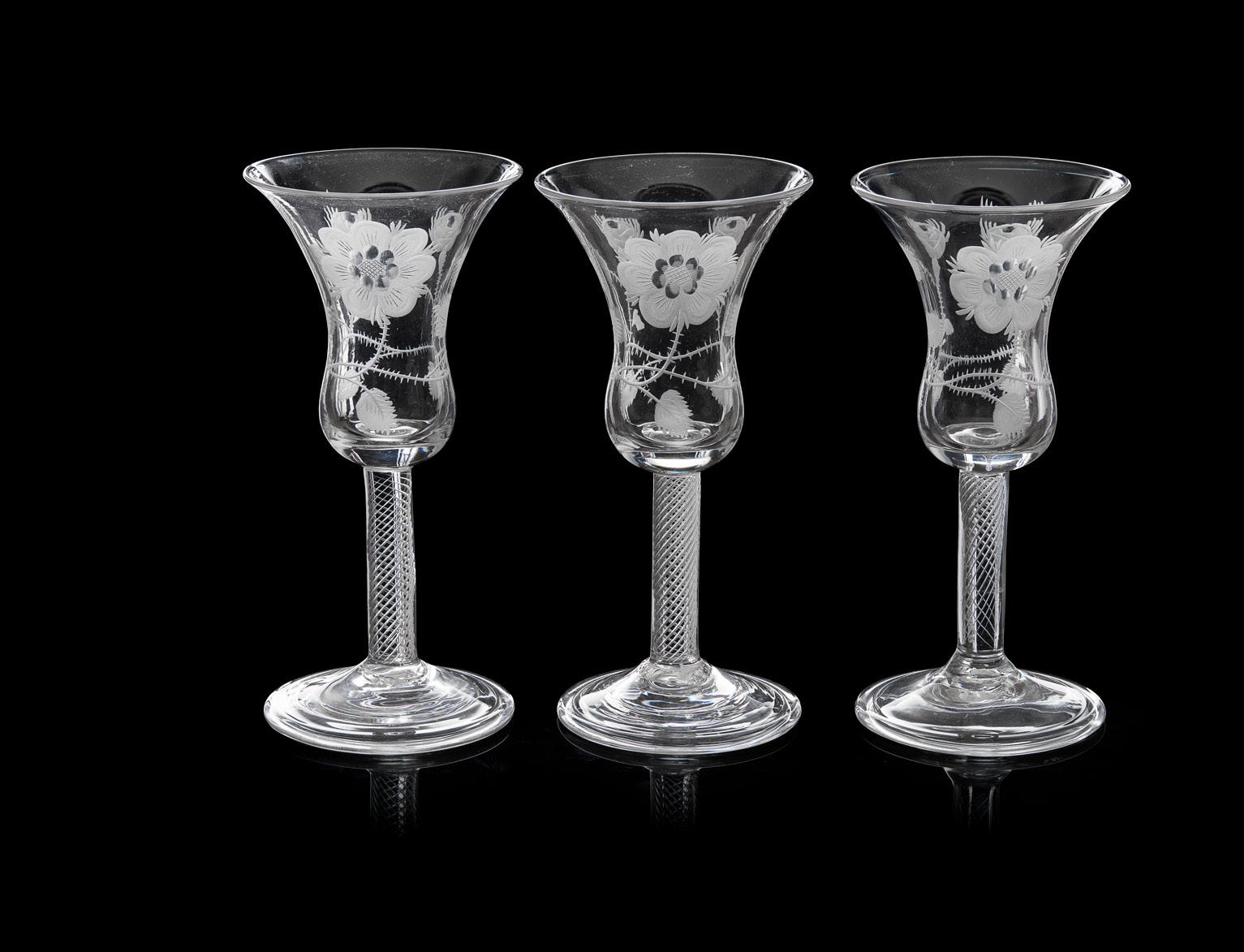
For comparable sets see Lyon & Turnbull ‘Furniture & Works of Art’ 2nd May 2018 lot 10 (sold £6500) and Bonhams ‘The Scottish Sale Antiques & Interiors’ 21st August 2013 lot 262 (sold £7250)
£3,000-5,000
336

A RARE PAIR OF JACOBITE GLASS RINSERS hemispherical outline with tapered bellied bowl, and twin everted spouts, the body engraved to each side with displayed rose head flanked by twin buds, on a simple flat foot 15cm across spouts, 8cm high, base 7.5cm



Note: For a similar finger bowl and stand in the Drambuie Collection see ‘The Jacobites and their Drinking Glasses’ G Seddon, plate 33
£1,000-1,200
Other fees apply in addition to the hammer price: see the ‘Buyer’s Guide’ section on page 2
A LARGE 18TH CENTURY JACOBITE


the large flared bucket bowl with engraved rose head flanked by single bud and foliage, raised on a thick stem above stepped domed foot, the underside with a sticker for A. Churchill Glass, with handwritten stock number 21cm high, 12cm diameter of bowl


338
A SCARCE 18TH-CENTURY JACOBITE FIRING GLASS
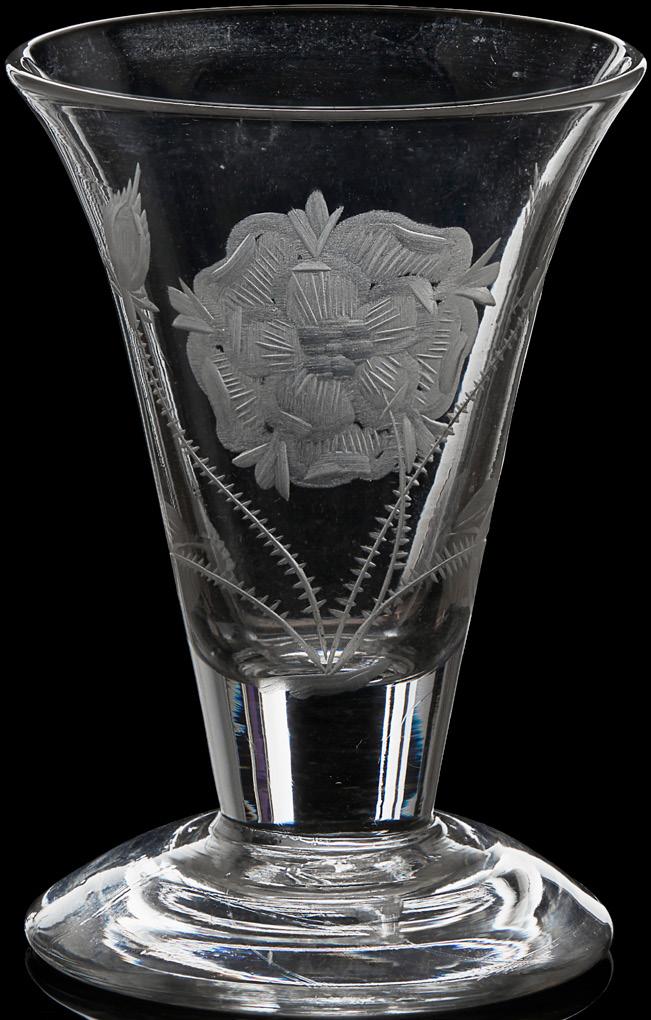

the tapered bowl engraved with a displayed rose head flanked by two closed buds, raised on a short stem and domed circular foot
9cm high
£1,000-1,200
339
A RARE ‘SUCCESS TO THE SOCIETY’ JACOBITE WINE GLASS

18TH CENTURY
the straight-sided bucket bowl finely engraved with displayed thistle and leaves, with the motto ‘Success To The Society’ engraved around and with family motto ‘Gang Warily’ below, raised on an opaque enamel twisted stem and conical foot
15cm high
£3,000-4,000
340

A JACOBITE WINE GLASS



MID-18TH CENTURY
the bucket bowl engraved with open rose head flanked by open and closed buds, the reverse with displayed thistle, engraved above ‘SUCCESS TO THE SOCIETY’, raised on a multi-enamel opaque twist stem and circular foot
15.2cm high
£1,500-2,000
343
A LARGE LATE 18TH CENTURY JACOBITE PORTRAIT WINE GLASS
the drawn trumpet bowl finely engraved with a profile portrait of Prince Charles Edward Stuart within a laurel leaf cartouche, the reverse with large display of an engraved open rose flanked by open and closed bud and thistle, on a swollen knopped multi air twist stem and domed circular foot 17.3cm high
£600-800
341
A LATE 18TH CENTURY JACOBITE WINE GLASS


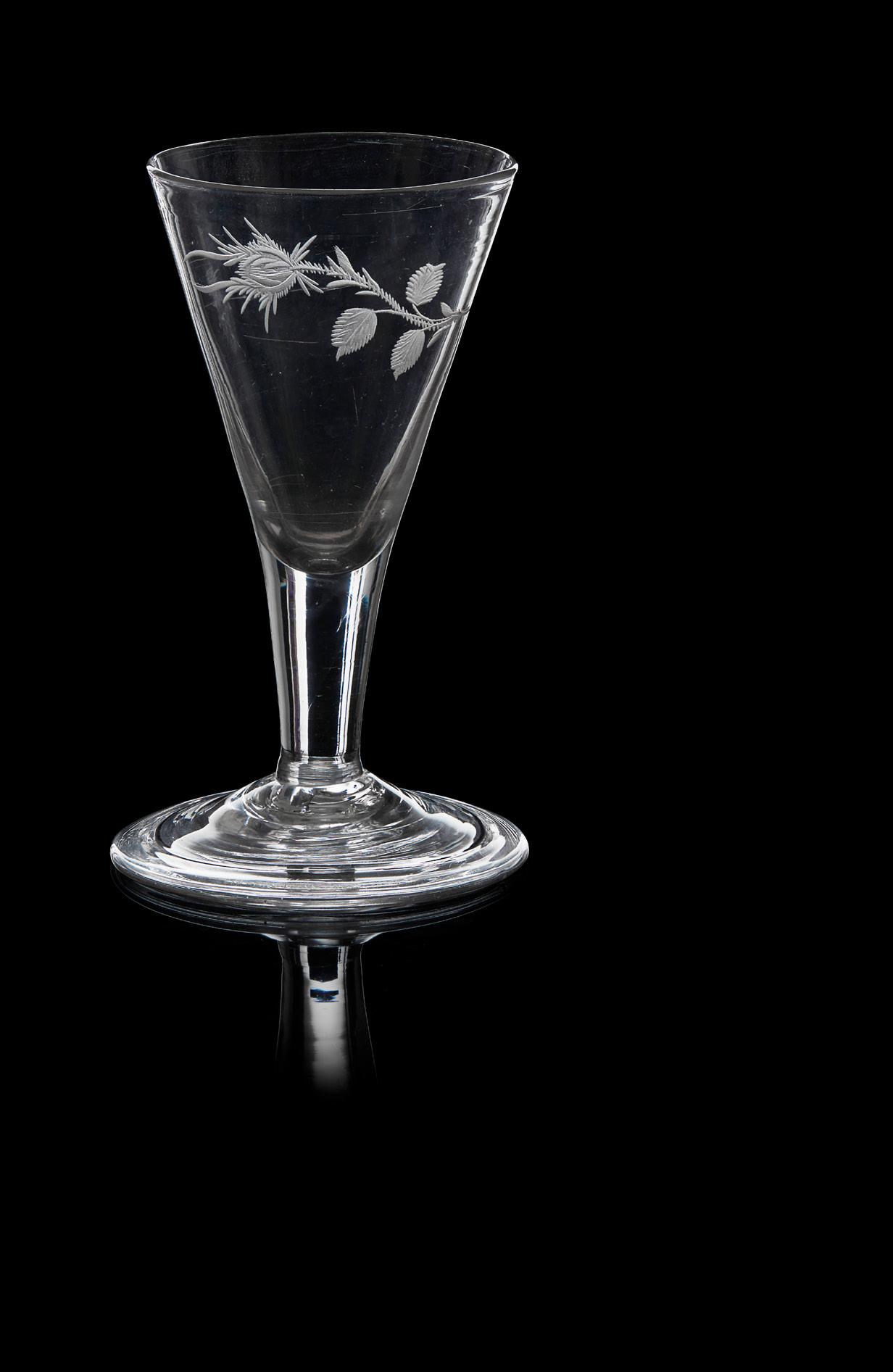
the tapered conical bowl with finely engraved trailing closed rose bud, on a short tapered stem and domed circular foot with folded foot rim

11cm high, rim 5.8cm, foot 7cm
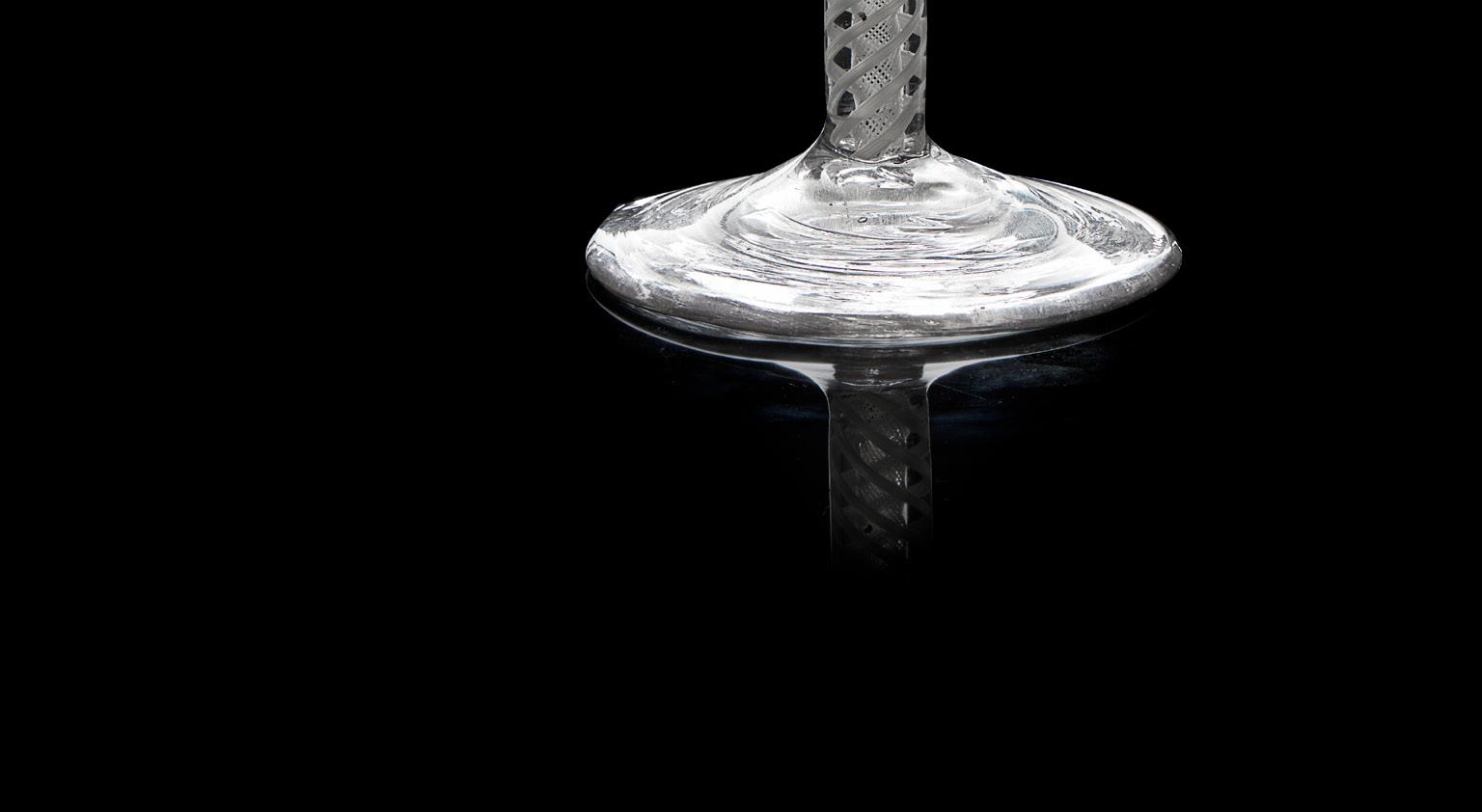
Note: This unusually decorated Jacobite wine glass would appear to date closely to circa 1788 and the death of Prince Charles Edward Stuart. The single rosebud represents the last hope of the Stuart claim being Cardinal Henry Benedict.
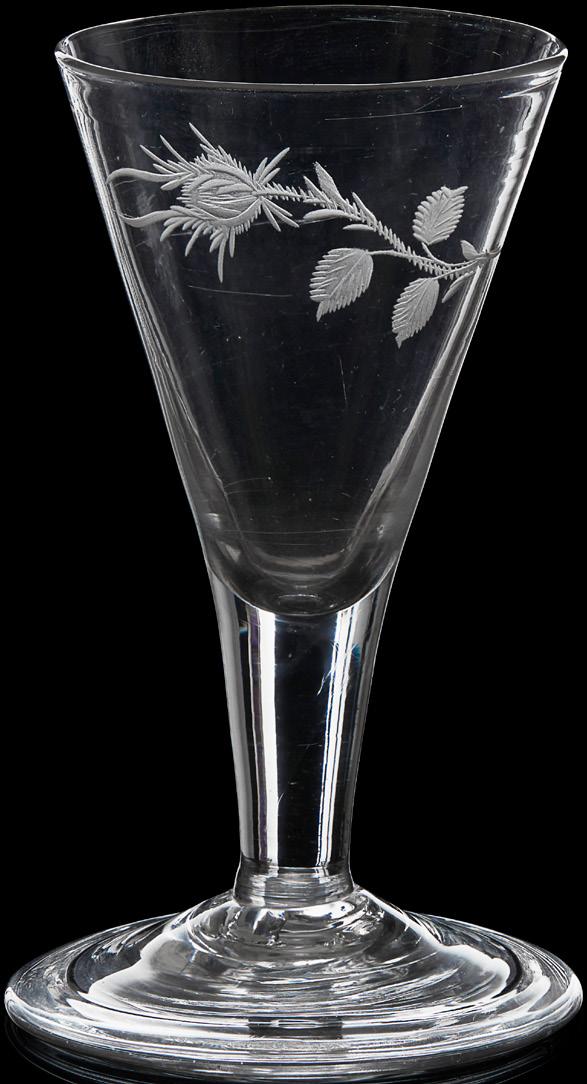
£400-600
342
AN ENAMEL TWIST JACOBITE GLASS
the deep trumpet bowl engraved with displayed rose head flanked by open and closed buds, reverse of bowl with a moth, raised on a multi-white enamel twist stem and spreading foot, broken pontil to underside 15cm high, rim 6.5cm, foot 7cm
£500-800


A similar large example with motto AUDENTIOR IBO sold Lyon & Turnbull ‘Jacobite, Stuart and Scottish Applied Arts’ 13th May 2015, lot 58 (sold £1875)
The engraving on this glass suggests Engraver D as the likely artist. The placement of the Garter star on the wrong side and tightly engraved hair among other comparable show great similarity to a glass within The Drambuie Collection. See ‘The Jacobites and their Drinking Glasses’ G Seddon, colour plate 31
Other fees apply in addition to the hammer price: see the ‘Buyer’s Guide’ section on page 2
344
AN 18TH CENTURY JACOBITE WINE GLASS


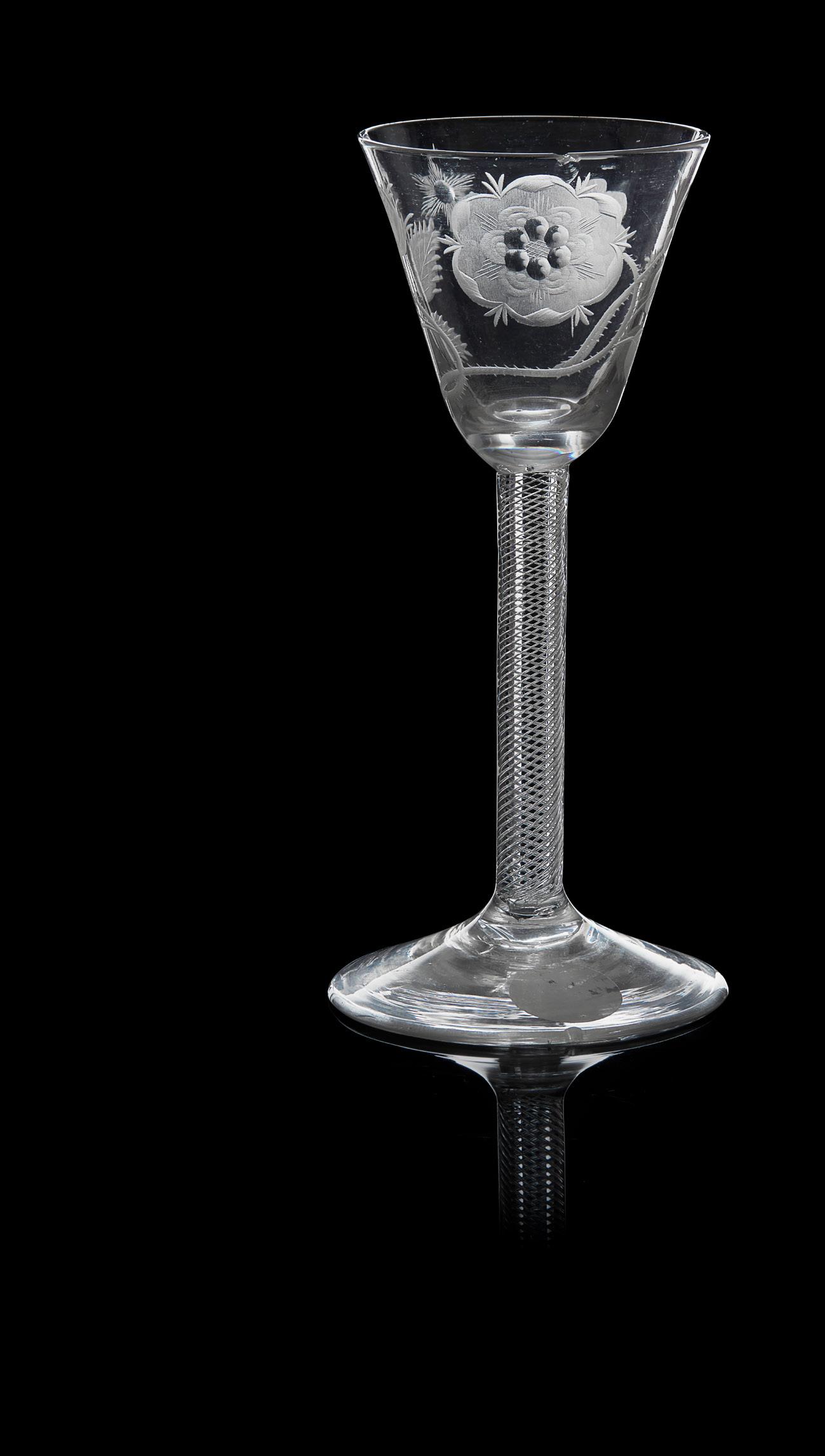

the round funnel bowl engraved with a displayed rose head flanked by open and closed buds and foliage, the reverse of the bowl with star and oak leaf, raised on an air twist stem and spreading domed foot
15cm high, rim 6cm, foot 7cm
£500-800
345
A MID / LATE 18TH-CENTURY JACOBITE ENAMEL
TWIST STEM WINE GLASS
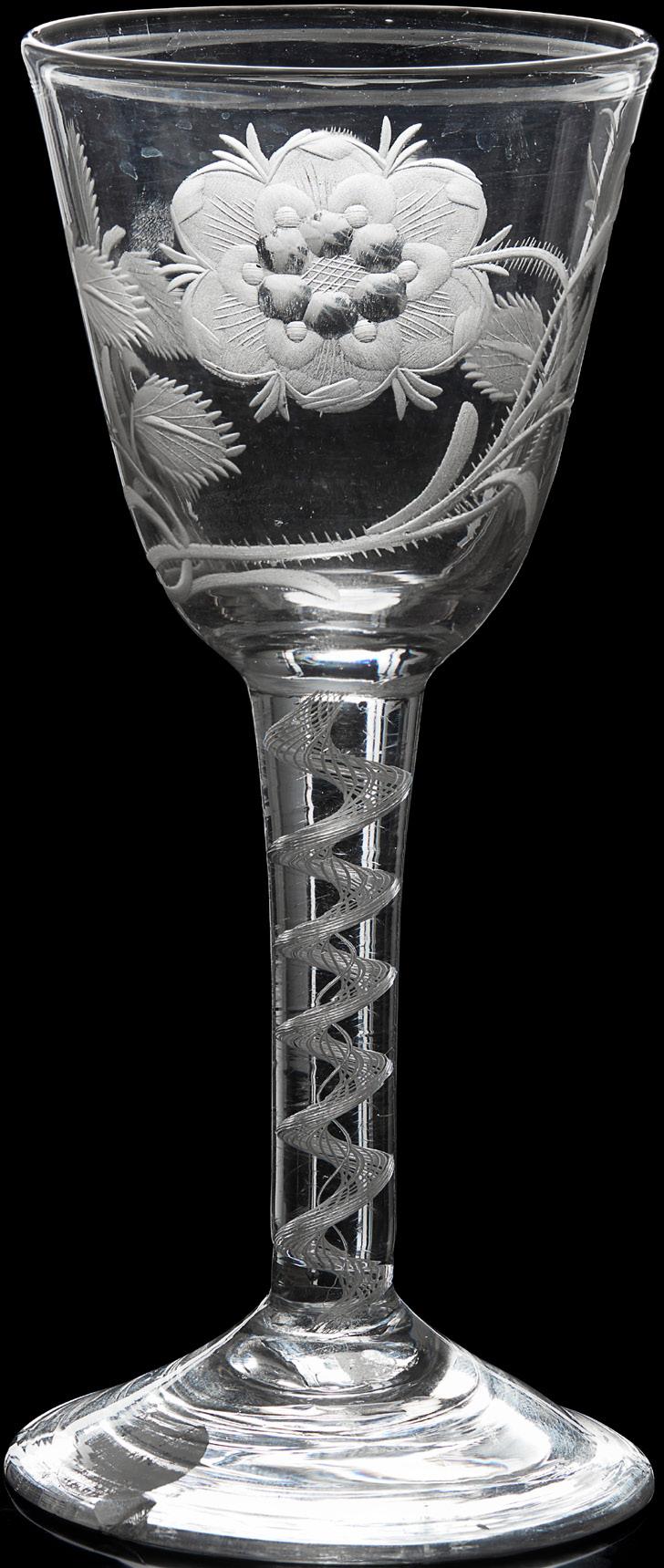
the drawn trumpet bowl engraved with trailing displayed rose head flanked by open and closed buds, the reverse of the bowl with engraved moth, raised on a straight white multi-twist enamel stem and domed circular foot
15.5cm high
£600-800
346
A LARGE 18TH CENTURY JACOBITE WINE GLASS
the deep round funnel bowl
engraved with a displayed rose head flanked by open bud and foliage, the reverse of bowl with moth, raised combination enamel and air twist stem with spreading domed foot
17.5cm high, rim 7.5cm, foot 8cm

£500-800


347
A JACOBITE CORDIAL GLASS
with drawn flared bowl engraved with displayed rose head flanked by open and closed buds and foliage, raised on a tapered cylindrical stem and domed circular foot, broken pontil to underside
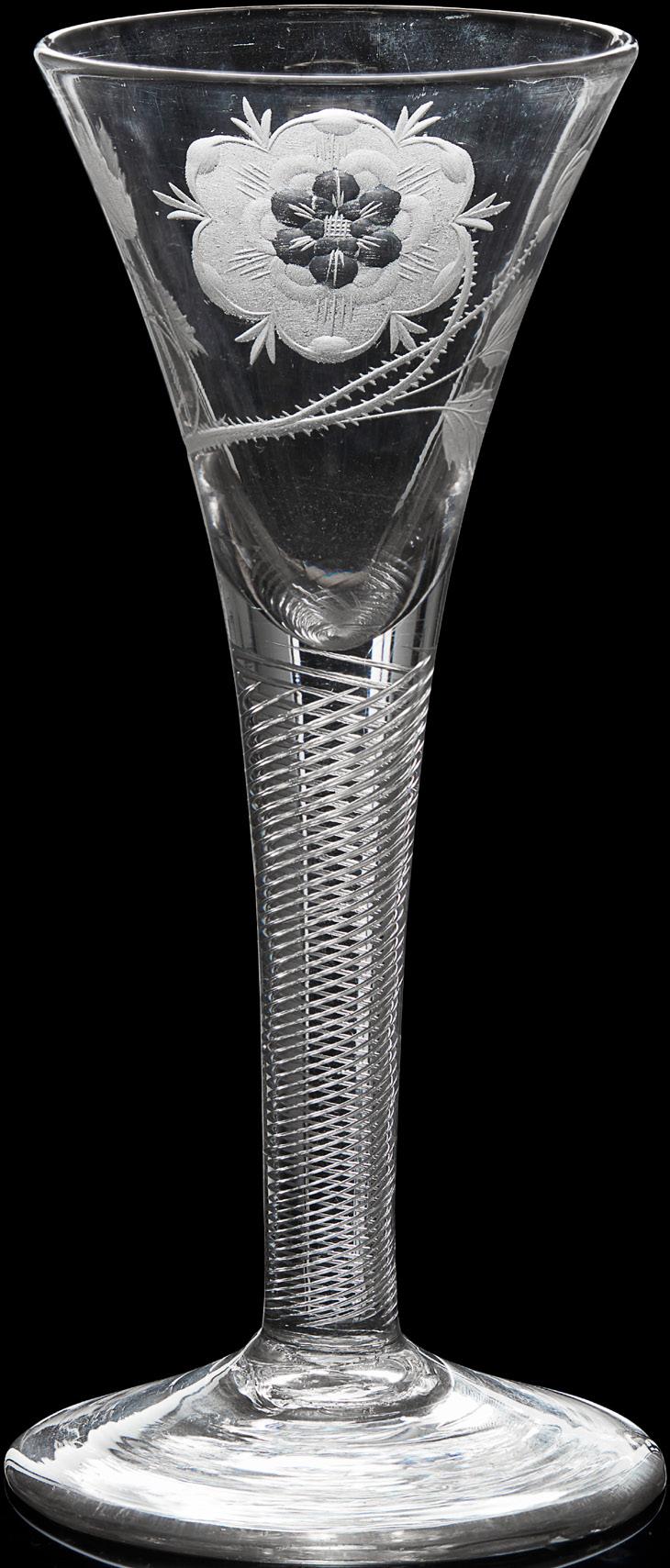
15.5cm high, rim 6cm, foot 6.8cm
Note: For an almost identical glass see ‘Scottish Works of Art & Whisky’ Lyon & Turnbull
17th August 2022 lot 374
£600-800


348
A FINE 18TH CENTURY JACOBITE WINE GLASS
the deep bucket bowl engraved with a displayed rose head flanked by a single closed bud, raised on a double knopped air twist stem and spreading domed circular foot 17cm high, rim 5.5cm, foot 7.5cm £800-1,200

349
A FINE MID-18TH CENTURY JACOBITE ENGRAVED WINE GLASS




the large drawn trumpet bowl finely engraved with displayed rose head flanked by open and closed buds with foliage, raised on a slightly tapered multi air twist cylindrical stem and a domed circular foot
17cm high
Note: This elegant glass is classic of the Jacobite style. It closely resembles the important set of glasses and two decanters from Chastleton Manor, Oxfordshire, now split between private collections and the National Trust (who have a decanter and four glasses). The glasses and decanters discovered at Chastleton Manor are considered to be from one of the oldest established Jacobite Societies, the Cavalier Club: founded in 1657 it ran well into the reign of Queen Victoria. Chastleton seems to have been the centre of the Club’s activities throughout the 18th century and the owner, Henry Jones, was a zealous supporter until his death in 1761. Jones planted Scots fir trees within the grounds, often termed as ‘Charlie’s Trees’, and they were rumoured to be navigation markers for fleeing Jacobites given shelter and sustenance on their retreat or escape.
£800-1,200
Other fees apply in addition to the hammer price: see the ‘Buyer’s Guide’ section on page 2
351
AN UNUSUAL 18TH CENTURY JACOBITE
GLASS
the deep baluster bowl with flared rim engraved with open rose head flanked by open and closed buds, with FIAT, star and oak leaf to reverse, raised on a squat swollen knopped stem and raised on a domed foot 16cm high
Note: For an example with identical engraving and of similar bowl form by engraver C in the Drambuie Collection see also ‘The Jacobites and their Drinking Glasses’ G Seddon, colour plate 21. For similar examples,
Lyon & Turnbull ‘Scottish Silver & Applied Arts’ 15th August
2018, lot 566 (sold £1875)
Bonhams ‘British & European Glass’ 13th May
2013, ex Chris Crabtree Collection lot 112 (sold (£3125)
£800-1,200
350

AN UNUSUAL JACOBITE WINE GLASS
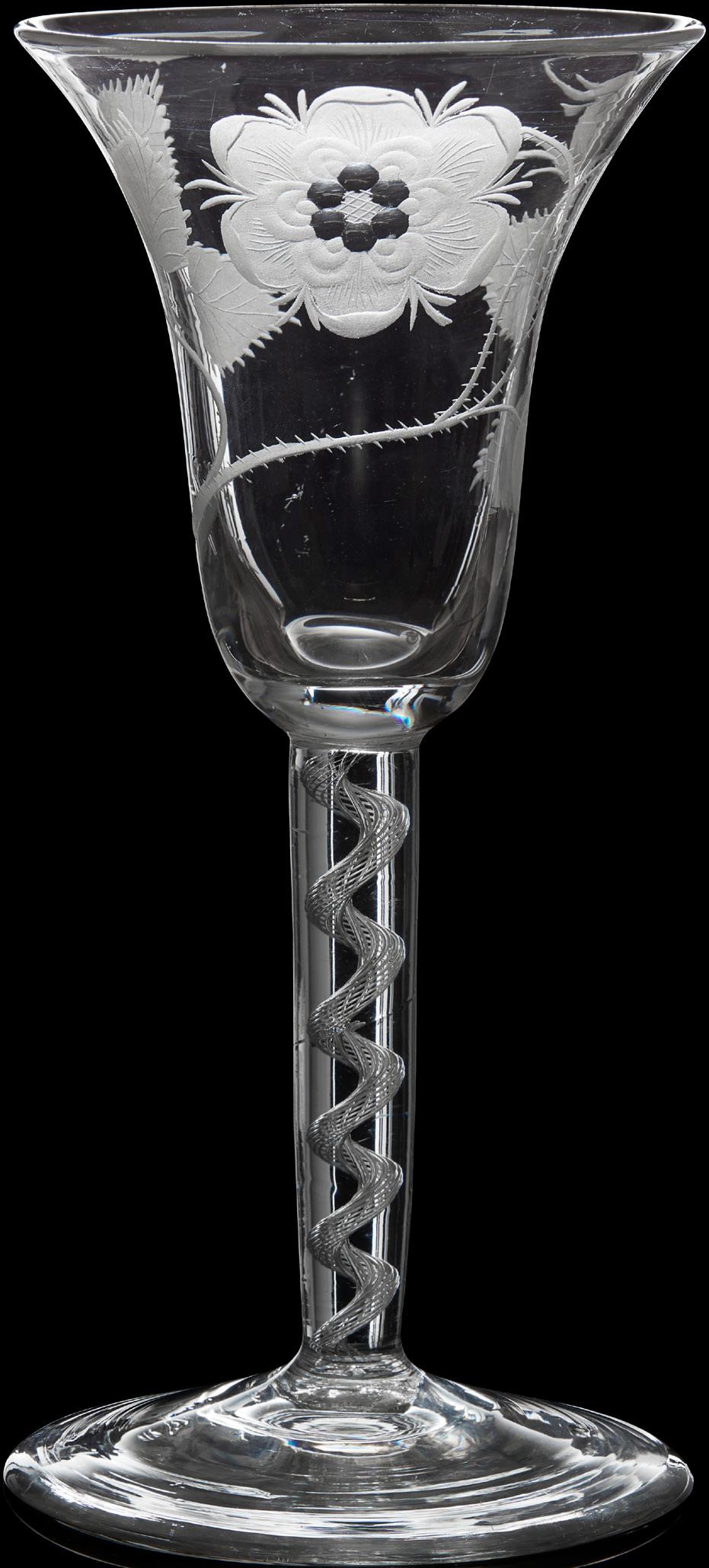

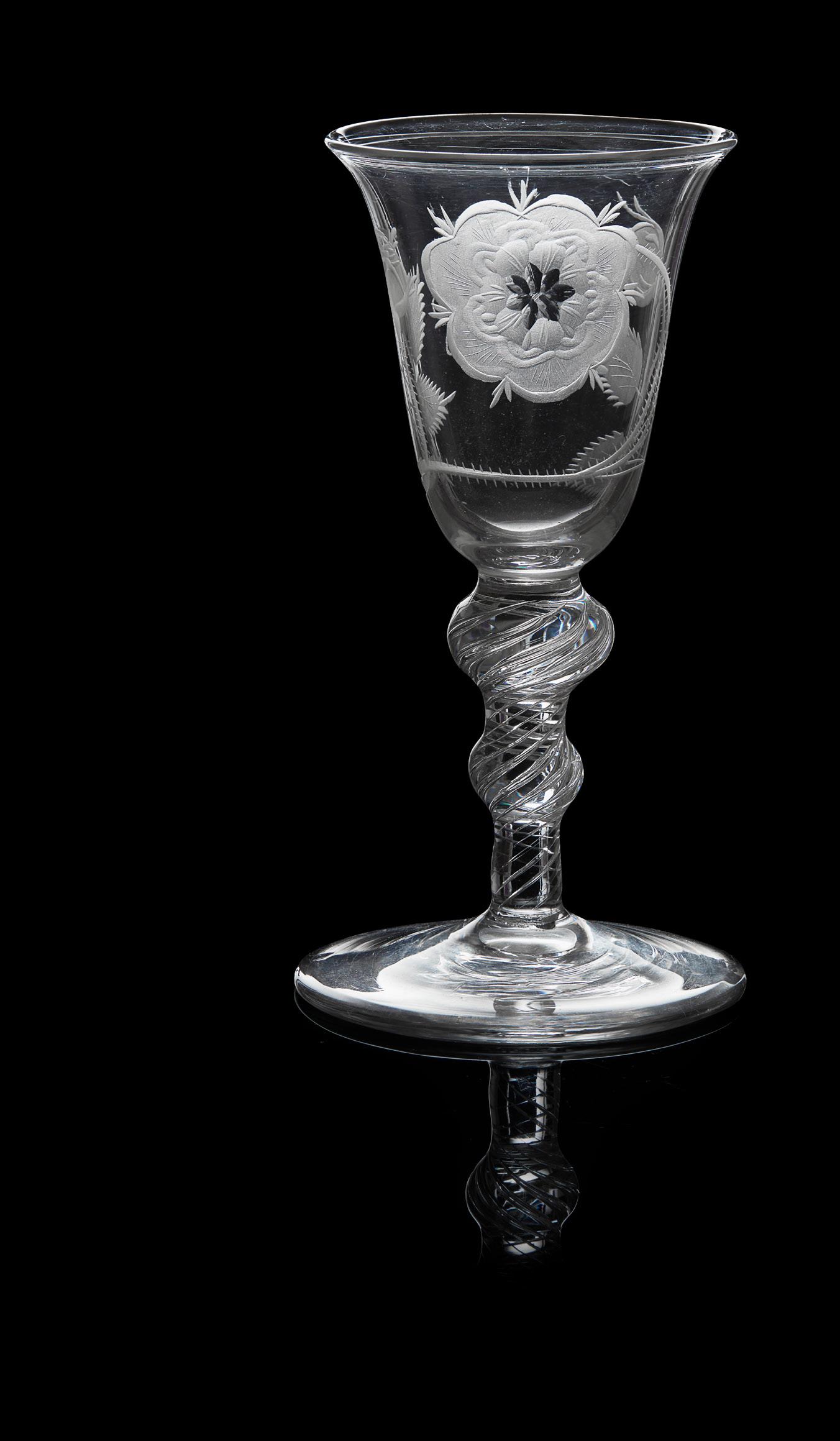
the deep bowl engraved with open rose head flanked by open and closed buds, the reverse with moth, raised on a short double knopped air twist stem, with spreading circular foot with slightly polished broken pontil to underside 15cm high, rim 7cm, foot 8cm
Note: Although double knopped air twist stems on Jacobite glasses are well recorded no comparable to this unusually short stem can be found. For a similar glass but of standard proportions see ‘The Jacobites and their Drinking Glasses’ G Seddon, plate 36.
£1,000-1,200
the bell-shaped bowl engraved with a six-petalled rose and an opening bud on a thorny, leafy branch, over an air twist stem containing a single spiral cable, on a conical foot



Other fees apply in addition to the hammer price: see the ‘Buyer’s Guide’ section on page 2
A LARGE JACOBITE GLASS
MID-18TH CENTURY
From the collection of the late G. A. Cannon, Chelsworth, Suffolk.
353

JACOBITE SODA FIRING GLASS WITH RARE COLOUR TWIST STEM 18TH CENTURY
the drawn trumpet bowl engraved with open rose head flanked by open and closed buds, additionally engraved with an oak leaf, on a short red and white multi-twist enamel stem and a flat foot

10.8cm high
£1,500-2,000
354 A SET OF THREE 18TH CENTURY JACOBITE WINE GLASSES the funnel bowl engraved with open rose head flanked by bud and foliage, raised on a straight stem and domed foot (3) 16cm high, 6.5cm diameter of bowl


£3,000-5,000

355
A RARE JACOBITE ‘EMPTY BUD’ WINE GLASS
MID-18TH CENTURY
the drawn trumpet bowl engraved with a multi-petal rose on a thorny stem issuing an empty bud, over a multi-knopped stem incorporating a beaded knop, on a conical foot
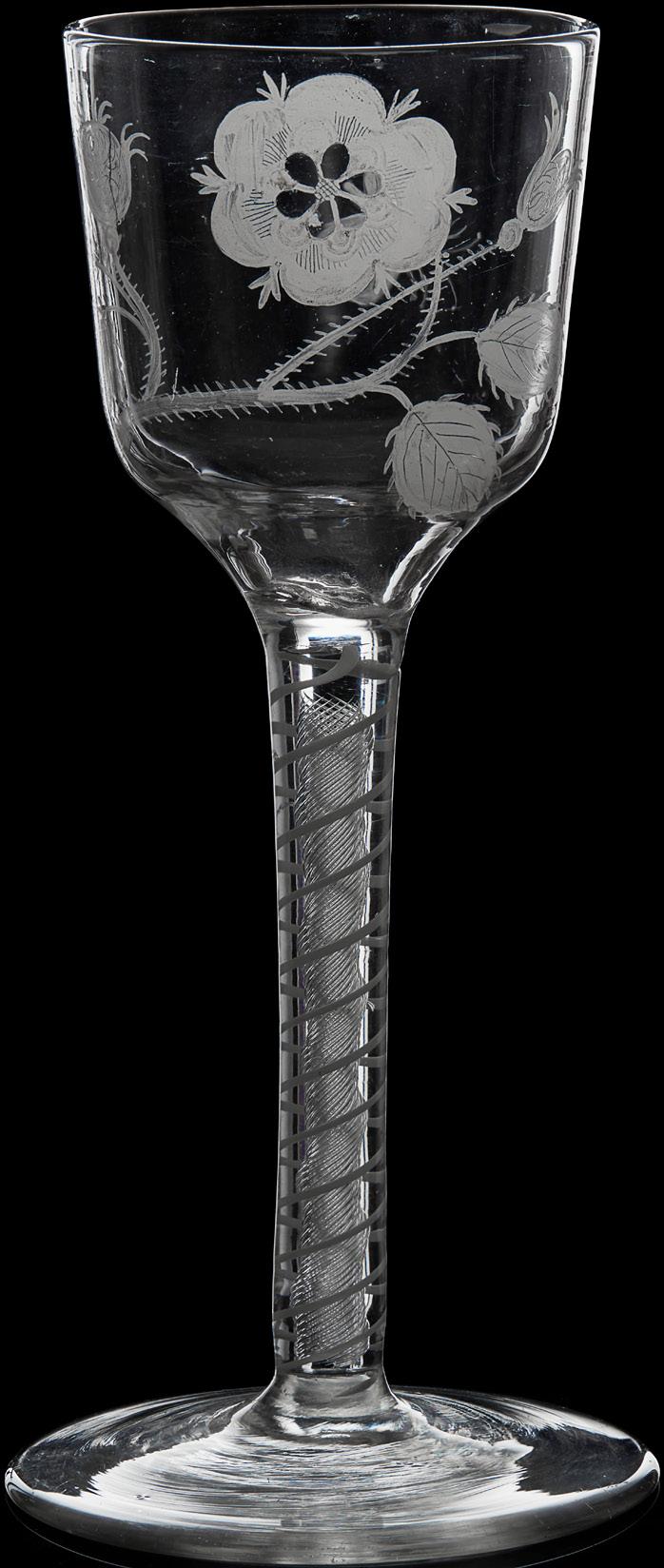

18.2cm high
Provenance: From the collection of the late G. A. Cannon, Chelsworth, Suffolk.
£2,000-3,000
AN ENAMELLED JACOBITE WINE GLASS
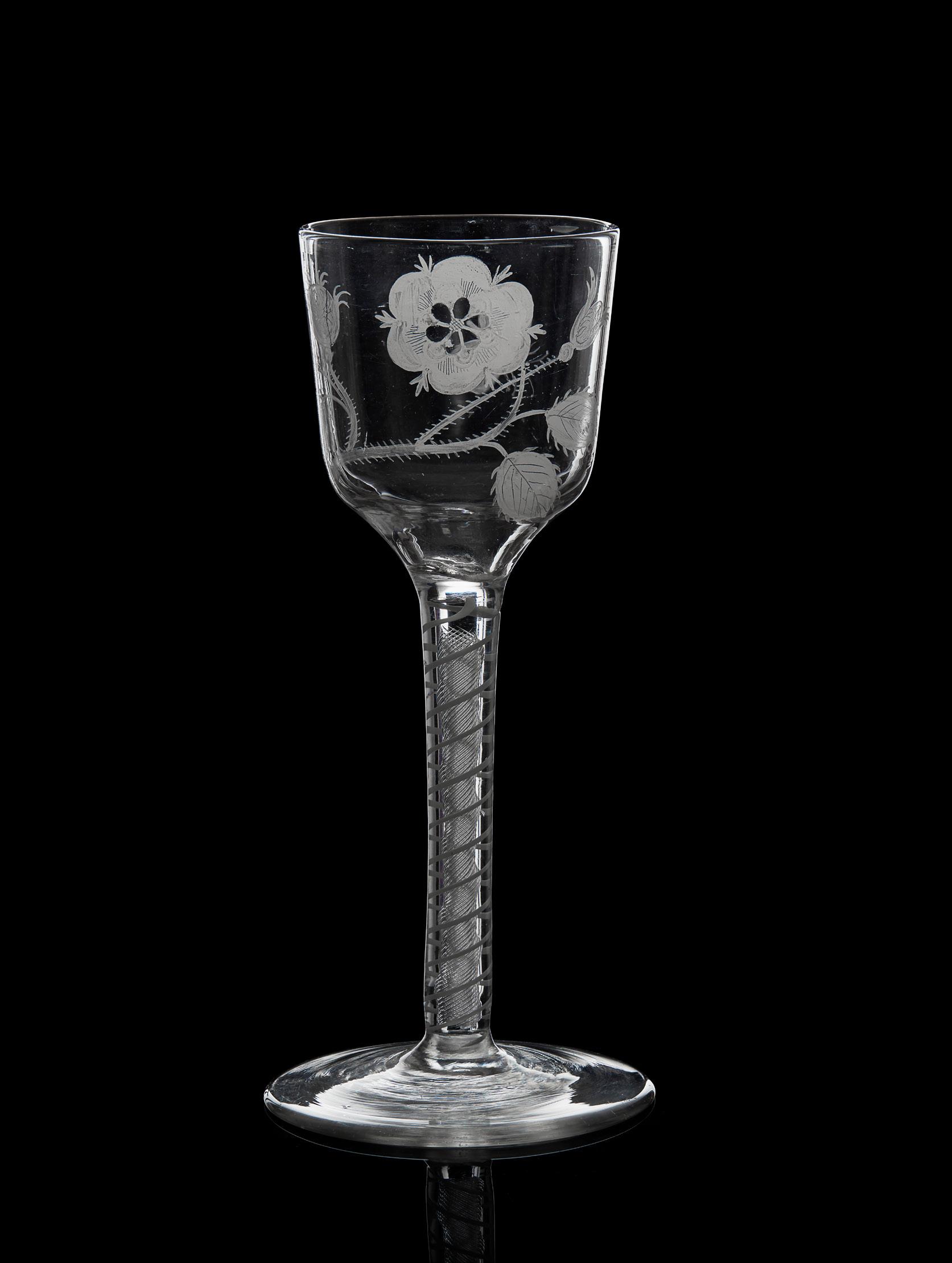
18TH CENTURY
the ogee bowl enamelled in white with a six-petalled rose, an opening bud, and a closed bud, with a butterfly to the reverse, on a multi spiral air twist and opaque twist stem
17.2cm high
This highly unusual Jacobite glass appears to be virtually unique and while the decoration is of standard pattern the fact it is enamelled rather engraved has not been recorded before. The only recorded enamel Jacobite glasses to date have been the rare portrait glasses of Prince Charles, see Woolley & Wallis English and European ceramics and glass, 7th October 2021 lot 1136.
£1,200-1,800
357
ENGRAVED JACOBITE GLASS CIRCA 1760
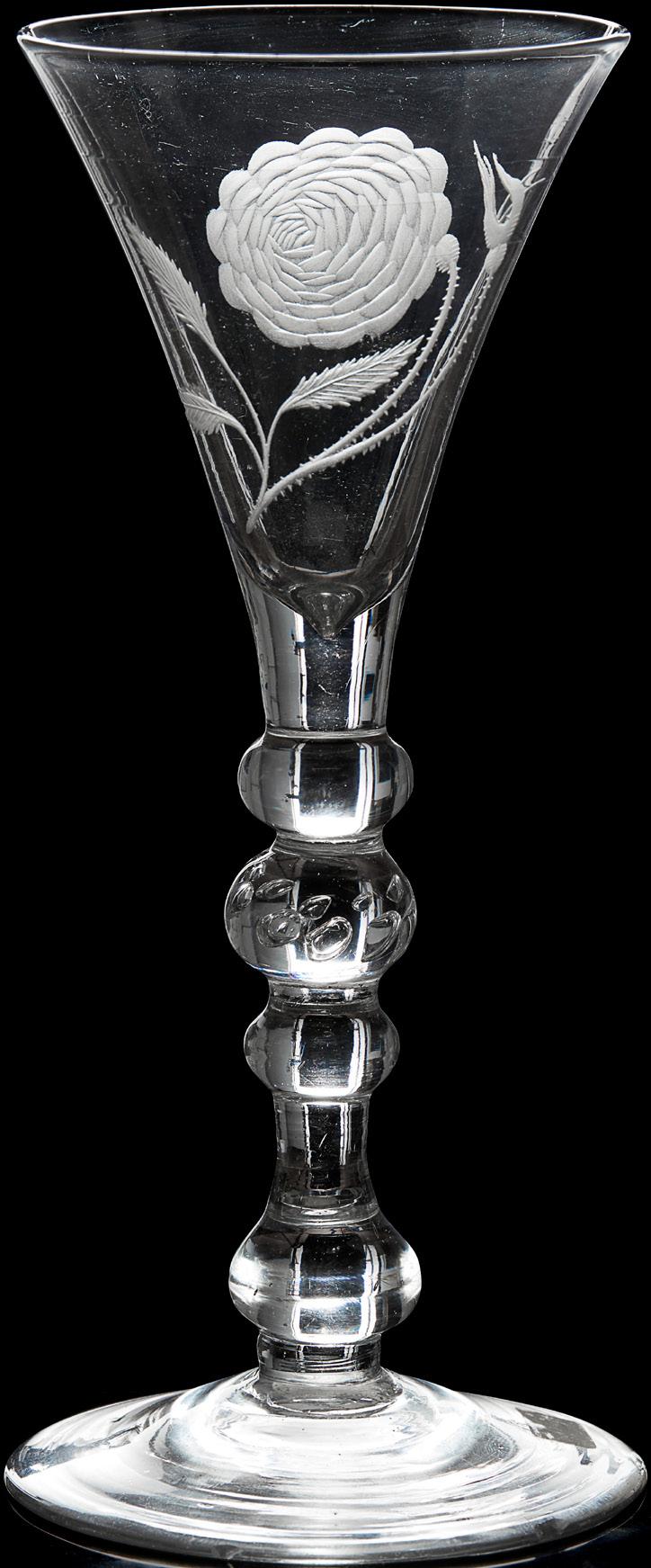


the ogee bowl engraved with a ten petal rose and a bud issuing from a thorny stem, also engraved with a thistle and leaves issuing from the same stem; on an opaque twist stem, and round conical foot
14.2cm high
£700-1,000
Other fees apply in addition to the hammer price: see the ‘Buyer’s Guide’ section on page 2
358
A STEEL DOUBLESIDED SWIVEL SEALJACOBITE INTEREST
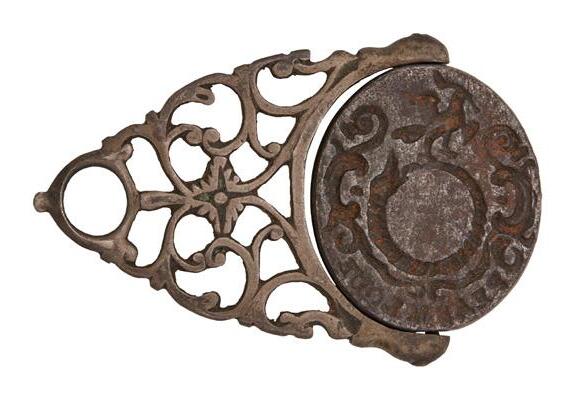
MID-18TH CENTURY
the polished steel bracket to a swivel seal, one side with the profile head and shoulders of Charles Edward Stuart, the other side with crests and motto
3.5cm long, matrix: 1.5cm £500-700
359
AN 18TH CENTURY PORTRAIT MINIATURE OF PRINCE CHARLES EDWARD STUART AFTER FRANCIS DE LA TOUR
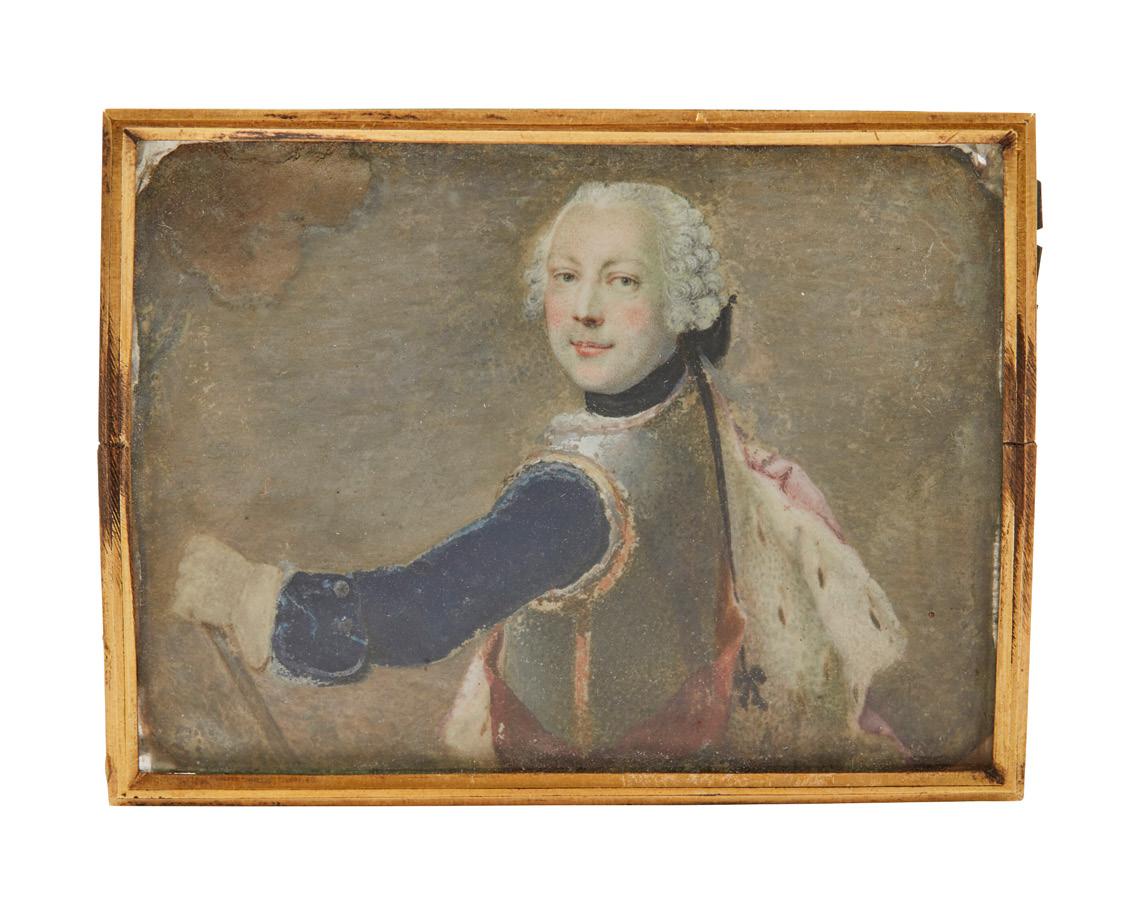
watercolour on card, facing left with gilt-edged armour and ermine lined cape, holding a baton, in someplace brass frame
8cm wide, 6cm high
£300-500
360
AN 18TH CENTURY GOLD BULLION THISTLE BADGE on red velvet ground with gold bullion and mirrored beads to form a displayed thistle, in an Edwardian frame with a typewritten presentation reading, ‘The bonnet badge belonged to Prince Charles Edward Stuart…’ and gives a family lineage for four generations
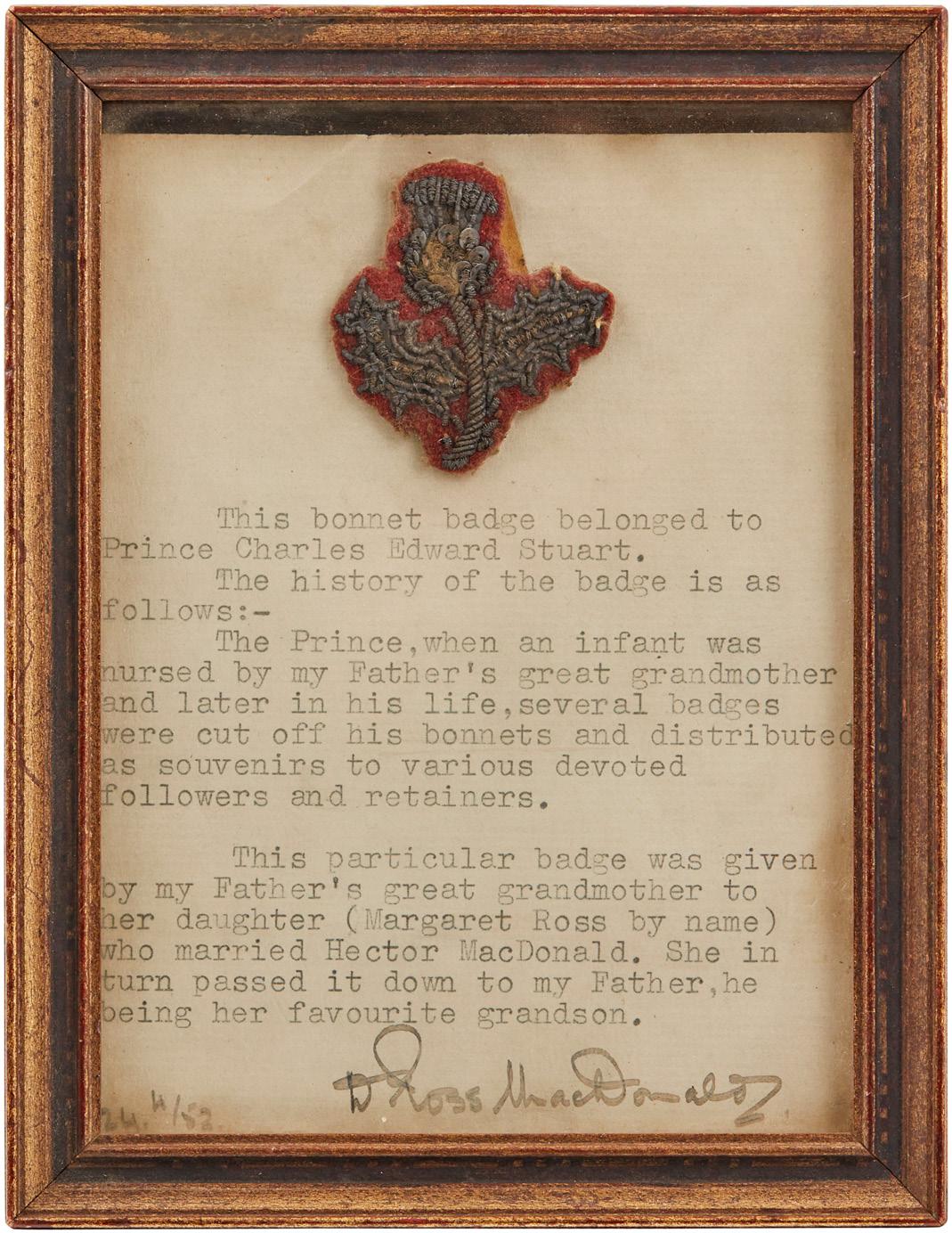
Frame 13cm x 17cm
£600-800
361 Y
A SCOTTISH TORTOISESHELL AND MOTHER OF PEARL BALUSTER SNUFF MULL 18TH CENTURY

the carcass covered with alternating staves of tortoiseshell and mother of pearl, to a reeded rim and foot, the hinged domed cover similarly formed, with a winged heart and shell thumbpiece

5.5cm high
Provenance: Captain Alastair Wardrop Euing Crawford (1896 - 1924), hence by descent to the present vendor Note: With accompanying exhibition note for the 1951 Festival Exhibition of Scottish Architecture and Crafts in Edinburgh, ‘said to have belonged to a member of Prince Charlie’s suite in 1745.’
£1,500-2,500
362

AN 18TH CENTURY WAX PORTRAIT OF PRINCE CHARLES EDWARD STEWART
UNSIGNED
the carved wax half-length portrait facing left, with Prince Charles Edward in flowing robes with lace collar and pony-tailed wig, in ebonised frame with gilt insert 15.5cm height of frame £1,500-2,500

363 SCOTTISH MUSIC REEL BOOK OF ELIZABETH ROSE OF KILRAVOCK, CIRCA 1766
Music manuscript, [48] ff. (16 x 20.6cm), on laid paper, written in brown ink, mainly on rectos only, containing some 75 pieces in total, 6 staves to the page, ownership inscription ‘El. Rose, Kilravock Castle, Decr, 27th 1766’, to front free endpaper, bound in contemporary quarter calf, drab paper sides, binding worn and marked, f. [26] with closed tear, a few short closed tears elsewhere
£3,000-5,000
Note: A substantial primary source for the history of traditional Scottish music and its most iconic dance, the strathspey, an insight into the music enjoyed by a woman at the heart of the flourishing of Highland culture in the 18th century, and a rare survival from the formative period in which Scottish reels first began to be recorded and published.
Belonging to a young Elizabeth Rose, 19th of Kilravock (1747-1815), the manuscript contains some 75 individual pieces, of which ten are identified as strathspeys, three as ‘rants’, and the rest as reels. Around a third of the pieces (27 in total) have titles in Gaelic, which, together with several pieces with generic titles (including seven simply titled ‘A Strathspey Reel’), are inevitably elusive in the published record. Many of the tunes appear in the earliest printed collections of reels and are now well known, such as ‘The Duke of Perths Reell’, and ‘The Fir Tree a Stratchspey [sic] Reell’, both printed in Robert Bremner’s A Collection of Scots Reels or Country Dances (c.1757), ‘Lord Albremarle [sic] his Reell’ (John Johnson, A Choice Collection of 200 Favourite Country Dances, 1744-51), and ‘Miss Katy Gordon of Earlstons Reell’ (John Riddell, A Collection of Scots Reels, Minuets etc. for the Violin of c.1766). As the Roses of Kilravock were supporters of the Hanoverian succession, an especially interesting inclusion is ‘The Sows Teal to Gordie a Reell’, a lampoon of Sophia Charlotte von Kielmansegg, half-sister and reputed mistress of George I; James Hogg included the words in his Jacobite Relics of 1819.


The manuscript pre-dates Angus Cumming’s A Collection of Strathspey, or Old Highland Reels (1780), ‘the earliest collection of strathspeys by a native of the area’ (Lamb, p. 73), and coincides with the gradual formalisation of the strathspey during the 18th century:
‘The earliest written tune in strathspey rhythm is ‘Macpherson’s Testament’, in the 1710 Sinkler manuscript [now at the National Library of Scotland]. Although the snap is missing from the original notation … it would have been present in performances of the tune. The Menzies manuscript of 1749 [now at the A. K. Bell Library in Perth], which describes a set of dance figures, gives us the first mention of the word ‘strathspey’ in connection with a specific type of music or dance: two selections are described as ‘strathspey reels’. The first compositions clearly exhibiting both snaps and dots, and called ‘strathspeys’, are two items in [James Oswald’s] The Caledonian Pocket Companion [12 vols, 1743-59] … named ‘A New Strathspey Reel’. Finally, Bremner’s 1757 collection gives us the first anonymous tunes described as strathspeys, such as “Let’s to the Ard” (Lamb, pp. 67-8)
The manuscript is not apparently in Elizabeth’s hand and may have been presented to her by a music tutor or other acquaintance, perhaps the Duncan Campbell to whom five reels are attributed, including ‘Miss Roses Reel by Duncan Campbell’, written in A major using AEAE scordatura; a violin re-tuned in this manner produces greater resonance in the key of A, in which the bagpipes (banned under the 1746 Act of Proscription) are conventionally notated. Another insight
128 Other fees apply in addition to the hammer price: see the ‘Buyer’s Guide’ section on page 2
into contemporary performance is provided by ‘Jennie Jo a Reell’, which includes the direction to ‘Touch ye violin with the bow 4 times’, with a drawing of a violin indicating the points to be struck.
The National Library of Scotland holds a set of four part-books from Kilravock preserving otherwise unknown chamber music by Thomas Erskine, Earl of Kellie (Acc.10303), together with three further volumes of pieces by various composers including Handel, Corelli and Arne (Acc. 11420). As of June 2022 Elizabeth Rose’s commonplace book was for sale with a leading member of the London rare-book trade.

Provenance: Elizabeth Rose, 19th of Kilravock (1747-1815) succeeded to the head of the family in 1782, becoming an influential hostess and correspondent, and developing Kilravock’s reputation for music-making and as a focal point of Highland culture.
Prince Charles Edward Stuart was entertained at Kilravock by Elizabeth’s father Hugh, 17th of Kilravock, on 14th April 1745, two days before the Battle of Culloden, his visit followed by one from the Duke of Cumberland, as recounted by antiquary Cosmo Innes in a history of the Rose family published in 1848:
‘When Prince Charles Edward rode out from Inverness eastward, to support his party retiring from the fords of Spey before Cumberland’s army, he stopped at the Castle of Kilravock, and was received there with becoming respect. He made himself very agreeable – asked to see the children, kissed each of them, and praised their beauty. Observing a violin, he inquired if the Laird played, begged a tune, and of course was pleased ... The following day was the Duke of Cumberland’s birth-day, and he spent it at Kilravock, and lay there that night. He remarked, “you have had my cousin here!” But when the Laird would have apologized, on the ground that he had no means of resistance, the Duke stopped him, and said he had done quite right – that he could not refuse to receive Charles Edward, and receiving him, he must treat him as a Prince. Next day the “cousins” met at Culloden! Such is the tradition of the house’ (p. 415)
Robert Burns visited Elizabeth at Kilravock twice, in 1787 and 1788, and wrote afterwards to thank her for sending him the music for two reels he had heard during his stay there. Innes’s work contains a character sketch of Elizabeth which emphasises her literary and musical interests:
‘She … was a great letter-writer … the choice companion, the leader of all cheerful amusements, the humorous story-teller, the clever mimic, the very soul of society … Everything literary – every one connected with literature – was ranked unreasonably high. She was content to admire and to praise as her literary guides directed … Still, in a very country where there was little learning in either sex, her extensive reading gave her a certain pre-eminence, which she never sacrificed in society by any pedantry or blue-stocking affectations … Without being an accomplished musician, for she was almost self-taught, she had music to charm wherever she came. She sung the airs of her own country, and she had learnt to take a part in catches and glees to make up the party with her father and brother. The same motive led her to study the violin, which she played like male artists, supported against her shoulder. The guitar she learned, to humour her dear old Uncle Clephane, and she continued it to delight all her friends. The spinet and guitar were here companions in all her changes of abode and changes of fortune, which she loved to write of as great and disastrous … none who came within her sphere escaped the fascination of her attraction’ (pp. 469-71).
Literature: Johnson, David, ‘Music’, The Edinburgh History of the Book in Scotland. Volume 2: Enlightenment and Expansion, 1707-1780 (Edinburgh: Edinburgh University Press, 2012), pp. 585-94.
Innes, Cosmo (ed.), A Genealogical Deduction of the Family of Rose of Kilravock, with Illustrative Documents from the Family Papers, and Notes (Edinburgh: Spalding Club, 1848).
Lamb, William, ‘Reeling in the Strathspey: The Origins of Scotland’s National Music’, Scottish Studies, vol. 36, 2013, pp. 66-102.
Purser, John, ‘Here’s why the Kilravock fiddle manuscript is so significant’, The National, 2nd June 2019.
AN 18TH CENTURY NIELLO ANNULAR BROOCH
of traditional circular outline, with engraved scroll and geometric patterns, niello enamel detail, engraved to the reverse, D.C. M.F. 1781, the pin of tapered outline, with similar niello decoration 7.5cm diameter, 80.5g
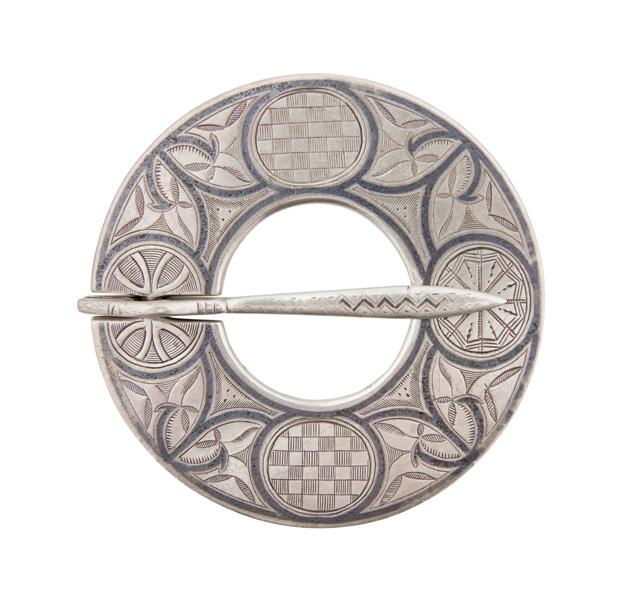
£700-1,000
365
A MID-18TH CENTURY BASKET HILTED BROAD SWORD
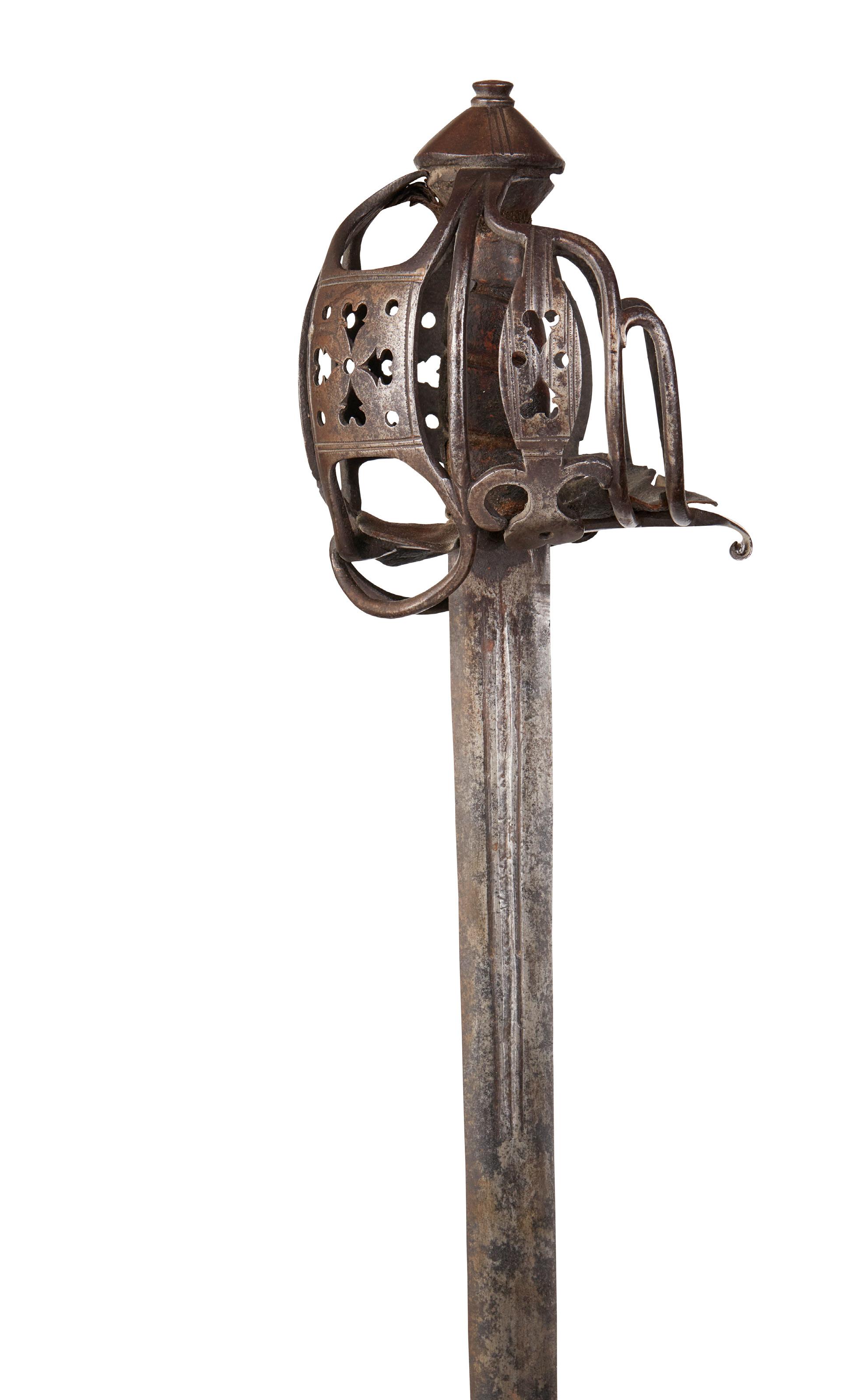
the basket with pierced panels of heart and roundel shaped decoration, wooden grip and leather liner, the double fullered blade, indistinctly signed with pointed tip blade 83.5cm long, overall length 98cm
Literature: Culloden The Swords and The Sorrows: An exhibition to commemorate the Jacobite rising of 1745 and the Battle of Culloden 1746, The National Trust, Image 1:19, Page 32
£2,000-3,000 366
A LATE 17TH CENTURY POWDER HORN FLASK
the flattened cow horn, decorated in a variety of Celtic strap work designs within panels, with initials ID and dated 1676 the nozzle with a pewter mount 36cm long
£800-1,200
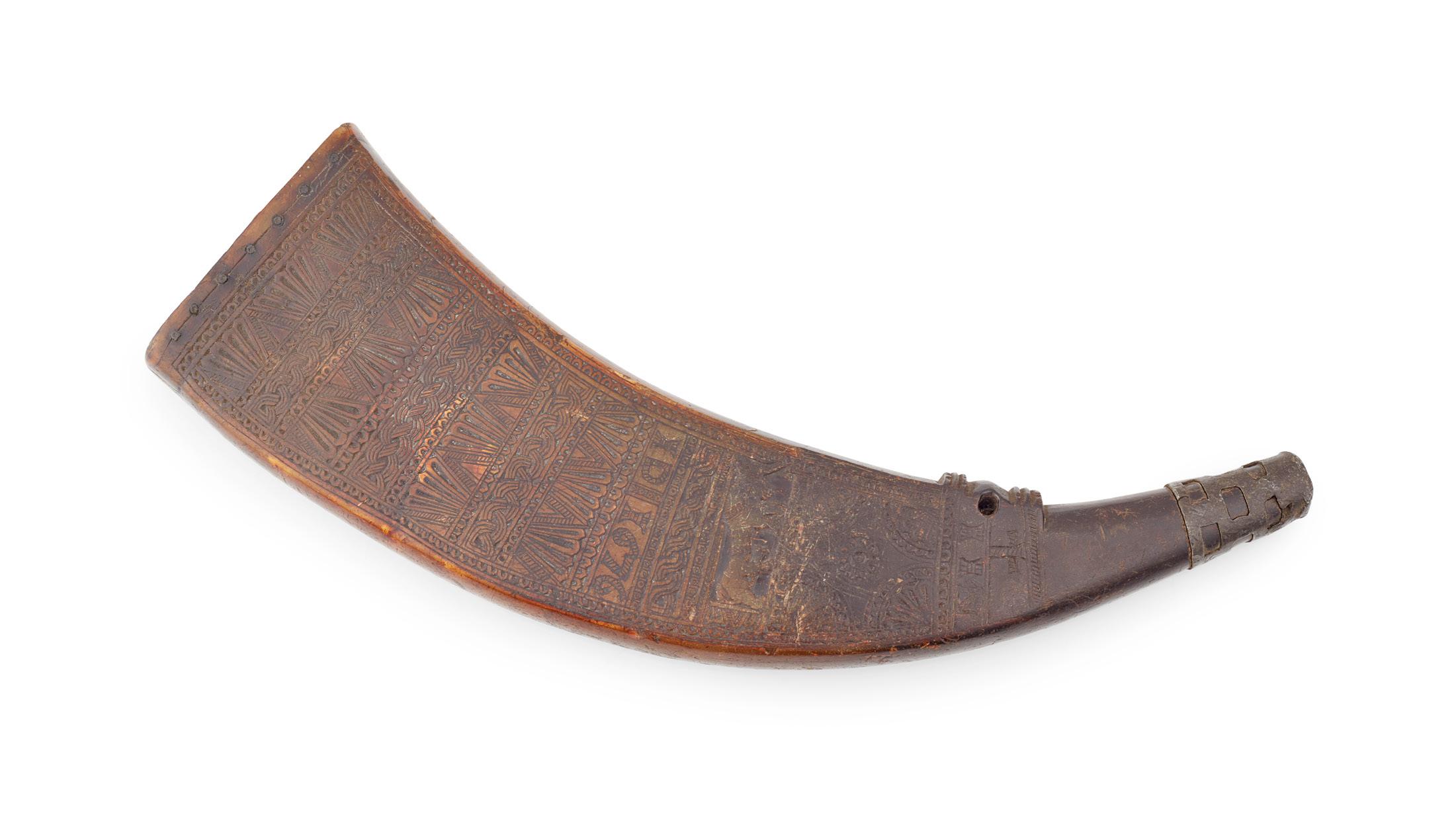
364
130
THE CAPTAIN ALASTAIR WARDROP EUING CRAWFORD COLLECTION
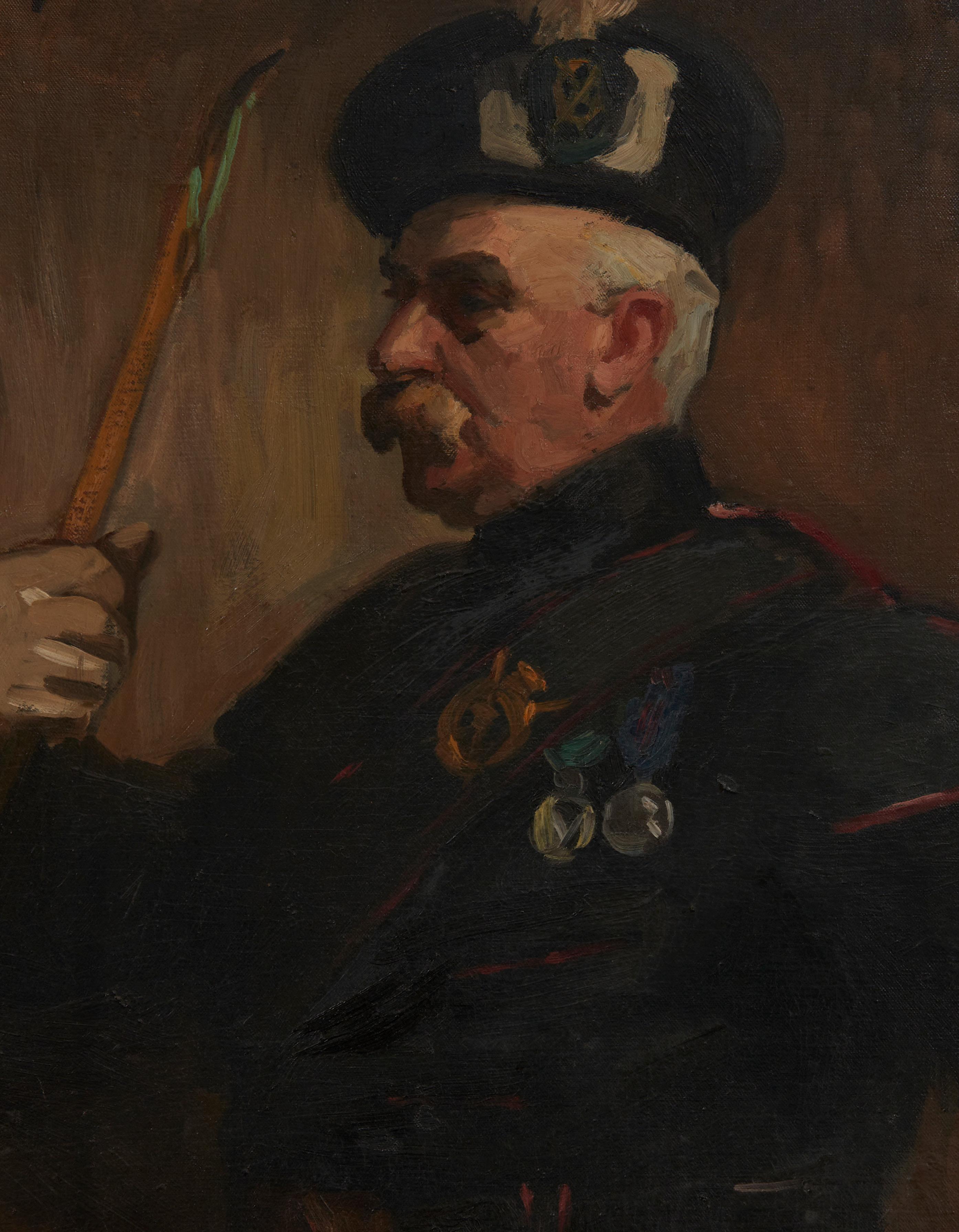
Captain Alastair Wardrop Euing Crawford (1896 - 1924) was an Officer of the Royal Scots Greys. Born in Scotland, Crawford served in the First World War. Following his service, he later held the office of Justice of the Peace and the office of Deputy Lieutenant for Stirlingshire. Crawford lived at Auchentroig House, Buchlyvie, Stirlingshire, Scotland, and Archirondel, Gorey, Jersey.
Crawford purchased Auchentroig in the late 19th century and had the property remodelled and enlarged in 1903. In 1923 the house was devastated by fire, leaving only the walls standing. It was reconstructed and completed by 1930.
AN IMPRESSIVE 1920S ROYAL SCOT’S GREY PRESENTATION SCULPTURE
HAMILTON & INCHES, EDINBURGH 1923
modelled as a Royal Scot’s Grey trooper on horseback, modelled on the William Birnie Rhind sculpture, the silver-gilt plaque with presentation engraving ‘Presented to Captain

A.W.E. Crawford Royal Scot’s Greys on the occasion of his marriage.. 1924’ and names of contributors 61cm high
£3,000-5,000
This sculpture was presented to Captain Crawford by the Royal Scots Greys on the occasion of his marriage to Helena Beatrice Dundas (1924 - 1977) on the first of October 1924. Made by the renowned Edinburgh jewellers and silversmiths Hamilton & Inches, its cartouche details the members of the regiment at the time, then led by Lieutenant Colonel S J. Hardy. The sculpture reproduces the Monument by William Birnie Rhind, Sergeant Major Anthony James Hinnigan from Jedburgh and his horse ‘Polly’ to the Royal Scot Greys found in Princess Street Gardens, Edinburgh, which was erected and unveiled on the 16th November 1906, by Lord Rosebery in commemoration of the fallen members of the Regiment during the Boer War. The equestrian statue, placed on a rock pedestal with inscription panels, represents a Royal Scots Grey trooper dressed in the uniform of the regiment when they were sent to South Africa in 1899. It was sculpted by William Birnie Rhind and unveiled by the Earl of Rosebery on the 16th of November 1906.
367
132 Other fees apply in addition to the hammer price: see the ‘Buyer’s Guide’ section on page 2
368
HENRY HARRIS BROWN (BRITISH 1864-1948)
PORTRAIT OF COLONEL E.R. CRAWFORD OF AUCHENTROIG (1860-1938) - 1914
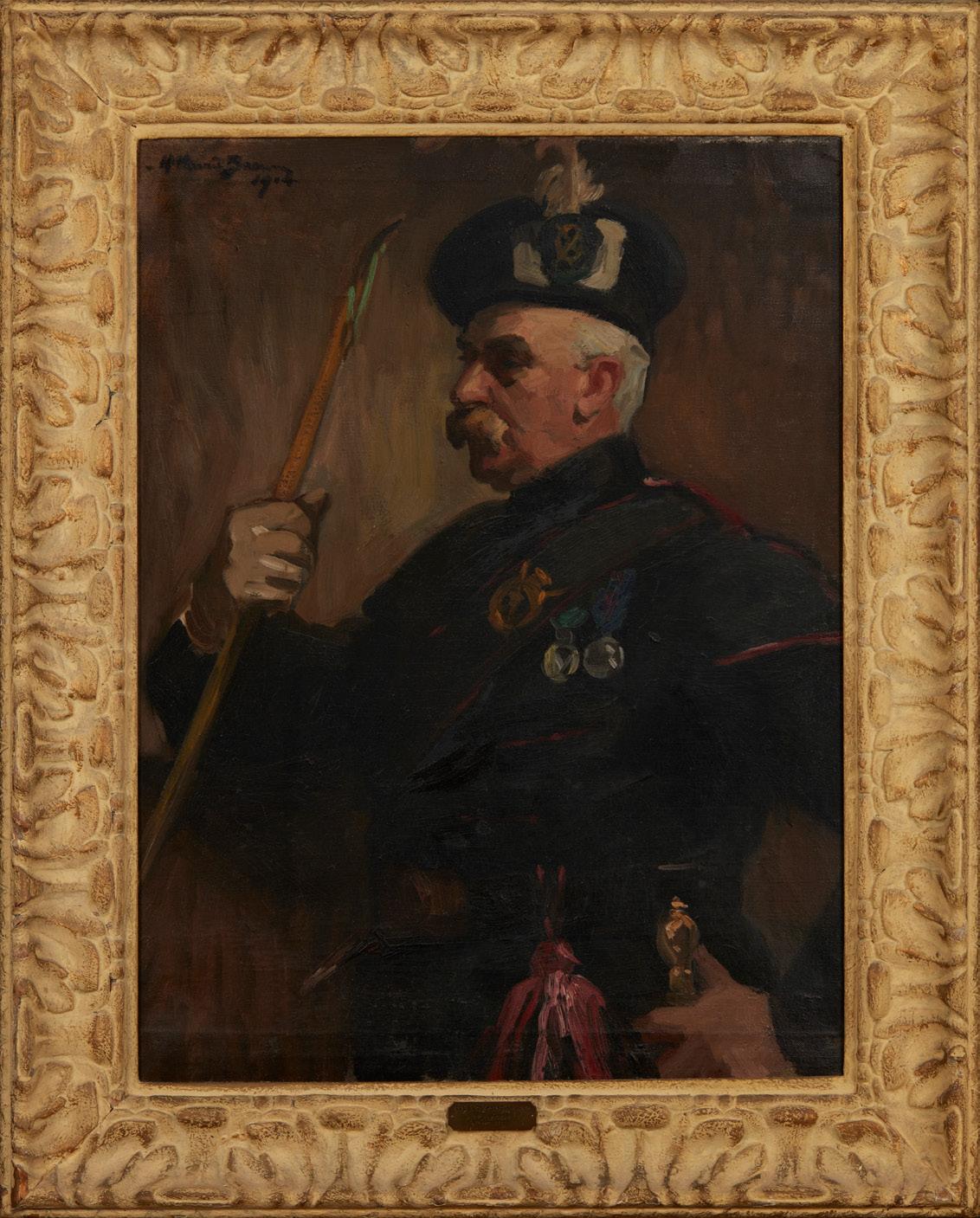
Signed and dated upper left, oil on canvas
67cm x 49.75cm (26.5in x 19.5in)
£600-800
369
19TH CENTURY SCOTTISH SCHOOL
PORTRAIT OF A GORDON HIGHLAND OFFICER

Oil on board
24cm x 18.5cm (9.5in x 7.5in)
£500-800
370
A CASED GEORGE V DIRK

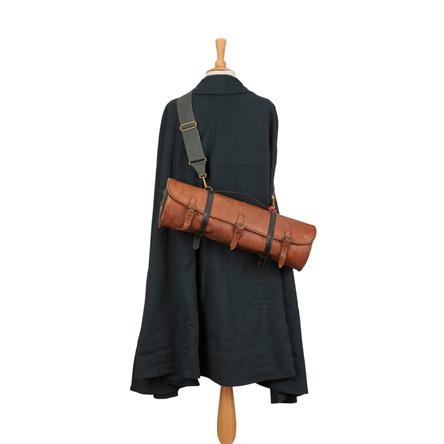



the basket weave carved handle with Celtic border, claw set citrine to pommel, the leathercovered wooden scabbard with applied silver mounts decorated with Celtic knotwork, set with bi knife and fork, with a single fuller scalloped blade, in a fitted case with a pair of Celtic shoe buckles and later sporran chain Blade 25cm long, overall 45cm £1,000-1,500
371
A

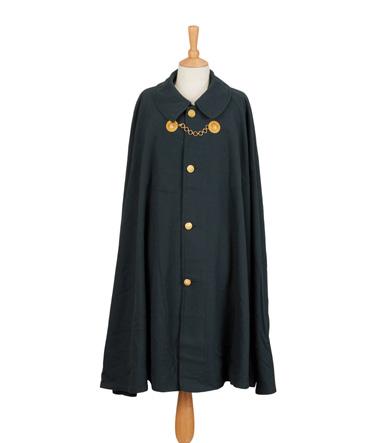
134 Other fees apply in addition to the hammer price: see the ‘Buyer’s Guide’ section on page 2
VICTORIAN ROYAL COMPANY OF ARCHER’S UNIFORM comprising a tailcoat, frock coat and sash, trousers, cloak, boots, contained in a metal trunk, named to lid Brigadier A W E Crawford; together with seven spare small buttons £600-800
372
HENRY HARRIS BROWN
THE YOUNG PIPER


Signed and dated 1914, signed verso, oil on canvas
112cm x 126cm (44in x 50in)
£1,000-1,500
ARMS, MILITARIA & HIGHLAND DRESS


VICTORIAN OFFICER’S FEATHER BONNET
LATE 19TH CENTURY
of conventional form with six tails, with red and white diced headband, inside the original black toleware case, the top painted ‘Argyll & Sutherland Highlanders’, with a white feather plume, also in an original tin case (2) case 53cm high
£500-700
374
A VICTORIAN ROYAL COMPANY OF ARCHER’S BI-CORN HAT

MID-19TH CENTURY
of traditional form with large gold bullion badge and twin tassels, in a fitted metal case, together with plume in its own metal and leather case; together with a metal travelling trunk containing Lord Lieutenant bi-corn hat and cut steel dress sword, leather shoes, and black waistcoat and dress trousers, the trunk inscribes J W Greig Esquire CBKC (2)
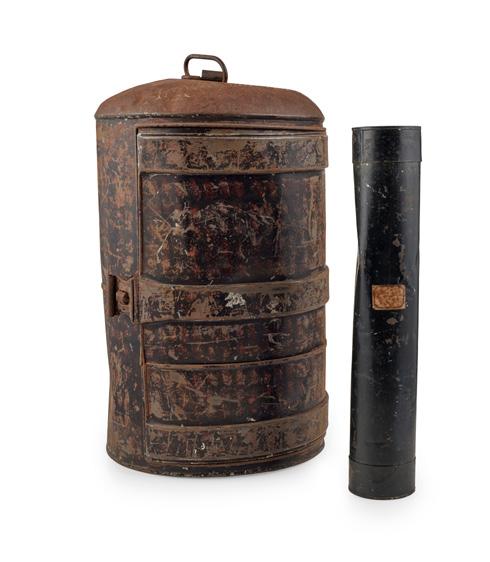
£300-500
375
A ROYAL MIDLOTHIAN YEOMANRY CALVARY HELMET
MID-19TH CENTURY
the brass helmet with applied copper badges, crown and named to the front with silver plated chin strap, red horse hair plume, the interior with black leather lining

33cm high
£600-800
376
A 20THCENTURY ARGYLL & SUTHERLAND HIGHLANDERS SPORRAN
NICOL BROTHERS, BANKFOOT
the arched cantle with leather insert set with a regimental badge with black horse hair body and six white horse hair tassels, the leather pouch with hinged opening; together with a white belt


Cantle 15cm wide, 38cm long
£200-300
373
137 Other fees apply in addition to the hammer price: see the ‘Buyer’s Guide’ section on page 2
377
VICTORIAN SCOTS GUARDS
PIPE BANNER
LATE 19TH CENTURY
gilt and coloured threads on a blue silk ground, bearing the Union Badge (rose, thistle and shamrock), with the motto ‘UNITA FORTIOR’ (Stronger in unity), with Sphinx below, the edges with gilt thread fringe

78cm long, 55cm wide
£300-500
378 Y
A SET OF SILVER PLATED AND IVORY MOUNTED BAGPIPES
20TH CENTURY
turned black hardwood with turned ivory mounts and plated collars, plain green velvet bag, with cream drone cords and green tassels, with additional chanter

largest drone 80cm long
Note: With non-transferable CITES self-certification number: YRENMMKA
£800-1,200
379
GROUP OF SCOTTISH BATONS AND TRUCHEONS

19TH CENTURY
including a brown painted William IV baton with gilt crown, cypher, ‘County of Edin’ and numbered ‘G 12’; two Victorian ebonised batons with gilt crown, cypher and ‘1.Rest. Com Ward’, one 15 Ward and the other 23 Ward; a similar Victorian ebonised baton with gilt crown, cypher, coat of arms for Edinburgh and ‘Dean of Guilds Baton’; a Victorian black painted truncheon with gilt coat of arms for Edinburgh, numbered ‘Dis.5, No.8’ and a crown and cypher below; together with a novelty Mauchline ware birch truncheon, the handle detaching to an interior compartment, probably for knitting needles (6) largest 68cm long
£1,000-1,500

139 Other fees apply in addition to the hammer price: see the ‘Buyer’s Guide’ section on page 2
380
AN EARLY VICTORIAN CIVILIAN DIRK
the basket weave carved handle to a plain pommel, the leather-covered wooden scabbard with applied plain mounts, set with bi knife and fork, with a single fuller scalloped blade
Blade 29cm long, overall 44cm £400-600
381
AN EDWARDIAN ARGYLL AND SUTHERLAND HIGHLANDER’S DIRK
H. WILKINSON
the basket weave carved handle with applied silver studs and Greek Key border, collet set paste to pommel, the leather-covered wooden scabbard with applied mounts with Regimental badges, set with bi knife and fork, the etched single fuller scalloped blade with Royal cypher and Regimental emblems
Blade 30cm long, overall 46cm £1,200-1,800
382
A SCARCE VICTORIAN 79TH HIGHLANDERS (CAMERON HIGHLANDERS) OFFICER’S DIRK
the basket weave carved handle with applied silver studs and thistle borders collet set citrine to pommel, the leather-covered wooden scabbard with applied silver mounts with St. Andrew on the cross and regimental number in gilt, set side by side with bi knife and fork, with a single fuller scalloped blade Blade 27cm long, overall 44cm £1,500-2,500
140 Other fees apply in addition to the hammer price: see the ‘Buyer’s Guide’ section on page 2
383
A RARE VICTORIAN ARGYLLSHIRE HIGHLANDERS OFFICER’S DIRK
BY
MARSHALL
& SONS OF EDINBURGH
marked to the top mount and with registration diamond for 26th March 1864, the basket weave carved baluster handle with simple collet set pommel with foil backed crystal, the mount with Regimental name, the etched blade with Regimental name, number and royal cypher, with owner’s initials stamped ‘HFCJ’, the leather-covered wooden scabbard with silver mount with XCI and Victorian cypher, set with side by side bi knife and fork Blade 25.5cm long, overall 43cm
Note: The initials etched to the blade have made it possible to attribute this dirk as the personal dirk carried by Henry F Campbell-Johnston, who rose to the rank of Sub-Lieutenant, 5th June 1875 and Lieutenant two years later in 1877. He served in the Zulu War of 1879, was present at the battle of Ginginhlovo and relief of Ekowe and was awarded medal and bar. He was invalided home shortly after. He would later serve in Mauritius with a smaller detachment of the regiment.
£1,800-2,000
384
A RARE LATE 18TH CENTURY 79TH REGIMENT OF FOOT (CAMERON HIGHLANDERS) OFFICER’S DIRK
the basket weave carved wooden grip with simple studded detail, collet set to pommel with foil backed stone, the single fuller blade with scalloped back edge and spear point, the gilt copper scabbard with engraved displayed rose and thistles, cross-hatched designs, set with bi knife and fork to match main handle
Blade 26.7cm long, overall 43.5cm
Note: A virtually identical dirk is in the collection of The Highlanders Museum (Fort George) with provenance to first Major Alexander Cruickshank of the 79th Highlanders. This pattern is often confused for the similar style of the 71st Highlanders.
£2,000-3,000
141
385
THE SEAFORTH HIGHLANDER INTEREST- A PRESENTATION SILVER STATUE
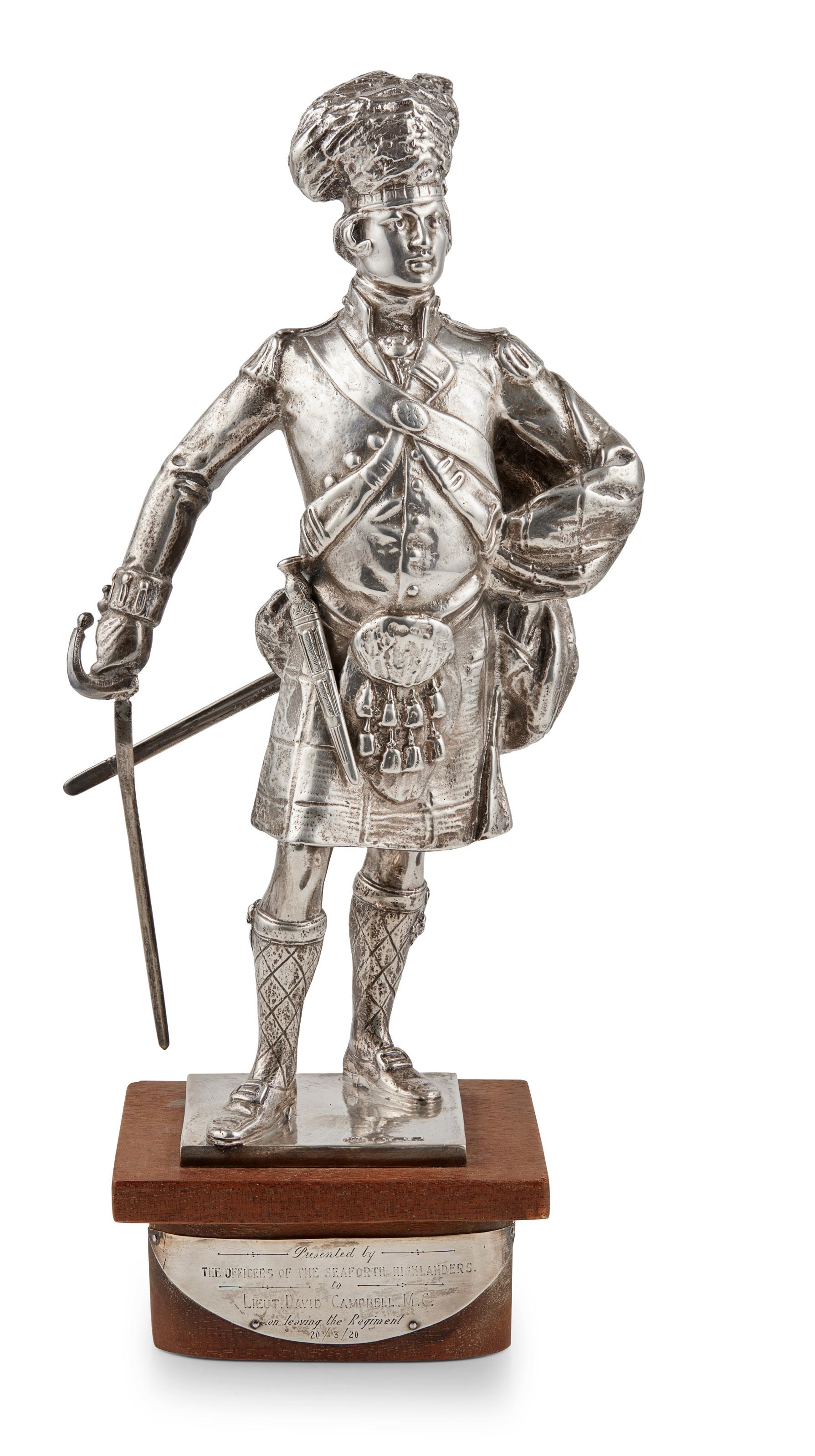
ELKINGTON & CO., BIRMINGHAM 1920
modelled on the painting by Sir Thomas Lawrence R.A. given to Lieutenant David Campbell M.C., surmounting a wooden plinth, with engraved presentation plaque ‘...Lieut. David Campbell M.C., on leaving the Regiment 20/3/20’
32cm high
£1,000-1,500
386
A BOER WAR AND LATER GROUP OF MEDALS AWARDED TO PRIVATE S. MUIRHEAD, 4383, ARGYLL & SUTHERLAND HIGHLANDERS comprising the Queen’s South Africa Medal, with bars, Cape Colony, Paarenberg, Driefontein, Transvaal, and the King’s South Africa medal with bars, South Africa 1901, 1902 and a long service George V medal; together with a group of WW1 medals, awarded to Private J. Duff, 14526, King’s Own Borderers, comprising the 1914-15 star with papers, a Victory medal 1914-19 with papers, and a British war medal and a memorial plaque with papers; together with a plaid brooch, a snuff box and ribbon (qty)
Note: Private J. Duff was killed in action on the 25th of September 1915.
He is buried at Loos en Gohelle, Pas de Calais in France
£300-500
387
A GORDON HIGHLANDER’S DESK STAND
the arched wooden frame set with an Officer’s plaid brooch above a Perspex glazed panel with a section of Gordon Highlanders tartan behind; together with a Seaforth Highlander Officer swagger stick the silver ball finial hallmarked London 130, with a regimental badge and engraved initials HWH (2)
Desk stand 35.5cm wide
£150-250
142 Other fees apply in addition to the hammer price: see the ‘Buyer’s Guide’ section on page 2
388
A FRAMED WATERCOLOUR OF A BLACK WATCH OFFICER
by E.A. A . Campbell November ‘99, shown in full officer’s levée dress; together with another by the same artist, titled private. Marching order ‘86, likely showing Pte Alexander McKay, in full dress with medals, of each in modern mounts and frames (2)

Image size: 16cm x 25cm, 10.5 cm x 20.5cm
Note: While it was initially considered the sitter for the first piece in this lot was Major-General Sir Hector Archibald MacDonald and perhaps copied from a known portrait or photograph of him, some of the uniform accessories appear to be for the Black Watch / 42nd Regiment of which he was never a member.
£300-500
390
A VICTORIAN PLAID BROOCH
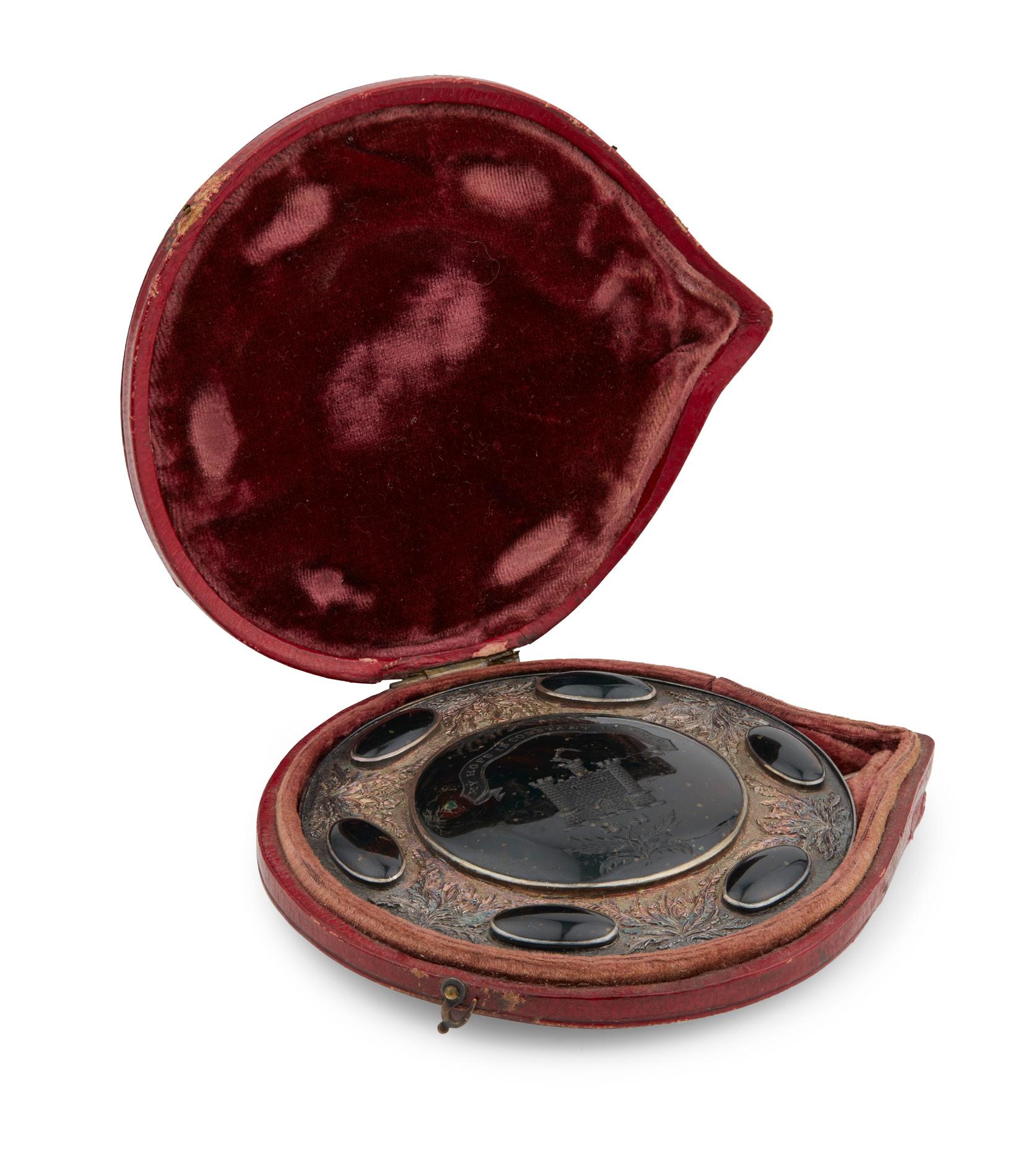
SUSANNA COOK, LONDON 1848
of shaped circular outline with cast border of holly leaves and berries on a textured back ground, the centre applied with a standing stag on a heraldic torse 9.5cm diameter, 2.7oz

£300-500
389
A CLAN MACDONALD BLOODSTONE SET
PLAID BROOCH
WILLIAM IV, CIRCA 1830S
of circular outline, collet set to the border with six oval bloodstone cabochons, in amongst finely chased thistles, the central circular hardstone disc, with engraved crest and motto of Macdonald, the reverse engraved ‘PRESENTED TO ANGUS MACDONALD ..... as a memory of his ancestors...’ further inscribed below with a quote from a Robert Burns song, presented in a burgundy morocco leather case with padded velvet lining 8.5cm diameter
£700-1,000
143
393
MORTLACH 1972
23 YEAR OLD
limited edition bottle number 1141
750ml/ 59.4%
£800-1,200
WHISKY SPEYSIDE
391
LINKWOOD 1972
23 YEAR OLD - RARE MALTS



SELECTION
limited edition bottle number 0055
750ml/ 58.4%
£400-600
392
LINKWOOD 1939 -

with associated case
75cl/ 40%
£1,200-1,800
GORDON & MACPHAIL
144 Other fees apply in addition to the hammer price: see the ‘Buyer’s Guide’ section on page 2
394
GLENDULLAN 1973 23 YEAR OLD - RARE MALTS SELECTION bottled in 1997, limited edition bottle number 0637, with carton
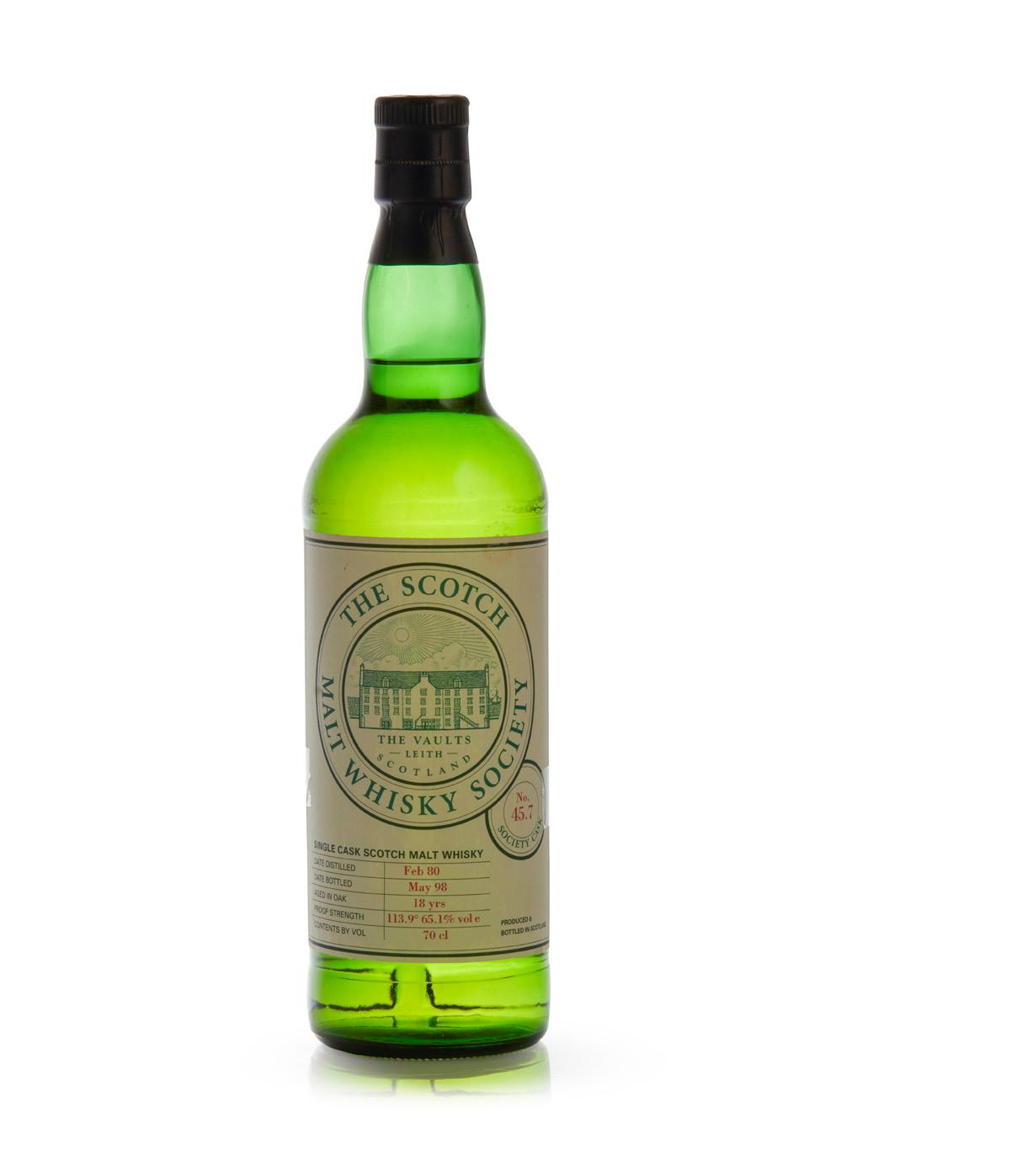

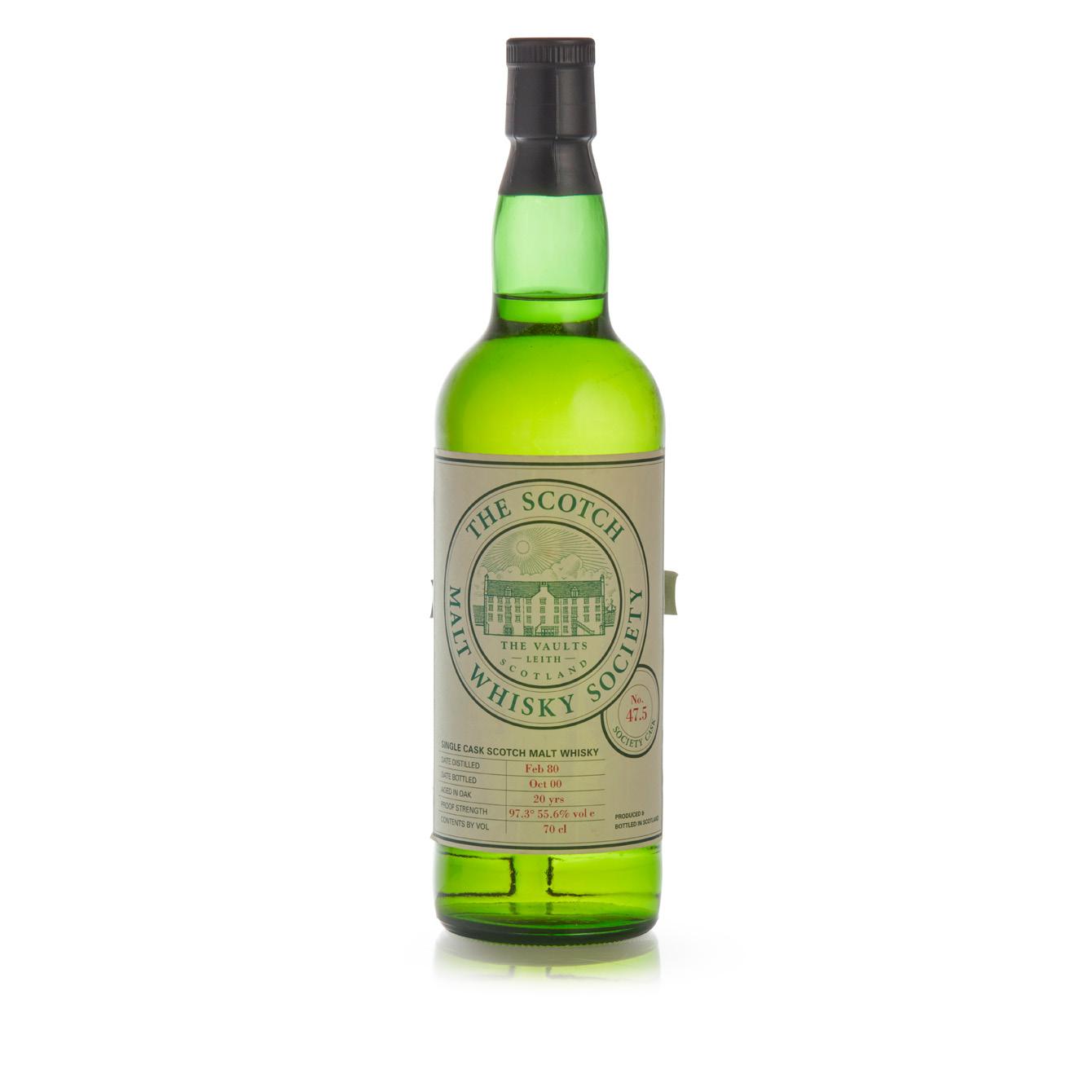
75cl/ 58.6%
£300-500
395
DAILUAINE 1973 22 YEAR OLD - RARE MALTS SELECTION


limited edition bottle number 0242
75cl/ 60.92%
£300-500
396
BENROMACH 1980 20 YEAR OLD 47.5THE SCOTCH MALT WHISKY SOCIETY bottled in 2000, with carton
70cl/ 55.6% (97.3 proof)
£150-250
GLEN MORAY 1988 25 YEAR OLD PORT CASK FINISH limited edition bottling, bottle number 003025, with presentation case
145
HIGHLAND, LOWLAND, ISLANDS, ISLAY & IRISH
399
STRATHISLA 1991 15 YEAR OLD
- CASK STRENGTH EDITION
cask strength, non chill-filtered, bottled in 2006
50cl/ 55.9%
£80-120
AUCHENTOSHAN 1978 18 YEAR OLD with case, bottled in 1997
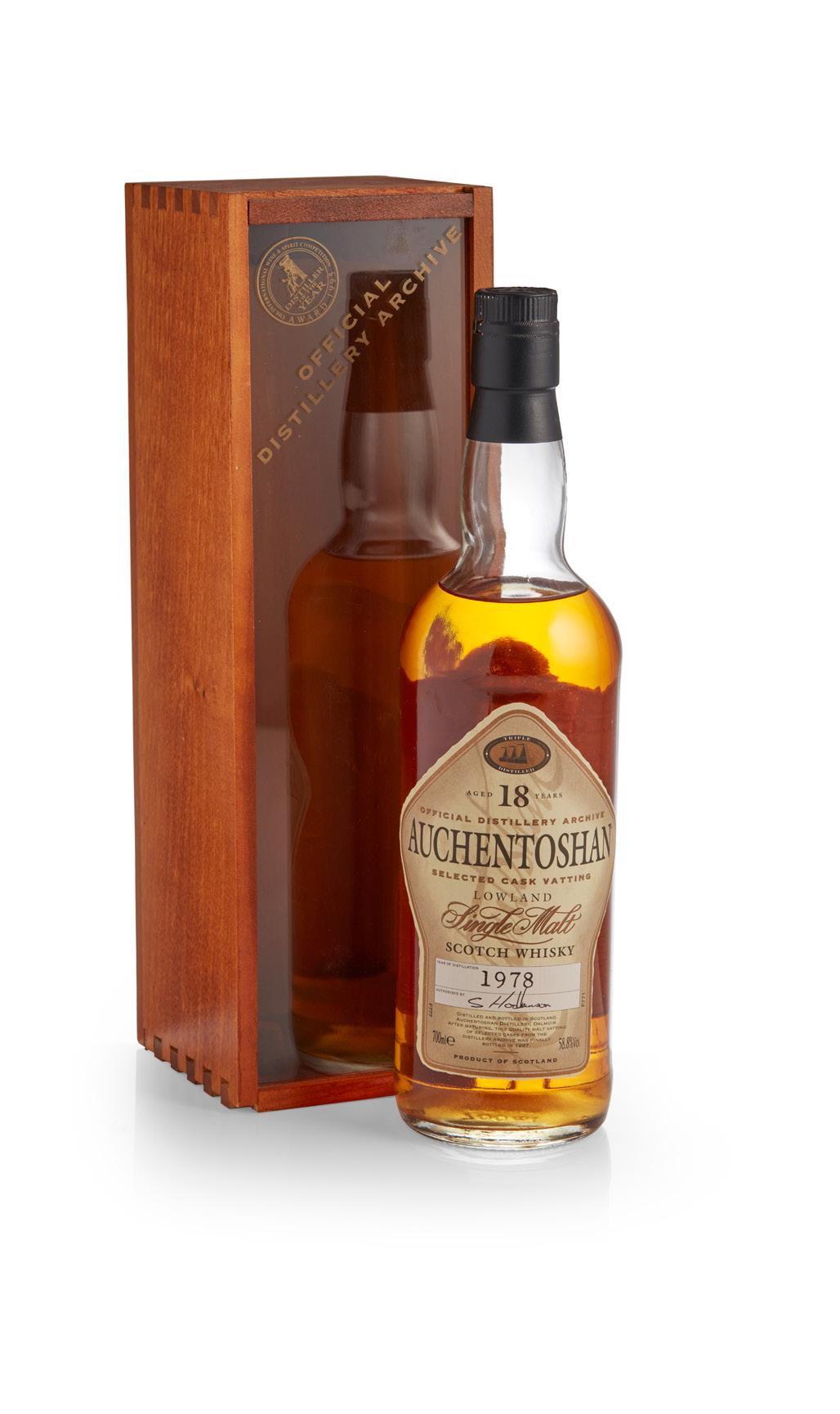

ROYAL LOCHNAGAR 1972
24 YEAR OLD - RARE MALTS


SELECTION
bottled 1997, limited edition bottle number 0025, with carton

75cl/ 55.7%
£300-500
GLENMORANGIE 1995 11 YEAR OLD 125.2
- THE SCOTCH MALT WHISKY SOCIETY bottled in 2006, with carton
403
BLAIR ATHOL 1985 20 YEAR OLD 68.9
- THE SCOTCH MALT WHISKY SOCIETY bottled in 2005, with carton
70cl/ 54.3% (95.0 proof)
£300-500
146 Other fees apply in addition to the hammer price: see the ‘Buyer’s Guide’ section on page 2
HIGHLAND PARK 17 YEAR OLD


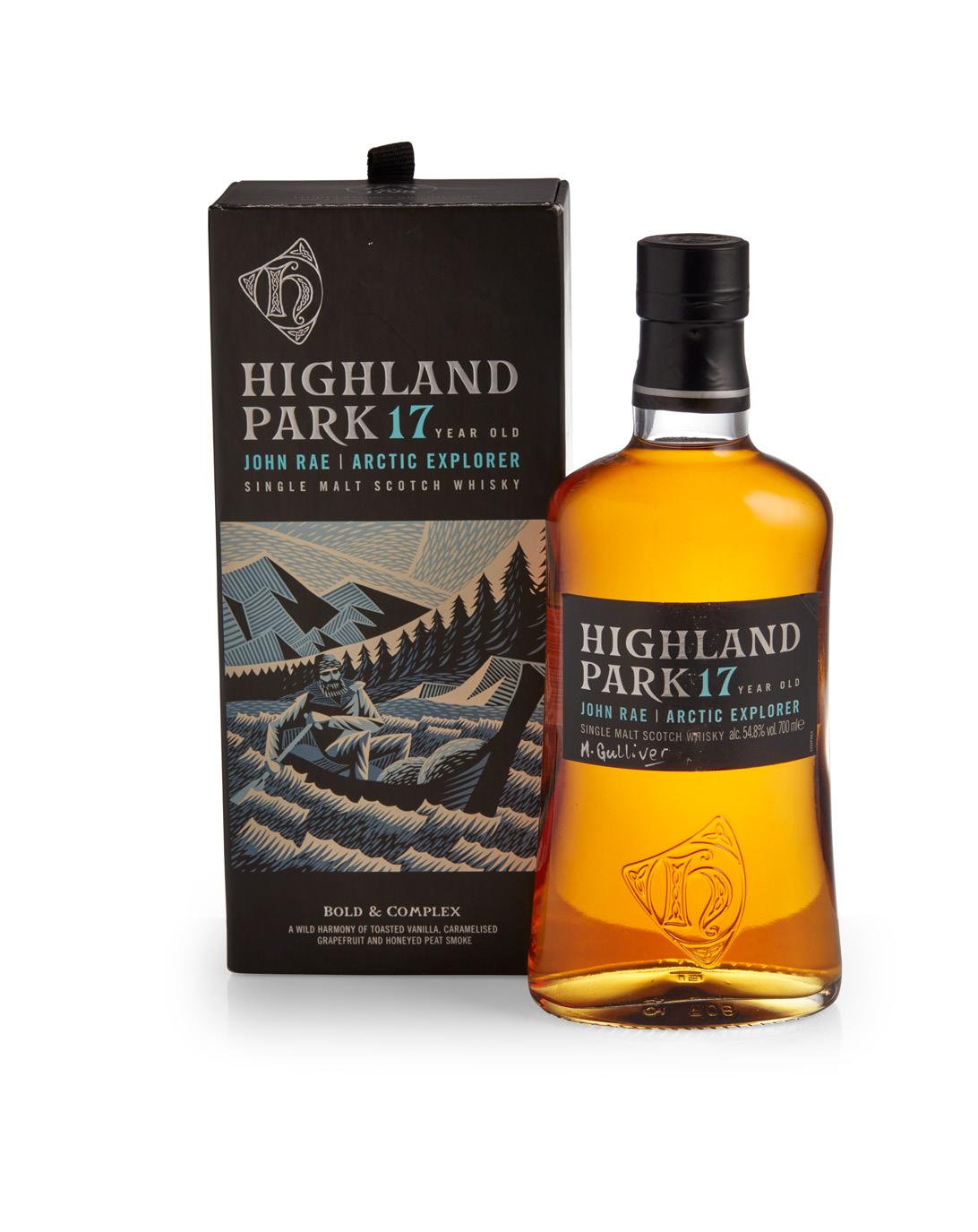
-
HIGHLAND PARK 12 YEAR OLD - ORKNEY SCIENCE FESTIVAL
limited edition of 30 bottles, bottled to commemorate the bicentenary of the birth in 1813 of John Rae, signed M. GULLIVER, with carton
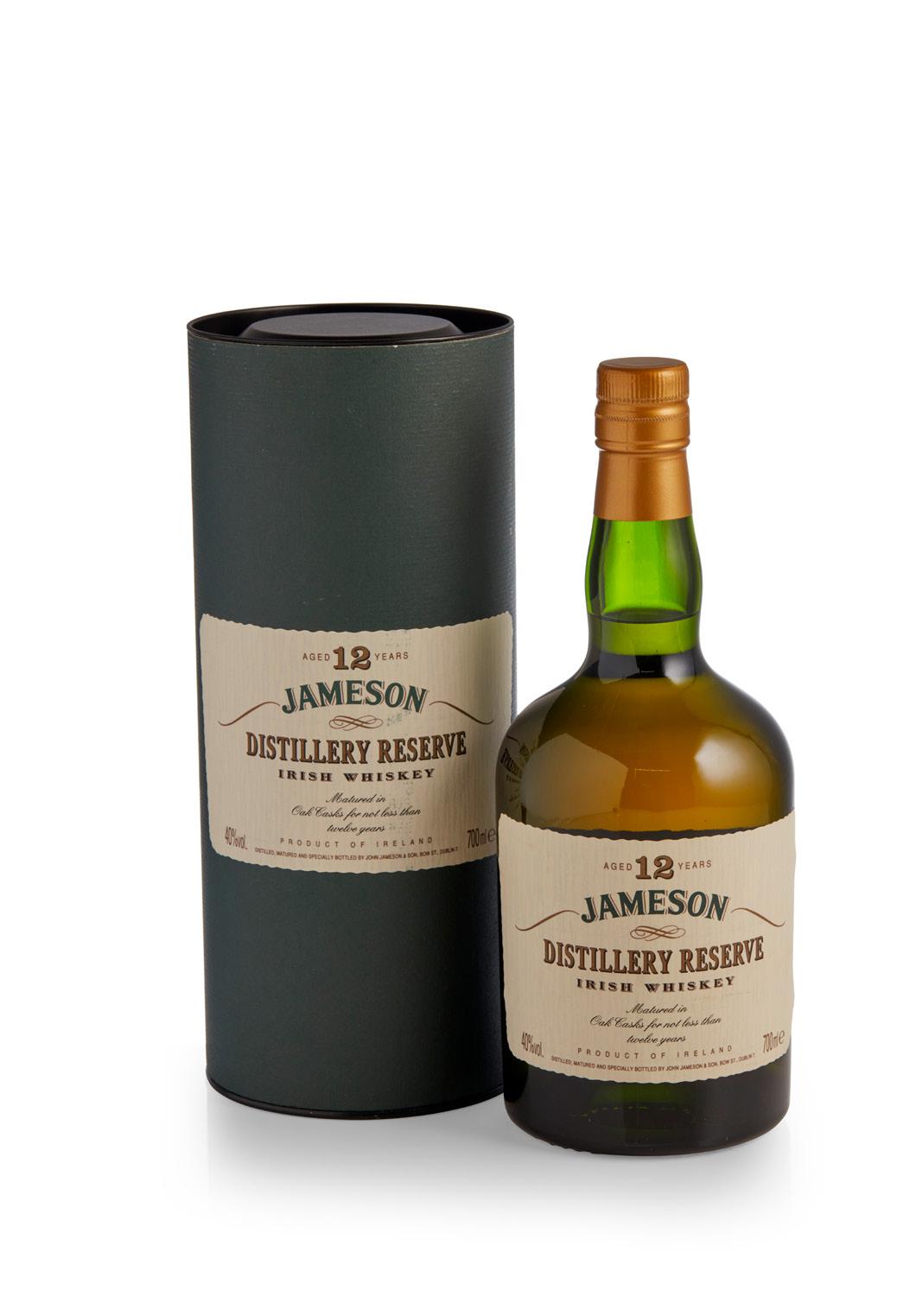
Note: John Rae, native of Orkney, was without doubt one of the Victorian eras most celebrated explorers and navigators. His most famous feat was his part in discovering the final link in the treacherous North West Passage. As noted by Highland Park who created this limited edition to celebrate this famous Orkney native ‘in covering thousands of miles of uncharted terrain in the harshest conditions, he showed courage, fortitude, determination and warm humanity that marks him as one of the greatest Arctic explores of all time’. This bottle, and the preceding lot, were sold to benefit the continued work of the John Rae Society, to find out more visit johnraesociety.com.
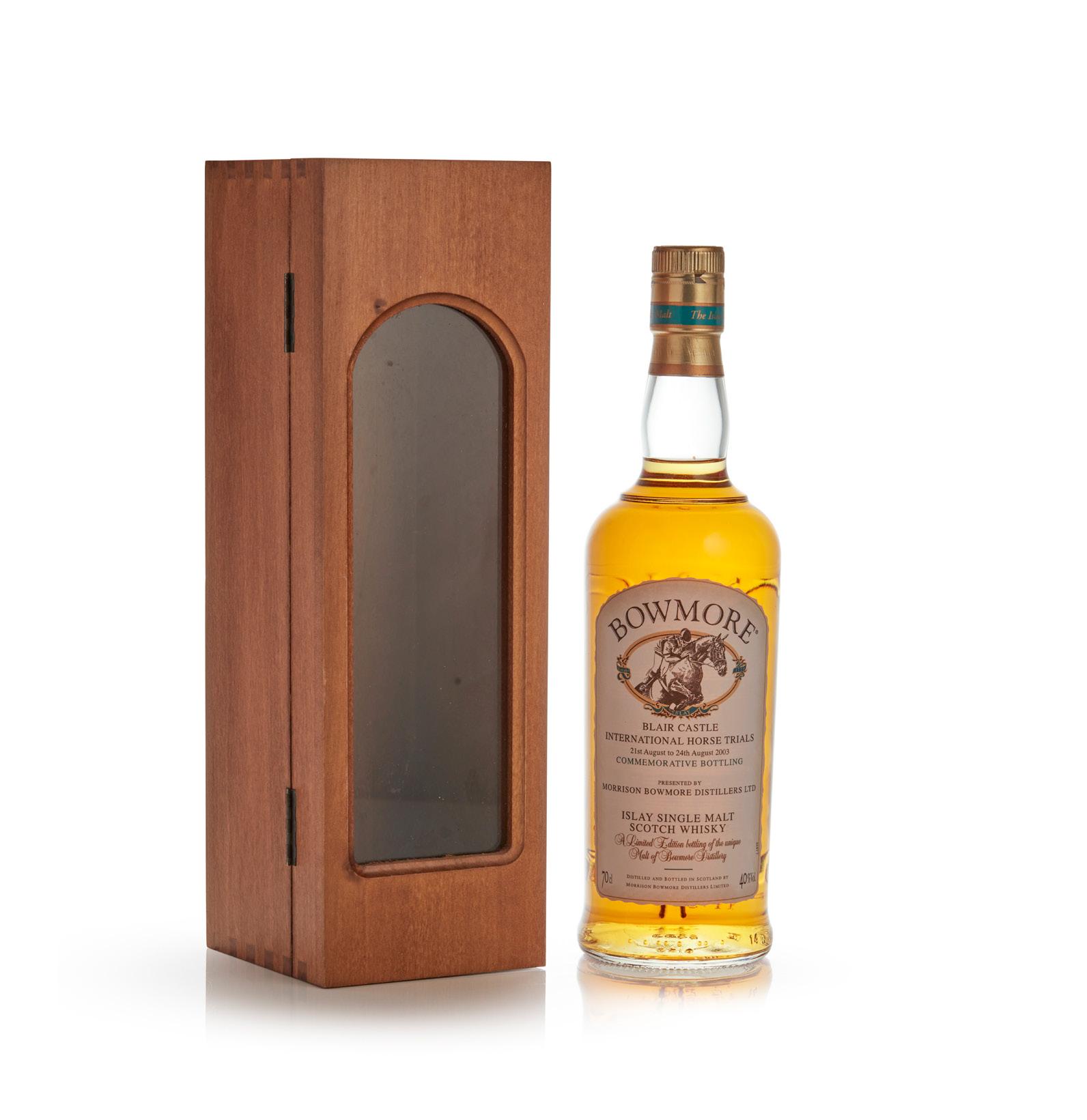
404
JOHN RAE ARCTIC EXPLORER bottle signed M. GULLIVER, with box 700ml/ 54.8% £150-200
HIGHLAND PARK 25 YEAR OLD
147
CONDITIONS OF SALE
FOR BUYERS (UK)
These Conditions of Sale and the Saleroom Notices as well as specific Catalogue terms, set out the terms on which we offer the Lots listed in this Catalogue for sale. By registering to bid and/or by bidding at auction You agree to these terms, we recommend that You read them carefully before doing so. You will find a list of definitions and a glossary at the end providing explanations for the meanings of the words and expressions used. Special terms may be used in Catalogue descriptions of particular classes of items (Books, Jewellery, Paintings, Guns, Firearms, etc.) in which case the descriptions must be interpreted in accordance with any glossary appearing in the Catalogue. These notices and terms will also form part of our terms and conditions of sales.
In these Conditions the words “Us”, “Our”, “We” etc. refers to Lyon & Turnbull Ltd, the singular includes the plural and vice versa as appropriate. “You”, “Your” means the Buyer. Lyon & Turnbull Ltd. acts as agent for the Seller. Lyon & Turnbull Ltd. acts as agent for the Seller. On occasion where Lyon & Turnbull Ltd. own a lot in part or full the property will be identified in the catalogue with the symbol (��) next to its lot number.
A. BEFORE THE SALE
1. DESCRIPTIONS OF LOTS
Whilst we seek to describe Lots accurately, it may be impractical for us to carry out exhaustive due diligence on each Lot. Prospective Buyers are given ample opportunities to view and inspect before any sale and they (and any independent experts on their behalf) must satisfy themselves as to the accuracy of any description applied to a Lot. Prospective Buyers also bid on the understanding that, inevitably, representations or statements by us as to authorship, genuineness, origin, date, age, provenance, condition or Estimated selling price involve matters of opinion. We undertake that any such opinion shall be honestly and reasonably held and only accept liability for opinions given negligently or fraudulently. Subject to the foregoing neither we the Auctioneer or our employees or agents accept liability for the correctness of such opinions and no warranties, whether relating to description, condition or quality of Lots, express, implied or statutory, are given. Please note that photographs/ images provided may not be fully representative of the condition of the Lot and should not be relied upon as indicative of the overall condition of the Lot. All dimensions and weights are approximate only.
2. OUR RESPONSIBILITY FOR OUR DESCRIPTION OF LOTS
We do not provide any guarantee in relation to the nature of a Lot apart from our authenticity warranty contained in paragraph E.2 and to the extent provided below.
(a) Condition Reports: Condition Reports are provided on our Website or upon request. The absence of a report does not imply that a Lot is without imperfections. Large numbers of such requests are received shortly before each sale and department specialists and administration will endeavour to respond to all requests although we offer no guarantee. Any statement in relation to the Lot is merely an expression of opinion of the Seller or us and should not be relied upon as an inducement to bid on the Lot. Lots are available for inspection prior to the sale and You are strongly advised to examine any Lot in which You are interested prior to the sale. Our Condition Reports are not prepared by professional conservators, restorers or engineers. Our Condition Report does not form any contract between us and the Buyer. The Condition Reports do not affect the Buyer’s obligations in any way.
(b) Estimates: Estimates are placed on each Lot to help Buyers gauge the sums involved for the purchase of a particular Lot. Estimates do not include the Buyer’s Premium or VAT. Estimates are a matter of opinion and prepared in advance. Estimates may be subject to change and are for guidance only and should not be relied upon.
(c) Catalogue Alterations: Lot descriptions and Estimates are prepared in advance of the sale and may be subject to change. Any alterations will be announced on the Catalogue alteration sheet, made available prior to the sale. It is the responsibility of the Buyer to make themselves aware to any alterations which may have occurred.
3. WITHDRAWAL
Lyon & Turnbull may, at its discretion, withdraw any Lot at any time prior to or during the sale of the Lot. Lyon & Turnbull has no liability to You for any decision to withdraw.
4. JEWELLERY, CLOCKS & OTHER ITEMS
(a) Jewellery:
(i) Coloured gemstones (such as rubies, sapphires and emeralds) may have been treated to enhance their look, through methods such as heating and oiling. These methods are accepted practice but may make the gemstone less strong and/or require special care in future.
(ii) All types of gemstones may have been improved by some method. You may request a gemmological report for any Lot which does not have a report if the request is made to us at least
three weeks before the date of the sale and You pay the fee for the report in advance of receiving said report.
(iii) We do not obtain a gemmological report for every gemstone sold in our sales. Where we do get gemmological reports from internationally accepted gemmological laboratories, such reports may be described in the Sale Particulars. Reports will describe any improvement or treatment only if we request that they do so, but will confirm when no improvement or treatment has been made. Because of differences in approach and technology, laboratories may not agree whether a particular gemstone has been treated, the amount of treatment or whether treatment is permanent. The gemmological laboratories will only report on the improvements or treatments known to the laboratories at the date of the report.
(iv) For jewellery sales, all Estimates are based on the information in any gemmological report or, if no gemmological report is available, You should assume that the gemstones may have been treated or enhanced.
(b) Clocks & Watches: All Lots are sold “as seen”, and the absence of any reference to the condition of a clock or watch does not imply the Lot is in good condition and without defects, repairs or restorations. Most clocks and watches will have been repaired during their normal lifetime and may now incorporate additional/newer parts. Furthermore, we make no representation or warranty that any clock or watch is in working order. As clocks and watches often contain fine and complex mechanisms, Buyers should be aware that a general service, change of battery or further repair work, for which the Buyer is solely responsible, may be necessary. Buyers should also be aware that we cannot guarantee a watch will remain waterproof if the back is removed. Buyers should be aware that the importing watches such as Rolex, Frank Muller and Corum into the United States is highly restricted. These watches cannot be shipped to the USA and only imported personally. Clocks may be sold without pendulums, weights or keys.
(c) Alcohol: may only be sold to persons aged of 18 years and over. By registering to bid, You affirm that You are at least that age. All collections must be signed for by a person over the age of 18. We Reserve the right to ask for ID from the person collecting. Buyers of alcohol must make appropriate allowances for natural variations of ullages, conditions of corks and wine. We can provide no guarantees as to how the alcohol may have been stored. There is always a risk of cork failure and allowance by the Buyer must be made. Alcohol is sold “as is” and quality of the alcohol is entirely at the risk of the Buyer and no warranties are given.
(d) Books-Collation: If on collation any named item in the sale Catalogue proves defective, in text or illustration the Buyer may reject the Lot provided he returns it within 21 days of the sale stating the defect in writing. This, however, shall not apply in the case of unnamed items, periodicals, autographed letters, music M.M.S., maps, drawings nor in respect of damage to bindings, stains, foxing, marginal worm holes or other defects not affecting the completeness of the text nor in respect of Defects mentioned in the Catalogue, or at the time of sale, nor in respect of Lots sold for less than £300.
(e) Electrical Goods: are sold as “works of art” only and if bought for use must be checked over for compliance with safety regulations by a qualified electrician first. Use of such goods is entirely at the risk of the Buyer and no warranties as to safety of the goods are given.
(f) Upholstered items: are sold as “works of art” only and if bought for use must be checked over for compliance with safety regulations (items manufactured prior to 1950 are exempt from any regulations). Use of such goods is entirely at the risk of the Buyer and no warranties as to safety of the goods are given. We provide no guarantee as to the originality of any wood/material contained within the item.
B. REGISTERING TO BID
1. NEW BIDDERS
(a) If this is Your first time bidding at Lyon & Turnbull or You are a returning Bidder who has not bought anything from us within the last two years You must register at least 48 hours before an auction to give us enough time to process and approve Your registration. We may, at our discretion, decline to permit You to register as a Bidder. You will be asked for the following:
(i) Individuals: Photo identification (driving licence, national identity card or passport) and, if not shown on the ID document, proof of Your current address (for example, a current utility bill or bank statement)
(ii) Corporate clients: Your Certificate of Incorporation or equivalent document(s) showing Your name and registered address together with documentary proof of directors and beneficial owners, and;
(iii) Trusts, partnerships, offshore companies and other business structures please contact us directly in advance to discuss requirements.
(b) We may also ask You to provide a financial reference and/or a deposit to allow You to bid. For help, please contact our Finance Department on +44(0)131 557 8844.
2. RETURNING BIDDERS
We may at our discretion ask You for current identification as described in paragraph B.1.(a) above, a finance
148
22.3
reference or a deposit as a condition of allowing You to bid. If You have not bought anything from us in the last two years, or if You want to spend more than on previous occasions, please contact our Finance Department on +44(0)131 557 8844.
3. FAILURE TO PROVIDE THE RIGHT DOCUMENTS
If in our opinion You do not satisfy our Bidder identification and registration procedures including, but not limited to, completing any anti-money laundering and/or anti-terrorism financing checks we may require to our satisfaction, we may refuse to register You to bid, and if You make a successful bid, we may cancel the contract between You and the Seller.
4. BIDDING ON BEHALF OF ANOTHER PERSON
(a) As an authorised Bidder: If You are bidding on behalf of another person, that person will need to complete the registration requirements above before You can bid, and supply a signed letter authorising You to bid for him/ her.
(b) As agent for an undisclosed principal: If You are bidding as an agent for an undisclosed principle (the ultimate Buyer(s)) You accept personal liability to pay the Purchase Price and all other sums due, unless it has been agreed in writing with us before commencement of the auction that the Bidder is acting as an agent on behalf of a named third party acceptable to us and we will seek payment from the named third party.
5. BIDDING IN PERSON
If You wish to bid in the saleroom You must register for a numbered bidding paddle before You begin bidding. Please ensure You bring photo identification with You to allow us to verify Your registration.
6. BIDDING SERVICES
The bidding services described below are a free service offered as a convenience to our clients and we are not responsible for any error (human or otherwise), omission or breakdown in providing these services.
(a) Phone bids
Your request for this service must be made no later than 12 hours prior to the auction. We will accept bids by telephone for Lots only if our staff are available to take the bids. If You need to bid in a language other than English You should arrange this Well before the auction. We do not accept liability for failure to do so or for errors and omissions in connections.
(b) Internet Bids
For certain auctions we will accept bids over the internet. For more information please visit our Website. We will use reasonable efforts to carry out online bids and do not accept liability for equipment failure, inability to access the internet or software malfunctions related to execution of online bids/ live
bidding.
(c) Written Bids
While prospective Buyers are strongly advised to attend the auction and are always responsible for any decision to bid for a particular Lot and shall be assumed to have carefully inspected and satisfied themselves as to its condition we shall, if so instructed, clearly and in writing execute bids on their behalf. Neither the Auctioneer nor our employees nor agents shall be responsible for any failure to do so. Where two or more commission bids at the same level are recorded we Reserve the right in our absolute discretion to prefer the first bid so made. Bids must be expressed in the currency of the saleroom. The Auctioneer will take reasonable steps to carry out written bids at the lowest possible price, taking into account the Reserve. If You make a written bid on a Lot which does not have a Reserve and there is no higher bid than Yours, we will bid on Your behalf at around 50% of the lower Estimate or, if lower, the amount of Your bid.
C. DURING THE SALE
1. ADMISSION TO OUR AUCTIONS
We shall have the right at our discretion, to refuse admission to our premises or attendance at our auctions by any person. We may refuse admission at any time before, during or after the auction.
2. RESERVES
Unless indicated by an insert symbol (∆), all Lots in this Catalogue are offered subject to a Reserve. A Reserve is the confidential Hammer Price established between us and the Seller. The Reserve is generally set at a percentage of the low Estimate and will not exceed the low Estimate for the Lot.
3. AUCTIONEER’S DISCRETION
The maker of the highest bid accepted by the Auctioneer conducting the sale shall be the Buyer and any dispute shall be settled at the Auctioneer’s absolute discretion. The Auctioneer may move the bidding backwards of forwards in any way he or she may decide or change the order of the Lots. The Auctioneer may also; refuse any bid, withdraw any Lot, divide any Lot or combine any two or more Lots, reopen or continuing bidding even after the hammer has fallen.
4. BIDDING
The Auctioneer accepts bids from:
(a) Bidders in the saleroom;
(b) Telephone Bidders, and internet Bidders through Lyon & Turnbull Live or any other online bidding platform we have chosen to list on and;
(c) Written bids (also known as absentee bids or commission bids) left with us by a Bidder before the auction.
5. BIDDING INCREMENTS
Bidding increments shall be at the Auctioneer’s sole discretion.
6. CURRENCY CONVERTER
The saleroom video screens and bidding platforms may show bids in some other major currencies as Well as sterling. Any conversion is for guidance only and we cannot be bound be any rate of exchange used. We are not responsible for any error (human or otherwise) omission or breakdown in providing these services.
7. SUCCESSFUL BIDS
Unless the Auctioneer decides to use their discretion as set out above, when the Auctioneer’s hammer falls, we have accepted the last bid. This means a contract for sale has been formed between the Seller and the successful Bidder. We will issue an invoice only to the registered Bidder who made the successful bid. While we send out invoices by post/or email after the auction, we do not accept responsibility for telling You whether or not Your bid was successful. If You have bid by written bid, You should contact us by telephone or in person as soon as possible after the auction to get details of the outcome of our bid to avoid having to pay unnecessary storage charges.
8. RELEVANT LEGISLATION
You agree that when bidding in any of our sales that You will strictly comply with all relevant legislation including local laws and regulations in force at the time of the sale for the relevant saleroom location.
D. THE BUYER’S PREMIUM, TAXES AND ARTIST’S RESALE ROYALTY
1. THE PURCHASE PRICE
For each Lot purchased a Buyer’s Premium of 26% of the Hammer Price of each Lot up to and including £20,000, plus 25% from £20,001 to £500,000, plus 20% from £500,001 thereafter. VAT at the appropriate rate is charged on the Buyer’s Premium. No VAT is payable on the Hammer Price or premium for printed books or unframed maps bought at auction. Live online bidding may be subject to an additional premium (level dependent on the live bidding service provider chosen). This additional premium is subject to VAT at the appropriate rate as above.
2. VALUE ADDED TAX
Value Added Tax is charged at the appropriate rate prevailing by law at the date of sale and is payable by Buyers of relevant Lots.
(a) Lots affixed with (): Value Added Tax on the Hammer Price is imposed by law on all items affixed with a dagger (). This imposition of VAT maybe because the Seller is registered for VAT within the European Union and is not operating under a Margin Scheme.
(b) Lots affixed with (*): A reduced rate of Value Added Tax on the Hammer Price of 5% is payable. This indicates that a Lot has been imported from outwit the European Union. This
reduced rate is applicable to Antique items.
(c) Lots affixed with [Ω]: Standard rate of Value Added Tax on the Hammer Price and premium is payable. This applies to items that have been imported from outwit the European Union and do not fall within the reduced rate category outlined above.
3. ARTIST’S RESALE ROYALTY (DROIT DE SUITE)
This symbol § indicates works which may be subject to the Droit de Suite or Artist’s Resale Right, which took effect in the United Kingdom on 14th February 2006. We are required to collect a royalty payment for all qualifying works of art. Under new legislation which came into effect on 1st January 2012 this applies to living artists and artists who have died in the last 70 years. This royalty will be charged to the Buyer on the Hammer Price and in addition to the Buyer’s Premium. It wv zill not apply to works where the Hammer Price is less than €1,000 (euros). The charge for works of art sold at and above €1,000 (euros) and below €50,000 (euros) is 4%. For items selling above €50,000 (euros), charges are calculated on a sliding scale. All royalty charges are paid to the Design and Artists Copyright Society (‘DACS’) and no handling costs or additional fees are retained by the Auctioneer. Resale royalties are not subject to VAT. Please note that the royalty payment is calculated on the rate of exchange at the European Central Bank on the date of the sale. More information on Droit de Suite is available at www.dacs.org.uk.
E. WARRANTIES
1. SELLER’S WARRANTIES
For each Lot, the Seller gives a warranty that the Seller;
(a) Is the owner of the Lot or a joint owner of the Lot acting with the permission of the other co-owners, or if the Sellers is not the owner of or a joint owner of the Lot, has the permission of the owner to sell the Lot, or the right to do so in law, and;
(b) Had the right to transfer ownership of the Lot to the Buyer without any restrictions or claims by anyone else. If either other above warranties are incorrect, the Seller shall not have to pay more than the Purchase Price (as defined in the glossary) paid by You to us. The Seller will not be responsible to You for any reason for loss of profits or business, expected savings, loss of opportunity or interest, costs, damages, other damages or expense. The Seller gives no warranty in relation to any Lot other than as set out above and, as far as the Seller is allowed by law, all warranties from the Seller to You, and all obligations upon the Seller which may be added to this agreement by law, are excluded.
2. AUTHENTICITY GUARANTEE
We guarantee that the authorship,
149 Other fees apply in addition to the hammer price: see the ‘Buyer’s Guide’ section on page 2
period, or origin (collectively, “Authorship”) of each Lot in this Catalogue is as stated in the BOLD or CAPITALISED type heading in the Catalogue description of the Lot, as amended by oral or written saleroom notes or announcements. We make no warranties whatsoever, whether express or implied, with respect to any material in the Catalogue other than that appearing in the Bold or Capitalised heading and subject to the exclusions below.
In the event we, in our reasonable opinion, deem that the conditions of the authenticity guarantee have been satisfied, it shall refund to the original purchaser of the Lot the Hammer Price and applicable Buyer’s Premium paid for the Lot by the original purchaser. This Guarantee does not apply if:
(a) The Catalogue description was in accordance with the opinion(s) of generally accepted scholar(s) and expert(s) at the date of the sale, or the Catalogue description indicated that there was a conflict of such opinions; or
(b) the only method of establishing that the Authorship was not as described in the Bold or Capitalised heading at the date of the sale would have been by means or processes not then generally available or accepted; unreasonably expensive or impractical to use; or likely (in our reasonable opinion) to have caused damage to the Lot or likely to have caused loss of value to the Lot; or
(c) There has been no material loss in value of the Lot from its value had it been in accordance with its description in the Bold or Capitalised type heading. This Guarantee is provided for a period of one year from the date of the relevant auction, is solely for the benefit of the original purchaser of the Lot at the auction and may not be transferred to any third party. To be able to claim under this Authenticity Guarantee, the original purchaser of the Lot must:
(a) notify us in writing within one month of receiving any information that causes the original purchaser of record to dispute the accuracy of the Bold or Capitalised type heading, specifying the Lot number, date of the auction at which it was purchased and the reasons for such dispute; and
(b) return the Lot to our registered office in the same condition as at the date of sale to the original purchaser of record and be able to transfer good title to the Lot, free from any third party claims arising after the date of such sale.
We have discretion to waive any of the above requirements. We may require the original purchaser of the Lot to obtain, at the original purchaser of Lot’s cost, the reports of two independent and recognised experts in the field. The reports must be mutually acceptable to us and the original purchaser of the Lot. We shall not be bound by any reports produced by the original
purchaser of the Lot, and Reserves the right to seek additional expert advice at its own expense. It is specifically understood and agreed that the rescission of a sale and the refund of the original Purchase Price paid (the successful Hammer Price, plus the Buyer’s Premium) is exclusive and in lieu of any other remedy which might otherwise be available as a matter of law. Lyon & Turnbull and the Seller shall not be liable for any incidental or consequential damages incurred or claimed, including without limitation, loss of profits or interest.
3. YOUR WARRANTIES
(a) You warrant that the funds used for settlement are not connected with any criminal activities, including tax evasion and You are neither; under investigation, have been charged with or convicted of money laundering, terrorist activities or other crimes.
(b) Where You are bidding on behalf of another person You warrant that:
(i) You have conducted appropriate customer due diligence on the ultimate Buyer(s) of the Lot(s) in accordance with all relevant anti-money laundering legislation, consent to us relying on this due diligence, and You will retain for a period of not less than five years the documentation evidencing the due diligence. You will make such documentation promptly available for immediate inspection by a third party auditor upon our written request to do so;
(ii) The arrangements between You and the ultimate Buyer(s) in relation to the Lot or otherwise do not, in whole or in part, facilitate tax crimes, and;
(iii) You do not know, and have no reason to suspect that the funds used for settlement are connected with the proceeds of any criminal activity, including tax evasion, or that the ultimate Buyer(s) are under investigation or have been charged with or convicted of money-laundering, terrorist activities, or other crimes.
F. PAYMENT
1. MAKING PAYMENT
(a) Within 7 days of a Lot being sold You will pay to us the Total Amount Due in cash or by such other method as is agreed by us. We accept cash, bank transfer (details on request), debit cards and Visa or MasterCard credit cards. Please note that we do not accept cash payments over £5,000 per Buyer per year.
(b) Any payments by You to us can be applied by us towards any sums owing by You to us howsoever incurred and without agreement by You or Your agent, whether express or implied.
(c) We will only accept payment from the registered Bidder. Once issued, we cannot change the Buyer’s name on an invoice or re-issue the invoice in a different name.
(d) The ownership of any Lots purchased shall not pass to You until
You have made payment in full to us of the Total Amount Due. The risk in and the responsibility for the Lot will transfer to You from whichever is the earlier of the following:
(i) When You collect the Lot; or
(ii) At the end of the 30th day following the date of the auction, or, if earlier, the date the Lot is taken into care by a third party unless we have agreed otherwise with You in writing.
(e) You shall at Your own risk and expense take away any Lots that You have purchased and paid for not later than 7 working days following the day of the auction or upon the clearance of any cheque used for payment whichever is later. We can provide You with a list of shippers. However, we will not be responsible for the acts or omissions of carriers or packers whether or not recommended by us.
(f) No purchase can be claimed or removed until it has been paid for.
(g) It is the Buyer’s responsibility to ascertain collection procedures, particularly if the sale is not being held at our main sale room and the potential storage charges for Lots not collected by the appropriate time.
2. IN THE EVENT OF NONPAYMENT
If any Lot is not paid for in full and taken away in accordance with these Conditions or if there is any other breach of these Conditions, we, as agent for the Sellers and on their behalf, shall at our absolute discretion and without prejudice to any other rights we may have, be entitled to exercise one or more of the following rights and remedies:
(a) To proceed against You for damages for breach of contract;
(b) To rescind the contract for sale of that Lot and/or any other Lots sold by us to You;
(c) To resell the Lot(s) (by auction or private treaty) in which case You shall be responsible for any resulting deficiency in the Total Amount Due (after crediting any part payment and adding any resale costs).
(d) To remove, store and insure the Lot in the case of storage, either at our premises or elsewhere and to recover from You all costs incurred in respect thereof;
(e) To charge interest at a rate of 5% a year above the Bank of Scotland base rate from time to time on all sums outstanding for more than 7 working days after the sale;
(f) To retain that or any other Lot sold to You until You pay the Total Amount Due;
(g) To reject or ignore bids from You or Your agent at future auctions or to impose conditions before any such bids shall be accepted;
(h) To apply any proceeds of sale of other Lots due or which become due to You towards the settlement of the Total Amount Due by You and
to exercise a lien over any of Your property in our possession for any purpose until the debt due is satisfied. You will be deemed to have granted such security to us and we may retain such property as collateral security for Your obligations to us; we may decide to sell Your property in any way we think appropriate. We will use the proceeds of the sale against any amounts You owe us and we will pay any amount left from that sale to You. If there is a shortfall, You must pay us the balance; and
(i) Take any other action we see necessary or appropriate.
G. COLLECTION & STORAGE
(1) It is the Buyer’s responsibility to ascertain collection procedures, particularly if the sale is not being held at our main sale room and the potential storage charges for Lots not collected by the appropriate time. Information on collection is set out in the Catalogue and our Website
(2) Unless agreed otherwise, You must collect purchased Lots within seven days from the auction. Please note the Lots will only be released upon full payment being received.
(3) If You do not collect any Lot within seven days following the auction we can, at our discretion;
(i) Charge You storage costs at the rates set out on our Website.
(ii) Move the Lot to another location or an affiliate or third party and charge You transport and administration costs for doing so and You will be subject to the third party storage terms and pay for their fees and costs.
(iii) Sell the Lot in any way we think reasonable.
H. TRANSPORT & SHIPPING
1. TRANSPORT AND SHIPPING
We will include transport and shipping information with each invoice sent to You as well as displayed on our Website. You must make all transport and shipping arrangements.
2. EXPORT OF GOODS
Buyers intending to export goods should ascertain;
(a) Whether an export licence is required; and
(b) Whether there is any specific prohibition on importing goods of that character, e.g. items that may contain prohibited materials such as ivory or rhino horn. It is the Buyer’s sole responsibility to obtain any relevant export or import licence. The denial of any licence or any delay in obtaining licences shall neither justify the recession of any sale not any delay in making full payment for the Lot.
3. CITES: ENDANGERED PLANTS AND ANIMALS LEGISLATION
Please be aware that all Lots marked with the symbol Y may be subject to CITES regulations when exporting these items outside the EU. These regulations may be found at http://
150
We accept no liability for any Lots which may be subject to CITES but have not be identified as such.
I. OUR LIABILITY TO YOU
(a) We give no warranty in relation to any statement made, or information give, by us, our representatives or employees about any Lot other than as set out in the authenticity warranty and as far as we are allowed by law, all warranties and other terms which may be added to this agreement by law are exclude. The Seller’s warranties contained in paragraph E.1 are their own and we do not have a liability in relation to those warranties.
(b) (i) We are not responsible to You for any reason whether for breaking this agreement or any other matter relating to Your purchase of, or bid for, any Lot other than in the event of fraud or fraudulent misrepresentation by us other than as expressly set out in these conditions of sale; or
(ii) We do not give any representation, warranty or guarantee or assume any liability for a kind in respect of any Lot with regard to merchantability, fitness for a particular purpose, description, size, quality, condition, attribution, authenticity, rarity, importance, medium, provenance, exhibition history, literature or historical relevance, except as required by local law, any warranty of any kind is excluded by this paragraph.
(c) in particular, please be aware that our written and telephone bidding services, Lyon & Turnbull Live, Condition Reports, currency converter and saleroom video screens are free services and we are not responsible for any error (human or otherwise) omission or breakdown in these services.
(d) We have no responsibility to any person other than a Buyer in connection with the purchase of any Lot
(e) If in spite of the terms of this paragraph we are found to be liable to You for any reason, we shall not have to pay more than the Purchase Price paid by You to us. We will not be responsible for any reason for loss of profits, business, loss of opportunity or value, expected savings or interest, costs damages or expenses.
J. OTHER TERMS
1. OUR ABILITY TO CANCEL
In addition to the other rights of cancellation contained in this agreement, we can cancel the sale of a Lot if;
(i) Any of our warranties are not correct, as set out in paragraph E3,
(ii) We reasonably believe that completing the transaction is or may be unlawful; or
(iii) We reasonably believe that the sale places us or the Seller under any liability to anyone else or may damage
our reputation.
2. RECORDINGS
We may videotape and record proceedings at any auction. We will keep any personal information confidential, except to the extent disclosure is required by law if You do not wish to be videotaped, You may make arrangements to bit by telephone or a written bid or bid on Lyon & Turnbull Live instead. Unless we agree otherwise in writing, You may not videotape or record proceedings at any auction.
3. COPYRIGHT
We own the copyright in respect of all images, illustrations and written material produced by or for us relating to a Lot. (Including Catalogue entries unless otherwise noted in the Catalogue) You cannot use them without our prior written permission. We do not offer any guarantee that You will gain any copyright or other reproductions to the Lot.
4. ENFORCING THIS AGREEMENT
If a court finds that any part of this agreement is not valid or is illegal or impossible to enforce, that part of the agreement will be treated as deleted and the rest of this agreement will remain in force.
5. TRANSFERRING YOUR RIGHTS AND RESPONSIBILITIES
You may not grant a security over or transfer Your rights of responsibilities under these terms on the contract of sale with the Buyer unless we have given our written permission. This agreement will be binding on Your successors or estate and anyone who takes over Your rights and responsibilities.
6. REPORTING ON WWW.LYONANDTURNBULL.COM
Details of all Lots sold by us, including Catalogue disruptions and prices, may be reported on www.lyonandturnbull. com. Sales totals are Hammer Price plus Buyer’s Premium and do not reflect any additional fees that may have been incurred. We regret we cannot agree to requests to remove these details from our Website.
7. SALE BY PRIVATE TREATY
(a) The same Conditions of Sale (Buyers) shall apply to sales by private treaty.
(b) Private treaty sales made under these Conditions are deemed to be sales by auction and subject to our agreed charges for Sellers and Buyers.
(c) We undertake to inform the Seller of any offers it receives in relation to an item prior to any Proposed Sale, excluding the normal method of commission bids.
(d) For the purposes of a private treaty sale, if a Lot is sold in any other currency than Sterling, the exchange rate is to be taken on the date of sale.
8. THIRD PARTY LIABILITY
All members of the public on our premises are there at their own
risk and must note the lay-out of the premises, safety and security arrangements. Accordingly, neither the Auctioneer nor our employees or agents shall incur liability for death or personal injury or similarly for the safety of the property of persons visiting prior to, during or after a sale.
9. DATA PROTECTION
Where we obtain any personal information about You, we shall use it in accordance with the terms of our Privacy Policy (subject to any additional specific consent(s) You may have given at the time Your information was disclosed). A copy of our Privacy Policy can be found on our Website www. lyonandturnbull.com or requested from Client Services, 33 Broughton Place, Edinburgh, EH1 3RR or by email from data enquiries@lyonandturnbull. com.
10. FORCE MAJEURE
We shall be under no liability if they shall be unable to carry out any provision of the Contract of Sale for any reason beyond their control including (without limiting the foregoing) an act of God, legislation, war, fire, flood, drought, failure of power supply, lock-out, strike or other action taken by employees in contemplation or furtherance of a dispute or owing to any inability to procure materials required for the performance of the contract.
11. LAW AND JURISDICTION
(a) Governing Law: These Conditions of Sale and all aspects of all matters, transactions or disputes to which they relate or apply shall be governed by, and interpreted in accordance with, Scots law
(b) Jurisdiction: The Buyer agrees that the Courts of Scotland are to have exclusive jurisdiction to settle all disputes arising in connection with all aspects of all matters or transactions to which these Conditions of Sale relate or apply.
K. DEFINITIONS & GLOSSARY
The following words and phrases used have (unless the context otherwise requires) the meaning to given to them below. The go Glossary is to assist You to understand words and phrases which have a specific legal meaning which You may not be familiar with.
1. DEFINITIONS
“Auctioneer” Lyon & Turnbull Ltd
(Registered in Scotland No: 191166
| Registered address: 33 Broughton Place, Edinburgh, EH1 3RR) or it’s authorised representative conducting the sale, as appropriate;
“Bidder” a person who has completed a Bidding Form
“Bidding Form” our Bidding Registration Form our Absentee Bidding Form or our Telephone Bidding Form.
“Buyer” the person to whom a Lot is knocked down by the Auctioneer. The Buyer is also referred to by the words
“You” and “Your”
“Buyer’s Premium” the sum calculated on the Hammer Price at the rates stated in Catalogue.
“Catalogue” the Catalogue relating to the relevant Sale, including any representation on our Website
“Condition Report” the report on the physical condition of a Lot provided to a Bidder or potential Bidder by us on behalf of the Seller.
“Estimate” a statement of our opinion of the range within the hammer is likely to fall.
“Hammer Price” the level of bidding reached (at or above any Reserve) when the Auctioneer brings down the hammer;
“High Cumulative Value of Lot” several Lots with a total lower Estimate value of £30,000 or above;
“High Value Lot” a Lot with a lower Estimate of £30,000 or above;
“Lot” each Item offered for sale by Lyon & Turnbull;
“Purchase Price” is the aggregate of Hammer Price and any applicable Buyer’s Premium, VAT on the Hammer Price (where applicable), VAT on the Buyer’s Premium and any other applicable expenses;
“Reserve” the lowest price below which an item cannot be sold whether at auction or by private treaty;
“Sale” the auction sale at which a Lot is to be offered for sale by us.
“Seller” the person who offers the Lot for Sale. We act as agent for the Seller.
“Total Amount Due” the Hammer Price in respect of the Lot sold together with any premium, Value Added Tax or other taxes chargeable and any additional charges payable by a defaulting Buyer under these Conditions;
“VAT” value added tax at the prevailing rate at the date of the sale in the United Kingdom.
“Website” Lyon & Turnbull’s Website at www.lyonandturnbull.com
2. GLOSSARY
The following have specific legal meaning which You may not be familiar with. The following glossary is intended to give You an understanding of those expressions but is not intended to restrict their legal meanings:
“Artist’s Resale Right” the right of the creator of a work of art to receive a payment on Sales of that work subsequent to
“Knocked Down” when a Lot is sold to a Bidder, indicated by the fall of the hammer at the Sale.
“Lien” a right for the person who has possession of the Lot to retain possession of it.
“Risk” the possibility that a Lot may be lost, damaged, destroyed, stolen, or deteriorate in condition or value.
“Title” the legal and equitable right to the ownership of a Lot.
www.defra.gov.uk/ahvla-en/importsexports/cites
22.3 151
GUIDE TO BIDDING & PAYMENT REGISTRATION
All potential buyers must register prior to placing a bid. Registration information may be submitted in person at our registration desk, by email, or on our website. Please note that first-time bidders, and those returning after an extended period, will be asked to supply the following documents in order to facilitate registration:
1 – Government issued photo ID (Passport/Driving licence)
2 – Proof of address (utility bill/bank statement).
We may, at our option, also ask you to provide a bank reference and/or deposit.
By registering for the sale, the buyer acknowledges that he or she has read, understood and accepted our Conditions of Sale.
BIDDING IN THE SALEROOM
At the Sale Registered bidders will be assigned a bidder number and given a paddle for use at the sale. Once the first bid has been placed, the auctioneer asks for higher bids in increments determined by the auctioneer. To place your bid, simply raise your paddle until the auctioneer acknowledges you. Please ensure that the auctioneer repeats your bidder number correctly when confirming the sale. If there is any doubt at this stage as to the hammer price or buyer it must be brought to the auctioneer’s attention immediately. All lots will be invoiced to the name and address given on your registration form, which is non-transferable.
BIDDING OUTSIDE THE SALEROOM BY PHONE
A limited number of telephone lines are available for bidding by phone through a Lyon & Turnbull representative. Phone lines must be reserved in advance. All bid requests must be received an hour before the sale. All telephone bids must be confirmed in writing, listing the relevant lots and appropriate number to be called. We recommend that a covering bid is also left in the event that we are unable to make the call. We cannot guarantee that lines will be available, or that we will be able to call you on the day, but will endeavour to undertake such bids to the best of our abilities. This service is available entirely at our discretion and at the bidder’s risk.
IN WRITING
Bid forms are available at the sale and/ or the back of the catalogue. These should be submitted in person, by post, or by fax as soon as possible prior to the sale and we will bid on your behalf up to the limit indicated. In the event of receiving two identical bids the first one received will take precedence All bids must be received an hour before the sale. This service is provided entirely at the bidder’s risk.
ON THE INTERNET - ABSENTEE BIDDING
Leave a bid online through our website, call us on 0131 557 8844 or email info@lyonandturnbull.com
- BID LIVE ONLINE
Bid live online, for free, with Lyon & Turnbull Live. Just click the button from the auction calendar, sale page or any lot page online to register.
PAYMENT
Our accounts teams will continue to be available to process payments and answer queries. We will be able to accept online payments through our website and bank transfer. On-site payment facilities are available by appointment.
Payment is due within seven (7) days of the sale. Lots purchased will not be released until full payment has been received. Payment may be made by the following methods:
BANK TRANSFER

Account details are included on any invoices we issue or upon request from our accounts department.
ONLINE CREDIT OR DEBIT CARD PAYMENTS
We no longer accept card payments by phone. Please use our online payment service (provided by Opayo).
You will find a link to this service in any email invoice issued or you can visit the payments section of our website.
CASH
No cash payments will be accepted for this auction.
COLLECTION OF PURCHASED LOTS
Please refer to page 2 of this catalogue.
Inside Back Cover: Lot 185 [detail]
152


LONDON | EDINBURGH | GLASGOW LYONANDTURNBULL.COM




































































































 FIGURE OF ROBERT BURNS BY SIR JOHN STEELL RSA (SCOTTISH 1804-1891)
FIGURE OF ROBERT BURNS BY SIR JOHN STEELL RSA (SCOTTISH 1804-1891)









































































































































































 TAIN - A SCOTTISH PROVINCIAL
TAIN - A RARE SCOTTISH PROVINCIAL TABLESPOON
TAIN - A SCOTTISH PROVINCIAL
TAIN - A RARE SCOTTISH PROVINCIAL TABLESPOON























































































































































































































































